Australian
and international
exploratory
performance and
media arts
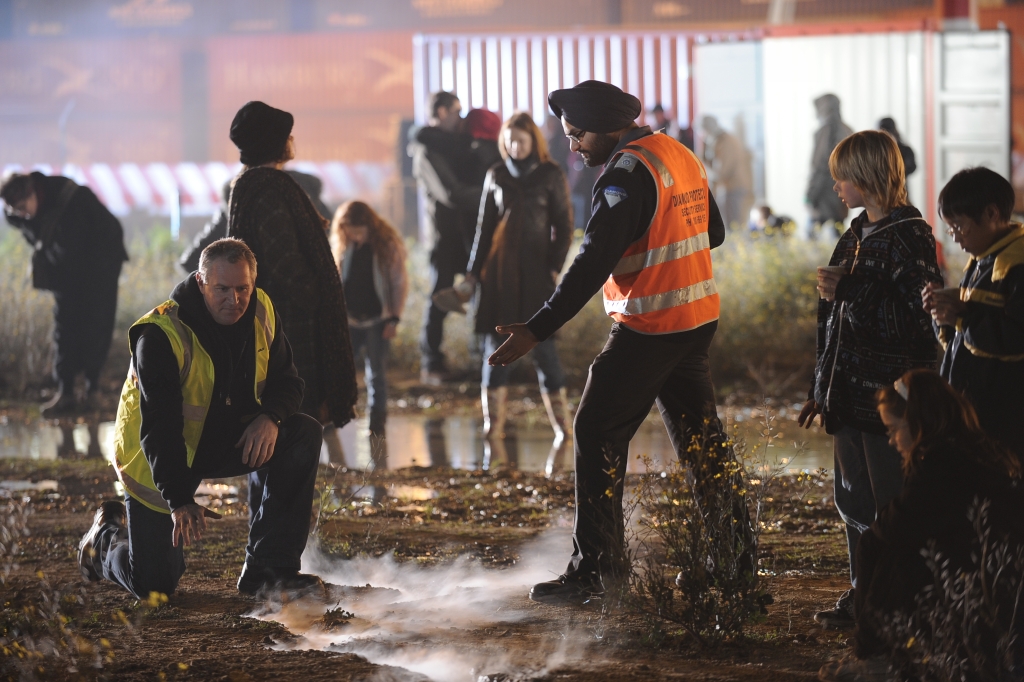
Crowd Theory – Port of Melbourne, 2008, Simon Terrill, produced in association with Footscray Arts Centre and Port of Melbourne, photo Matt Murphy
INSIDE THE SECURITY-CONTROLLED PORT OF MELBOURNE, AUGUST 2, JUST ON 5.30 PM: A BROODING SKY, AN EERIE SOUNDSCAPE, SHIPPING CONTAINERS, SCATTERED WEEDS AND PUDDLES, AND 160 WARMLY DRESSED ‘PARTICIPANTS’ COMBINE IN AN HOUR-LONG ‘MOMENT’—THE CREATION OF THE FIFTH IN SIMON TERRILL’S CROWD THEORY SERIES OF PHOTOGRAPHS. THE RESULTING IMAGE CONVEYS A SENSE OF THE TENUOUS RELATIONSHIP BETWEEN A MAJOR URBAN LANDMARK AND THE COMMUNITIES THAT SURROUND IT, AND THE IRONIC NARRATIVE OF A FROZEN ‘CROWD’, WHOSE PRESENCE IN THE PHOTOGRAPH TESTIFIES TO ITS COLLECTIVE AFFINITY WITH THE PORT.
Crowd Theory—Port of Melbourne is, for Simon Terrill, a kind of proposition: both an exploration of the physical space of the Port and a kind of documentary fiction based around the responses of participants to the location. While the scene is carefully constructed—the patch of earth sandwiched between West Swanston Dock and the Coode Island liquid storage facility appears much like a film set—Terrill is not interested in directing participants. Instead, he asks people to consider their relationship to the Port as they form the ‘crowd’ that he captures from atop a 6.5-metre scaffolding tower.
Between the endless beeps and clunks of the dock area and the dark silence of the Coode Island terminal, this crowd is restless, curious. The sun is about to set as people tuck into hot soup, compare gumboots, beanies and scarves, and watch the awesome display of cranes unloading a nearby ship. Four busloads of local residents, interested ‘outsiders’, port workers ranging from office staff to truckies and engineers, a few kids, amateur artists and sundry others have been shuttled across from Footscray Community Arts Centre—producer of the Crowd Theory series and partner with the Port of Melbourne Corporation for this image. As the clouds move in and the light softens, marshalls lead the crowd into the shot and the event begins to take shape.
Simon Terrill has worked with Footscray Community Arts Centre to create Crowd Theory images in four other locations: by the Maribyrnong River at Footscray (2004), at Skinner Reserve in Braybrook (2004), at Footscray Station (2006) and at Southbank (2007). The Footscray photograph won him the $10,000 KPMG Tutorship Award in 2005. Looming clouds have been a feature of all but one of the photos, throwing an enclosing moodiness over scenes of saturated colour and precise composition. The Southbank image stands distinctly separate, its participants both dwarfed by, and part of, a wall of high-rise windows and balconies.
The Port of Melbourne shoot unfolds rhythmically under bright lights: 10 shots are taken throughout the sunset hour, and during each 10 or 15-second exposure the slowly evolving soundscape gives way to a long, solid tone. As the shoot progresses, obvious fascination with the usually hidden landscape gives way to individual preoccupation with the next shot: what we will do, what we will think. Before each exposure, Terrill reminds us over the PA to spend the duration of the exposure focusing on “that one Port thought”—and everyone seems to take it seriously, embracing each extended ‘moment’ with a deliberate, small gesture in the midst of the scattered whole.
Terrill insists on the importance of allowing each person to respond and represent themselves as they choose. “I see the hour of the making of the picture very much as a ritualised hour”, he says, adding that his role at that point is simply to facilitate that ritual. For Terrill the final photograph will encapsulate “all that precision beforehand, and then, in a sense, the anti-precision of the crowd space.”
The process feels strangely unreal, like a cross between friendly gathering, facilitated trespass and private journey. The location itself seems part real, part artifice—another contradiction that Terrill is keen to explore: “that tension between the fictional image, the things that have gone into making that image, and the attributes which come from that place.”
Crowds, says Terrill, are formed both of shared experience and a kind of “unconscious group mind”, and this idea has been central to all five Crowd Theory images to date. The photograph selected for the final 1.8 x 2.4-metre print is the one he sees as capturing the ‘moment’ during the ritual in which a coherence begins to show itself in the pattern of bodies. Having employed the same process for each image in the series, Terrill says he’s learned to recognise that moment, usually somewhere towards the middle or end of the shoot, when participants’ uncertainty and exploration gives way to a kind of group energy.
Citing Elias Canetti, Terrill describes this ‘crowd-moment’ as being “one of the true moments of equality, where differences between people do drop away.” Canetti’s Crowds and Power, he says, begins with the statement that human beings’ primary fear is that of being touched. “The crowd situation removes that fear”, says Terrill, “and all these interesting things start to happen, psychologically. It’s quite beautiful, the idea of genuine equality, for that fleeting moment.”
Further threads feed into the overall project, with Footscray Community Arts Centre, the Port of Melbourne Corporation and the artist, not to mention the participants, all having an investment in the aesthetic outcome. For Footscray Community Arts Centre the project marries critical artistic practice with community engagement and for the Port Corporation it serves an important community relations function. The final shot seems to be horizontally layered: the ‘community’ almost floats in the middle ground, suspended between the chosen location and the massive port infrastructure behind.
There is also a paradoxical stillness—the hour-long ‘ritual’ was an hour of almost-constant movement as participants explored the site, talked to strangers, watched the cranes and the sunset. The image of the frozen ‘moment’ is indeed a fiction—the long camera exposure can’t be discerned directly in the photo, except for some blurring in the Panamax cranes on the wharf. Terrill’s humble crowd finds its feet and stakes its tenuous claim, both co-existing with and deferring to the mystique of the machinery and the process that goes on, 24/7, behind the wire fences.
–
Crowd Theory—Port of Melbourne, artist Simon Terrill, produced by Footscray Community Arts Centre in partnership with the Port of Melbourne Corporation, Aug 2, Port of Melbourne; Exhibition, Mission to Seafarers, Melbourne, Aug 28-Sept 28,
Urszula Dawkins is a freelance writer, editor and arts worker based in Melbourne.
See cover for the complete Crowd Theory–Port of Melbourne photograph.
RealTime issue #87 Oct-Nov 2008 pg. 49
© Urszula Dawkins; for permission to reproduce apply to realtime@realtimearts.net
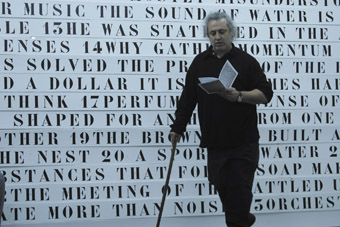
Ruark Lewis, A Babel Reading-Machine (2005)
photo William Yang
Ruark Lewis, A Babel Reading-Machine (2005)
RUARK LEWIS IS A PASSIONATELY POLITICAL AND COLLABORATIVE ARTIST WORKING ACROSS AND INTEGRATING PAINTING, DRAWING, INSTALLATION, ARTIST BOOKS, PUBLIC ART, PERFORMANCES, AUDIO AND VIDEO WORKS. HIS METHOD, WHICH HE TITLES “TRANSCRIPTION (DRAWING)”, OFTEN TAKES THE WORK OF OTHER ARTISTS—COMPOSERS, POETS, CHOREOGRAPHERS, ANTHROPOLOGISTS AND FELLOW VISUAL ARTISTS—AND TRANSFORMS IT INTO ABSTRACTED TEXT EMBODIED IN IMMACULATE SCULPTURAL INSTALLATIONS IN A RANGE OF MATERIALS INCLUDING CLOTH, TIMBER AND STONE, OR TRANSPOSED ONTO THE FACES OF BUILDINGS, AS IN RECENT PUBLIC ART WORKS. THIS ARTICLE REPRESENTS A SMALL PART OF A FASCINATING CONVERSATION YOU CAN FIND AT WWW.REALTIMEARTS.NET.
Like a good poem, a Ruark Lewis work encourages contemplation and promises delayed revelation; then it’s art that stays with you. The man himself is more immediately accessible, an ubiquitous and energetic arts presence (despite a taxing physical disability) and an eager conversationalist—one for whom conversation, he says, is the source of much of his art, building on the images that first occur to him and take flight through talk and are then realised often in collaboration.
A long conversation with Ruark Lewis is a rich journey into cultural history from the 1980s on, of which his own career is a fascinating part. After studying ceramics, Lewis turned to curating public events for four years for the Art Gallery of New South Wales in the late 1980s. The resulting programs brought together a wide range of artists in performative mode. Doubtless, these telling juxtapositions and potentials for partnerships inspired the conversations which became his own collaborative art in the 1990s and up to the present. He created RAFT, a major work with Paul Carter for the Art Gallery of New South Wales and other commissioned works—for the 2000 Sydney Olympics, 2006 Biennale of Sydney and Performance Space. He collaborated with Jonathan Jones on an installation called An Index of Kindness at Post-Museum in Singapore 2007. His recent outdoor installations and sound works in the City of Sydney focus on the consequences of urban development. In October this year he travels to Canada where he’ll create a commissioned public art installation called Euphemisms for the Intimate Enemy for Toronto’s Nuit Blanche festival.
the public house
I asked Lewis about his City of Sydney project, which has recently taken him to Millers Point with its small remaining population of an older community residing amidst new developments and the palpable wealth of new apartment dwellers in the Rocks and Walsh Bay. He describes it as “a public artwork, which includes agit-prop elements, working with a group of people, studying the area and trying to develop a spoken word archive piece, an archive of community comment about lifestyle in the area at this time to do with ‘the public house.’ I’m looking at the ways that development encroaches upon traditional communities living in the inner city areas.” Lewis sees Sydney as having been through several visionary planning periods and with “a remarkable political history when you look at what the BLF forged with the Green Bans…It’s a history of significant counterpoints between the dissident voice, the resistant voice and the government and the developers.” The words of the community, material for Lewis’ text, are being found at the Darling Harbour branch of the ALP and the National Trust and Tenant’s Union.
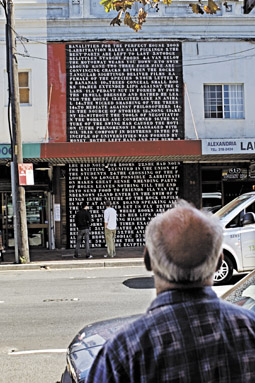
Banalaties for the Perfect House installation, Slot Gallery
photo Alex Wisser
Banalaties for the Perfect House installation, Slot Gallery
Lewis is keen “to make an environmentally integrated artwork. That’s how we worked at Homebush on public art at the Olympic site, making Relay with Paul Carter’s text during 1999-2000 as a Sydney Olympic Games commission. There are no spaces between words and I designed a colour code to cross-reference through the ongoing sequences of five rising stone steps. We had three kilometres of texting going up and down those stone bleachers. The planners were very keen to create a public art that would environmentally integrate with both the site and the sporting events and audience. They didn’t want decorative art baubles. I thought that was a workable approach for an ongoing strategy for placing works in the public zone…I’m still working on that idea and trying to find ways of lightly integrating installed works into the actual building fabric. I’ve done it on couple of locations recently. At an artist-run-initiative called SLOT in Regent Street Redfern I made a seven-metre high façade on the front of the building using the width of the shopfront downstairs and closing off the apartment windows upstairs and taking the text all the way to the parapet. It’s a peoples’ poem called Banalities for the Perfect House.”
We watched and spoke to a lot of people in the street in Redfern to see what their reactions were. A grandmother was drunk in the street and she had tears in her eyes as she stared across the road. “What’s this? What’s this?”, she kept crying. I asked her what the matter was and she replied, “I’ve got to explain this to my grandchildren because when I come up here shopping with them they’re gonna ask about it.” So I said “maybe it’s poetry.” She said, “I know it’s fucking poetry! But what does it mean?” I said, “I’m not quite sure what it means.” She said, “Ah! come on it’s not that complicated.”
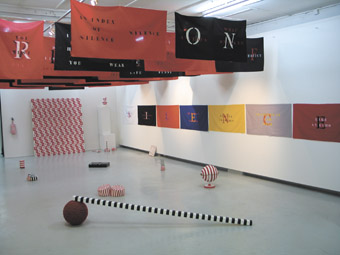
An index of Kindness, Chalk Horse Gallery, Sydney, 2008
courtesy the artist
An index of Kindness, Chalk Horse Gallery, Sydney, 2008
municipal signs & other objects
Lewis’ most recent show, at Chalk Horse in Sydney’s Surry Hills, draws on work from his shared show with Jonathan Jones at Singapore’s Post-Museum. The gallery was hung with flags stencilled with words from Nathalie Sarraute’s play SILENCE. Below, on the floor and plinths, everyday found objects had been painted with red, black and white stripes and markings, making the gallery-goer doubly attentive—to where they trod and how they were regarding the art. Lewis surmises that he’s using the gallery to test out some of his outdoor optical and spatial systems: “I’ve been considering the sculptural objects in the show as decoys. They’re like the rocks of Mer in the Torres Strait. Eddie Mabo identified a bunch of rocks around his Island of Mer as being the markers for the language or community zones. I thought that’s a very useful message for all Australians to start to recognise…”
In Singapore, says Lewis, “I was actually looking for garbage. I thought, here’s a place where you can’t have long hair, you can’t chew gum, what can you do? So I started making work about the garbage—on the streets, in the countryside or washed up on the beach…I stencilled messages onto pieces of garbage.” Then he placed the garbage back where he found it and made a photographic record: “This formed an intimate poetic puzzle. I wanted to leave messages for people anonymously. I avoided the fear of arrest by photographing the evidence before and after I removed it. Sometimes I kept elements of the garbage to paint an abstract pattern on it—with red and white or black and white stripes painted in gouache.”
the artist begins
We step back in time to Lewis’ beginnings as an artist. He went to Sydney Boys High School where “One day I went up to the art room and a friend of mine was throwing on the pottery wheel. I became totally mesmerised how that form came up out of his hands and fingers. I loved the slithering plastic action of the clay that formed in his hands. I went straight out and bought a bag of clay that afternoon and made a sculpture, not a pot as such.” With a photographer brother and musician and painter cousins, Lewis describes himself as “sort of coming from a Jewish artistic family—a tribe of mercantiles and artists. According to the painter Cedric Emmanuel our earliest Australian relative was Michael Michaels. He was a forger who was pardoned in 1809 and left Sydney returning to London and he started an orchestra. We’ve always had painters and musicians in the family so making things seems natural to us.”
Lewis studied Ceramics at the Sydney College of the Arts: “It was difficult for me physically but I needed the tangibility of clay.” But a major influence there opposed his interest in ceramics: “the composer David Ahern in the Sound department. David was a total radical. He’d been working with Cornelius Cardew in London and for two years was a personal assistant to Karlheinz Stockhausen. He came back to Sydney in the early 70s and among other things he ran a Sunday new music workshop out of Inhibodress Gallery. That was the group called Teletopia and AZ Music. Tim Johnson and Mike Parr and Peter Kennedy ran the avant-garde concept gallery the rest of the week. But on Sunday the experimental artists ran an open studio where trained and untrained musicians joined together to perform music. Although I wasn’t involved in those early years I’ve been very interested and was highly motivated and inspired by Ahern’s practice. It was wild. It was recklessly terrific. I thought this is really what art’s about. Because it was a language made of sound and music…Ahern was very discouraging of my interest in ceramics and always urged me to paint and draw.”
But, says Lewis, “Ceramics gave me a sort of classical education, which I may not otherwise have received in such a serious avant-garde art school.” An interest in architecture has also been “infinitely useful.” Such contrasting influences were to yield a seriously idiosyncratic artist. The sense of difference was compounded in 1984: “I was expelled from Sydney College of the Arts. That was pretty demeaning—it really wasn’t my fault. I also had been expelled from Sydney Boys High School in 1978. Perhaps both these rejections shore me up as a kind of outsider in art—in that I seemed able to miss out on certain unnecessary things exactly at the right time.”
the artist as curator
Lewis began first as a reader and then as a curator of poetry readings at the Art Gallery of New South Wales and then with Emmanuel Gasparinatos “who programmed a new media event in the theatrette called Sound Alibis with 14 artists including Rik Rue, Warren Burt, Sarah Hopkins and Vineta Lagzdina. There were Super 8 films and sound works and live performances. I developed the program further the next year with the poet and scholar Martin Harrison [who] was interested in the writer/performer as live presence…This began a really successful curatorial collaboration [becoming Writers in Recital]: it made the AGNSW the stage to a wide range of writers and musicians, composers, filmmakers, visual artists, performers dancers, radiophonic composers…I kept working out ideas of how to get the most radical types of experimental art out to the widest audience possible…even radio stations like 2GB would give me a five minute interview each season. I saw it as an act of anti-elitism to promote radical art to a willing public.” The big names, poets like Judith Wright, David Malouf or Les Murray, were programmed to attract large audiences who would witness, for example, “the soprano Elizabeth McGregor singing the Margaret Sutherland settings of early Judith Wright poems alongside the relatively unknown work of Allan Vizents, William Yang, Ania Walwicz or Jonathan Mills.”
escape to melbourne
After four years of curating, “in August 1990 I escaped Sydney. In Canberra I found a copy of TGH Strehlow’s Journey to Horseshoe Bend. It’s a biography/autobiography about the death of his father, the missioner Carl Strehlow in Central Australia in 1922. I started reading what turned out to be a transformative book for me.” It was important in developing Lewis’ art of “transcription” and “texting”, which would later lead to a major work with Paul Carter.
About the origins of his artistic process, Lewis explains, “I wanted to lay in poetic lines from poets I was reading at the time, like Rilke’s Duino Elegies. I wanted to actually enact it as a trace. At the time I was working on musical and sound transcriptions in the form of drawings. That’s how I’d begun texting into works and making abstract cross-overs from one art form to another.” He made diagrammatic drawings of sound works—acoustic music and then the work of the Sydney composer Robert Douglas who was making large-scale works on the Fairlight CMI.
my university
In Melbourne, Lewis spent time with Paul Carter, the director Peter King, Jonathan Mills, Warren Burt, Chris Mann, Vineta Lagzdina and Rainer Linz. The experimental music scene was particularly influential, coming out of the Clifton Hills Community Music Centre and the NMA magazine: “The Rainer Linz and John Jenkins’ 22 Australian Contemporary Composers anthology was the sort of curatorial guide I’d been looking for at AGNSW. There had been little like that sort of thing operating in Sydney…That was also the era of the ABC’s radio’s The Listening Room. Carter had been editing the Age Monthly Review which we’d all contributed to over the years. This was an artistic atmosphere I called ‘my university’.”
In Melbourne Grazia Gunn, director of ACCA offered Lewis a major solo exhibition opportunity which he worked on for two years. “I finished the Robert Douglas transcriptions, which ended up being 48 metres of extended drawing. The 48 panels occupied the Lotte Smorgon Room at the old ACCA in Melbourne’s Domain. There were studies of Douglas’ Homage to Bessemer. I made a room of literary transcriptions based on the French newspaper Le Monde. I’d been in Paris in 1991 and I found a way to look at the demarcations between the generating forces in commercial print media. It was a simple critique of how photography, journalism and advertising worked in concert on the pages and how that formed the capital which is the motivation for a daily publication.” The exhibition was part of Melbourne Festival in 1992: “Melbourne was into high postmodern and neo-expressionist painting then, and along comes an incredibly cool minimalist show with regional underscores. It was shown there for a lengthy 14 weeks.”
But the Melbourne show did not result in Lewis being immediately picked up elsewhere. He comments wryly, “I like the fact that you can work ‘fairly privately’ in Australia. I always understood that experimental art would be ignored by the local art cognoscenti and that the avant-garde was taken up by the academies that could easily canonise it in what I regard as a pseudo international context.”
the experimental realm
Lewis makes strong distinctions between the realms of the avant-garde and the experimental: “It was the expansiveness, I suppose, of the experimental realm, the idea that art and production could take on other forms in constant flux and I could rewrite them…” And there was a correspondence to this work outside of Australia for my artistic friends. John Cage had picked up on Chris Mann’s work and set it for an opera. What I find most interesting in writers like Mann and Walwicz is the certainty of their regional voice. [W]ith the experimental, there’s a sort of fraternity that I like, keen about reading through each other’s work, reading the sound waves that each artist arrives with.”
Lewis enjoyed this feeling when he met Kaye Mortley and René Farabet in Sydney: “Martin Harrison was a friend of Kaye’s. All sorts of interesting people came together at the Harrisons’ house. The dinners often went until dawn. When René and Kaye came to Australia a sort of sound circle developed around them and the Listening Room at the ABC and at UTS. René Farabet was director of the radiophonic atelier program called France Culture, so there were significant cross-overs with people working here. I went off to Paris in 1991 and had the best time of my life.” Lewis worked with Mortley on a rendering of the play Pour en Oui Pour en Non (Just for Nothing) by Nathalie Sarraute: “I immediately had a vision for setting the players’ script marked out on the page in different colours. The colour would navigate the reader through the text like a graphic score.”
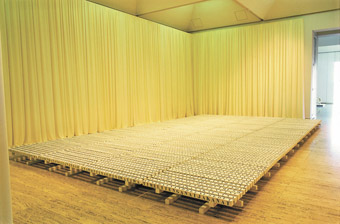
RAFT (2005), with Paul Carter, collection Art Gallery NSW
photo Ian Hobbs
RAFT (2005), with Paul Carter, collection Art Gallery NSW
the raft journey
Asked about the genesis of RAFT, Lewis explains, “I often have visions of things—I see them in visual daydreams and then follow the image directly along into the work. I saw a large gridded structure that seemed to extend out along the surface, so I set off in that direction. The timber of RAFT weighs 1.5 tons. I started testing possible materials when I was staying in Melbourne in 1993. I later made three large Water Drawings which joined RAFT at the Art Gallery SA showing in 1997. Then our book, Dept of Translation, appeared in 2000 to coincide with the exhibit at the Sprengel Museum, Germany which occurred in 2001. So, only about seven years gestation. The Art Gallery of NSW where it was first exhibited acquired the work earlier this year.”
“We were looking at the Arrernte water myth of Kaporilja as the main poetic cross-reference for RAFT. RAFT symbolises the carriage that Carl Strehlow was transported down from Hermannsburg to Oodnadatta to get a train to Adelaide because of his fatal illness. But he died on the way, just north of Fink at Horseshoe Bend. RAFT has to do with issues of translation in the desert. It allegorically acts as a portrait of the classical intercultural brokering of the language scholar and evangelist missioner Carl Strehlow with his links to the first phase of modern anthropology. What’s so amazing is Hugo Ball and Tristan Tzara performed various Arrernte and Lorritja songs at the Café Voltaire in May 1917…Three songs were performed, maybe with movement, and probably in the presence of James Joyce and maybe Lenin both of whom were resident in the neighbourhood. So, there’s the modernist trace again.”
the artist performs
I ask Lewis about the performative aspect of his work. In the exhibition at Chalk Horse there’s a beautiful recording of Amanda Stewart and Lewis doing something quite dramatic and very funny and largely unintelligible (but oddly familiar as social exchange) with occasional literal utterances. Lewis explains, “I have became increasingly interested in the process of concretising language and making a score I can follow and make performances from. Last year I asked Amanda” [whom he declares an inspiration] “to work on an improvisation that would in a non-representational way convey three emotions: anger, joy and sadness. As we huddled around a microphone in the studio we both began giggling, wondering how ridiculous we were, but a really intimate moment between artists emerged as we worked out a range of responses that we might record. Rik Rue collaged our efforts adding layers and depth and spatial elements which formed a kind of audio space poem at Post-Museum in Singapore in 2007. I called it An Index of Emotions. I think visitors were surprised and confronted by those spatial effects and some of the sobbing sounds and angry tones were quite distressing.”
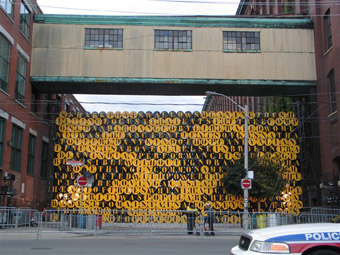
Euphemisms for The Intimate Enemy
nuit blanche, toronto
Lewis’ work for Toronto’s Nuite Blanche (an all night, one night exhibition of 155 works across the city) is a sound installation called Euphemisms for The Intimate Enemy, with a duration of 12 hours . As with The Banalities of the Perfect House “the sound is computer generated but will be a live collage when the computer is started around 7pm on the night of the event. I’ve devised an installation of 550 oil drums to be stacked as a curtain wall between two 19th century industrial buildings. Each word of the Euphemisms is stencilled onto coloured (black and yellow) painted drums and will form an illuminated text in the void.”
See also full interview transcript.
www.ruarklewis.com
RealTime issue #87 Oct-Nov 2008 pg. 50-51
© Keith Gallasch; for permission to reproduce apply to realtime@realtimearts.net

Euphemisms for The Intimate Enemy
RUARK LEWIS IS A PASSIONATELY POLITICAL AND COLLABORATIVE ARTIST WORKING ACROSS AND INTEGRATING PAINTING, DRAWING, INSTALLATION, ARTIST BOOKS, PUBLIC ART, PERFORMANCES, AUDIO AND VIDEO WORKS. HIS METHOD, WHICH HE TITLES “TRANSCRIPTION (DRAWING)”, OFTEN TAKES THE WORK OF OTHER ARTISTS—COMPOSERS, POETS, CHOREOGRAPHERS, ANTHROPOLOGISTS AND FELLOW VISUAL ARTISTS—AND TRANSFORMS IT INTO ABSTRACTED TEXT EMBODIED IN IMMACULATE SCULPTURAL INSTALLATIONS IN A RANGE OF MATERIALS INCLUDING CLOTH, TIMBER AND STONE, OR TRANSPOSED ONTO THE FACES OF BUILDINGS, AS IN RECENT PUBLIC ART WORKS.
Like a good poem, a Ruark Lewis work encourages contemplation and promises delayed revelation; then it’s art that stays with you. The man himself is more immediately accessible, an ubiquitous and energetic arts presence (despite a taxing physical disability) and an eager conversationalist—in fact conversation, he says, is the source of much of his art, building on the images that first occur to him and take flight through talk and are then realised often in collaboration.
A long conversation with Ruark Lewis is a rich journey into cultural history, of which his own career is a fascinating part. After studying ceramics (of which he’s still fond and a new work, a book about pots, is on the way), Lewis turned to curating public events each year for the Art Gallery of New South Wales in the 1980s. The resulting programs brought together a wide range of artists in performative mode. Doubtless, these telling juxtapositions and potentials for partnerships inspired the conversations which became his own collaborative art in the 1990s and up to the present.
Lewis has collaborated with writer Paul Carter, Nathalie Sarraute, Angelika Fremd & Ingaborg Bachamann, Rainer Linz, Jutta Hell & Dieter Baumann and Jonathan Jones. He has created work in Berlin and Singapore; Raft, a major work created with Carter, toured to the UK and Germany; and his commissions include works for the 2000 Sydney Olympics, 2006 Biennale of Sydney, Performance Space and the Art Gallery of New South Wales. He collaborated with Jonathan Jones on an installation called An Index of Kindness at Post-Museum in Singapore 2007. His recent outdoor installations and sound works in the City of Sydney focus, his website says, “on the theme of home, the homeless, huts and the public house.” In October he travels to Canada where he’ll create a public art installation called Euphemisms for the Intimate Enemy for Toronto’s Nuit Blanche festival.
sharing the public house
Before turning to Lewis’ career I asked him about his City of Sydney project, which has recently taken him to Millers Point, with its small remaining population of an older community residing amidst new developments and the palpable wealth of new apartment dwellers in the Rocks and Walsh Bay and the new suburb of Barangaroo.
RL I’m making a public artwork, which includes agit-prop elements, working with a group of people, studying the area and trying to develop a spoken word archive piece, an archive of community comment about lifestyle in the area at this time to do with “the public house.” It’s not precisely about public housing but the public house, a shelter for the street person, the homeless person and about the kinds of housing in general in the area. I’m looking at the ways that development encroaches upon traditional communities living in the inner city areas. (Mayor of Sydney) Clover Moore talks about “urban villages”, but I’d like to talk about a kind of city tribalism and urban history.
The City of Sydney has had three visionary planning periods forwarded by Francis Greenway, Sir John Sulman and George Clarke There have been architects like Peter Myers and Lesley Wilkinson who have built significant public housing projects in the city’s inner suburbs. Col James is a legend for his work and ideas around Redfern. Bill Lucas was my first mentor in urban planning and architecture. In the 1960s he was very focussed 0n saving Paddington from slum clearance and demolition. There’s been consistent conflict between the notion of slum clearance, new developments in public housing and developers in the City of Sydney since the early 20th century. It’s an expensive city. There’s a remarkable political history here when you look at what the BLF [Builders & Labourers Federation] forged with the Green Bans. That’s had an international influence responsible even in formative years of the Green Party in Germany. It’s a history of significant counterpoints between the dissident voice, the resistant voice and the government and the developers. So I think the issues to do with the status of the underdog are really important to focus on for urban activists. The massive corporate/state mentality is keen to erase our community history of resistance. It’s a situation where we hasten to forget. Right now we’re all very conscious of the nature of over-inflated value of property.
KG Do you negotiate your project with the Council and building owners?
RL Yes. I want to make an environmentally integrated artwork. That’s how we worked at Homebush on public art at the Olympic site [making Relay with Paul Carter during 1999-2000 as a Sydney Olympic Games commission]. The planners were very keen to create a public art that would environmentally integrate with both the site and the sporting events and audience. They didn’t want decorative art baubles. They wanted art as user-friendly contextual forms not visually rhetorical objects. I thought that was a workable approach for an ongoing strategy for placing works in the public zone. Especially if you wanted to utilise space to make a public poem. I’m still working on that idea and trying to find ways of lightly integrating installed works into the actual building fabric. I’ve done it on a couple of locations recently. At an artist-run-initiative called SLOT in Regent Street Redfern I made a seven-metre high facade on the front of the building using the width of the shopfront downstairs and closing off the apartment windows upstairs and taking the text all the way to the parapet. It’s a peoples’ poem called Banalities for the Perfect House. Here’s a selection from it:
1. Arbitration makes slim pickings 14a. The wicked smashing of the trees 15c. Without the tools of negotiation the workers are condemned 16. The nature of the swing has caused the motion 17. A phenomena is massaged by oil 19. The principle of universities is formed with money 20. The left hand and the dumb 21. He has nous for rooms 22. She had nous for knitting 23. United in the union of the students 24. A crossing of the floor is no longer possible
The materials had previously been part of a theatre work at Performance Space in Cleveland Street in Redfern but generally the people of Redfern wouldn’t have readily accessed it. Moving the text outside the theatre seemed a stimulating extension and use of the original efforts.
[Melbourne composer] Rainer Linz and I were really keen on looking at the ideals of the visions for housing in Sydney and the potential for social inequity that gentrification enforces. In response to this we developed an installation-cum-music theatre work. Parts of that later were adapted to the street which was very startling, like a fish out of water. We had part of the set in the street for five weeks. They were large but delicately hand-stencilled white characters on black timber boards extending across the front of the building. It looked boarded up. The surface could have been hit by graffiti artists or damaged by vandals or scribbled on during that period. It was interesting to see it was actually still in pristine condition when we took it down. We documented a lot of people stopping and reading the work in the street during the day and the night.
KG Did it have a sonic element?
RL No. It was just textual. It could have had that. It was fairly cost effective to put up. We installed it in three hours, literally transforming a whole facade and street. That was a real surprise to the cosmopolitan Redfern community—all of a sudden the walls were talking and it wasn’t advertising, it wasn’t municipal signage. We didn’t even seek official permission.
KG Was there any explanatory material with it?
RL Gina Fairly and Tony Twigg arranged an information sheet on the front of the building, but I must say I would have liked to have presented it anonymously like a surrealist’s dreamscape.
working the public
KG You’re politically and socially motivated but your work resides in a modernist tradition that wants to make its audience work and not be given any easy solutions or instant intelligibility. Is that an issue for you?
RL Yes, especially when it’s in a really public art zone like at the Sydney Olympics site. Paul Carter’s Relay text is quite difficult, like Russian constructivist Zuam poetry. There are no spaces between words and I designed a colour code to cross-reference through the ongoing sequences of five rising stone steps. We had three kilometres of texting going up and down those stone bleachers. I find audiences always engage in difficult work—to me engagement is all one really needs. My modernist bent comes from my long interest in architecture, through the systems that Bill Lucas taught me and also the Le Corbusier principle of The Modular (the font I use generically was first adapted by Corbusier). I’ve been able to manage things and control designs, writing, audio, video, paintings, theatre, installation or pages of books—anything and all measure of things in the way that architects project manage their sites. It’s the very structure of a given thing that in turn supports another structure that leads out beyond itself.
KG It must be great to be able to say you’ve created three kilometres of texting.

Banalaties for the Perfect House installation, Slot Gallery
photo Alex Wisser
Banalaties for the Perfect House installation, Slot Gallery
RL I was told by a visiting Turkish journalist that no-one in the world could easily boast about that sort of structure. The conceptual artists I greatly admire appear generally to be putting out one-liners—effective as that may be! But I think of text as part of literature. We find that people read parts of the whole so we write and code the work with that fragmentation in mind. The work is readable and puzzling at the same time. I’ve always understood that’s what poetry does: meaning being temporarily suspended. You don’t just have a poetic spectacle that spells the whole message to be consumed immediately. I’m against automatic consumption. We watched and spoke to a lot of people in the street in Redfern to see what their reactions were. And sometimes the initial reaction was anger, “Why the fuck is that here?” I was talking to a taxi driver (I didn’t tell him that I had anything to do with those Banalities). He said he was pissed off at first seeing it there. I said, “Do you go past there very much?” He said, “Yeah, at least two or three times a day to the airport.” But in the end he liked it. He said. “I started to read the lines and I went, ‘Fuck, what’s that doing there? It’s poetry.” A grandmother was drunk in the street and she had tears in her eyes as she stared across the road. “What’s this? What’s this?”, she kept crying. I asked her what the matter was and she replied, “I’ve got to explain this to my grandchildren because when I come up here shopping with them they’re gonna ask about it.” So I said “maybe it’s poetry.” She said, “I know it’s fucking poetry! But what does it mean?” I said, “I’m not quite sure what it means.” She said, “Ah! come on it’s not that complicated.”
KG The crafting of the work, its look, I think is also something people appreciate enormously.
RL And not just the “look”, but the materials. Once you get up close to the surface you can see its materials are basic. Everything we work with are the sort of materials anyone could work with in the back shed or garage. It’s just packing crate timber and colour paints. That honesty of materials is something I’ve wanted to employ for a long time. I think it breaks down the barriers of fine art authority to a simpler commonality. I see that as one of the significant aspects of Brutalist architecture—its modest materiality.
KG You’ve done another version of this in another location?
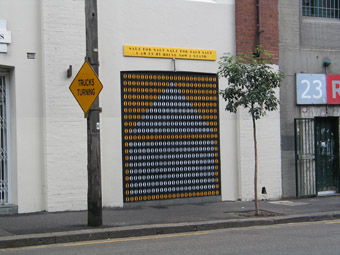
Ruark Lewis, An Index for the Homeless
RL Recently we placed a work called An Index for the Homeless on a building at 27 Abercrombie Street, between The Resistance Centre and MOP Gallery. MOP have been interested and very supportive of what I’m doing. Both at their artist-run-initiative and also at Hazelhurst Regional Gallery for the Cronulla Riot exhibition that Ron and George Adams curated. I made two installations down at Sutherland which where called Euphemisms for a Riotous Suburb. In June they agreed to housing my street installation in the wall cavity outside the gallery.
There are some arched alcoves in the facade, making them modules across the the entire surface of the building that is three metres square. I’ve designed into it a hut structure that fits within a form of a house made out of stencilled zeros. It’s a simple square structure that has a triangle and rectangle within it. The triangle is at the top, forming an apex as the roof and a rectangle underneath making the walls of the house. So it’s a square, a triangle and a rectangle. There’s the modernist activity in operation again. Form informing form. I thought of it as a concrete poem as well. We stencilled 10cm high characters so they can communicate from a long distance away. This was not an artwork that you go up in front of to experience the brushwork. You have to be at least 20 metres away to get the peripatetic effect. It’s part of a man-made environment, heavy with four lanes of traffic where the optical concerns are experienced spatially.
We installed a sign above the main door of the gallery. It looks like an institutional name for the entire building. It says, “An Index for the Homeless.” It’s as though we’d instantly created a research centre for homeless people. It’s become a bit of a joke actually. I didn’t expect it to work like that—a game of nomenclature, a poetic association generated by chance. Alongside that I painted a board with a quote from Ania Walwicz’s short story called House, which reads, “SALZ FOR SALT SALZ FOR SALT SALZ I AM IN MY HOUSE NOW I STAND.” It’s a fairly mysterious line on a curious site. You can hear people uttering Ania’s words. And they don’t just say it once. they seem to perform it several times. So they’re getting the shape of the poetic sentiment into their oral cavity. It’s been up for 16 weeks and hasn’t been graffitied or complained about. I’m hoping someone does graffiti this pristine artwork at some time. I don’t quite understand why not.
KG Too sacred?
RL When I say “we” I’m referring to the assistance I receive from Bartholomew Rose. He works for me in the studio three days a week. He’s enabled me to undertake a wide range of physically demanding installations over the last five years. He’s a Scrabble expert and a very valuable iterary companion to have.
KG Back at Millers Point…
texting
RL The Index of Kindness takes up from where the Index for the Homeless leaves off. Kindness is the thematic umbrella I am working under at present. The idea is to think about the Millers Point precinct and a number of the public buildings in the area as the next surfaces to publish onto in the name of “the public house”. We’ve been arranging for the Millers Point community to participate with their own “texting.”
KG You mean mobile phone texting?
RL Not really. The people there say, “We don’t have mobile phones and we don’t have computers.” The issues of information and activism are articulated differently in that community. They say, “you’ve gotta give us proper messages. You can’t just think digitally and expect us to read your emails.”
KG How do you work with these communities to get their “texts”? Do you interview people, make sound recordings?
RL At the moment we’ve been going through the process with the Darling Harbour branch of the ALP and the National Trust and Tenants’ Union. The branch meets monthly in the Garrison Church. For these interviews I’m working with Jo Holder, a well known curator, writer and activist. I guess a local ALP branch can be like a little church itself. It’s a conduit of informed opinions where like-minded people are motivated to come together politically. Most of them are or have been activists too. They’re a group of very articulate and socially motivated people. They’ve recorded a lot of the things that have gone down with state government’s dealing in that region. The Millers Point residents have often been described as a traditional inner-city community. The impact on Hickson Road with the new Barangaroo development at East Darling Harbour is monitored by this fragile community very closely. The history of activism in The Rocks goes back to the Green Ban days when the BLF led by Jack Mundy, Joe Owens and Bob Pringle were there on site saving The Rocks from demolition for more office towers. This community has seen it all and has learnt to deal with all the difficulty of state and council bureaucracy. Now the fight is to protect the community itself including much of the residential properties for low income housing.

An index of Kindness, Chalk Horse Gallery, Sydney, 2008
courtesy the artist
An index of Kindness, Chalk Horse Gallery, Sydney, 2008
municipal signs and other objects
In Lewis’ most recent show at Chalk Horse in Sydney’s Surry Hills, the gallery was hung with flags stencilled with words from Nathalie Sarraute’s play Silence. Below, on the floor and plinths, everyday found objects had been painted with red and white stripes and markings, making the gallery-goer doubly attentive—to where they trod and how they were regarding the art.
KG In your latest gallery show at Chalk Horse there’s your usual play on words, in the form of flags. There are objects as well. Where do these fit in the scheme of things?
RL I guess I’m using the gallery to test out some of my outdoor optical and spatial systems. I’ve been considering the sculptural objects in the show as decoys. Leading up to the Chalk Horse show I was studying maritime signage. The navigating tools that ships use on the harbour. I realised there’s a language for signs out there, a municipality of water and land signals. I’m very interested in the municipal sign and seeing where an artwork can transgress the polite internal boundaries of cities and streets and art galleries. One of the Chalk Horse panels is being prepared for reinstallation at Abraham Mott Hall in Argyle Street, Miller Point. This stencilled timber work called Conrete Poem II will be added to a sequence of other panels called Euphemisms for the Seafaring Nation. I’m making these things as modular constructions so they’re adaptable and relocatable. At Chalk Horse, all the objects on the ground operated as warnings so that visitors won’t trip over. They’re like the rocks of Mer in the Torres Strait. Eddie Mabo identified a bunch of rocks around his Island of Mer as being the markers for the language or community zones. I thought that’s a very useful message for all Australians to start to recognise. We need to identify our environments with objects set out as markers. These are the municipal markers that translate a whole bunch of security/insecurity issues that control the movement of society. I was in Singapore last year. To me Singapore is a remarkable, urbane area but it feels as though it is adapted from the City of London. It’s the municipal aspect of London that modern Singaporean politicians adopted to their equatorial zone in a number of ways.
KG What did you do in Singapore?
RL I was actually looking for garbage. I thought, here’s a place where you can’t have long hair, you can’t chew gum, what can you do? Obviously everything is very clean and modern there. So I started making work about the garbage—on the streets, in the countryside or washed up on the beach. I began to examine parts of the island that weren’t stereotypically clean and modern. Jonathan Jones and I picked up pieces of junk as we drove all around the perimeter of the island state. We went out to the rural areas and coastlines. We reached the industrial area Jurong where an army of cheap contracted labour from the Indian sub-continent are imported and housed. We did a week of urban fieldwork in a hire car last September. It was the sense of island containment that we decided to study.
KG So what did you do with the garbage?
RL I stencilled messages taken from An Index for Redundant Expressions which I’d assembled there. It’s a set of 45 aphoristic tautologies. Found phrases or ready-mades, for example: “9. earlier in time, 16. an honest truth, 32. a pair of twins, 1. an actual experience.” I inscribed these onto pieces of garbage. Then I placed these messages back into the piles the rubbish came from and made a photographic record. This formed an intimate poetic puzzle. I wanted to leave messages for people anonymously. I avoided the fear of arrest by photographing the evidence before and after I removed it. Sometimes I kept elements of the garbage to paint an abstract pattern on it—with red and white or black and white stripes painted in gouache. We arranged sets of these garbage ‘props’ for the large exhibition we assembled at Post-Museum. These displayed redundant expressions accompanied by three distinctive suites of work under the title of An Index of Kindness. There was An Index of Emotions which is an audio construction formed from vocal performances I made with Amanda Stewart. The spatial affects in audio were collaged by Rik Rue. Then the Index of Line was a wall drawing executed by Jonathan Jones.
Jon photographed the Singapore coast and shipping channels. He drew with meticulous precision the contours of most of the landscape of the island and parts of Malaysia in the distance. The drawing encircled the three rooms forming a semi-abstract design on the gallery walls. He just kept layering his drawings so a sense of landscape appeared cloud-like and hovering which was a really interesting anti-territorial take on a visited place.
The Index of Silence involved the stencilled flags you mentioned before, that’s a transcription of Nathalie Sarraute’s play Silence. The red and black flags, suspended low from the ceiling, distorted the volume of the space altogether. We significantly controlled the volume both spatially and directionally by designing the sound. The speakers for the vocal collage were hidden above the hanging textiles. All this was pretty emotionally charged, with the sound of tears and anger. The sound of Amanda and I appeared and disappeared as the sound collages Rik Rue devised panned around the rooms—the audio was kind of spooky there!
Singapore is a place of finite politics so I decided to make a banner. Apparently the making of political banners has to be authorised in Singapore, so I made a concrete poetry banner called QUOTE where I took a line from the Indian writer Ashis Nandy that said, “It was a strange mix of love and hate, affirmations of continuity and difference, nostalgia and a sense of betrayal on both sides.”
The redundant objects were diversions to slow down the audience. I don’t want people to consume exhibitions quickly. At times our signs seemed odd. My favourite object was the coconut. A truly beautiful painted object. A small leaf began to emerge during the exhibition and it just kept enlarging, breaking through the husk. The shell was painted with black and white stripes, then this little green sprig appeared. We found a broken shovel left by the builders of the gallery. We painted it along with a frame, a chair a rock and ball, a stick and a tree branch. A lot of these ‘municipal’ signals were stimulating to look at without being burdened with the values and meaning of a grand allegory. I liked the way the owners called their gallery Post-Museum. A sort of dissident location in itself.
the artist begins
KG When did you become an artist?
RL I went to Sydney Boys High School. One day I went up to the art room and a friend of mine was throwing on the pottery wheel. I became totally mesmerised how that form came up out of his hands and fingers. I loved the slithering plastic action of the clay that formed in his hands. I went straight out and bought a bag of clay that afternoon and made a sculpture, not a pot as such. That’s where it all began. My brother is a photographer and my cousins are musicians and painters. Nicola Lewis played the violin in An Index of Horses which we made as a performance-for-video at Chalk Horse. I sort of come from a Jewish artistic family, a tribe of mercantiles and artists. According to the painter Cedric Emmanuel our earliest Australian relative was Michael Michaels. He was a forger who was pardoned in 1809 and left Sydney returning to London where he started an orchestra. We’ve always had painters and musicians in the family so making things seems natural to us.
KG You have quite a collection of pottery here in your apartment.
RL I’ve procured these jugs to make an exhibition. I‘ll probably call this The Index of Forms. I’m focussed here on the anthropomorphic conditions that are related in the forms of the jug. These vessels are built with a foot upon which they stand, and a belly, where the bulk of the contents is stored. They have handles, necks and lips. That means they have at least five different physical attributes relating to the human form. I’m thinking of a book which indexes the shadows they cast set alongside the silhouettes and profiles from the bodies of dancers. I’m interested in the double nature of the cast of shadows. I would love to generate a text from a series of conversations with a man who has Alzheimer’s Disease. When we talk he often tells me things in a manner I think of as neo-Dada poetry. To everyone’s surprise we have a terrific time sitting there talking with gusto. If I could record his sayings, write them down in the form of our dialogue it could have an interesting and enabling affect. He’s been a journalist all his life; so the idea and its written form is like a game on his tongue. That’s a nice thing to try and share. Pottery has always been a really interesting through-line for me.
KG So you threw pots yourself?
RL I studied Ceramics at the Sydney College of the Arts with Bernard Sahm and Mitsuo Shoji, both very interesting artists. It was difficult for me physically but I needed the tangibility of clay.
At that school I came into contact with the composer David Ahern in the Sound department. David was a total radical. A really heavy drinker but strangely charismatic and he was wonderful to a small band of loyal students. He’d been working with Cornelius Cardew in London and for two years was a personal assistant to Karlheinz Stockhausen. He came back to Sydney in the early 70s and among other things he ran a Sunday new music workshop out of Inhibodress Gallery. That was the group called Teletopia and AZ Music. Tim Johnson and Mike Parr and Peter Kennedy ran the avant-garde concept gallery the rest of the week. But on Sunday the experimental artists ran an open studio where trained and untrained musicians joined together to perform music. Although I wasn’t involved in those early years I’ve been very interested and was highly motivated and inspired by Ahern’s practice. He was just at the end of his teaching life when I came in contact with him. But it was wild. It was recklessly terrific. I thought this is really what art’s about. Because it was a language made of sound and music, and I studied music throughout high school and my cousins were practicing musicians. Someone like Ahern became strongly influential. In a sense David was the first in a string of “tormentors” I got to know outside of the normal structure of the art school pedagogy. Ahern was very discouraging of my interest in ceramics and always urged me to paint and draw. Soon I began making sound drawings on sheets of cardboard using charcoal and white chalk.
KG So this opened up the idea of there being a number of means of functioning of an artist.
RL Yes. Ceramics gave me a sort of classical education, which I may not otherwise have received in such a serious avant-garde art school. I did a paper on drawing in ancient Greek ceramics. It was an interesting medium for discovering the function of mythology and literature of the Greeks. Then I studied Asian architecture and the correspondences with early classical sculpture. I got a better grounding in architecture that way, which has been infinitely useful. For some unknown reason I never did study painting at art school. I think it would have been physically easier for me. In 1984 I was expelled from Sydney College of the Arts. That was pretty demeaning—it really wasn’t my fault. I also had been expelled from Sydney Boys High School in 1978. Perhaps both these rejections shored me up as a kind of outsider in art—in that I seemed able to miss out on certain unnecessary things exactly at the right time.
KG It didn’t inhibit your progress as an artist.
RL No, it freed me up really.
the artist as curator
KG What did you do then?

Ruark Lewis, A Babel Reading-Machine (2005)
photo William Yang
Ruark Lewis, A Babel Reading-Machine (2005)
RL I left art school and was lucky that Ann Berriman asked me to perform poetry at the Biennale Readings she organised at the Art Gallery of New South Wales. During the 1982 Biennale a group of contemporary Australian poets were scheduled to make readings at the gallery. Anna Couani was invited to read. She realised that the Biennale paid the international artists fees to appear but the organiser for the poets had no arrangements in place to pay the poets fees. Organisers of Sydney poetry readings have been notorious for paying low fees for poetry readings, forcing the poets into what was basically an amateur arrangement. I don’t know why the Literature Board didn’t form a rates schedule. On the gala opening night of the Biennale Couani organised a protest on the steps of the state gallery. It caused such a fuss that a small fund was released immediately from the Literature Board to pay fees for the readings. I thought Anna’s fighting spirit had done a lot of good. She’s a terrific writer. In 1985 I managed to convince the Gallery to start another program of readings, for younger writers and new media artists. Some years later we were able to commission a setting of Couani’s The Harbour Breathes which was brilliantly performed with projections by Peter Lyssiotis and sound designed by Rainer Linz. I thought if you’re going to be a curator, you might as well be a producer and procure the best fees for artists commissioned or programmed to perform in a state gallery.
Initially I worked on the younger poets’ series. We had a six week season of readings. But perhaps even more interesting was when Emmanuel Gasparinatos agreed to join me and he programmed a new media event in the theatrette called Sound Alibis which included 14 artists. People like Rik Rue, Warren Burt Sarah Hopkins and Vineta Lagsdina participated. There were Super8 films and sound works and live performances. Burt assembled his massive tuning fork installation that reverberated through the gallery’s Victorian courts. That was truly spectacular. The program continued to be modelled along those lines of new media and spoken word and poetry for another five years. Those events gave a lot of production confidence to a younger generation of artists presenting to a general public in a state gallery.
I developed the program further the next year with the poet and scholar Martin Harrison. Martin was interested in the writer/performer as live presence, in creating a kind of listening room atmosphere. He was at the ABC at the time doing his Books and Writing program. We’d met at the first Premier’s Literary Awards. This began a really successful curatorial collaboration. Our more substantial programming strategy evolved quickly and it made the AGNSW the stage to a wide range of writers and musicians, composers, filmmakers, visual artists, performers dancers, radiophonic composers. I worked on promoting the programs and quickly built up a large audience. I kept working out ideas of how to get the most radical types of experimental art out to the widest audience possible. I thought if you’re going to compete for funding from the Australia Council the key would be large and consistent audiences. I remember heading off to lots of radio stations with cassette copies of Kurt Schwitters’ Ur-Sonata or Ania Walwicz reading in her remarkable voice—even radio stations like 2GB would give me five minute interview each season.
KG Virginia Baxter and I did a misguided tour for gallery goers, Small Talk in Big Rooms, in 1991 for a Jonathan Mills-Martin Harrison program.
RL These big museums needed us to animate the place. And we need them because audiences like that sort of place to hang out in. People in metropolitan centres want to go to unusual events all the time. They’re not scared of the weird but they don’t go to off-beat venues easily. I was keen to work at the grass roots level. I saw it as an act of anti-elitism to promote the radical art to a willing public.
We’d always program an establishment decoy in our series. The Big names, poets like Judith Wright, David Malouf or Les Murray. They helped to attract the very large crowds for us. We programmed the soprano Elizabeth McGregor singing the Margaret Sutherland settings of early Judith Wright poems alongside the relatively unknown work of Allan Vizents, William Yang, Ania Walwicz or Jonathan Mills. I remember the afternoon when poet Gwen Harwood and composer Larry Litsky presented their recital—a very memorable and stylish event. We maintained the idea of airs and aria as the program through-line. It was very demanding curatorial work. At the end I wanted get back to my own studio practice. I curated for four very intense years and helped produce well over 200 performances. I was pleased that we could raise professional fees and standards and develop funding arrangement that crossed over in a completely new way.
KG Writers-in-Recital happened once a year?
RL Yes. Each year as a one-month season during either the Biennale or the survey exhibition called Perspecta. In 1991 Jonathan and Martin took over and tried to make the program run as regular bi-monthly event.
KG Which year did you leave?
escape to melbourne
RL In August 1990 I escaped Sydney. I headed off to Melbourne, I travelled overland to Wollongong to watch Jaffa and Richard Moore perform Kurt Schwitter’s Ur Sonata alongside Andrew Ford’s music theatre piece Icarus, with a Barbara Blackman libretto. I travelled to Canberra and stayed for a week. You know, sometimes when you work too hard you become emotionally breathless and can’t get your heartbeat back in the right pattern.
In Canberra I found a copy of TGH Strehlow’s Journey to Horseshoe Bend. It’s biography/autobiography about the death of his father, the missioner Carl Strehlow in Central Australia in 1922. I started reading what turned out to be a transformative book for me. I felt this epic story could somehow be adapted either as a film or an artwork. I headed off with that text in hand to visit a Sufi retreat at Yackandandah. It was the off–season so I slept in and revived myself there for a couple of weeks. It was a good occasion to go walking in the backblocks. I followed the fence lines and picked up pieces of wire and made an installation under the verandah of their building. Those wires looked like Arabic calligraphy set out across the walls.
KG Was this the beginning of a particular kind of work that you’ve continued?
RL I was “texting”, so to speak, a bit earlier. Looking at the work of Juan Davila, Imants Tillers, Robert McPherson and Peter Tyndall who worked with inscription in their painting, I wasn’t totally convinced by what I saw. From a literary perspective it seemed to lack the poetic content I’d been seeking. That’s the sort of depth I was looking for in my own study of language. Their work was high art and powerful and of considerable museum scale. But I didn’t think there was the depth that a baroque field vision could offer. I wanted to lay in poetic lines from poets I was reading at the time, like Rilke’s Duino Elegies. I wanted to actually enact it as a trace. At the time I was working on musical and sound transcriptions in the form of drawings. That’s how I’d begun texting into works and making abstract cross-overs from one art form to another.
I made diagrammatic drawings of sound works too, starting with acoustic music and then I experienced the work of the Sydney composer Robert Douglas. He was making large-scale works on the Fairlight CMI. I wanted to make drawings tracing his computer music. I was realising that I could make art too, that I didn’t have to curate. It was a bit of a crisis. I could have made an entry into a professional career as a curator and been paid a salary at that time. But I realised that I could also do these other perhaps more creative experimental things, and that’s what I was interested in.
That year I went to Melbourne and stayed with Paul Carter. We met there to look at Joan Brassil’s retrospective at ACCA in September 1990. We’d formed a sort of group Martin Harrison, the director Peter King, Jonathan Mills and Paul. Mills called us the North Caufield Light Opera Company. I wanted to meet and talk to people like Warren Burt, Chris Mann, Vineta Lagzdina and Rainer Linz who was publisher of the magazine NMA. Melbourne had been a radical birth place for new media arts and experimental music at the Clifton Hills Community Music Centre. Rainer Linz and John Jenkins’ book 22 Australian Contemporary Composers anthology was the sort of curatorial guide I’d been looking for at AGNSW. There had been little like that sort of thing operating Sydney. The Melbourne discourse was quite advanced and very anarchic. By the time I arrived, I’d been “corrupted” by the newly acquired Strehlow material. Paul Carter was working with considerable consistency making his early radiophonic creations with people like Andrew McLennan at the ABC. That was the era of the ABC’s radio atelier program Surface Tension (1980s) and later The Listening Room. Carter had been editing the Age Monthly Review which we’d all contributed to over the years. This was an artistic atmosphere I called ‘my university’.
KG How long did you stay?
RL I kept going. Visiting friends, sleeping on floors and cooking for them, entertaining people, just being there like an artistic vagrant. I loved Melbourne. I’d go down every few months. Then Grazia Gunn was directing ACCA and she offered me a solo exhibition. I’d only done one or two solo shows (19 musical transcription drawings and a language transcription exhibition in Sydney). That ACCA gig was my big calling to come. I worked on it solely for two years.
KG What did you do?
RL I formed an exhibition in three parts. I finished the Robert Douglas transcriptions, which ended up being 48 metres of extended drawing. The 48 panels occupied the Lotte Smorgon Room at the old ACCA in Melbourne’s Domain. There were studies of Douglas’ Homage to Bessemer, and the 48 Alpha Solstice drawings. That was the ‘listening room.’ I made a room of literary transcriptions based on the French newspaper Le Monde. I’d been in Paris in 1991 and I found a way to look at the demarcations between the generating forces in commercial print media. It was a simple critique of how photography, journalism and advertising worked in concert on the pages and how that formed the capital which is the motivation for a daily publication.
KG So you reframed the material in a way?
RL It was a direct response on to actual newsprint. This work mirrored the time Rupert Murdoch of News Limited was closing down his newly acquired Fleet Street press and moving The Times to their robotic Wapping media factory. My drawings were a deconstruction of newspaper, a week of newspapers with drawings highlighting the spaces in between the contents. In this space I made a set of transcription drawings based on a group of bark paintings traced from the AGNSW and the Australian Museum. What interested me most were the painters from Yirrkala. These archival works had been collected by Charles Mountford in 1948. I was interested in those objects for all sorts of problematic ethical reasons. These paintings had been acquired as a form of scientific information during the American-Australian Scientific Expedition to Arnhem Land. I made a kind of funerary drawing from Mountford’s ‘data.’ I was making a ‘drawing’ that covered up the painted iconic blocks on the bark paintings. By drawing a kind of reversal all that remained was the grids between the pictograms. The ‘lines’ were just the raw paper left over in the reduction. The black rectangular areas were simple burnished graphite surfaces. I transcribed a set of 12 bark paintings and called the results The Silhouettes.
KG What is involved in this transcribing process?
RL I took sheets of mylar plastic and placed them over the top of the objects. With a texta I traced the regions. I drew around where the picture block sat in the case of the bark paintings. I’ve also made similar transcriptions from the collages of Kurt Schwitters at the Sprengel Museum in Hannover. The skeletal forms of the original works are recorded from the bark or collages. These lines represent the directional modality defined in the original by the artist before the readable pictogram is put into place to tell their story. I am attracted by the structure of those schematic intentions.
So that’s what the first exhibition was—fairly esoteric too. It was part of Melbourne Festival in 1992. Melbourne was into high postmodern and neo-expressionist painting then, and along comes an incredibly cool minimalist show with regional underscores. It was shown there for a lengthy 14 weeks.
KG It would have excited the high theory crowd.
RL They mostly ignored it! It was an incredible experience to be given such silent treatment. Maybe that’s what happens coming from Sydney and being 32 at the time and having the top spot at ACCA during a festival season. But I made a lot of terrific friends through that project. I asked the composer Keith Humble to open the show.
KG So you were on a path; were you immediately picked up elsewhere?
RL No. It was ‘difficult’ work and it was commercially ignored. The next two years was fairly quiet and contemplative. A few dealers made comments. I remember George Mora liking the newspapers drawings very much but he said they were unsaleable. Charles Nodrum has always been very keen. I like the fact that you can work “fairly privately” in Australia. I always understood that experimental art would be ignored by the local art cognoscenti and that the avant-garde was taken up by the academies that could easily canonise it in what I regard as a pseudo international context.
the experimental realm
KG So you’ve seen yourself very much in the experimental realm rather than from an established avant-garde position?
RL Yes. I just thought there was more interesting dialogue between artists and forms in what is experimental.
KG There’s a public conflation between experimental and avant-garde usually. People don’t make the distinction
RL Ahern made the distinction from the outset: Schoenberg and Stravinsky, then Cage and Boulez. I’d been wanting to make the distinction. I tried to make the distinction at the AGNSW and we could model it on the stage with the Margaret Sutherland and Judith Wright work for instance. The music and writing was avant-garde in 1943. On the other hand, placed right beside that were the extreme writings/performances of Ania Walwicz. We could form those kinds of critical juxtapositions in the museum. Walwicz has always been remarkable to watch, or read on the page and then she’d do these haunting performances. Those writings correspond to the paintings she makes also—like dream sketches in oil paint. It’s a modest and manageable practice but a fantastic way of working with things. The Sutherland setting of Wright is probably known by only a small group of musicians and historians today. Programming a local rarity like that, with a big shiny Steinway on the stage was a different way of analysing the structural differences of both these tendencies.
KG So the experimental for you represented various means of working whether through text or image or performance or film or whatever. What is the essence of the experimental as opposed to the avant-garde?
RL Well to me it’s a living force with the musicians or performers. Not exactly being a musician myself but having studied music at school and in association with Ahern and people like that I focussed more and more on structures rather than expression or evocations. I wasn’t really attracted to the technological in new media as a means for hand-crafted works. I’m happy using low tech tape recorders, using video to form a document of a process. I didn’t know how to use a computer for a long time. I was lecturing in the new media lab at SCA but didn’t even know how to turn a computer on. The students were eagerly making CD-ROMs at the time. I was teaching what I thought of as a production management course—almost like a project manager on an architectural site. It was the expansiveness, I suppose, of the experimental realm, the idea that art and production could take on other forms in constant flux and I could rewrite them that I found stimulated my thinking about experimental art.
And there was a correspondence to this work outside of Australia for my artistic friends. John Cage had picked up on Chris Mann’s work and set it for an opera. What I find most interesting in writers like Mann and Walwicz, and others Javant Biarujia, is the certainty of their regional voice. I guess you could say that about Gerald Murnane too. To me this is both political and psychological. In certain ways I understand their writings operate as a kind of artistic resistance. It’s about being in this place in the work but in very interesting and surprising ways. Carter’s writings too had taken the regional condition and re-examined it in books like The Road to Botany Bay or his Italian book called Baroque Memories. I think there’s too often an identity crisis in the Australian avant-garde. The constant need it faces to be academically relevant. To me that leads to conformity. Isn’t that what the underlying anxiety of cultural cringe is about? But with the experimental, there’s a sort of fraternity that I like, keen about reading through each other’s work, reading the sound waves that each artist arrives with. I found it highly attractive that when you went to Paris someone was there that you could plug into right away and you felt very much part of what is going on. I went to Paris and began to work with Kaye Mortley on the Nathalie Sarraute book. That was remarkable shift. To be part of a cohesive living culture that remained in nature to that place as well.
KG When did this happen?
RL 1991. I made the Le Monde drawings for my ACCA show while I was in Paris. I’d met Kaye Mortley and Rene Farabet here in Sydney. Martin Harrison was a friend of Kaye’s. All sorts of interesting people came together at the Harrisons’ house. The dinners often went until dawn. When Rene and Kaye came to Australia a sort of sound circle developed around them and the Listening Room at the ABC and at UTS. It was formed by Virginia Madsen and Tony MacGregor and Martin. Rene Farabet was director of the radiophonic atelier program called France Culture, so there were significant cross-overs with people working here. Kaye had been a pioneer in the new radio at the ABC—the days of Radio Helicon I remember so well.
transcription & translation
I went off to Paris and had the best time of my life. I felt like I could walk all over that city. I wanted to make an artist’s book with Kaye, to try to form a radio score into a book form. I was really interested in how her radio scores appeared to be arranged to form a depth of field in audio terms. That’s a form of literature that doesn’t come outside of the production room very often at all. She’d published a work in a Sound issue (number 31), of the Australian journal Art & Text which looked fascinating on the page and I thought, there could be a whole book possible relating her many and various creations for radio. But Kaye said we should ideally work on the play Pour en Oui Pour en Non (Just for Nothing) by Nathalie Sarraute. She’d translated that work for radio—the ABC did it with Arthur Dignam and Barry Otto. Perhaps I was a little disappointed not to work on her scripts, but when she described the play I immediately had a vision for setting the players’ script marked out on the page in different colours. The colour would navigate the reader through the text like a graphic score. I wanted to run the lists across the page so it was justified left and right and formed as modern prose would work. That’s a better way to read it and easier for the actors because they’ll know how much material is coming up from the blocking of the colours.
KG I remember seeing it at Sarah Cottier Gallery in Redfern.
RL It was ignored again.
KG It was beautiful.
RL Thank you. Andrew McLennan launched it (I think he produced it at the ABC for Radio Helicon) and he did a wonderful rendering of the idea of the play that afternoon. We got a small but knowing audience for that exhibition. And we had Nathalie’s voice present in the installation! We went beyond the play. Nathalie lived to 99. When she died I wanted to bring her voice into the installation. Kaye had made a supplementary audio work where Nathalie was speaking about herself being photographed, and as a child, and there was a statement about self perception—the paradox of growing old and not growing young.
When we were making the book, I asked Kaye Mortley if she would construct a sound piece as an idea for an installation of the book pages bringing the presence of the author into place. One of the tricky parts about working in Australia with Kaye was that people didn’t seem to understand the significance that the translator represents alongside that of the author. Her relationship with Sarraute was so intimate. And Nathalie loved the English language, so it was in every way an ‘authentic’ translation, a collaboration between the two of them. That art work started in 1991 and it turned into a 10-year project. A lot of my projects have been constructed over a long period of time. Perhaps it will return.

RAFT (2005), with Paul Carter, collection Art Gallery NSW
photo Ian Hobbs
RAFT (2005), with Paul Carter, collection Art Gallery NSW
the raft journey
KG Was RAFT a long process?
RL No not that long—from that moment I owned a copy of TGH Strehlow’s Songs of Central Australia. I had a form for that installation but it took some considerable modelling. I often have visions of things—I see them in visual daydreams and then follow the image directly along into the work. I saw a large gridded structure that seemed to extend out along the surface, so I set off in that direction. The timber of RAFT weighs 1.5 tons. I started testing possible materials when I was staying in Melbourne in 1993. I later made three large Water Drawings which joined RAFT at the Art Gallery SA showing in 1997. Then our book Dept of Translation appeared in 2000 to coincide with the exhibit at the Sprengel Museum, Germany which occurred in 2001. So, only about seven years gestation! The Art Gallery of NSW where it was first exhibited acquired the work earlier this year.
I’d been wanting to make a work with Paul Carter since about 1989—I was connecting the bark painting grids called The Silhouettes to his radio play Mirror States in an attempt to design a setting for that audio construction but it was never realised.
I was keenly aware of the Jindyworobaks [a literary movement promoting Aboriginal culture and aware of Strehlow’s rendering of Arrernte songs] who had made early performance poetry in the 1930s with people like the poet Roland Robinson. I’d watched a late performance by Robinson at The Edge Theatre in Newtown in the late 80s. He was able to move and recite the texts in the space with the dancers surrounding him. I began thinking that RAFT would maintain a post-Jindyworobak voice in some way.
There’s an audio work that accompanies RAFT called “Peripetia at Horseshoe Bend.” A haunting sound sequence running for 43 minutes, with Paul walking through the Fink river bed reciting from his poem collage “Every Possible Place.” We were looking at the Arrernte water myth of Kaporilja as the main poetic cross-reference for RAFT. RAFT symbolises the carriage that Carl Strehlow was transported down from Hermannsburg to Oodnadatta to get a train to Adelaide because of his fatal illness. But he died on the way, just north of Fink at Horseshoe Bend. RAFT has to do with issues of translation in the desert. It allegorically acts as a portrait of the classical intercultural brokering of the language scholar and evangelist missioner Carl Strehlow with his links to the first phase of modern anthropology.
KG Another kind of transcriber.
RL Absolutely, and most remarkable. I learned later on that Carl Strehlow’s material found its way to Zurich Dada. What’s so amazing is Hugo Ball and Tristan Tzara performed various Arrernte and Lorritja songs at the Café Voltaire in May 1917. It’s set out in their program notes. They spell the words Aranda and Lorritja as in Carl Strehlow’s Die Aranda und Lorritja Stamme in Zentral Australia as published in five volumes in Frankfurt from 1907. Originally published as a parallel text, Tzara later translated three songs from the German into French which appeared in the first Paris Dada journal. Three songs were performed, maybe with movement, and probably in the presence of James Joyce and maybe Lenin both of whom were resident in the neighbourhood. So, there the modernist trace again.
I don’t know how to talk about RAFT any more. It was a massive project. Our book was a sort of manifesto to regional modernism.
KG And RAFT travelled widely?
RL In Australia it was shown in Brisbane, Sydney, Melbourne and Adelaide. In Alice Springs it appeared at Arraluen Art Centre at the same time as the Albert Namatjira retrospective. That was lucky because people from Aboriginal communities of Central Australia experienced the Water Drawings and heard the audio work. Then RAFT toured to three museums in England. It was included in the language-art exhibition BABEL at the IKON Gallery in Birmingham. Perhaps the most important ‘transgression’ was at the Sprengel Museum in Hannover just 40kms south of Hermannsburg which the mission station in Central Australia is named after.
The 1870s missioners who began the Lutheran pastoral care program at Hermannsburg in Central Australia were consecrated at the St Peter and Paul Kirche. There is still the tiny missioner school operating in the town there. I visited that place twice to explain what we were trying to achieve in our work. Our installation in Hannover repatriated some of that German-Australian history too without undue exoticisation. We brought their narrative back to them full circle via those curious religious links. I think the Germans appreciated the retelling of that particular story.
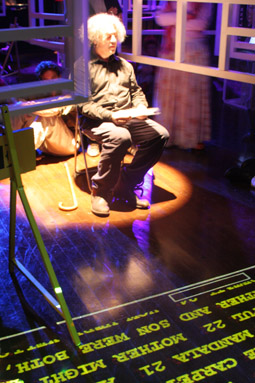
Ruark Lewis, Banalaties of the Perfect House
photo R Leech
Ruark Lewis, Banalaties of the Perfect House
the artist performs
KG Can we talk finally about the performative aspect of your work. You’ve performed in constructed performances—Alan Schacher’s work-in-progress, The Babel Project, and especially in Banalities for the Perfect House—but you also improvise. In the exhibition that’s recently concluded at Chalk Horse there’s a beautiful recording of you and Amanda Stewart doing something quite dramatic and very funny and largely unintelligible (but oddly recognisable as social exchange) with occasional literal utterances. You mentioned that at the opening you performed solo, apparently out of the blue. And that was related to the exhibition, a Nathalie Sarraute piece.
RL Around 2000 I broke with conventional narrative writing and autobiographical poetry. The typographical book False Narratives was my second attempt to generate a text solely for vocal performance. Amanda Stewart has always been out there moving away from narrative poetic forms into a more musical form which she excells at. We both appeared in the Berlin Poetry Festival in 2003 and I realised how far she pushed her work off the printed page. Watching her move through an extraordinary extended vocal range and seeing her technically adept performance has always been inspirational for me.
I have become increasingly interested in the process of concretising language and to make a score I could follow and make performances from. That’s the sort of thing I admired in Marinetti’s typographical novel Zang Tumb Tumb or Schwitter’s UR Sonata. Last year I asked Amanda to work on an improvisation that would in a non-representational way convey three emotions: anger, joy and sadness. As we huddled around a microphone in the studio we both began giggling, wondering how ridiculous we were. A really intimate moment between artists emerged as we worked out a range of responses that we might record. Rik Rue collaged our efforts adding layers and depth and spatial elements which formed a kind of audio space poem at Post-Museum in Singapore in 2007 then at Chalk Horse this year. I called it An Index of Emotions. I think visitors were surprised and confronted by those spatial effects and some of the sobbing sounds and angry tones were quite distressing.
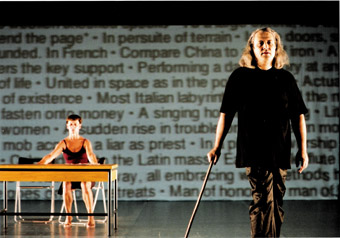
Ruark Lewis, Banalaties of the Perfect House, Berlin
photo Gerhard Ludwig
Ruark Lewis, Banalaties of the Perfect House, Berlin
I performed in Banalities for the Perfect House in 2005, a work made of numerous facets. Installation, poetry, computer music and recital. Performance Space commissioned the work as part of a gallery series called Who’s Afraid of the Avant-Garde. Banalities has been the name I’ve applied to numerous post-poetry writing projects. The structure of the writing comes from stacking and sequencing a kind of chance generated writing. The lines are generated by a structured procedure. I want the sentiments uttered to be formed by generalisations: “7. Angular sightings deliver films. 11. A pedant nut is formed by fourths. 17. A phenomena is massaged by oil.”
Rainer Linz worked from the outset of this project as collaborator. He’s a very intuitive person to work with. The musical and performative intelligence he brings into the working process of the theatre lifted the activity to a kind of alpha level. In creating it we met in Sydney and went out to visit Castlecrag one afternoon. I was keen to show Rainer Bill Lucas’s experimental houses at the Bulwark and in particularly his seminal work called the Glass House built in 1957.
We discussed the ideals of that satellite Sydney suburb. Castlecrag started as the utopian urban development that Walter Burly Griffin and Marion Mahony created for the Greater Sydney Development Association in 1921. Rainer viewed the Haven amphitheatre with its steep bank of sandstone seats and the stage area (with its excellent acoustic) all of which is surrounded by the thick green silence of the bushland. Later in the afternoon we called in to see two radical modernist houses designed by émigré German architect Hugh Buhrich down on Sugerloaf Point.
From our conversations that day we focussed on the social politics of the then state government planning minister Frank Sartor’s ill-fated Redfern-Waterloo Project, close to where we would perform and install our allegorical Banalities. Rainer enabled us to undertake the process of transcription from the writings and recordings of the spoken word and abstract vocals. He made a computer sound construction in 12 parts based on recordings of my voice. This 60 minute installation-for-performance changed the dimension of everything I’d experienced before. We expanded the texts using data projectors and painted the language components onto the various timber components assembled architecturally throughout the performance space. We penetrated every crevice of that building. The writing and soundings tracked around 12 stations to construct a work of theatrical proportions. Rainer’s directorial control of events was very cool. I was pretty tired having made the many complex timber components we used in the ‘installation.’ At the same time as fabricating I was writing the words to be recited as lists of aphorisms, Banalities for the Perfect House, the Newspapers, the Times, the Kitchen, the Solid Mandala, for Napoleon and the Perfect Place. It was an amazing and exhausting way of working toward a final piece. Rainer was in Melbourne processing and sampling and constructing the program that would generate the sound.
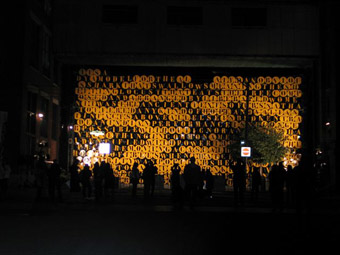
Euphemisms for The Intimate Enemy
courtesy the artist
Euphemisms for The Intimate Enemy
The work we are currently aiming at for the Toronto gig on October 4 is similar but different. That sound installation is called Euphemisms for The Intimate Enemy. The duration of 12 hours is much longer. The sound is computer generated once again but will be a live collage when the computer is started around 7pm on the night of the event. This work was commissioned by the City of Toronto. For it I’ve devised an installation of 550 oil drums to be stacked as a curtain wall between two 19th century industrial buildings. Each word of the Euphemisms is stencilled onto coloured (black and yellow) painted drums and will form an illuminated text in the void. Since last year I’ve become increasingly interested in the writing of the Indian Post-Colonial theorist Ashis Nandy. Some of my interest is microscopic by examination of Nandy’s phraseology. The transcription I undertake searches for the global facets in his sentiment, collated alongside recent world events which I hope forms a type of public poem: “4. The shifting locust that eats the tree. 5. Composed and arranged of liberated women. 6. It was the ancient texts of Krsna that offered any kind of hope.”
smashing poetry
RL I’m also trying to work out how to break narratives into the concrete sound forms. One day I decided to write more simply and in a sort of rude and abject manner. To do this I went into a series of internet cafes and wrote emails to friends that responded to a previous correspondence. That’s how I wrote 13 texts they were a sort of bad writing directed as a false poetic narrative. It was a kind of bent approach to the niceties that form in poetry and personal poetic sentiments. I made these writings tonal in that the phrasing was shaped for an easy speech flow. I used a numerical index and stacked the lines up one against the other. That way they become concretised. That was a breakthrough moment in the way I was thinking and making writing. That’s the way I really started examining the structure of computers and the internet. If I got a reasonable reply from my correspondent or we subsequently had a conversation I could integrate those parts tangibly into each story. I also had decided what the page length of the entire text measured before I started writing. I even had the thickness and shape of this book in mind and how the pages could be moved. I set the pages so they contained an unusually large font size and sans-serif characters. There are only six letters per line and nine lines per page. With such a structure the false narratives deteriorated physically and formed into pseudo phonetic clusters.
KG False in what sense?
RL They were to be abject stories, little short stories that were bad, set out to either say bad things or to be badly grammatically structured. And I just wanted to break off from poetry completely. I wanted to smash it and get rid of it. I had to do it within myself. That way I thought writing would be more useful to me again. So there I was at the keyboard chattering away, writing these often absurd narratives to friends. They often went out as an email but in a strange form of language. This typo-physical intervention would radicalise and disorientate the words, breaking their sense and interrupting their continuity. It was a literary architecture of the page that was generating and shaping textuality. In this process the page was automatically formed as a kind of score for abstract vocal performance. I first performed this sort of pure glossolalia at an exhibition in the basement of the Scots Church Studios. I just started to perform making sounds. I thought I’ll make noise and bounce around some of phoneme stuff of the broken letters. The performance went on for about 10 minutes. To my amazement the others in the room seemed engaged. They had big smiles and were not distracted. It was a fun way to animate the moment.
KG So you did it at Chalk Horse recently.
RL We reinstalled the transcription of Sarraute’s text SILENCE. It was suspended from the ceiling. Through the extraction of 144 key words and topic phrases we were able to stencil the results onto thin textile flags. In this way the texting bleeds through and distorts the readability of each side slightly. In this impromptu performance I caught sight of words and phrases as I walked through the installation. My voice changed in pitch and volume dramatically. At times I increased speed and then I slowed down or repeated a word more and more aggressively each time. The art crowd appeared suspended in shock by my uncalled for dramatic articulations. It was a sort of cathartic theatre for 10 minutes. And the theatre had come to them. Surprisingly the sense of Sarraute’s original drama seemed to stay intact even though my transcription and reformations of the page and the stage made it physically unrecognisable. In the mad way I did it, and that sense of character of the outsider looking in, moved those present that night and that surprised me. It just simply began.
www.ruarklewis.com
RealTime issue #87 Oct-Nov 2008 pg. web
© Keith Gallasch; for permission to reproduce apply to realtime@realtimearts.net
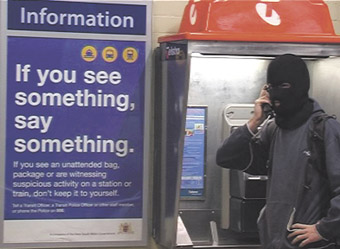
Jon Wah, Balaclava: “if you see something say something”; 2005
THE NAKED GUY IN VERMILLION BODY PAINT GESTICULATING AMONGST THE CLOWNS, THE GOLD GIMP AND THE SERIOUS LAPTOP MUSICIANS IN WADE MARYNOWSKY’S ARTSPACE INSTALLATION AUTONOMOUS IMPROV IS JON WAH. THAT FLEETING GLIMPSE OF BRILLIANCE WAS, FOR AUDIENCES NOT FAMILIAR WITH THE LOCAL SYDNEY SOUND AND PERFORMANCE FRINGE, SYNECDOCHE FOR AN EMERGENT PERFORMANCE AND VIDEO PRACTICE FIRMLY PLANTED IN THE TRADITION THAT EXTENDS FROM CHRIS BURDEN AND PAUL MCCARTHY TO GINA PANE, VALIE EXPORT AND MARINA ABRAMOVIC.
I’m not sure where that footage was sourced, but it revisits Wah’s early student collaboration in which he (again naked) had painted himself red, donned a leash and gone on all fours for the first year student he had dressed as a leather-clad dominatrix. Near naked Redman has since resurfaced in a nappy and Roccoco wig in Tillianakis’ Back in Black, but for me the original naked Redman will be Jon Wah, a rude baboon-bottom red, wearing his sexuality as playful insolence, not in his genitalia, but on his skin.
Then there was yellow man, Jon Wah lead singer, body painted puce for the band The Bloodied Cunts, spewing on stage in puke rock homage to the punk days of affectionate gobbing (Electrofringe, 2005, with Abe Powell and Flynn Donovon). He could go to the dark places, the extreme places (videoing friends in the intimacy of excretion for his study of the formal aesthetics of poop) but among the most memorable were the delicate Zen-yogic balancing works: Wah in a yoga position, feet extended along his side of a half-empty seesaw, the other side stretching to the disproportionate length of a massive symbolic blank. This was Wah in philosophical mode, balancing life against Lacanian psychoanalyis’ structuring void, the lack at the heart of the subject (Position of Balance 1).
In Position of Balance 2, Wah filled out the void of desire by matching his weight with a crate of beer—on the one hand a blokey joke towards his own fondness for drink (and a dig at the modesty of TS Eliot’s Prufrock, measuring life out in teaspoons of coffee). But that crate of beer also represented a critique of capitalism and consumerism (how we fill that metaphysical void by stuffing ourselves).
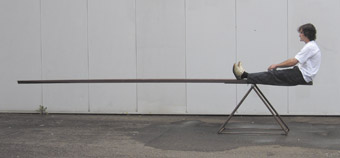
Jon Wah, Position of Balance I,
‘ …to balance my body against the weight of the board…’ 2006
Position of Balance 6 (First Draft, 2007) had Wah with arms and feet stretched out towards a precariously balanced video camera projecting his image on the wall. In this subtle endurance work he swayed up and down in micro-movements on the tipping and rebalancing beam. Metaphysically speaking, Wah’s decentred subject was now alienated, ex-sistent, in the image’s mediating representations. Of course, Wah’s performances played out without any psychoanalytical framing: they were immediately, intuitively grasped. The strength of his work was that his insights were instantly recognisable, even if hard to put into words (try explaining a complex joke).
Dressed (Serial Space, 2008) was his last performance work. Naked, he summoned the crowd to follow him down a flight of stairs where he ritually wrapped himself in barbed wire, pulled on clothes and then re-ascended (in wincing pain) to retreat behind closed doors. In the following symposium Wah’s analysis amounted to frank confession: the performance was an allegory for a life lived increasingly out of control. When his wire cutters didn’t work he had to call friends into the back room. Finally the audience saw the ambulance men arrive to disentangle him.
Repenting his extreme behaviours, Wah apologised for demands beyond those with which friends could cope. The clown-prankster doing the thing that he does best, going in too deep and needing help to get out, acknowledges the debt and what he has put the other through.
When viewed through the history of performance, and more recently, relational aesthetics, it’s a complex work. The ‘for whom’ of Wah’s barbed wire piece goes beyond the ruse of “I f’d up on the wire cutters.” Wah was revisiting those 1960s works of risking the body in the contemporary context of the politics of friendship: art as an examination of the demands on the other.
Wah leaves behind an original and important body of work yet to receive the critical commentary it deserves. This includes Balaclava, on the politics of terrorism, and the movie-length sitcom King of the Loungeroom, with its anti-corporate ads. In video and performance Jon Wah opened a territory that was his own. Jon Wah died on June 29.
“Art is easy, it’s life that’s hard.” Jon Wah interviewed by author, March, 2008.
Ann Finegan
On Friday December 4 a retrospective of Jon Wah’s work opens at Serial Space 33 Wellington Street Chippendale, serial@live.com.au
RealTime issue #87 Oct-Nov 2008 pg. 52
© Ann Finnegan; for permission to reproduce apply to realtime@realtimearts.net
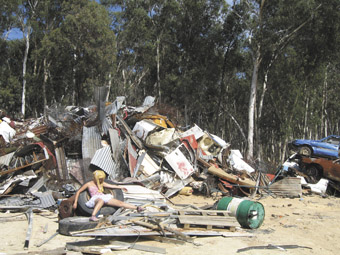
Katthy Cavaliere, Loved, 2008, installation/performance
TO CELEBRATE ITS 25 YEARS, ARTSPACE IS TURNING ON QUITE A PARTY FEATURING ONE HOUR TURNS OVER TWO DAYS BY 24 ARTISTS WHO HAVE ALL AT SOME TIME EXHIBITED WITH THE GALLERY IN WHAT PROMISES TO BE A SIGNIFICANT HOMECOMING.
These mini-exhibitions will include installation, performance, moving image, sculpture, photography, new media and painting, all in the spirit of the gallery’s long tradition “as an active working space, a place in which to think, intuit, experiment and make.”
Artspace 24/25 also implicity celebrates the work of generations of artists from the 80s (the gallery opened in Surry Hills in 1983 and moved to Wolloomooloo in 1992) to the present whom the gallery has supported in exhibitions and through the sustained provision of an invaluable critical context through publications and vigorous debate.
The artists showing are Jim Allen, Brook Andrew, Denis Beaubois, Mark Brown, Katthy Cavaliere, Julian Dashper, Elizabeth Day, Richard Dunn, Mikala Dwyer, Domenico de Clario, Deej Fabyc, Matthys Gerber, Joan Grounds, The Kingpins, Derek Kreckler, Wade Marynowsky, Mike Parr, Eugenia Raskopoulos, r e a, Nuha Saad, Jill Scott, George Tillianakis, Mark Titmarsh and Julie Rrap.
Curator Kylie Johnson tells me that the approach has been open-ended, artists providing existing or new works, but each working strictly with the 60 minute limit, which includes setting-up time.
In the first space, on entering the gallery, you’ll find ephemeral materials hung on the walls and in bound scrap books, one for each of the 25 years. The display includes invitations, catalogues and press clippings. You can have a coffee while you browse and your memory of Artspace history, “will be jogged by the amazing number of significant names who have been involved with the gallery”, says Johnson.
The large gallery space will feature performances and object-based works while the smaller will house projected works. Set to run to a tight timetable, says Johnson, Artspace 24/25 should yield many pleasures and, not least, a serious celebration for a uniquely creative Sydney insitution’s 25 years and the many to come.
Artspace 24/25, Woollomooloo, Sydney, Nov 1-2, 11am-5pm
RealTime issue #87 Oct-Nov 2008 pg. 53
© RealTime ; for permission to reproduce apply to realtime@realtimearts.net
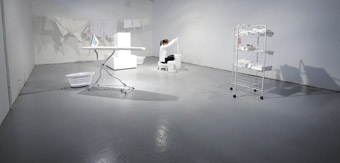
Philippa Steele, White Wash
photo Sean Fennessy
Philippa Steele, White Wash
INITIALLY UNAWARE OF THE IRONY, I QUICKLY SORT THROUGH MY CLOTHES BEFORE I LEAVE HOME, PLACING DELICATE ITEMS IN PROTECTIVE NET BAGS. CAP FULL OF LIQUID. CLIP THE CIRCULAR DOOR SHUT. A MULTITUDE OF BEEPS TO FIND THE RIGHT CYCLE. PRESS “GO”. LEAVE. MY DESTINATION IS WHITE WASH, WHERE ALL OF THE STEPS IN MY TWO MINUTE PROCESS AND THE ENSUING WASH, ARE RECLAIMED BY ARTIST PHILIPPA STEELE IN AN ACT OF SLOW DEDICATION.
A soft sloshing greets me as I enter. The diminutive artist is perched on a small white stool, her white gloved hands working away steadily at a white towel immersed in one of a number of similarly monochrome buckets. Surrounding the artist are a series of ‘stations’ that offer the tools required to sort, tag, rinse, wash, wring, dry, iron and set aside for collection. Each station is stripped to the bare minimum. Apart from the electric iron and the small white laptop for entering data, there are no smooth whitegoods or unwarranted beeps. The smell of clean clothes surrounds us. Everything is white.
Every week we wash. This has gone on ever since we began our long obsession with cleanliness and desired for more than the clothes on our backs. For most, the experience matches my opening sentences—a quickly executed series of steps with coffee, toast or child in the other hand, followed by a reluctant hanging out, sometime later.
This year Steele completed a six month stint living and working in India. As with many before her, the experience has had a profound effect on the way that she views her daily existence and consequently her art practice. Prior to this journey, her work focused on the object or what she likes to call ‘thingness’ and a process of identifying and removing associations that defines any one thing, with the difficult ambition of achieving ‘nothingness.’ Through observation of the devotional attention to everyday processes in India, Steele has made a lateral shift, focusing her intimate, intense attention on the action.
The set up is sublimely simple. The artist is offering to handwash people’s clothes. Steele’s advertisements in the local paper and flyers placed with nearby businesses invite members of the public to bring in white items for washing, with the provocative tag line “I WANT YOUR DIRTY WHITE LOAD.” All items are entered into a database, sorted according to necessary treatment (soak, starch, iron etc), tagged and then laundered by the artist within the gallery space throughout the three week exhibition. Just as in any other service industry, Steele states that she aims to be “friendly, approachable and professional.” There is no charge.
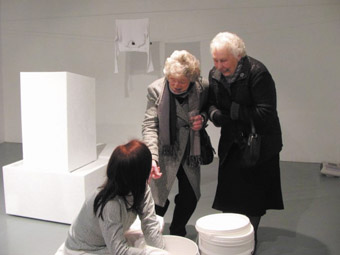
Philippa Steele, White Wash
photo Sean Fennessy
Philippa Steele, White Wash
While simple in set up and aesthetically austere, the translation of this daily process into a gallery show creates a layered, powerful work, which unfolds as you spend time in the space. There are obvious links to the lowly paid labour of those within the service industry, particularly in the developing world. Steele’s refusal of payment amplifies this transaction and she notes that some ‘customers’ express discomfort with the arrangement. The work clearly highlights the disconnection that Westerners now have from the details of daily life, but for Steele I think the most resonant aspect of the work is the potential for meditation through the action. She has found herself perfectly absorbed in the simple steps of washing and feels that she has achieved active meditative states. The tiny, tiny details like the fine fibres impossible to remove entirely and the vast variation in ‘whites’ have found their way to her attention. Her intent, I believe, is for everyday moments of spirituality reached through quiet observation.
The artist acknowledges and embraces the inherent contradictions in the work. In attempting to remove associations through stripping away and ‘whitening’, Steele succeeds in bringing every single object into focus, with items like the electric iron and plastic coated hangers reading like iconic artefacts. Placing the work within a sterile gallery context brings with it an ironic sense of disconnection with her Indian experience as this cool white room is surely no match for the humming, sensory environment in which she first recognised the potential in these acts. And I wonder about the actuality of meditative states for those whose life offers no choice but to wash in this manner.
I leave the gallery to the soft slap of towels against the washing plinth and look back to the shadow of the action against the white walls. Some minutes after I arrive home, sing song beeps signal that my wash is complete. As I shake out each item and hang it on the drying rack, I take stock. I notice the soft snap as I shake the clothes, I watch my hands as I place each item to maximise drying and I reflect that a little of Steele’s attention has quietly travelled out of the gallery along the road and into my home, my hands, my work.
Philippa Steele, White Wash; Inflight Gallery, Hobart, July 4–26
RealTime issue #87 Oct-Nov 2008 pg. 54
© Judith Abell; for permission to reproduce apply to realtime@realtimearts.net
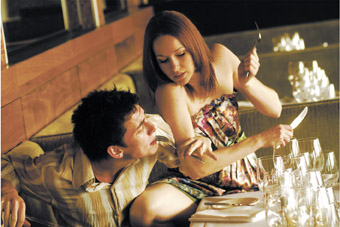
Joshua Mu, Aisling Donovan, Preparing to be Beautiful
photo Ashley de Prazer
Joshua Mu, Aisling Donovan, Preparing to be Beautiful
THESE DAYS THE POSSIBILITIES FOR OUTRAGE SEEM SO MUCH MORE PREVALENT WHILE ITS MANIFESTATIONS VERGE ON THE PRIVATE, EVERYDAY ERADICATION OF RIGHTS SLIPPING BY UNACKNOWLEDGED. ARE WE SLOWLY COMING TO OUR SENSES, I WONDER, WAKING TO WHAT’S HAPPENED WHILE WE’VE BEEN WATCHING OUR BACKS? ARE WE READY NOW FOR ART THAT MAKES US RAGE?
Enter Artrage, now in its 25th year and talking up its silver anniversary, which has a quaint ring for what has been by all accounts a gathering of creative tearaways, a festival of the emergent appearing unannounced in all manner of unlikely spaces. This year’s brochure looks disturbingly sweet until you read between its pages the old signs of subversion.
The necessary Climate Change action appears impressively hands-on as we should expect from the avant-garde. Following the supportive paras from sponsor Western Power who’ve planted enough trees to compensate for production of the festival, is the invitation to Artrage audiences to participate in “WA’s first mobile, networked, pedal-powered generator system.” You’re asked to “bring in your bike or use one of ours and contribute your pedal power to producing electricity to run parts of the People Power program.” This includes 1,000 LED lights attached to kites flying above the cultural centre on the Saturday night of the Northbridge Festival. Let’s hope Prof Garnault is taking notes.
Performances/events will be staged at The Bakery Complex as well as a range of other venues and galleries in Perth and Fremantle. A show that caught my eye, as one who likes to dance to the beat of a different drum: a Silent Disco where you “enter, put on headphones, choose your channel then shake it with your dance floor pals.”
In the performance arena, Home Alone showcases new WA contemporary dance as Company Upstairs, featuring Bianca Martin and design artist Jamie Macchiusi, “take a peek through the windows into an abstracted image of everyday life and contemporary Australian domestic normalcy, weekend DIY projects and debt consolidation.” And as if that weren’t enough, they’ll also be delivering “a tale of gratification via material goods, a housing squeeze and life in the lucky country!” Red Shoes is an equally ambitious “radical reworking of the fairytale by Mathew Lutton transgressing gender, eras and theatrical boundaries.” The triple bill Dyuetto includes dancers from The Dance Box in Osaka; Dancehouse in Melbourne and STRUT Dance in Perth.
What would happen, I sometimes wonder, if artists were held to account for the questions they pose at the outset of a creative process and their findings published in worthy journals like The Lancet? I look forward to results on the premise for Preparing to be Beautiful with 6 young dancers, choreographed by Alice Lee Holland, score by Julian Day: “What draws us to symmetry, structure and order” and further, what is behind “modern-day voyeuristic tendencies that reveal an interest in chaos and spontaneity?”
In 24HR Comics, an Artrage-FTI (Film & Television Institute) project, “[s]imultaneously across the globe thousands of eager artists will be doing their best to create a new comic book over 24 consecutive hours.” The book will be posted on the artrage website after October 20.
PVI’s loyal citizens’ underground will be doing their rounds during the festival watching out for transgressions in the municipal order. The festival offers another chance to see REFORM, the company’s witty, interactive performance that cleverly confounds its audience. This is the team that apparently had Singaporeans eating their potato crisps with chopsticks. PVI are also presenting This is the Time, a one-night only event featuring short and edgy performance works from across the country including Unreasonable Adults (SA), Spat & Loogie (NSW), Martyn Coutts, (VIC), Version 1.0 (NSW), panther (NSW), sic (WA), Cat Jones (QLD), Hydra Poesis (WA) and Michelle Outram (WA).
The History of Glass looks intriguing. “One day a whole lot of people wake to find themselves imprisoned in a huge cube of yellow glass.” I know the feeling. Told in a series of 80 short prose poems by local performer Mar Bucknell with live soundscapes by Allan Boyd and projected live drawings by Stuart Reid. In Limbspeak, WAAPA’s Michael Whaites and guest choreographers present new works in which physical and verbal mingle.
And this one on the complexities of internet criticism: Apocalypse Perth. “In January 2008 a cruel and anonymous review of an amateur production was posted online. What followed was an online exchange of observations, criticisms, insults and invective.” Based on the online forum and interviews with those who took part, Apocalypse Perth is a verbatim theatre piece brought to the stage by seasoned performers Kate and Jeremy Rice joined by a large cast. In another apparent oddity, Martin Heine Performance entails simultaneous projection of a series of collaborative performances generated by Dr Martin Heine and Dr David Bromfield, “creating an omnipresent, all powerful performance environment…Gaze as Heine cuts out the silhouette of Perth’s most hated art critic with his chainsaw. ” Better still, be there at KURB Gallery “when he does it live with an Elephant.” Possibly outrageous.
There are lots of mobile works to accost the unsuspecting with art from all angles: Street art adventures (The Trickster’s Bible); a portable confessional (Jen Jamieson’s The Booth); a Laser tagging gig with local artist Jeremm Lynch who worked with ANAT’s USA guest artists Graffiti Research Laboratory earlier this year, and CONTROLLED RIOT in which electro-punk Tomás Ford “is joined by an army of minions to conduct experiments in crowd control, and a frantic DIY on the night of the closing party.”
Silent Barrage is the culmination of six years of research by Phil Gamblen and Guy Ben-Ary (SymbioticA) contemplating the artistic and philosophical implications of an entity made of a “living brain” controlling a robot body. Silent Barrage presents “60 sculptural robotic objects, each responding to electric activity occurring in a living network of rat neurons, grown in a petri dish inside the Georgia Institute of Technology, USA.” For one night only Silent Barrage will be presented as an active public lab. Wear white.
The year’s festival poster features a small section of Rose Skinner’s Forbidden Garden installation commissioned by Artrage. Its “hyper-coloured psycho-popic landscape and zany assemblage of characters” induces visual hyperglycemia and aptly captures the promised mood of the festival, 25 years on and still raging. RT
RealTime issue #87 Oct-Nov 2008 pg. 55
© RealTime ; for permission to reproduce apply to realtime@realtimearts.net
ADAM BROINOWSKI’S NEXT WAVE JOURNEY TAKES HIM FROM MULTIMEDIA DANCE TO A TELEPHONE EXPERIENCE FOR AN AUDIENCE OF ONE TO A CLUSTER OF IMMERSIVE INTALLATIONS AND A ‘MISGUIDED’ TOUR OF AN ART GALLERY.
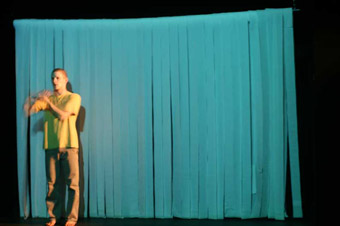
Pay no attention to the man behind the curtain, 2008 NextWave Festival
photo Gareth Hart
Pay no attention to the man behind the curtain, 2008 NextWave Festival
alisdair macindoe: pay no attention to the man behind the curtain
Framed by the Wizard of Oz, Pay no attention to the man behind the curtain is an interesting combination of sound/video tech savvy and lithe dance. Alisdair Macindoe, in olive green and khaki, stands in a demarcated square. He relaxes himself, and us, with some direct eye contact, then shakes his head at increasing speed. What is he renouncing? A blurred still of his face is projected on an adjacent screen as he wades through the red light which slices a stage swamped with smoke. The plucking sound of an unfamiliar instrument, a projection from his p.o.v. shows his arms reaching out towards us. Circuitry from outdated machines together with his whirling circles and mechanical movements suggest nostalgia. We are shown black and white video footage of a body being kicked and taunted by a circle of soldiers. The screen goes red. “There’s no place like home”, Macindoe says through distortion. Does he come home in a box?
Macindoe dances in the square a second time, more fluid, urgent, immediate. He faces the audience again, then falls back as if pulled by an ineluctable force, or shot by machinegun rounds, jumping time, crossing the river Lethe, through a rising roller door, into a cell of strobe. Arms outstretched, an open mouthed silence, along with dripping notes, sine tones and clanking repetition, he is a prisoner once more.
As strategic revisionism remixes the past via ‘truth’ technologies, the screen is lifted to reveal a musician tinkering with assorted instruments. This study of echoes determines a body besieged by the light of multi-barrelled cameras, above and below.
sam routledge & collaborators: please hold
I am trying to remember a word as I enter Please Hold at the Meat Market. Alone and comfortable, I’m in a motel after a long drive perhaps. A lamp warms the room, and a white dial phone is perched on an all-in-one 50s seat and table. I sit on the carpet, and reluctantly pick up the phone.
“Did you get the image?”, she asks, familiar and very close. “No.” “Anyway, it doesn’t matter. I’ll take a photo of the television.”
And so the conversation goes; she misses me, wants to see me, recalls the breezy curtains under which we happily lay together in bed. She flirts and lulls and oils me, drawing me in, and I find myself dancing, asking if we could be real once more. But she holds the script. Memories are like glass and she quickly goes through them: pained—denying getting fat, blocking out the vomiting and shitting in front of me; empathetic—the shock of the light must have been great; romantic—driving together towards the horizon; longing—in her arms, fists going like a boxer, hands trying to grasp something; remorse—you can’t hurt the thing that looks at you, all I had to do was to put my nipple in her mouth; acceptance—she’ll never know who we are. “Anyway”, she says, “It’s you.” She hangs up. The lights fade up.
Film footnotes from road movies are woven through this intimate installation by Sam Routledge, Halcyon Macleod, Declan Kelly and Alison McNicol. In a duplicitous game, the artist implicates the listener in heightened dramas which they are inclined to unpick. Bitter sweet, transcending road movie clichés, its precision strikes a deeper chord.
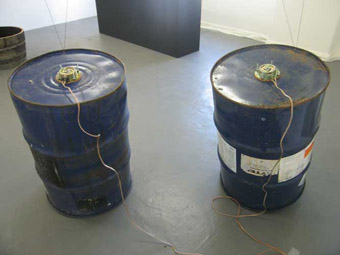
Tracts, 2008 Next Wave Festival
photo Paul Davis
Tracts, 2008 Next Wave Festival
curator ben byrne: tracts
To experience Tracts, I enter a room at the end of a long, tiled corridor up high in an old city building. Tremors, by the show’s curator Ben Byrne, sets the tone by asking us to throw a rock from a bowl into a pool of water. Byrne combines Leonardo da Vinci’s view of the ensuing circles as infinite images of themselves with Giorgio Agamben’s notion of potentiality as knowledge of an ability. The potential of sound waves which travel and intersect with others while maintaining their discreet form is ominous.
Adam Costenoble’s Obstruction is a cubic concrete box with a concrete lid, concealing a relationship of heavy impacts and deep rumbles which will not be seen but may be heard and felt. He quotes Boyd ‘Red’ Redding on incarceration dependency. Matt Chaumont, in An Example, tilts two oil drums like timpani with embedded speakers creating a deep, almost inaudible dissonant rumble. He reflects in the exhibition notes that what he has done is in fact done by something larger than himself, but is this irony, complicity or passivity?
Thembi Soddell’s black box, into which you climb and sit comforted in the dark and where you are filled with ominous throbs, rushing roars and a washing away below audible thresholds, is an internalized escape. Or does it represent hidden memory? Quoting Sylvia Plath’s “safety comes from being in a room without windows”, it seems it is the former.
freakley & mcgechie: dear art, please touch me
Cleverly, the artists of Dear Art (Danielle Freakley and Elizabeth McGechie) have grafted themselves onto artists of another genre in what they call “reanimating iconic works.” As in any art gallery commentary, as you look at the NGV permanent Australian collection you listen to designed audio commentaries—only in this case of popular democracy they are responses generated from anonymous, random members of the public.
You trip through the kaleidoscopic vision of two children in front of Presentation Cradle by George Armfield (1890). For those same two children, the black and white emu eggs of Casket (1869, artist unknown) represent the rules of the cosmos in which black gods must protect white gods. When white Adam and Eve treat black Adam and Eve badly, the black ones grow fierce and hunt the white ones instead. GF Folingsby’s Bunyan in Prison (1864) is treated to a comic re-enactment—an obnoxiously drunk man ridiculed by the women seated around him. According to a young man, Exterior of Brickhouse (1860s), by the same artist, is occupied by an old Eastern European woman peeling potatoes.
A middle-aged woman regards WWI gassing survivor Penleigh Boyd’s The Breath of Spring (1919) as a coveted, decorative asset untainted by current affairs. Seeing a woman helping a child on a beach in Rupert Bunny’s Shrimp Fishers at St Georges (1910), a woman in her 20s speaks of her exclusion from the dominant heterosexual paradise because she cannot have babies.
Hugh Ramsay’s portrait of himself (smoking in front of a piano, 1901-2) suggests to a Caribbean male musician that, like himself, Ramsay plays music to make people happy and therefore is a good artist. Clarice Beckett’s Street Scene (1925) triggers a younger woman’s memory of her desire to escape from a childhood of discipline. A young man argues that self-worth is not found in national patriotism upon seeing the house beneath the Sydney Harbour Bridge in Grace Cossington Smith’s The bridge-in curve (1925). For a catarrhic man, the figures in Albert Tucker’s Sunbathers (1945) in repose under dark skies are Baconesque flesh, waiting for overpaid GIs to land. For an older, rounder woman, Danila Vassilieff’s Petit Bourgeois (1950) is a goddess symbol of the perfection of motherhood, while the Footballer of Sidney Nolan (1946) is lampooned by a “fat kid who grew up hating the thuggery of organised sport and read a lot at school.” Of John Brack’s Collins St 5pm (1955), the two children describe the sad, boring, restless faces of those marching off to work to pay the rent.
Pay no attention to the man behind the curtain, performer Alisdair Macindoe, media artist Cobie Orger, sound artist Simon Charles, instrument builder Rod Cooper, writer Kynan Hughes, Malthouse, May 22-24; Please Hold, original concept, direction Sam Routledge, writer-performer Halcyon Macleod, design Alison McNicol, sound design & systems Declan Kelly; Arts House Meat Market, May 22-31; Tracts, curator Ben Byrne, Blindside Gallery, Nicholas Buildings, May 22-June 7; Dear Art, Please touch me, Danielle Freakley, Elizabeth McGechie, Ian Potter Centre, National Gallery of Victoria Australia Gallery, May 24-June1; Next Wave Festival, Melbourne, May 15-31, www.nextwave.org.au
RealTime issue #86 Aug-Sept 2008 pg.
© Adam Broinowski; for permission to reproduce apply to realtime@realtimearts.net
THE 2008 NEXTWAVE FESTIVAL’S PROGRAMMING CONCEPT OF “CLOSER TOGETHER” INITIATED BY JEFF KHAN AND THE NEXT WAVE TEAM FOUND RESONANCE IN ALL OF THE WORKS I WITNESSED OVER THE FESTIVAL, WORKS WHICH INVITED AUDIENCES INTO INCREASINGLY INTIMATE SPACES, BOTH PHYSICAL AND TEMPORAL.
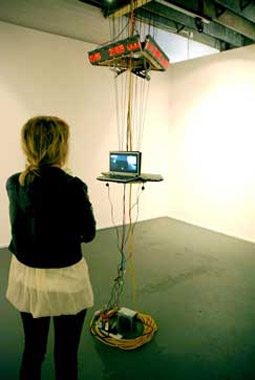
text:form, 2008 Next Wave Festival
photo Alec Lewis
text:form, 2008 Next Wave Festival
alec lewis: text form
From the most ephemeral of spaces, the cybersphere (our virtual addition to the troposphere), where presumed dislocation creates a digital anonymity, Alec Lewis’ Text Form exposes solo intimacies of information gathering. The work actually has its genesis in a corporate “screw up” (“This was a screw up and we’re angry and upset about it”, media statement Andrew Weinstein, AOL Vice President of Corporate Communications: www.lot49.com/2006/08/aols_mea_culpa.shtml).
Back in August 2006, AOL released the data of 20 million searches by 658,000 of its users. Digital privacy advocates were soon shouting down the cables and the data was promptly removed—but the digital democracy of the net being fluid, nothing is truly lost forever and you can still find the files on numerous mirrors around the world.
Lewis uses this leaked information both as instigator and raw material for his compact installation. The search data is displayed on three scrolling LED screens which note the random user number, the time of search, the search term and the website subsequently visited. Below these are three small LCD screens that run through video works made in response to various searches. Lewis has largely gone for those with the most impact—searches for deviant fetishes and oddball imaginings. For instance, User #3318459 has a string of searches based around the theme of filet à la femme: “barbequed girl meat”, “girls fattened for butchering” and “cannibals feasting on the buttocks of young girls.” The video work intersplices images of a butcher flaying a large slab of meat with a girl undressing in a bedroom, oblivious to the presence of a hooded figure nearby. This hooded voyeur makes several appearances over the course of the videos, acting as a simultaneous metaphor for the unseen searcher and for us as viewers. A serious drawback of the installation was the lack of information regarding its inception—I only became an enlightened observer after attending the artist’s talk. The program notes promised to make people think twice about how they used the internet and I for one will not be asking Google “is it healthy to store up semen or cum in a glass and drink it for a week” like user #7897282 did.
matthew prest & collaborators: the tent
The warm beef stew we’re presented with is a hearty reminder of the chill wind outside and simple camp chairs creak under-bum as the audience settles back to hear a tale. We are inside a large canvas tent, and thankfully so, our small party having been led off the concrete carpark behind Federation Square down behind Birrurung Marr to a huge gravelled lot beside a lattice of railway tracks. For the moment we are simply glad to have escaped the piercing Melbourne cold, the kind that creeps through any crack in scarved and hooded armour however small.
Our guide and host is Michael, a clean and wholesome 20-something corporate worker, and while his current relationship to Brett, the owner of the tent, is not fully clear—we have just witnessed him run flailing after Brett’s white Commodore which sped off at our approach—he assures us that Brett will be only too happy that we’re here. Michael casts off his black suit for comfy flannel jim-jams and the story of his meeting with Brett unfolds. Brett is a bushie, a modern jolly swagman who lives off the land and a doctor of philosophy dropout made larger than life by his conspicuous absence.
The performance team of Matthew Prest, Danny Egger, Clare Britton and Eddie Sharp use a deft array of theatrical constructions from revelations of spaces within spaces, puppetry and snippets of Brett’s recorded Chautauqua or travelling tale to illuminate the meeting of these two souls. Prest as Michael is subtly nuanced and engaging, constantly keeping his audience at the fore, more than readily dropping segments of the tale he feels are unnecessary. But it is with Brett’s sudden return that things become doubly interesting. With Michael bidding a hasty farewell after few pleasantries, we are left alone with Brett, unsure now as to what our contract as audience has become. Have we been invited into the tent or have we infiltrated it? Have we been abandoned to explain our situation as viewers/voyeurs/audience to a man whose space we have breached? The discomfort of intruding, of being brought too close together is languidly teased out. Seated inside the tent, simultaneously shelter, storytelling soapbox, nomadic structure and concrete example of a slightly ascetic philosophy, we are given the space to ponder not only the elements which keep us bound together, but also those which push some of us further apart.
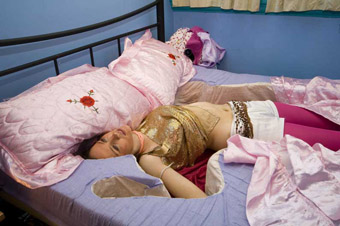
Swimming Home in Heels, 2008 Next Wave Festival
photo Jorge de Araujo
Swimming Home in Heels, 2008 Next Wave Festival
post: swimming home in heels
For Swimming Home in Heels by Sydney trio Post, we were brought about as close as we can get. A single audience member at a time is led into a miniscule dorm room above a trash bag inner city pub overflowing with feminine detritus—half eaten packets of chips and chocolate lie strewn amongst g-strings and party clothes, the heady fug of Impulse, Passiona and cheap white wine. As soon as the door opens, the hurricane pace of stories and anecdotes begins. Plastic cup of cheap goon in hand I sit in the only available space at the foot of the single bed and hear how Mish got fingered by a random bloke on the bus and then of her exploits last night with this toothless geriatric. A debate erupts as to whether she pashed him before or after she spewed.
Post excels in the construction of biting Australian satire. The confidence that we are positioned in as active participants implicates us in a schoolies world of booze, sex, music and raucous party binge, where everything is just so fun and meaningful and special y’know. OmyGod and did I tell you how we all lay back on the bed and listened to Destiny’s Child, spesh! Or how Mish painted my nails or when Nat and Zoe did their, like, fully amazing dance that they’d been working on for, like, ages? The performance is hilarious in its folly and a scarily evocative facsimile of a weekend at 16.
Post’s previous works in Melbourne—Gifted and Talented [RT80 p46, RT85 p12] which equated stage mothers with the guards of Abu Ghraib, and Idle Hands Wake up With Fleas which taught the audience a choreographic score composed of military restraint tactics—contained a dark and overt politic which helped to reposition the work in a somewhat violent way. And while for some, the proximity to the performers will be confrontation enough, the lack of political engagement in this new work yielded only lightness and frivolity—a shame, for harsh realities were what made the satire of their previous works so disarming.
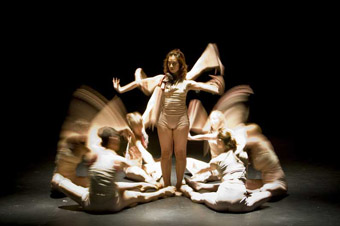
Ocular Proof, 2008 Next Wave Festival
photo Jorge de Araujo
Ocular Proof, 2008 Next Wave Festival
rogue: the counting & ocular proof
Rogue formed as a close-knit graduating company from VCA Dance 05 and look set to become an important addition to Melbourne’s contemporary dance and performance world. The collective works as both ‘guns for hire’ with external choreographers (and powerful guns they are) as well as creators of their own movement and visual scores. In this double bill they display their strengths in both capacities.
The Counting is an intricate succession of non-repeating isolations striking in its syncopation. Choreographer Antony Hamilton extends the defined flurries of movement from his recent debut, Blazeblue Oneline [RT85 p35] to create complex structural rhythms for his dancers. The impetus for this mechanised movement is from circadian rhythms—inherent cellular and physiological cycles that occur within the body over a 24 hour period. The bodies on stage, dressed in the co-valent colours of enzymes, engage in a series of duo and group architectures that draw us close into this microscopic realm. Working at odds with the resonating undertone of the musical score, the bodies, captivating in their hermetic constraints, inhabit their own rhythmic spaces.
Ocular Proof reconstitutes Rogue as makers. As we file into the cavernous space of the MeatMarket’s adjacent main auditorium, a dancer greets each audience member in turn with a kiss on the cheek and a whispered welcome. The work originally set out to explore our perception of truth, but from the outset it is clear it is now about something else—the intimate spaces of love. We watch a shadow play pas de deux of hearts and lovers intertwined, a baroque puppetmaster seated at a luminous limb-thrashing feast, and a clever evocation of a couple exhausted by passion as the music threads from minimalist to electro to grinding industrial. In the latter part of the piece, Olaf Meyer’s multimedia projections create a truly remarkable visual hallucination. Meyers builds on his visual experiments in Ivan Thorley’s Dreamland [www.realtimearts.net/article/issue76/8471] using camera and projector to map and track the shifting body, creating a synchronicity between visuals and the body that I haven’t witnessed since the early work of Japanese company Dumb Type. This, combined with Rogue’s energetic virtuosity, made for one compelling night in the theatre. Definitely a company to watch.
Text Form, artist Alec Lewis, Kings ARI, Melbourne, May 9-31; The Tent, director Matthew Prest, performers Matthew Prest, Eddie Sharp, tent designer, technical director & stew maker Danny Egger, puppeteer, puppet & set design Clare Britton, sound design Jack Prest, The Paddock, Federation Square, Melbourne May 21-25; Post, Swimming Home in Heels: A performance about lies, performer-devisors Zoe Coombs Marr, Natalie Rose, Mish Grigor, The Exford Hotel, Melbourne, May 15-30; Rogue, The Counting, choreography Antony Hamilton, performers (Rogue) Derrick Amanatidis, Danielle Canavan, Holly Durant, Merryn Heath, Laura Levitus, Kathryn Newnham, Harriet Ritchie, Marisa Wilson, Suhaili Micheline Ahmad Kamil, lighting Alexandre Malta, costume Doyle Barrow, music Panasonic; Ocular Proof, choreographer-performers Rogue, multimedia design Olaf Meyer, lighting Alexandre Malta, costume Doyle Barrow, music Lachlan Carrick, Meat Market, Melbourne, May 28-31; 2008 Next Wave, May 15-31, www.nextwave.org.au
RealTime issue #86 Aug-Sept 2008 pg.
© Alex Ben-Mayor; for permission to reproduce apply to realtime@realtimearts.net
I’M SITTING IN THE BAR OF MELBOURNE’S CARLTON HOTEL, PONDERING A THREE METRE HIGH STUFFED OSTRICH AND THE DECAPITATED HEAD OF A BABY GIRAFFE HOVERING ABOVE PATRONS HUDDLED IN BOOTHS, SOME SIPPING COCKTAILS, OTHERS SMOKING CIGARS. MELBOURNE HAS ACQUIRED A NEW EXOTICISM: NO-ONE HERE REALLY GIVES A STUFF ABOUT GLOBAL HOMOGENEITY, OR THE DISSOLUTION OF GEOGRAPHICAL BORDERS IN A MEDIA MAD WORLD AND A RESULTING LOSS OF CULTURAL IDENTITY. BUT EVERYONE IS PRETENDING THEY DO…
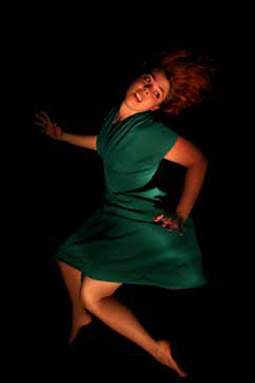
Six Minute Soul Mate, 2008 Next Wave Festival
Image coutesy the Brown Council
Six Minute Soul Mate, 2008 Next Wave Festival
brown council: six minute soul mate
Thank Christ the woman dressed in a bear suit who leads me upstairs to Six Minute Soul Mate has a nod and a wink for her inductees. By getting closer together, we are moving further apart. This paradox is the central preoccupation of the Next Wave Festival. Consequently, Melbourne has become a city captivated by the strange and the bizarre. That bear bustles us into a small room, its rear wall adorned with a tropical sunset framed by a painted love heart. A young woman enters wearing a bad wig and blue sequined top, sits on a stool, and gushes over what it is she wants most from a relationship. Just as she’s getting to the part about her previous boyfriend abandoning her on the Ghost Train at Luna Park, that bear interrupts. Carrying a portable CD player bleating out the ballad Take my Breath Away, the bear explains that our time is up. We are then corralled along a hallway toward a second room that is reminiscent of a trip through a massage parlour…This same performance framework is then repeated by four women playing three characters on nine occasions in three separate rooms, during a procession through different stages of each character’s tragic life.
Six Minute Soul Mate is a sardonic dissection of the human need for companionship, and a backhander for any aspiring actors in the audience. Progressing from hopeful dreams to increasing desperation, each character enters a state of lonely psychosis—exemplified by the same young woman, now grown old, indulging in an autoerotic fantasy by submerging her head in a bucket of water and holding her breath until it hurts. Isolated and alone, the last vestige of the lonely is a sadomasochistic pleasure that devastates this small audience before that bear interrupts once again, and leads us back into the foyer to celebrate with unsettling flutes of cheap champagne.
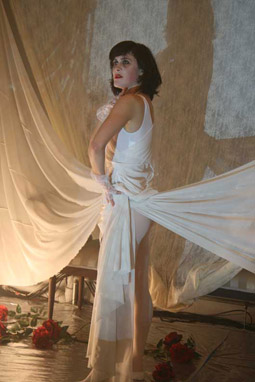
Serial Blogger, 2008 Next Wave Festival
photo Gareth Hart
Serial Blogger, 2008 Next Wave Festival
x:machine: serial blogger
After a dangerous bicycle ride through Thursday night traffic, I arrive at the Meat Market. A palpable menace malingers above the heads of punters as we wait to gain access to Serial Blogger. One consequence of Melbourne’s new exoticism, accentuated by the art world’s adoption of values usually found on Wall St, this same menace infuses X:Machine’s gothic interpretation of one person’s face to face meeting with a serial killer. Straddling a line between performance and installation, there is much in the way of knife blades on sharpening steels, a video interface, men in white coats, and a tortured, spectral female guarding the entrance to this techno cave. But i’m outta that subterranean dungeon once a woman has her tongue cut out. Yet it does occur to me that the visceral extraction of an organ used for articulating speech is also a potent metaphor for cyberspace and its capacity for transforming sounds produced in the larynx into cold collections of algorithmic data. ash keating: 2020?
A day passes, and I find myself at a suburban football match watching a friend’s son kick a ball emblazoned with a McDonald’s logo around a drought stricken park. I then return to the Meat Market for the purpose of assessing 2020?, a multidisciplinary installation comprising discarded building material prior to its being deposited as landfill. Having glanced at the fully mounted work two nights earlier, its epic scale assemblage of plasterboard, milk crates, wooden slats, masonite and other monumental bits and pieces, all sculpted into a hulk of aesthetic junk moodily lit and punctuated by mysterious sounds emanating from within the installation’s ribcage, I am surprised to discover that 2020? has since been dismantled. Up steps Ash Keating, coordinator of the event, and he’s nervous about having to explain the reason behind 2020?’s non-appearance. But Keating need not worry, for I’m into the idea of an installation disappearing, then reappearing over time, and which has genuine collaboration as its impetus. Artists coming together without tearing each other apart; working through the difficulties proposed by the interdisciplinary, and the interpersonal. Without a McDonald’s logo in sight 2020? is reminiscent of Francis Bacon’s South Kensington artistic refuge, and the studio as work of art.
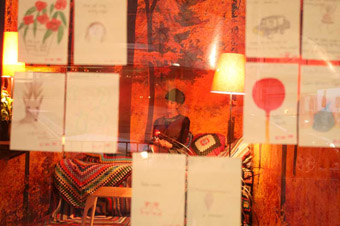
The Telepathy Project, 2008 Next Wave Festival
Photo Gareth Hart
The Telepathy Project, 2008 Next Wave Festival
peoples & kent: the telepathy project
Back on my bicycle I’m the recipient of a vicious high tackle when running head-on into a torrent of traffic oozing up and down Flinders St. A consequence of one AFL match ending at Telstra Dome and another beginning at the MCG, football, like art, has fast become a global juggernaut. Declarations of grassroots participation seem parched and downtrodden, replaced by the distant dementia of a global economy so grandiloquent it defies description. But this fact does not prevent artists from communicating across vast distances, even if this does mean illuminating the difficulties inherent in finding intimacy between two people separated by one wall and a couple of metres. The Telepathy Project is a humble work with much to say because the artists, Sean Peoples and Veronica Kent, perhaps free of funding constraints, have tripped into the abyss and returned with a genuine desire to express this experience. They sit in separate, yet similarly furnished rooms, poised in positions that emit great determination if not religious zeal. It’s a foyer window belonging to the Forum cinema and we, consumptive patrons on the outside, are presented with messages on yellow stickies that have been attached there by the artists.
Nothing exceptional happens, apart from the pondering of passers by wondering what it all means…What soon becomes apparent is that Kent and Peoples are simply trying to communicate. Separated by the devastating distance of two metres, each has resorted to telepathy in an attempt to find genuine intimacy. And whether coordinated or not, Kent and Peoples rose at identical moments and began writing to one another messages of longing and love, that were then pasted on the foyer window for everyone to see. But by this time, most of the audience were bemused by the experience. Now heading toward the MCG and another hollow AFL spectacle, each had opted for the new exoticism that now characterises Melbourne, and the intimate distance proposed by its current global predicament.
Brown Council, Six Minute Soul Mate, artists Frances Barrett, Kate Blackmore, Kelly Doley, Diana Smith, The Carlton Hotel, May 16-23; X:Machine, Serial Blogger, director Olivia Crang, new media director Alex Gibson, performers Mark Tregonning, Fanny Hanusin, Lily Paskas, performer & visual artist Michael Meneghetti, video artist Jarrod Factor, multimedia artist Pierre Proske, sound artist Rob Stewart, lighting Bronwyn Pringle, set design Harriet Oxley, Arts House, Meat Market, May 27-31; 2020?: Ash Keating & collaborators, Arts House, Meat Market, May 21-31; The Telepathy Project: Sean Peoples & Veronica Kent, Forum Theatre, May 20-24; Next Wave Festival, Melbourne, May 15-31, www.nextwave.org.au
RealTime issue #86 Aug-Sept 2008 pg.
© Tony Reck; for permission to reproduce apply to realtime@realtimearts.net
EMERGING ARTISTS CRITIQUE THE PROMISES OF TECHNOLOGY AND CONSUMER DECADENCE IN NEXT WAVE FESTIVAL’S 2008 COLLECTION. FROM THE RAW TO THE SLICK, THREE OF FOUR EVENTS I SAW ARTICULATED DISTRUST OF AN ARTIFICIALLY ENHANCED FUTURE. BUT FIRST, A SLIGHT FORAY INTO GRITTY SOCIAL COMMENT BY YOUNG ADELAIDE DANCERS, SARAH CARTWRIGHT AND GALA MOODY: JUST FILLING IN
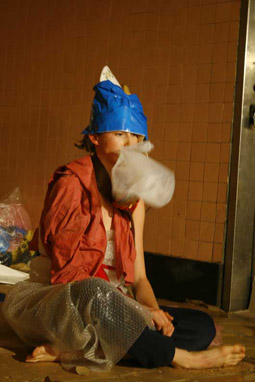
Just Filling In, 2008 Next Wave Festival
photo Gareth Hart
Just Filling In, 2008 Next Wave Festival
sarah cartwright & gala moody: just filling in
Amongst the refuse of civilisation we witness the contrasting responses of a
woman and her double. Sound: a tap drips. Vision: a destructible tower of consumer waste. From a rat-hole beneath the debris emerges…a fanny, clad (in black pantyhose—this is a family show, not!), spread-eagled, looming relentlessly towards us. Its owner, drunk with self-loathing, spares us the indignity of landing in our laps; staggers instead to her feet to act out some trashy porn; stabs her stilettos relentlessly, percussively, into the cardboard surface lining the floor of this subway alcove beneath the streets of Melbourne.
It is not clear who she is—some washed up stripper? Junkie? She gyrates lugubriously as I strain for clues that identify her with a corporate main-stream, as the program notes would have it. A square of cardboard speared on her heel suggests an ear-tagged cow, writhing legs aloft on a slaughterhouse floor. Part two—a mirror image: the good clown, innocence intact, responds soulfully to the garbage bequeathed her. Wombling into view undercover of a dead doona, bounding off artist Laura Wills’ cardboard ‘box’ set, good clown solicits reciprocity from her favourite plaything, a plastic shopping bag. When a range of strategies—fun, power, sex (more wanton gyrations)—fail, she strips off her clothes to swathe herself affectingly in an haute couture of bubble wrap. The work’s structural symmetry posited contrasting responses to the decadence of society without examining complexities. The most telling metaphor—the action reflected on an exposed light-fitting—implied this underworld doubled a surreal existence on some upper floor. The characters did not interact, reading rather as two solos in a common setting. When ‘Slut’ runs dramatically out of the set, we turn to follow her off stage, expecting a second locus of play, perhaps the meaning of the action explained. But back on stage, Clown is slowly swallowing her erstwhile toy, perhaps annihilating hope, murdering innocence? Fade to black.
teching too fast?
Technological capability has evolved faster than our ability to redefine assumptions or ethics. Augmentation pushes the human phenotype beyond its boundaries. Digital worlds “outstrip our ability to give them meaning” (Abenroth, Gui & Scholz, Virtual World Building: Tools, Methods and Philosophy, unpublished thesis, 1999). But, says Douglas Allchin, “technological artefact is not philosophically idle” (“Thinking about ‘Thinking about'”, Techné 5:1 Fall 1999, University of Minnesota) and the artists reviewed below, showing a maturity nurtured in common (perhaps through Next Wave’s Kickstart development program), return courageously to a question even Aristotle spurned when faced with the “cosmological and moral confusion it engendered” (Mitcham, Carl, Thinking Thru Technology The Path Between Engineering and Philosophy, University of Chicago press, 1994).
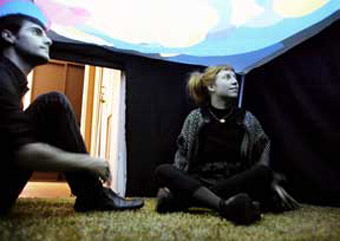
Inside Out, 2008 Next Wave
kenzie mckenzie & james brown: inside outside inside on
Kenzie McKenzie and James Brown’s Inside Outside Inside On pre-empts a world where ‘virtual nature’ is de rigueur. I am in a cubby house, a diminutive garden gazebo. The knee-high entrance has somewhat compelled me to commit, so I lieon the plasticy turf beside a synthetic potted bulb under a digital sky. This multimedia installation talks of “the illusory possibilities of technology to recreate our experience of the natural world.” I immerse in clouds drifting over a horizontal screen barely a metre above me, paralleled by a soundscape that lends a filmic pretence of dimensionality. Every so often, the balmy azure firmament is inundated by animated intrusions of pop art, line drawings or a kaleidoscope grid of flashing lights. These morph and intersect with increasing fragmentation, matched by frenetic sound squiggles, before dropping me back to the gliding, soaring vaults of heaven. Sudden shifts, cut aways to test patterns and colour bars, jolt awake my reflexive consciousness, just in case I thought this was the real thing. Tension builds until the clouds seem gripped by a regressive force grinding them back on themselves, warping sound and image to eerie effect. Cut again. And the tape loop clicks over. In a way, it is not the projection but the edges of its artifice that speaks most potently of the distance between simulacra and simulated.
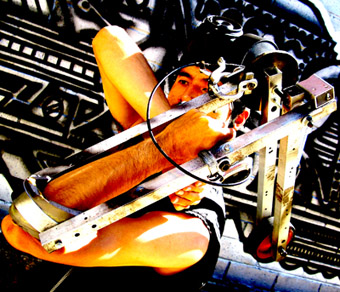
Out of Body Exp, 2008 Next Wave Festival
photo Steve Howarth
Out of Body Exp, 2008 Next Wave Festival
keith lim: out of body exp
In his solo work, Out Of Body Exp, Keith Lim’s character begins sharing his well intentioned plans for self improvement in the interests of “the greater good.” Then, donning elongated mechanical arms, he raises himself up like a newborn calf to explore the scope of this enhanced corporeality. His movements reflect an eastern martial art as functions of destruction and warfare find expression through the prosthetics. Describing a house he would build out of iPods, breakdancing with his video double or invoking the magnetic fingertips of a human current detector—surgical super-enhancements of the organism tripping us into ethical resistances—Lim questions where we draw the line between the illusory dream of perfection and transgression into inhumanity. His delivery is laconic, a storytelling, poetic and quotable. But his movement seems powered from the periphery, not quite fluid, not quite potent, the machinery too unwieldy.
Perhaps this unintended by-product comments tellingly on the medium. As for McKenzie and Brown, the observable limitations of their media only increase the alienation effect, furthering the critique of technology as an adequate substitute. In the end, the perfection Lim reaches transcends the biological human machine as, in the blackness, the once encumbered body now discreetly and perfectly facilitates a dance that is not about itself. Dancing handheld points of light, glowing LEDs manifest like metaphysical fireflies of a soul finally alive with fluidity, integrity and natural momentum.
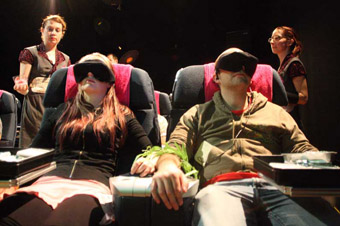
Holiday, 2008 Next Wave Festival
photo Fred Rodrigues
Holiday, 2008 Next Wave Festival
spat+loogie: holiday
Spat+Loogie’s self-assured Holiday turns a similar critique into a slick and entertaining romp that had me grinning broadly throughout. The conceit, in this case seamlessly achieved, cast us as passengers in the foyer an airline departure lounge where, boarding pass in hand, I check though emotional baggage, surrender sharps and explosives (aka tongues and heart). After baring lower legs and clearing nasal passages (the collusion of audience in these ‘security measures’ was elegantly solicited), we were strapped into aircraft seats for an hilarious prologue of safety instructions danced deadpan to Captain Ahab’s Snakes On The Plane soundtrack. Bespectacled in 3D video goggles by our attentive stewards, we embark on a taste-, touch- and smellarama of favourite tourist destinations.
Safe within the specular range of our personal viewing screens we’re lurched from sand-and-sea spray through tropical rainforest to Arctic ice floes. Whether swimming with the denizens of the deep (was that a sea-cow brushing past my legs?), sweltering in the Central Desert or sampling hotel bistro satay poolside in paradise, all sensations were brought to us in low tech vivid sensurround—aromas for our olfactory, textures for our skin and the odd oral morsel. The travel brochure vision was interrupted by apparent breaks in transmission returning us to cabin interior where, from the eye of CCTV, we observe our own passive captivity by absurd and surreal flight staff. From the first taste of our inflight meal to the final inebriated kiss, Holiday made wry art of the mediated illusion of closeness.
Just Filling In, performer-devisors Sarah Cartwright, Gala Moody, dramaturg Netta Raschin, sound designer Alisdair MacIndoe, set design Laura Wills, Platform, May 28-30; Inside Outside Inside On, multimedia installation by Kenzie McKenzie, James Brown, Seventh Gallery, May 20-31; Out Of Body Exp, performer-devisor Keith Lim, sound composition Jon Creenaune, costume Kate Shanahan, set design Joe Au, Black Box, May 16-21; Holiday, performer-creators spat+loogie (Kat Barron, Lara Thoms), performers Naomi Derrick, Teik Kim Pok, sound design Fred Rodrigues, Black Box, May 26-31; Next Wave, Festival Melbourne, May 15-31, www.nextwave.org.au
RealTime issue #86 Aug-Sept 2008 pg.
© Indija Mahjoeddin; for permission to reproduce apply to realtime@realtimearts.net
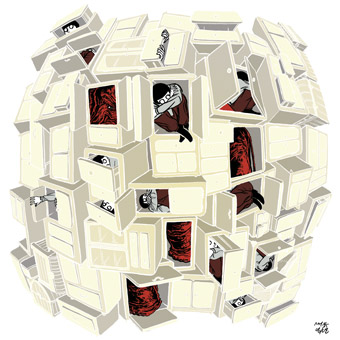
Matt Huynh
We know there’s a skills shortage everywhere else, but in the arts? Statistics on the subject are highly variable (p4, p44), so are the guesstimates of arts educators. Regardless of the facts, what is the tertiary education sector doing about preparing students for the transition into their careers, as well as making sure there are careers to be had? Everything and nothing. Some institutions are developing graduate performance companies, job agencies and extensive alumni networks. All are focused on producing multi-skilled, entrepreneurial graduates. But a few acknowledge a new breed of student, in media arts for example, already networked, part-time employed in their field or running a small business, and ahead of the game. The seven essays we’ve commissioned for this edition make for a fascinating survey of the elephant in the room of arts education—how many jobs are there in the arts and how do you get them? Enterprising young Sydney artist Matt Huynh’s illustration seemed entirely appropriate.
Image by Matt Huynh from Midnight Morning by Will Leong, Matt Huynh & Haline Ly, 2008, www.popperbox.com.
In a limited edition, Midnight Morning is a handsomely crafted book of illustrations which, the three artists say, “celebrates shared experiences of love and devastation.”
RealTime issue #86 Aug-Sept 2008 pg. 1
© RealTime ; for permission to reproduce apply to realtime@realtimearts.net
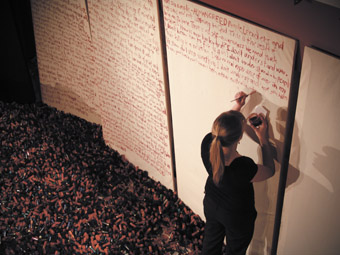
Rebecca Cunningham, 1 litre of Blood, 1000kgs of Bullets
photo Sharka Bosakova
Rebecca Cunningham, 1 litre of Blood, 1000kgs of Bullets
OVER THE LAST DECADE THERE HAVE BEEN A RANGE OF POLICY INITIATIVES TO SUPPORT YOUNG AND EMERGING ARTISTS TO DEVELOP INNOVATIVE PRACTICE, FOR EXAMPLE THE DEDICATED FUNDING CATEGORIES AT THE AUSTRALIA COUNCIL AND MENTORING SCHEMES SUCH AS YOUTH ARTS QUEENSLAND’S SPARK PROGRAM. WHAT APPEARS UNEXAMINED IN THIS FOCUS ON ARTIST EMERGENCE IS THE UNIVERSITY SECTOR, FROM WHICH MANY OF THESE YOUNG ARTISTS BEGIN THEIR CAREERS. SUPPORT PROGRAMS FROM FUNDING BODIES OFFER PATHWAYS INTO PROFESSIONAL PRACTICE, BUT HOW DO YOUNG ARTISTS FIND THEIR WAY TOWARDS THESE PATHWAYS IN THE FIRST PLACE? WHAT ROUTES DO PERFORMANCE GRADUATES TAKE FROM UNIVERSITY STUDY TO PROFESSIONAL PRACTICE, AND WHAT STRATEGIES HAVE UNIVERSITIES ADOPTED TO ASSIST THEIR GRADUATES TO PREPARE FOR AND MANAGE THIS TRANSITION?
the university of wollongong
Professor Sarah Miller, Head of the School of Music and Drama at the University of Wollongong, is understandably cautious about employment prospects in the arts: “The way we think about it is that it is a flexible job market.” Despite this, in her view Wollongong graduates have had a very good retention rate in the arts, though not only as performing artists. Miller concedes that her school needs to better monitor graduate career pathways, but she is also attempting to involve graduates more thoroughly in the ongoing life of the school, using their career trajectories to inspire students about future possibilities. Miller stresses the importance of fostering artist self-reliance among Wollongong students: “Survival as an artist requires tenacity and commitment as well as onstage flair. We hope we’re not training actors to wait for the phone to ring.”
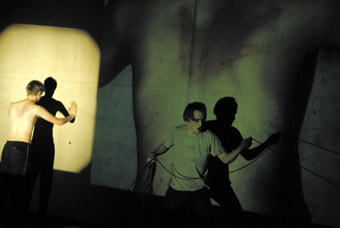
Team Mess, Killing Don
photo Heidrun Löhr
Team Mess, Killing Don
One of the strategies to achieve this is to include within coursework the submission of mock applications to the Theatre Board’s Young and Emerging category and to the Next Wave Festival. Malcolm Whittaker of Team Mess, a performance group of recent Wollongong graduates who recently completed a residency at Performance Space, described this as an invaluable process, involving as it did “writing something that you might very well use the next year.” For Whittaker, this early grounding in the reality of professional life “widened the possibilities of arts practice, and also showed how this might be realised in the professional world.” As the school’s staff includes several former peer assessors from funding bodies, feedback from these trial applications is of immediate value as professional development. Strong linkages with Illawarra Performing Arts Centre, and the professional profiles and connections of teaching staff (including Tim Maddock, Margaret Hamilton, Janys Hayes and Chris Ryan) combine to give students a strong grounding in a wide range of contemporary performance practice. As Miller points out, “We want to make the pathways that are already out there able to be accessed.”
james cook university
At James Cook University Cairns, Russell Milledge is highly conscious of the need to prepare students for the challenges of professional practice. A new degree in Media and Performance, offered for the first time in 2009, promises to be “practice-integrated” and to “harness the strong history of artistic innovation in far north Queensland.” For Milledge, this program intends to produce graduates who “have already been inducted into the contemporary arts arena” through formal partnerships between the university and professional performance companies such as JUTE Theatre, KickArts, End Credits and Bonemap. Additionally, Cairns’ annual hybrid arts festival, On Edge, will link into the degree program, providing both a vehicle for coursework and a pathway for graduate practice.
queensland university of technology
For Zane Trow, Associate Professor of Performance Studies at QUT’s Creative Industries Faculty, “contemporary performance in Australia is a misunderstood and much-attacked beast.” Preparing students to pursue a career in this field clearly has many challenges. “We want to empower them to know their way around at least the initial stages of the maze, to demonstrate to them that it is possible to make this work in the world.” This process involves training students to clearly articulate their own practice and the core concerns animating it, and also to articulate how this practice might fit within the field and policy frameworks. Not simply seeing the artist as a small business, this approach examines how artists have been able to survive and continue producing radical work. Involving case studies and performance projects, the approach Trow describes is as much philosophical as practical, aiming to produce graduates with that rare combination of “project management skills and critical thinking.” In recent years these have included live artist Rebecca Cunningham, Brisbane Festival’s Under the Radar associate producer Fiona MacDonald, and Indigenous installation and performance artist Alicia Jones.
Trow regards as one of the program’s greatest strengths its practice-led postgraduate research, in which “serious mid-career artists” return to the university to produce “both excellent performances and exciting research.” For Trow, the presence of strong practice-led research within QUT further enriches the exposure of undergraduates to possible career pathways.
flinders drama centre
For Anne Thompson, Head of Flinders Drama Centre (and co-director of Melbourne’s Eleventh Hour Theatre), producing artists who can be self-starters is essential. As well as teaching students artistic skills, Flinders aims to prepare students for professional practice by “encouraging all students to work as conceptual as well as interpretive artists and develop skills in creating, producing, and marketing their own work.” As Thompson states, coursework introduces students to “contemporary arts practice and thinking”, making them “well versed in film, video, TV and live performance so they can cross effectively between these.”
Professional connections are brokered with local industry representatives through audition workshops, and also through meeting graduates who have set up their own companies, the most recent guests being Sam Haren and The Border Project (appearing soon in the Sydney Theatre Company’s Wharf2Loud series). Keeping abreast of current opportunities is critical as “the job market morphs in relation to previous graduates’ successes, new people in positions, new funding opportunities and the interests and energies of graduates.”
Thompson stresses the importance of developing dialogue with funding bodies, with students not only introduced to grant writing but also meeting with Arts SA staff and local arts companies. Thompson also notes that Flinders “offers space and facilities to graduates” and “whenever possible we offer space to companies and individual artists to work on site”, creating the possibility for student secondments with artists in residence.
victorian college of the arts
Head of VCA’s School of Drama, University of Melbourne, Richard Murphet makes it clear to his students that “the future for theatre is kind of a lean one” and that they “can’t just sit around waiting for the agent. Gotta get up, gotta get moving and that’s the best way to get visible.” Much of VCA’s coursework focuses on equipping students with professional skills (including occupational health and safety, arts law and basic business skills) that will enable them to make their own work. VCA’s combination of directors, animateurs, actors, writers and technical production means that students can collaborate and “get a feel for people that they can work with.”
Perhaps unsurprisingly, many of Melbourne’s exciting small companies are effectively teams of VCA graduates, including The Hayloft Project, Stuck Pigs Squealing, and Ranters. Students are also introduced to professional networks, including unions, producers, agents and casting directors, making the available pathways “very real for them”, and preparing them for the challenges ahead. Past graduates remain in close contact and are “constantly working in the studio spaces and coming in for advice.” Murphet feels that this ongoing connection is an essential part of VCA’s culture, believing that “it’s very important that we don’t just leave them at the end of three years.”
Despite limited resources for both arts practice and arts education, there is clearly an exciting blend of energy and pragmatism within university performance programs. The pathways that graduates take from university to professional arts practice are diverse, but it is heartening that university programs regard these issues of artist emergence as pivotal and are actively preparing their students to manage this transition. Heartening also is the recognition of the need to maintain contact with graduates, both to offer mentoring possibilities and to inspire current students with an expanded sense of available opportunities. The flourishing of young, innovative performance groups across Australia over recent years is a sure indication of the success of these initiatives.
RealTime issue #86 Aug-Sept 2008 pg. 2-3
© David Williams; for permission to reproduce apply to realtime@realtimearts.net
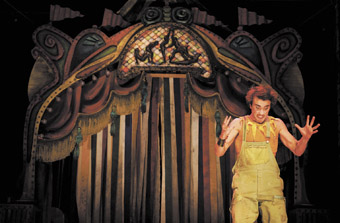
Josh McConville, The Servant of Two Masters
photo Lisa-Maree Williams, courtesy of NIDA
Josh McConville, The Servant of Two Masters
AN AMAZING 40% DECLINE IN THE NUMBER OF PEOPLE CALLING THEMSELVES ‘ACTORS’ BETWEEN THE AUSTRALIAN BUREAU OF STATISTICS’ 2001 AND 2006 CENSUSES RAISES A FEW QUESTIONS. GIVEN THAT ACTING WOULD HAVE HAD TO BE THEIR ‘MAIN JOB’ IN THE WEEK BEFORE CENSUS NIGHT, IS THIS JUST A CASE OF THE 90% WHO WERE ACTUALLY WAITING ON TABLES OR DRIVING A TAXI THAT WEEK NOT HAVING THE CHUTZPAH TO INSIST THEY WERE STILL ‘ACTORS’? OR HAS THE DRASTIC DECLINE IN FILM AND TV WORK OF THE LAST FEW YEARS ACTUALLY DRIVEN THEM RIGHT OUT OF THE PROFESSION? OR COULD IT EVEN BE THAT THE RELENTLESS ATTACKS BY GOVERNMENTS OF ALL ILKS ON THE ‘ELITISM’ OF ARTISTS HAS FORCED ALL BUT THE COURAGEOUS 1,213 WHO CALLED THEMSELVES ACTORS TO RE-IDENTIFY ELSEWHERE AS ‘CULTURAL INDUSTRY WORKERS’ OR ‘VISUAL MERCHANDISERS’—WHATEVER THEY ARE? (BOTH OF THE LATTER CATEGORIES INCREASED, BY THE WAY.)
Another figure has to be considered, though. People still want to be artists. The recent Anticipating Change report for the Australia Council’s Major Performing Arts (MPA) companies counted no fewer than 61,178 students studying to be artists of all sorts in 2005. Clearly many of them don’t make it if the census figure the following year of only around 200,000 people in the whole country identifying as artists or their ‘support workers’ is accurate.
And with actors the most depressed group of all, one has to ask whether those optimistic students are being adequately prepared for a life that’s not actually all about acting. A recent interview in The Australian with the new CEO of NIDA, Lynne Williams, saw her admitting that the almost 50-year-old institution needed to track down partners in creative industries to make their courses broader in the future. Williams also acknowledged changing ‘performance contexts’ within theatre itself.
Now NIDA has always marketed itself as ‘the star factory’—the place that produced Mel and Judy and Our Cate. If they broaden their studies, will they become more like the 21-year-old Actors Centre (ACA) in Sydney which specialises in preparing its students for proactivity in the broadest sense, and less like the 16 year old Actors College of Theatre and Television (ACTT) which boldly says, “We take on people who want to be actors, and don’t offer courses in management and marketing”?
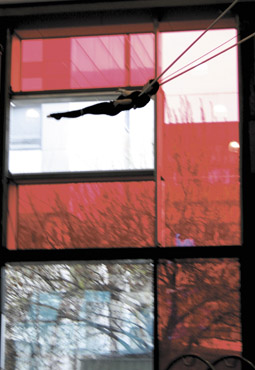
Catherine Clarke at NICA
photo by Matt Woodruffe, courtesy of NICA
Catherine Clarke at NICA
So, where does that place Melbourne’s eight-year-old National Institute of Circus Arts (NICA)? For one might argue that it has even more skills to impart than an acting school, yet still has a Business Studies teacher, still offers studies in corporate and community work, and allows its students to gain teaching experience on the job.
Could this be one reason why NICA was by far the most optimistic of the institutions about the employment of its graduates? Or is it just, as the institute’s director Pamela Creed touted, “The spectacle just won’t go away—we’re looking at world-wide growth. Right at the moment it’s in Macao’s casinos, but it’ll go from there into China”—a pretty confident statement about the nation with the greatest physical theatre on Earth!
NICA has the advantage of a recent survey of its five years of graduates, done at the behest of Swinburne University, of which NICA is a subsidiary. Forty-eight of 100 responded—a statistically significant figure, though it may just reflect the happiest of surveyees, for 95.3% of them have worked in their chosen profession since graduating and 86% were working at the time of the survey. This is partly proof of Creed’s ‘spectacle’ factor—with demand from the Commonwealth Games and FINA in Melbourne, the Asian Games in Doha (employing 40 graduates) and Cirque du Soleil in Las Vegas etc. But it’s also, says Creed, a reflection of the absolute need of a circus artist to maintain their physical skills, “They have to work.”
Graduates also have to leave NICA with an ABN, insurance, a business plan and a company structure all worked out. And they’ll already have had experience teaching up to 300 external students who come in for evening classes, and met up with participants in the Training of Trainers course for community circus teachers working across the country. Last year graduands presented Divino in the Melbourne International Arts Festival involving commedia, dance and a capella singing; this year they’re turrning their hands to a digitally based work about the narcissism of circus artists on MySpace as a final production.
Graduating students at Sydney’s ACTT may well also go out buoyed by the professional optimism that founding director Lesley Watson believes is associated with now having their own theatre to perform in. She’s taken over Performance Space (now called the Cleveland Street Theatre) to both up the profile of her organisation and to give even more opportunities for “skill sharing between fresh young artists and experienced ones” invited in to mentor, develop projects and direct plays. NIDA directing students also come in to work with ACTT student actors, developing useful links for the future. And, in that future, Watson is hoping to start an ACTT graduate company to present plays professionally at Cleveland Street.
“Acting is less a job than a life commitment”, Watson believes. “But students do need a career aesthetic—knowing where they want to work so that they can take charge and not be at the whims of the job market , whether it’s writing, producing pub theatre, offering role-playing services or corporate training.”
Both Watson and Dean Carey, founding Artistic Director of the Actors Centre, see positive signs of a recovery in both TV drama and the local film industry. “The death of Big Brother gives Channel 10 $30m a year to spend on drama”, estimated a joyous Carey. “And that was reflected in the fact that agents didn’t just come politely to our recent graduating class shows—they were actually taking people on!”
Just in case this doesn’t all happen, ACA graduates have met up with casting directors, Equity reps, voice-over specialists, worked on their audition skills and at the Australian Film, Television & Radio School (AFTRS), taken away a CV on disk, a showreel and a folio of 8×10 shots, and are “ready to open their own business”, says Carey. He’s planning to add a weekend program on self-management for graduates and build up his new alumni page on ACA’s website.
But of course, it’s to NIDA that a company like the STC turns when they need eager young bodies for its production of Nigel Jamieson’s Gallipoli. All 23 third years are involved and design and technical students regularly get attached to professional companies during their courses. “But there are so many different sorts of theatre”, says Head of Acting, Tony Knight. “We can’t aim everyone at the STC, especially as it’s shrunk compared to film and TV. Aboriginal work in the Pilbara may be the dream—certainly no one wants to be ‘The new Cate Blanchett’!—community service is drummed into them at school these days.”
NIDA graduates might also utilise the institution’s good links with other schools in the US, Europe and India. “We can introduce them to Bollywood”, says Knight; “and Singapore’s just invested $500m in its film industry. It’s gone way beyond the David Williamson world today.”
Which is not only true, but worrying those Major Performing Arts companies reliant on access to the cream of the Aussie crop. In fact, the 2006 Securing the Future report quite specifically noted that the MPA companies’ financial stringency had squeezed out their role in skills development for artists. The 2007 increase in their base grants was the government’s response. So the Anticipating Change report’s discovery of “a mismatch between the growing number of cultural workers and the skill sets required by MPA organisations” suggests that the gap between sound tertiary training—especially in theatre—and the professional life should be filled by them.
Music already does it, says Tony Grybowski, the Australia Council for the Arts’ MPA companies Executive Officer—with the Australian Youth Orchestra (which he used to run), Australian National Academy of Music (ANAM), the Sydney Symphonia, Australian Chamber Orchestra etc. “In theatre, somebody needs to be thinking about that gap, which is one reason why we commissioned the Anticipating Change report, to help MPA boards look 10-15 years ahead. It’s unreasonable to expect the highest refined skills immediately out of training. And that’s particularly true in the case of support areas like directing, design and tech-ing—there’s such a shortage of them, graduates are snapped up straight away. But actors really do need more than self-funded theatre to develop.”
RealTime issue #86 Aug-Sept 2008 pg. 4
© Jeremy Eccles; for permission to reproduce apply to realtime@realtimearts.net
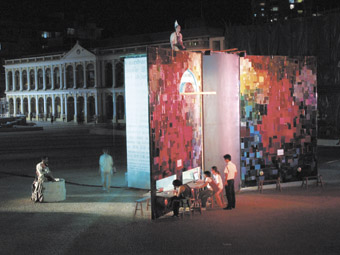
Book by Durational Night, Macau, 2007
photo Rebecca Rutter
Book by Durational Night, Macau, 2007
THE FUTURE OF THE BOOK HAS BEEN IN DOUBT FOR A COUPLE OF DECADES, BUT EVEN ITS CHALLENGERS, THE WORDY WORLD WIDE WEB AND THE EMERGENT E-BOOK ARE ‘BOOK-ISH’, DEPENDING ON YOUR COMFORT OR NOT WITH SCREEN-BASED MEDIA. MELBOURNE’S WELL, ESTABLISHED IN 1999, CELEBRATED THE BOOK BY CREATING A GIANT TOME THAT CAN BE OPENED, ENTERED AND READ IN VARIOUS WAYS, WRITTEN AND DRAWN IN AND PERFORMED ON. GREAT WALL OF BOOKS IS A PORTABLE PUBLIC SCULPTURE, RESPONSIVE TO ANY LOCATION AND CARRYING WITH IT, MATERIALLY AND VIRTUALLY, THE TRACES OF ITS INTERACTION WITH ITS MANY VISITORS, FROM MACAU TO MELBOURNE TO BANGKOK AND BEYOND.
The new wave of outdoor art around the world has been influenced by installation art and new media practices, incorporating electronic media as well as performance. It’s also highly adaptive, ready to move on to new sites, or it’s altogether temporary, as in Ephemeral Art at the Invisible Lodge in Tasmania’s Freycinet Peninsula in 2007 (RT84, p46). For Well, their book “carries with it its previous incarnation and location [becoming] a book of that time and place…[The audience] trace goes with us, bound into a book.” Well’s director, Dario Vacirca, enjoys playing with metaphor, lending the 10-year project an almost metaphysical dimension with its cross-artform, cross-media, cross-cultural evangelism.
For all of its innovations, Great Wall of Books is in the fine tradition of Australian outdoor performance (Five Angry Men, Strange Fruit, Snuff Puppets, Bambuco, Erth, PVI etc). Vacirca spent some formative years with Five Angry Men who, as part of their performances, built the very sculptures they would perform on and about. Great Wall is already constructed, “literally a gigantic book, five metres tall and opening out to over 11 metres wide”, ready for delivery by container, ship, truck and crane, but its book-lined insides are transformed depending on wherever it finds itself and the people whose ideas, dreams and stories it records.
Well describes the work as “a vessel that both generates and stores written, aural and visual stories.?People are invited to create and record their own stories across a range of interactive spaces within the structure. These creations are bound and catalogued, becoming a part of the ever-evolving library that is the central body of the book.”
the birth of the book
Touring with Melbourne’s Five Angry Men for three years, Vacirca recalls seeing “amazing works, profound installations—mostly outdoors.” But what intrigued him was “the possibility of making these works, with their visual arts momentum, performative and participatory.” He describes the vision that came to him as “a heavy and heady metaphor for the universe”, one which merged the physical and the virtual in the notion of a book.
Where precisely did this vision come from? “A dream in 2001, a moment of reality”, says Vacirca. In the dream he saw “books on the way to becoming landfill fly out of their skip and onto a wall.” Another trigger was a Borges story about a warrior king who builds a great wall and for every brick orders a book burnt—his aim being to erase history and start again, with his own. Vacirca thought he’d invert this process by making a great wall of books. Jason Cross [RT84, p14] commissioned the work for the 2005 Big West Festival in Footscray. To get The Great Wall up, says Vacirca, took a lot of lobbying and the vision for the work was “not believed in by funding bodies.” This, however, changed once the first version of the wall had been created.
The outside wall of the work originally comprised covers taken from thousands of abandoned books collected from 2002 on. Weather conditions later required a new “clean exterior surface with a pattern [suggestive of] many thousands of years ago. We went through many stages of designing this, experimenting with arabesque, various brickwork designs, outsider art—layered and recessed, built up surfaces—and settled on a vibration of colour that calls to mind the works of Klee and Rothko. The design needed to work from a great distance as well as in detail. It was finished off with litres of marine grade polyresin so it can withstand most weather.”
The inside of the book was seen as being like a library which would decay if not constantly fed with ideas. The re-worked design entailed sliding doors and three screens (two monitors and a projector). The book now unfolds into a two-tiered theatre and big projection space. The cover is constant but the interior is subject to constant change.
Great Wall’s audience is invited to participate by writing, drawing or verbally recording their stories, dreams or responses to the work itself, or to questions posed by it, like “What is the true story of your death?” The audience work is created on the ground and inside the book and, once indexed (using the chronological Bliss classification system which suits the evolutionary nature of the work), hoisted by abseiling Caretakers of the Book to take its place on a giant page. Vacirca says that audiences “willingly give their contributions away, but they have to specify if they want them archived, transformed or destroyed.” The transformations are into “sound compositions, visual projections, and/or inspirations for performance.”
Stage two of the book was realised in 2007 after a year’s gap in presentations and in which contact was established with the government of China’s Macau at the Asian Arts Market in Singapore. In Macau, says Vacirca, there was “a quite beautiful collaboration with local artists—mostly restricted by the authorities to traditional artform groups.” It involved a tea ceremony, music and calligraphy. The work was political in some respects, says Vacirca: the typewriters provided for audience use symbolised bureaucracy, as did “red tape on all the nearby glass windows”, while the performers’ shark costumes reflected “the ecological impact on shark populations in the harvesting of fins for the beloved soup.”
The company brought Rita Portugal Lima, one of the Macau contemporary visual artists, back to Melbourne for a 2008 Federation Square season: “She built a mixed media exhibition with film, video and sculpture. Addressing the Chinese meaning of Macau—gateway or door—Rita created works that were doors within the ‘doorways’ or boxes of the gallery, looking at “a country as an opening” that can at the same time be “a nation as a closing.”
next
Great Wall of Books travels next to Thailand, spending six weeks in Bangkok and Chiang Mai, supported by the education foundation of a telecommunications company. Planning is under way for visiting other Asian countries: “After that, Europe 2010, the Americas 2011-12 and, in 2012, possibly burn the book or find a permanent space for it.”
For Vacirca and his collaborators, Great Wall of Books is more than a labour of love. The director even describes dealing with crane operators, truck drivers and shipping merchants as “hilarious…like being kids.” For Well’s audiences and guest artists Great Wall of Books is at once a theatre (the company’s own visual theatre performances and guest works), a cinema, a gallery (featuring various exhibits and a collaborative mural in Macau), “a quiet space to escape the cacophony of the outside world” and reflect on life and art or to “be part of sharing community”, however ephemerally or enduringly. As Well puts it:
Works created for and within the book are transformed, explored and reinterpreted in future presentations. Consequently all those involved remain a part of the biggest story ever told—this is a metaphor for the universe after all.
The Great Wall of Books was in residence in Macau, China from June-September 2007 and during January 2008 at Federation Square, Melbourne. Well are Dario Vacirca, Alex Ben-Mayor, Matthew Gingold, Rebecca Rutter, El Pablo, Renato Vacirca, Bill Buckley and Bo Svronos. http://welltheatre.com
RealTime issue #86 Aug-Sept 2008 pg. 6
© Keith Gallasch; for permission to reproduce apply to realtime@realtimearts.net
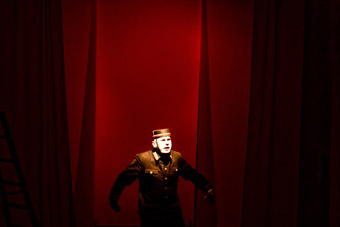
John-Paul Hussey, Love Monkey
photo Mark Burban
John-Paul Hussey, Love Monkey
I WAS RECENTLY WONDERING ABOUT THE COMPATIBILITY OF BUSINESS MODELS AND ARTISTIC GROUPS AND GOT TO PONDERING THOSE IRRITATING SLOGANS CORPORATE LEADERS USE TO SPACKLE OVER THE GAPS IN THEIR RHETORIC. YOU KNOW THE ONES. THEY BEAR THE SAME RELATIONSHIP WITH INSIGHTFUL DISCOURSE THAT SURVIVOR HAS WITH ANTHROPOLOGY AND ARE ABOUT AS NUMBING. “THERE’S NO I IN TEAM.” “A CHAIN IS ONLY AS STRONG AS ITS WEAKEST LINK.” IN THESE CASES, I GOT TO THINKING, THERE’S NOT MUCH FIT WITH THE ARTS AT ALL. I’VE SEEN PLENTY OF RUBBISHY WORKS SAVED BY A SINGLE PERFORMER. LOTS OF COMPANIES THRIVE DESPITE THE PRESENCE OF SOME OBVIOUSLY UNDERQUALIFIED MEMBERS. ALL OF THIS MENTAL MEANDERING EVENTUALLY GOT ME DEBATING THE PROS AND CONS OF GOING IT ALONE VERSUS THOSE OF ASSEMBLING A TEAM OF LIKE-MINDED PERFORMANCE-MAKERS.
phoebe robinson
I realise I’d had Phoebe Robinson’s quiet, effective Only Leone in mind in the days preceding these thoughts. Robinson’s been developing solo work for a few years now, and the short Only Leone is the culmination of her three-month residency at Dancehouse. It’s a rumination on solitude at several levels, most not immediately obvious. There’s the Roy Orbison allusion in the title, as well as the understated influence of the sparse, laconic wanderers of Sergio Leone’s spaghetti westerns. But beyond these, I’m more used to seeing Robinson dance in partnership with her sister Julia, or alongside other dancers with (the now departed) Dance Works. For me, much of Only Leone’s loneliness came in the form of the ghosts not visible around the dancing form. We often discuss live performance—especially dance—in terms of presence, the positive materiality of the body. But when choreography can equally signify absence, the effect is uncanny.
It’s not immediately obvious whether Robinson is consciously playing with the problematics of dancing alone. Her choreography seems to imply it, though. She doesn’t try to fill the expansive white space in which she moves—far from it. Her movements are unnervingly precise but understated and for the most part occur within tightly conscribed areas, rather than traversing the stage. The sole exception occurs when she unexpectedly darts towards her audience to stop a breath away, now sharing the darkened space of her onlookers. It’s an ironic attempt at connection, though, and it seems clear that any kind of fourth-wall busting would be an artificial substitute for the more authentic connections which develop during creative relationships.
john-paul hussey
In the absence of co-conspirators, of course, a performer often turns to their relationship with an audience to fill the void. John-Paul Hussey’s Monkey Trilogy comes to a close with his latest, Love Monkey, which makes explicit a theme of connectedness and fragmentation which has underscored his previous solo outings. As usual, it’s a fascinating and often infuriatingly dense skein of ideas, drawing lines between Hussey’s own autobiography, classic myths and Jungian archetypes, works of great and popular fiction (from Moby Dick to James Cameron’s Titanic, for instance) and much else besides. It’s largely about love, charting various relationships across the performer’s history, but it’s equally about his relationships with his artistic forebears, his world and his craft itself. And though it would be easy to conclude such a narrative with an attempt to bridge the divide between performer and viewer, Hussey bravely maintains a constant distance from the onlooker by imbuing his story with so much strangeness that we can’t help but be frequently confounded. Even as he makes a thematic plea for human connection, he waves his eccentricities and idiosyncracies in our faces, as if to remind us that the price of true individuality is isolation.
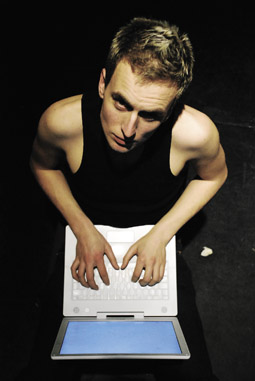
Ash Flanders, I Love You, Bro
photo Sarah Walker
Ash Flanders, I Love You, Bro
three to a room
Here’s a curious counter-example: Three to a Room’s upcoming Edinburgh tour of Adam JA Cass’ I Love You, Bro. It’s a genuinely stunning monologue in itself, earning acclaim for playwright Cass and performer Ash Flanders when staged in last year’s Melbourne Fringe Festival. It traces the true story of a 14-year-old English boy whose obsessive search for human interaction through online chatrooms led to his stabbing in a dank alley, a police investigation unveiling a vast web of lies and intricate role-play, and a court conviction for inciting his own murder. There is an “I” in alienation, apparently.
A thrilling story aside, what makes this tour so interesting is in the way that Three to a Room—a company of three young theatremakers—have taken this small production, along with Sisters Grimm’s equally fringe cult schlock-fest Mommie and the Minister, and pushed them all the way to the Edinburgh Fringe. It’s not that they’re adapting these works. They’re doing something oddly rare in the independent theatre scene—producing. Having already toured their own productions to Edinburgh—the lauded An Air Balloon Across Antarctica—the company this time round has found a pair of pre-existing pieces which deserve further life, and has taken on the job of making the connections between these satellite performances and the solid terrain of Scotland. The business of the independent producer—the forging ties between free-floating creatives and established institutions—has been one of the more exciting areas of development and discussion in recent years, and the work of small companies such as Three to a Room add an extra layer of activity to the trend.
rogue
After all this talk of the loneliness and isolation of the creative, it’s only fair to turn to its opposite. Anyone with any experience in the performing world will know the feeling of intense intimacy engendered by a close collaboration with a group of fellow artists—the wrap-party “we’ll always remember each other!” expressed as everyone swaps numbers, even as a part of you hopes X never calls and Y quickly fills that spare role in production Z. It’s amplified exponentially in the case of major performing arts courses. After three years of excoriating emotional nakedness in which intra-class relationships are formed, broken, reformed and so on, the power dynamics and status levels come to seem a cemented microcosm of the world itself. And then comes that world. And everything becomes open to question as the class star struggles for roles and the quiet kid at the back is fending off job offers.
The ranks of Rogue are filled out with ex-VCA dance students (and other graduates from around Australia), and if the company’s Next Wave double bill was anything to go by, they’re an impressively cohesive bunch. The Counting saw this literalised—Antony Hamilton’s choreography presented an hypnotic mass of overlapping motion which blurred the lines between the organic and the mechanical. Individuality disintegrated quickly, the work favouring instead a sense of complementary movement—technically sophisticated and visually complex, patterns echoing across different bodies and discrete spaces. That these young dancers managed to flawlessly execute such an intricate, almost sublime work is testament to the company’s status as an important new force in Melbourne’s dance scene.
Ocular Proof was created by company members themselves and, while not as subtle as Hamilton’s work, is equally encouraging. Its sequence of a dozen-odd vignettes ranging from the comical—18th century courtiers flirting and backstabbing across a glowing dining table—to the unsettling—bodies acting as screens for the projected image of two rapidly aging and decaying figures. The design technology provided by Olaf Meyer and members of Bluebottle3 is nothing short of dazzling here, and at times comes to overshadow the dancers’ performances. But this is no complaint. One of Rogue’s strengths seems precisely this willingness to sacrifice egos and grandstanding in order to take advantage of the experience and ability of others—choreographers, designers or each other.
John-Paul Hussey’s Chocolate Monkey shows at Sydney’s Seymour Centre, Oct 14-25; I Love You, Bro at Pleasance Dome, Edinburgh, Scotland, August 2-25
Only Leone, choreographer, performer Phoebe Robinson, sound design Sheldon King, Felicity Mangan, lighting Adam Hardy, Ben Cobham; Dancehouse, July 2-6; Love Monkey, writer, performer John-Paul Hussey, director Lucien Savron, composer Kelly Ryall, set, video Matthew Gingold, lighting Shane Grant; Northcote Town Hall, May 28-June 15; Three to a Room, I Love You, Bro, writer Adam JA Cass, director Yvonne Virsik, performer Ash Flanders; Monash University Student Theatre, June 30-July 3; Rogue, The Counting, choreography Antony Hamilton, performers Derrick Amanatidis, Danielle Canavan, Holly Durant, Merryn Heath, Laura Levitus, Kathryn Newnham, Harriet Ritchie, Marisa Wilson, Suhaili Micheline, Ahmad Kamil, lighting Alexandre Malta, costume Doyle Barrow, music Panasonic; Ocular Proof, choreographer-performers Rogue, multimedia design Olaf Meyer, lighting Alexandre Malta, costume Doyle Barrow, music Lachlan Carrick, Meat Market, Melbourne, May 28-31; 2008 Next Wave, May 15-31
RealTime issue #86 Aug-Sept 2008 pg. 8
© John Bailey; for permission to reproduce apply to realtime@realtimearts.net
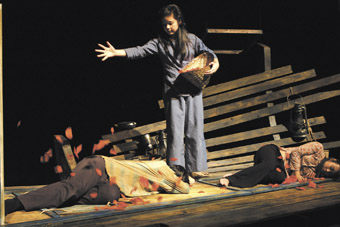
Hieu Phan, Sheena Pham and Kathy Nguyen
photo Phong Le
Hieu Phan, Sheena Pham and Kathy Nguyen
A SMALL SLICE OF VIETNAM HAS MIRACULOUSLY APPEARED IN THE MIDDLE OF PARRAMATTA OR MORE ACCURATELY AT PARRAMATTA RIVERSIDE. WE ARE STANDING OUTSIDE, WAITING FOR OUR TICKETS TO MOTHER FISH, WHILE WATCHING A FISHERMAN CAST HIS NET, A BOAT BOB IN THE WATER, CLOTHES HUNG ON WOODEN POLES, AND A CYCLIST RINSING HIS BICYCLE. WHEN WE COLLECT OUR TICKETS AND PROGRAMS WE ARE ALSO ISSUED WITH A SHEET OF RED PAPER AND SOME INSTRUCTIONS FOR FOLDING IT INTO A BOAT, WHICH PROVES SURPRISINGLY COMPLICATED. ONCE YOU HAVE COMPLETED YOUR BOAT, YOU ARE SUPPOSED TO PLACE IT ON THE RIVER BUT MOST PEOPLE HANG BACK, PREFERRING TO LOOK AT THE PANORAMA BELOW. THE SPELL IS FINALLY BROKEN WHEN THE BOAT IN THE RIVER PADDLES OFF AND THE CYCLIST COMES RACING UP THE FOOTPATH, SHOUTING, “COME ON GUYS, WE HAVE TO GET INSIDE!” SINCE IT’S A FULL HOUSE THIS TAKES A WHILE, BUT THE MOVEMENT FROM THE WIDE OUTDOORS TO THE CRAMPED INDOOR SPACE OF THE THEATRE IS SUGGESTIVE OF THE JOURNEY TO COME.
On stage there is a rusty replica of a fishing boat, the wooden boards serving as both deck and hull, depending on which way the actors emerge from the trapdoor in the floor. It is here that the four characters—two sisters, Hanh and Kim, their uncle, and a young fisherman Chau—will spend the duration of the show. Younger sister Hanh is less than impressed at having to travel with her irascible uncle, who, for his part, is none too pleased about having two teenaged girls in tow. In anticipation of the move to America (no one is aiming for Australia), Uncle has converted to Christianity but he is ecumenical enough to instruct the girls, “You pray to Buddha, I pray to Jesus, that way everyone will look out for us.” In another exchange, Chau confides that he used to have a girlfriend, causing Kim to exclaim, “Don’t tell me something happened to her?!” “Yeah, it did”, he deadpans, “She got engaged.” It is moments such as these that make the opening scenes surprisingly funny and the humour works to establish an easy rapport not only between the characters but also between characters and spectators.
Inevitably though the humour fades and as the story goes on, it starts to wear. We long for some progress or failing that, some diversion, relief or catharsis. But perhaps this is precisely the point: boat journeys are long, arduous, relentless and boring. Indeed, the narrative structure is typical of what theatre theorist Freddie Rokem has called “narratives of terror” [“Narratives of Armed Conflict and Terrorism in the Theatre,” Theatre Journal, Vol 54, No 54, 2002]. He argues that while conventional narratives obey an ‘if…then’ principle (if this happens, then that will follow), narratives of terror obey the principle of “then…then.” In other words, when narrating terror there can be no easy exposition, complication and resolution; only an endless series of ‘thens.’ Thus the fragile Mother Fish and her crew are subjected to a succession of unspeakable ‘thens.’ First pirates attack them, stealing from one sister and raping another. Then the boat reaches the coast of Thailand, where they are refused entry and returned to sea. Then Chau grows increasingly desperate and confused, diving off in pursuit of another passing boat. Then Hanh gets increasingly ill, eventually dying. Then, then, then: each event is unbearable in itself but in combination the events are almost too much.
There have been many plays by and about refugees in recent years but Mother Fish stands out for several reasons, not least because it deals with earlier instances of forced migration. It is also rare because it has two young girls at the centre of the story, one of whom does not survive (another rare feature in a genre that for obvious reasons tends to emphasise endurance). Finally, the play is also unusual because it focuses solely on the journey rather than making the journey a mere turning point; there isn’t a great deal of detail about life beforehand in Vietnam and there is absolutely no detail about life afterwards in Australia. In fact, the play finishes with the two surviving characters stepping onto the shore.
Landing on the shores of Parramatta Riverside, Mother Fish comes at an interesting point in Australian politics and Australian theatre. With the election of the Rudd government, some of the harshest migration laws have been repealed (TPVs have been abolished, the ‘Pacific Solution’ abandoned and the Ministerial right to review is itself under review). Similarly, the wave of theatre that developed in response to this punitive refugee policy, much of which has been reviewed in RealTime, is also receding. What Mother Fish does is to remind us that while the excesses of the Howard years may have passed (remembering always that it was a Labor government that introduced mandatory detention), the dangers of forced migration do not go away. Refugees take enormous risks when they set sail in vessels that aren’t much sturdier than paper boats and when they arrive they often have little more than their stories. For this reason, stories sometimes become the only currency refugees have, especially when dealing with immigration officials but also when dealing with well-meaning but ignorant locals. These tales, then, are precious cargo, for they have purchased freedom. Mother Fish delivers them with great humour, courage and care.
Powerhouse Youth Theatre, Mother Fish, writer, director Khoa Do, assistant director Jason McGoldrick, performers Kathy Nguyen, Sheena Pham, Hieu Phan, Vico Thai, design Kate Shanahan, composer Alan John, dramaturg Claudia Chidiac, lighting Chris Clough; Riverside Parramatta, May 24-25, www.motherfish.com.au
RealTime issue #86 Aug-Sept 2008 pg. 10
© Caroline Wake; for permission to reproduce apply to realtime@realtimearts.net
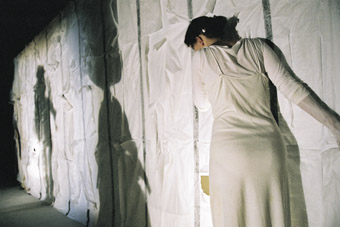
Alexa Taylor, In the Shadow of the Wild
photo Lisa Johnston
Alexa Taylor, In the Shadow of the Wild
THE BLUE ROOM HAS BEEN A CENTRE FOR INTERESTING NEW WORK THIS YEAR. RECENT GRADUATES FROM EDITH COWAN UNIVERSITY’S PERFORMANCE COURSE PUT ON AN AMUSING, HIGHLY THEATRICALISED MEDITATION ON THE ORESTEIA, WHILE MURDOCH GRADUATE ALEXA TAYLOR REMOUNTED HER HIGHLY POETIC HONOURS YEAR INSTALLATION IN THE SHADOW OF THE WILD. BUT IT WAS THE BRITISH PLAYWRIGHT SIMON STEPHENS’ MOTORTOWN, DIRECTED BY MARISA GARREFFA, THAT REALLY SET OFF THE SEASON.
The five women who created this production of The Oresteia depict those incarnations of unreasoning vengeance, the Furies, as three performers trapped in a motel room strewn with newspaper and accoutrements such as a telephone, couch and venetian blinds—each of which featured repeatedly in the dramaturgy. Brutally simple puppets scrunched together from paper were a particular treat. The cross-dressing narrative was a retelling of the events which led to the Furies’ imprisonment, namely the matricidal affairs and murders which led prince Orestes to kill his faithless mother and her new lover so as to avenge his own father, before the Furies in turn pursued him to vengefully tear him apart. Apollo eventually intervenes and it is decided, as one of the founding acts of the Athenian republic, that such bloodlust is inconsistent with Apollonian civilisation, leading to the Furies’ banishment.
Great fun though this tongue-in-cheek retelling is, there is no reason why the Furies should be in a motel room (as opposed to a bathroom, swimming pool, cave or theatre). Nevertheless, one cannot resist any piece performed by actors given to chanting mellifluously “blood, blood” and bursting into song as readily as into game-play, and who can produce the rubber-lipped sound of a phone ringing with such aplomb.
Alex Taylor’s In the Shadow of the Wild is a performatively gentler, serious work, relying on an affective yet simple relationship between text (some of which is reproduced on the white drapes which line the shared space of performer and audience), design (a pool bounded by piled sand and framed by arched poles behind which Taylor eventually crouches) and presence. Taylor’s text is affectively coherent more than conceptually framed, and while exploring issues of wildness—including notions of terrorist, child and ‘wild’ indigene—Taylor’s associative logic owes more to stream-of-consciousness than cultural critique. She acknowledges that seeing Aborigines as ‘wild’ says more any non-Aboriginal culture than about indigenous reality, but she does not pursue this. She is more concerned with generating a relationship with her audience that, like her soft white set, evokes a sense of dreamlike intimacy over and above imparting specific content. One carries away from this piece the sense of a cotton-woollish embrace, and while one might quibble that Taylor’s political references demand a more forceful interrogation, such a strategy would make impossible the quiet, measured speech and address to the audience which underpins her aesthetic.
Writer Simon Stephens and director Marisa Garreffa by contrast stimulate reflection through a hyper-intense, yet nevertheless acoustically poetic, dramaturgical flagellation of the audience. Motortown follows the actions of returning UK Iraq War veteran Danny (Richie Flanagan)—a loser before he left and now even more damaged. Danny stays with his socially inept, near autistic brother Lee—a tremendously hunched, frightened, loving and apologetic Glenn Hall, who later morphs into the cynical, suave and dangerous pimp who regales Danny with tales of social decadence.
After abortively attempting to reunite with a woman who Danny believed was his girlfriend, but who now denies this and recognises that Danny has become deeply scary, Danny kills the pimp, abducts the latter’s underage lover/prostitute Jade (a suitably naïve, flirtatious and unspeakably terrified Amanda Woodhams) to lecture her in a wasteland before despatching her too. The piece ends with a pair of codas in which Danny meets a sophisticated, swinging bisexual couple who attempt to pick him up before he mouths off at Britain’s professional class and their sexual peccadillos, later to retreat back to Lee’s flat where Lee declares that while once people were concerned about what he might do to them or their children, it is really Danny whom they should fear. Throughout, Garreffa and her cast keep the dialogue crisp even where the characters are stuttering in terror or abjection, and the volume within the small space seems sharp, loud and reverberant.
The production functions as a series of shocks or blows delivered at quite what one is not certain, except that society in general is implicated. Stephens locates the war, its chain of command and post-traumatic stress firmly within the causation of the malaise he depicts, while also insisting that there are other factors which cannot be ignored. Having endured the godawful National Theatre of Scotland production of Black Watch in which one of the characters, without any sense of condemnation, either in terms of direction or audience response, blithely exclaimed, “What the fuck have the Iraqis got to do with it?”, Motortown comes as a necessary corrective, dragging not only the scarred soldiers but the whole of modern western civilisation back into the mire of the conflict. For Stephens and Garreffa, the whole horrible mess is inextricably interlinked and tragic—not in terms of classical heroic resistance, but in the way in which patterns of self-loathing and non-redemptive violence repeat themselves today; a wakeup call for this post-Howard, post-Blair political climate.
Duck House Theatre, The Oresteia, director, producer Gita Bezard, director, production manager, Kathryn Osborne, performer-devisers Alissa Claessens, Sarah McKellar, Fran Middleton. April 22-May 10; Renegade Productions, In The Shadow Of The Wild, deviser-performer Alexa Taylor, music, lighting Joe Lui, May 28 – June 14; Motortown, writer Simon Stephens, director Marisa Garreffa, assistant director, producer Renato Fabretti, performers Richie Flanagan, Glenn Paul, Amanda Woodhams, Melanie Munt, Ben Russell, Anita Erceg, James Helm, lighting Karen Cook, music Steve Hearne, costumes Skye Hegarty, June 17–July 5; Blue Room, Perth
RealTime issue #86 Aug-Sept 2008 pg. 10
© Jonathan Marshall; for permission to reproduce apply to realtime@realtimearts.net
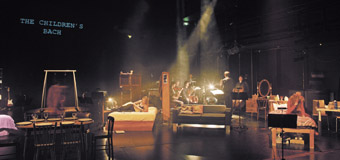
The Children’s Bach
photo Jeff Busby
The Children’s Bach
LIKE ANY ADAPTATION, THE ANDREW SCHULTZ-GLEN PERRY OPERA FOR MELBOURNE’S CHAMBERMADE OF THE CHILDREN’S BACH IS AND IS NOT THE HELEN GARNER NOVEL OF 1984 ON WHICH IT IS BASED. THE REAL TIME OF EXPERIENCING A NOVEL IS THE READER’S OWN, AS SLOW OR FAST AS THEY WISH. THE REAL TIME OF THE STAGE IS RELATIVELY FIXED AND BRIEF, AS IT IS FOR EVEN THIS SLENDER NOVEL. BUT WHAT A NOVEL AND, AT FIRST GLANCE, WHAT AN UNLIKELY CANDIDATE TO BE ‘OPERATED’ ON. AND WHAT AN ENGAGING NEW OPERA, SUCCESSFUL IN PART BUT, LIKE MUCH CONTEMPORARY OPERA, NOT WITHOUT THE STYLISTIC PROBLEMS OF A FORM IN TRANSITION.
If you’ve read a novel which has inspired an opera, you’ll be be sensitive to the inevitable sacrificing of elements of plot and character. You’ll wonder if the characters on stage will match those you conjured in your reading. And then there’s anxiety about the larger mutation of interpretation, as librettist, composer, director, performers and designers make the original their own. Its language is likely to be particularly vulnerable: edited, of necessity, re-shaped, re-written, often deprived of the voice of its implicit narrator (whose role in opera is likely to become the orchestra’s) and transposed from the inner reader to the singer. If you love the book, you live in fear that the experience of it will be tainted, as happens with many a film adaptation. Sometimes the match between original and adaptation is such that the opera casts the book in a new light; more often, opera and book are like parallel universes, closely related, but very different experiences which we refuse to confuse.
Helen Garner’s idiosyncratic novel is hardly what you’d call plot-driven—it’s a quiet reverie of multiple minds observing the world and themselves in the everyday. The third person narrational point of view shifts briskly if gently from mind to mind within single frames (a meeting, a dinner, a trip). Although these glimpses can sometimes be quite brief, the novel has a great sense of residing in the moment and resisting the pull of plot: Garner gets the moment/momentum dynamic just right, evoking the interiority of a small suburban network of family and friends, some small dramas and a larger one when 40 year old Athena briefly leaves her family (partner Dexter and their two children, Arthur and the autistic Billy) for her friend Elizabeth’s musician lover Philip (single parent of Poppy, in her early teens).
Librettist Perry retains one son, Billy, and places him, first and last, centrestage, staring out into the audience. Within the opera Billy punctuates the action with his moments of intense preoccupation, frustration and anger, including tinkering with or hammering an old upright piano. He’s a victim of Athena’s apparently callous indifference when she frees the rabbit to which we know he has some kind of attachment. In the novel he is beyond such a connection. But in the opera we are being well prepared for Athena’s abandonment of her family. In the novel, Garner pays pretty much equal attention to Athena and Elizabeth, but because Elizabeth’s life can’t be resolved into story, in the opera she increasingly becomes an observer. The balance tips towards Athena and the opera towards the conventionally theatrical. However, composer, librettist and director attempt, in their own terms, to balance the push and pull of moment and momentum and retain a strong sense of the novel’s reflectiveness.
If Billy provides a simple frame for the opera (a child’s very innocent and largely detached view of things) and provides moments that are not plot-connected, likewise young Poppy, sitting up in bed, literally gives us a children’s Bach as, from time to time, she reads aloud passages (projected with the surtitles) that explain the musical structure of the fugue and the nature of counterpoint. She doesn’t do this in the novel, but in the opera Perry deftly uses it to provide her with focus, a desire to learn, a preoccupation, as she drifts away from the amiable intimacy with her father; and offers the audience an unfussy theoretical counterpoint to the unfolding story.
In its use of aria, of duet, trio, quartet and, of course, repetition, opera is a form capable of achieving a powerfully immersive sense of moment, although much of 20th century opera resisted this inheritance, turning sometimes to a kind of conversational naturalism—not always musically memorable on first hearing (while the orchestral score often can be). Schultz’s solos and duets share some of this awkwardness, of the trained opera voice delivering everyday dialogue, the inevitable aristocracy of tone at odds with the vocabulary and syntax of the lower middle class characters of the novel. The effect can be to make the dialogue sound silly, or redundant—why all that projection and modulation to say, “Shall we go inside?” (Dudley Moore once brutally parodied Benjamin Britten, actually a lesser offender, for producing this heightened banality.) Of course, if you’re an opera afficionado, familiar with the conventions, you’ll be forgiving of such disjunctions. However, in The Children’s Bach, we very occasionally hear the spoken voice, and the gap is prised further open.
Schultz’s songs however often catch the ear, almost at times like a musical (Sondheim having to some degree bridged the opera-musical gap), as when Philip sings to Poppy about his beloved Paradise Bar, or Dexter about ‘lerv.’ While the score is not accessible in the manner of Glass or Adams or, more conventionally, Golijov, nor is it the jagged modernism of an earlier Schultz opera, Black River (1989, film 1993). The composer’s score is lyrical and pervasively melancholic, save a joyous, dancing, unsung passage and the opera’s baroqu-ish duet coda. Not surprisingly it’s the Bach-ian texturing and pulsing of the score that gives the work warmth and drive. Each of Poppy’s readings from her ‘Children’s Bach’ seem to trigger the requisite realisation of the theory from the orchestra, driving the opera on but also adding to the sense of moment, a certain thoughtfulness, a musical reflectiveness. Schultz’s score sings, muses and dances and is superbly realised by the onstage conductor (Nicholas Carter alternating with music director Brett Kelly) and fine instrumentalists on piano, cello, clarinet, double bass, marimba, vibraphone and violin.
Chris Kohn’s direction, Dale Ferguson’s design and Richard Vabre’s lighting do much to conjure the spirit of Garner’s novel. The set occupies the whole of the open Merlyn stage: at first glance a mass of furniture without walls which is soon delineated by lighting and character movement. It’s a simple but effective, fluid space suggestive of Garner’s multiple points of view and allowing for easy transitions and edits and evoking a shared world of overlapping lives. Amidst all of this, just upstage only slightly to one side are the conductor and musicians—part of this world.
As well, Kohn has elicted from each of the performers an affecting natural presence (in contrast to the thrilling hyper theatricality of his own company, Stuck Pigs Squealing) and an ease of movement within and to and from the various domestic spaces. Composer, librettist and director have also integrated the upright piano further into the scenario, Athena struggling with her Bach, Billy toying with the instrument and Philip picking out a tune—the orchestra sometimes seamlessy picking up on these.
Schultz and Perry have deftly ‘plotted’ their version of The Children’s Bach, but maintained some of the requisite sense of moment, musically and, with additions of their own, structurally, and this has been adroitly furthered by director and designers. Musically, the orchestral score has an engaging contemporary lyricism—without resorting to minimalism or pastiche—but vocally the opera feels like it belongs well back in the 20th century. Nonetheless, despite the various mismatches there’s much to enjoy and a certain poignancy felt at the ending as a reconciled Elizabeth and sister Vicki duet the novel’s closing narration (an odd shift in the framing, but endearingly composed and sung) and Billy looks out at us in silence…as if, in an odd way, we’ve shared this suburban world with him.
ChamberMade, The Children’s Bach, adapted from the novel by Helen Garner, composer Andrew Schultz, librettist Glenn Perry, director Chris Kohn, performers Kathryn Gray, Dimity Sepherd, Andrea Carcassi, James Eggleston, Tess Duddy, Hannah Kostros/Alexa Madden (Poppy), James Christensen/Jackson Cairnduff (Billy), music director Brett Kelly, conductor Brett Kelly/Nicholas Carter, musicians James Cowell, Mitch Berick, Susannah Ng, Mark Kruger, Nicholas Synott, Eugene Ughetti, designer Dale Ferguson, lighting Richard Vabre, sound design Russell Goldsmith; The Merlyn, Malthouse, Melbourne, June 20-July 5
RealTime issue #86 Aug-Sept 2008 pg. 14
© Keith Gallasch; for permission to reproduce apply to realtime@realtimearts.net
COMPOSER, SOUND DESIGNER AND DIRECTOR MAX LYANDVERT AND POET AND LYRICIST DAN SPIELMAN HAVE COMBINED TO PRODUCE MANNA FOR THE SYDNEY THEATRE COMPANY'S ADVENTUROUS WHARF2LOUD PROGRAM. THEY DESCRIBE THE WORK AS “A SONG CYCLE AND EARPLAY.” APTLY THERE IS SOMETHING OF THE PADDED CELL AND THE SOUND CHAMBER IN MANNA, THE STAGE WALLS LINED WITH UPRIGHT MATTRESS-LIKE PADDING AS FIVE PERFORMERS ADDRESS US DIRECTLY IN RECITATIONS AND SONGS OF SEPARATION AND LOSS.
This is a dream-like world of floating signifiers gesturing at a barely tangible signified—the expression of grief bordering on despair. Appropriately the performers play out a collective state of being rather than characters. At one moment they appear like a family, stiffly gathered for a group portrait around a kamanche (Persian bowed lute) player, at others individuals intone laments distantly evocative of the horrors of World War II, the Holocaust, Bosnia and Kossovo, but, save for a passing mention of Chechnya, none is specified. Love and family have been forever lost by unnamed people to unnamed wars in unnamed places.
This attempt at universality, or even a metaphysical dimension (inherent in the work's title), is a brave but risky one requiring an extra alert listening from the audience and not a little guess work as Spielman's poetic text offers images (“a night of great fires”, “she tried to burn the body before they came”) that are often suggestive of but never quite add up to straightforward tellings. That's not a bad thing in itself, but the overall lack of specificity makes it difficult to anchor the world of Manna as it moves on image to image. It's as if the work is unearthed, a constellation of potent charges waiting for the moment of promise, a lightning strike that will never come.
Certainly Manna's weighty themes are performed with emotional intensity, Boris Brkic and Gertrud Ingeborg bringing to them a particularly affecting, quiet gravity. The visual imagery has its moments of strength, and weakness—including a large mirror wheeled briskly across the stage without attention to effect or meaning. Some images resonate effectively with each other, a mock operation and a later pieta play on our sense of the sheer vulnerability of the body and our growing separation from the dead. Others, like a man stripped to the waist with some device attached to his chest, appear potent—in the manner of the creations of Romeo Castellucci—but remain obscure.
Not surprisingly in a work described as an “earplay”, sonic imagery plays a key role. From the middle of the front row, facing his performers, Max Lyandvert mixes and modulates a score that ranges from engaging, supple ambiences that heighten the sense of dream and underlying anxiety to huge waves of nightmarish sound (evocative of war and other catastrophes, but again not literally) that regularly punctuate the action and drive all else to stillness. But sound is also part of the physical performance, realised on violin, piano, a piano string frame and classical Persian lute, hammered dulcimer and drum by the performers. The music in Manna is cross-cultural, the voices bear different accents. Then there are assorted uses of the gravel tray once commonly found in radio studios, here, for example, used by one performer to create the trudging of another, quite still, lamenting. The mock operation is like a children's game—vegetables and fruit squished, crunched and grated before us. Again, the real evaporates into shadow forms, into art and play—our means of facing, and evading, the real.
Early in Manna, Spielman's poems bewail the loss of loved ones but equally recognise our deep entwining as couples (“your voice inside my voice”), and thus how the lost ones stay with us. But later, in lines about touch, he expresses the very tentativeness of connection (“perhaps I touch you with my voice”), existential anxiety seeming to grow as the performance moves on to its final image of 'putting someone to rest.'
For Max Lyandvert, in his program note, the biblical manna is a metaphor for the hardships the Israelites endured coming out of Egypt (“they HAD to have their journey”), its nourishment symbolising their spiritual readiness for receiving God's ten commandments. Likewise, if without a conventional theatrical trajectory, the figures in Manna collectively go on their journey, struggling with suffering. Lyandvert posits that “through grieving and the existential consciousness of loss…Man arrives at the act of burial, to honour the dead.” And so does Manna.
Manna is an odd concoction, part contemporary performance, if too actorly and visually uneven, part recitation (some of the poems might have fared better on the page), and part sound event—a sometimes fascinating interplay of voices, acoustic and miked, musical instruments (most potently, Jamal Rekabi vocally and on the Iranian kamanche, santore and daef), live sound effects and digital soundscapes that constantly mutate our shared aural environment. Moments when these discrete elements bounce off each other like charged atoms or merge into striking images suggest the potential for Manna to be at once ethereal and earthed. But there's work to do to bring it down to us from the heavens.
Wharf 2Loud, Manna, lyrics, text Dan Spielman, director, composer, sound designer Max Lyandvert, performers Boris Brkic, Gertraud Ingeborg, Dana Miltins, Jamal Rekabi, Jayne Tuttle, visual artists Kate Davis, Marisa Purvell, lighting Emma Valente, Wharf 2, Sydney Theatre Company, Sydney, from July 1
RealTime issue #86 Aug-Sept 2008 pg. web
© Keith Gallasch; for permission to reproduce apply to realtime@realtimearts.net
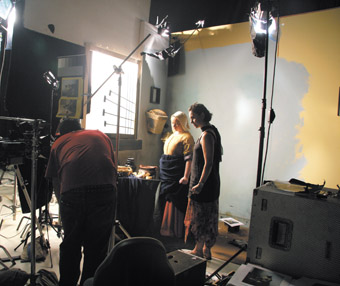
Perfecting the Picture
courtesy the Australian Film, Television & Radio School
Perfecting the Picture
THE AUSTRALIAN FILM INDUSTRY HAS ENTERED A NEW PHASE, WITH A NEW CENTRAL FUNDING AGENCY AND A NEW FINANCIAL SUPPORT MECHANISM OFFERING A SIGNIFICANTLY INCREASED LEVEL OF FUNDING. SCREEN AUSTRALIA, THE SINGLE ENTITY FORMED BY THE MERGER OF THE FILM FINANCE CORPORATION, THE AUSTRALIAN FILM COMMISSION AND FILM AUSTRALIA, FORMALLY CAME INTO BEING ON 1 JULY (ALTHOUGH EXISTING PROGRAMS OF THE COMPONENT AGENCIES WILL CONTINUE UNTIL THE END OF THE YEAR); IT HAS A NEW BOARD BUT THE INDUSTRY IS WAITING FOR THE ANNOUNCEMENT OF THE PERMANENT CEO. EMPLOYMENT PROSPECTS ARE LOOKING POSITIVE, ESPECIALLY WITH NEW TECHNOLOGIES OPENING UP JOB OPPORTUNITIES IN INTERESTING SCREEN-RELATED AREAS. SO IT’S NOT SURPRISING THAT THERE IS A SENSE OF CAUTIOUS OPTIMISM ABOUT THE JOB PROSPECTS FOR GRADUATES.
multi-platforming & multi-skilling
Associate Professor Gillian Leahy from the University of Technology Sydney (UTS) considers that film and related production areas are expanding, and that even the depressed television drama production area “certainly looks as if it might climb back.” This offers opportunities for UTS graduates, especially as they have learnt management skills in the process of seeing a project through to completion, giving them the practical expertise needed by prospective employers. The Royal Melbourne Institute of Technology’s (RMIT) Programs Director (Journalism and Media) Leo Berkeley sees employment increasingly opening up in related growth areas, such as the games industry and 3D compositing. “Our graduates are finding work in all sorts of unusual occupations, especially those where their multi-skilling is useful. They can communicate and operate well online”, he says.
John Buckmaster from the Sydney Film School (SFS) agrees that convergence of new media has led to an increase in the types of employment available. “Our graduates work either full-time, contract or casual. Full-time work is generally with production houses, television and post-production, while contract and casual is for TVCs, film productions and corporates”, he explains.
In WA, the Film and TV Institute in Fremantle (FTI) provides high quality industry based training with intensive, hands-on courses delivered by professionals, featuring guest speakers to provide practical and up-to-date knowledge. “All of our programs have a strong emphasis on the essential skills required for a successful career in the rapidly changing media sector, including team work”, explains Training Registrar Fern Nicholson, “and the job market has been looking good for the last seven to eight months. In fact, there seems to be an influx of new productions.”
transforming courses
Many educational institutions are restructuring both their undergraduate and postgraduate courses, including new and specialised subjects in response to industry demand. While RMIT has probably led the way in modernising its degrees, both the Australian Film Television & Radio School (AFTRS) and UTS are also making quite dramatic changes to both the way courses are structured and to the components of those courses. At RMIT, the changes have been quite extensive: “We’re essentially integrating theory and practice in a distinctive way”, explains Leo Berkeley, “getting students to explore the way boundaries have blurred, to investigate what it means to be a professional in this new environment. It’s not multimedia; we teach film, television and radio, but challenge students to think about those areas in a networked environment. And we’ve changed our way of teaching to student-centred learning, teaching them how to learn. We don’t focus on content, which changes, but on identifying their own strengths and weaknesses.”
simultaneity: education & experience
AFTRS recently moved to its new, specially designed and built premises within the Fox Studios complex, and will be offering a number of different ways in which students can enter the school. As Graham Thorburn, AFTRS Director, Screen Content, explains, “We now see education existing in parallel with experience, that is, work experience or self-made experience. We no longer think that our students need to acquire what had become a long list of skills, and we’d rather give them a choice of what to acquire; information on what is possible and the way to achieve it. We’re moving the responsibility from school to student to define what they need to know to become what they want to be, and we’ll offer a range of options for them to use to get there.” These changes have come in part from external pressure from the industry; pressure, as Graham Thorburn says, “that goes to the question: how do you make more inventive, low budget films that connect with the audience?”
promoting the student
Most institutions hold screenings of student films, which work both as marketing exercises and celebrations, shared with many from the industry. Sydney Film School has a staff member dedicated to distributing films through film festivals, student work has been sold to television stations and airlines, and one student documentary is being distributed nationally on DVD. At RMIT staff work hard to get students’ work online, and AFTRS has a unique claim: they’ve had three finalists in five years in the Best Short Film categories at the Oscars.
monitoring careers
The monitoring of the career trajectories of graduates is something that only AFTRS has done in a systematic and ongoing way; every three years it conducts an extraordinarily detailed survey of where its graduates are in their professional life. Most institutions keep in touch with graduates in an informal way, getting feedback on their success, or the lack of it. At RMIT, Leo Berkeley says, “the new structure has given us a very networked student group—they develop strong relationships both with each other and with staff. And they stay in touch after they graduate. There’s no formal mechanism, but it has given us a much better sense of where graduates are.”
The Sydney Film School monitors graduates through meetings and regular email contact; as International Relations Manager John Buckmaster explains, SFS is a small school, with a focus on its sense of community, mentoring and working together. International students number between 30 and 40% of each year’s student intake. Buckmaster keeps in contact with graduates internationally by visiting them in their countries, visits that coincide with the educational fairs and recruitment that bring in such students. He’s recently seen graduates in London and Istanbul, and in Shanghai he visited the two graduates who now run a post-production house with a staff of 20, up from the one-room operation they started two years ago.
Both Gill Leahy and Leo Berkeley believe thorough career surveys right across the sector would be really useful, and are something that the Australian Screen Production Education and Research Association, the peak discipline body for screen production institutions, could carry out. ASPERA, which represents the vast majority of universities that teach and research in the field of film, television and video production, is ideally placed to collect and analyse information about graduates and their careers.
ASPERA held its annual meeting of delegates from member institutions during July. With a key theme the relationship between the tertiary sector and the screen industry, the conference addressed issues such as industry expectations of prospective employees (proficiency in a range of technical skills, ability to work well as part of a team, without close supervision, and to respond to the demands of audiences); whether too many people are graduating from media courses expecting to gain employment in the screen industries; the contribution universities can make in providing critical thinking on the local industry; and the importance of gathering occupational data and identifying gaps in training for positions such as games designers, location managers and production accountants.
developing self-sufficiency
How do institutions help emerging filmmakers develop self-sufficiency, learn how to survive in the new screen environment? The new producing strand at AFTRS will consist of a series of weekend workshops and online assignments, covering models of production, financing, production development, creative teams, and understanding scripts. As Graham Thorburn explains, “We believe a better path is for producers to already be working somewhere in the industry and doing the course part-time; that way, it’s meeting the needs of a better quality of applicants.”
FTI runs short courses in production management, distribution, marketing, and even pitching ideas. “This allows past and current students to continually learn about this ever-changing and ever-growing industry”, comments Fern Nicholson. RMIT third-year students do research projects, where they interview people in the industry with a particular emphasis on how they have survived. And while Gillian Leahy believes UTS has probably not addressed filmmaker self-sufficiency as well as it could until now (although it has included a subject called producing which covers how the industry works, how to set up in business, and how to operate in the current environment), this will be emphasised more in the new degree. “We do encourage graduates to keep in touch, to tell their success stories, give warnings about difficulties they’ve encountered. It’s important to offer a range of experience.”
work experience
SFS offers an occupational training visa for international students; one student from India has worked in production on two Bollywood feature films made in Australia. In WA, FTI finds that production companies in Perth, and even interstate, are in constant contact regarding attachments and crew work on various projects. “These companies want to give students the opportunity to work on large on-set projects, where both paid and unpaid work is always required. There are quite a few large features coming up at the end of this year and we will no doubt be pushing for our students to get involved. It’s not just a great learning tool, it’s important for them to get out there and work in the industry”, Fern Nicholson argues. At RMIT, students are encouraged to find and organise work attachments for themselves, as important survival skills, while their course includes a range of projects with external elements. A number of students work with Melbourne’s community TV, Channel 31. “It has a very good community ethos”, explains Leo Berkeley, “and they get to make and broadcast their own material. It’s a fantastic educational experience that we have encouraged and hope to increase.”
industry contacts
Continuing industry contact is considered important. FTI is always in touch with film organisations, including documentary companies with projects in the pipeline, RMIT has Film Victoria represented on its film advisory committee, and has close relationships with industry organisations such as the Australian Directors Guild (ADG) and the Australian Writers Guild (AWG), while at Sydney Film School teachers, either part-time or as guest lecturers, are working practitioners. SFS graduates recently worked on Matthew Newton’s debut feature Three Blind Mice (selected for the Toronto Film Festival and in the Sydney Film Festival’s International Competition, p19); one graduate, Caitlin Stanton, was co-producer.
timing & readiness
Leo Berkeley comments that RMIT students are increasingly continuing with postgraduate work. “It’s often the more reflective ones”, he says. “It’s becoming a pathway for some students.” Meanwhile, at AFTRS, Graham Thorburn says that “our advice to students is not to immediately try and get their dream project made, but to enhance and develop their skills, in TV if need be, to build up a body of work, and to work on their own project until they feel it’s ready to deliver.”
Career opportunities in the film industry, particularly in the newer screen-related areas, are growing, as is confidence in the rejuvenated Australian film scene. However, much depends on the success of the new structure and financial support mechanisms, whether this can provide not only for the production of more and better Australian work, but for that work to connect with Australian audiences. To this end, education and training in the area should not only keep up with technological change, but also equip students with the mental and technical skills to contribute to the production of such work. As Gillian Leahy says: “What we do best is give students time and a chance to think, to look, to listen and to experiment in ways which challenge the norms of movie-making, of technologies, of ways of working.”
RealTime issue #86 Aug-Sept 2008 pg. 17
© Tina Kaufman; for permission to reproduce apply to realtime@realtimearts.net

Daniel
photo Nick Berry-Smith
Daniel
IN LATE JUNE THE CLASS OF RAW NERVE 2008 CAREFULLY TRIMMED AWAY THE LAST SHREDS OF SUPERFLUOUS CELLULOID AND HANDED THEIR DELICATE CREATIONS OVER FOR PUBLIC EXHIBITION. IT WAS A BIG NIGHT TO SAY THE LEAST, AND THE IMPATIENT, FRAUGHT, ASHEN FACES OF THOSE INVOLVED SHOWED IT. ONLY A FEW MONTHS EARLIER THEY’D RECEIVED THE APPROVAL OF THE MEDIA RESOURCE CENTRE’S RAW NERVE FUNDING PANEL AND VENTURED HEADLONG INTO THE WORLD OF PROFESSIONAL FILMMAKING, ARMED WITH MONEY, INDUSTRY TRAINING AND ACCESS TO PROFESSIONAL EQUIPMENT. BUT NOW IT WAS TIME FOR THE WORLD TO SEE THEIR DREAMS IN RELIEF.
The blue-ribbon award went to Bowen Ellames’ Daniel (15mins). This lyrical, melancholic film freely ventures into emotional terrain rarely entered by Australian short filmmakers. A story of childhood and parental neglect, Daniel centres its episodic and painfully sad suburban narrative around the quiet disappearance of a fragile and tormented little boy. Daniel (Tom Russell) watches and listens from afar as his parents tear their family apart with mistrust and misdirected anger. At school he experiences the very same kind of violence when it erupts from the abused hearts of the playground bullies. Looking to the devotion of his mother (Ellen Steele) for respite from his suffering, Daniel finds only the confusion of a young woman. And with no longer any real concept of home and safety, he drifts away into the world and disappears.
Ellames communicates Daniel’s tragedy with a gentle, poetic cinematic style. The soundtrack remains quiet for the most part, punctuated by the odd birdcall or soft whistling breeze, while the camera holds patiently on the action, discreetly exploring the scenography of kitchens, clotheslines and schoolyards. The atmospheric intimacy generated by these stylistic strategies allows for subtle fluctuations of light and character expression to build as the film develops, conveying an arresting emotional resonance. It’s rare to see such fluidity, restraint and sense of personally experienced emotion in the work of young filmmakers, especially from two as new to the game as Ellames and co-writer and director of photography Simone Mazengarb. They, along with the entire production team of Daniel, are to be congratulated for their accomplishment. I can only hope that the success of this debut will encourage them to embark on even deeper poetic excursions.
Killjoy (9mins), a veritable gumbo of a black comedy written and directed by Michael Zeitz, belongs to an entirely alternate universe. Its minimal plot, if that’s what it can be called, centres around a road trip undertaken by a hellish blonde (Anna Chaney) and her desperately victimised husband (David Rock) and their run-in with a lunatic highway patrolman (Nathan O’Keefe). But this serves merely as a backdrop for a cavalcade of frank visual gags involving female breasts, urine, cows and, somewhat curiously, male psychosis. It’s a genuinely funny ride at times, well performed and visually impressive too. But Killjoy suffers for its overzealous stuffing. There are too many jokes bouncing around in this film, too many different kinds of gag, creating an imbalance, an inconsistency of comedic tone.
Then there was Matt Hawkins’ more polite cupcake comedy, Casual Living (11mins). Steeped in the sugar-coated aesthetic of the 1950s, Casual Living follows the adventures of a Doris Day/Fairy Godmother hybrid as she totters her way around a 21st century display home, wooing potential buyers with baked sweets. Like Killjoy, this film looks fabulous thanks to its camera work and colourful visual design and is carried well by its principal actors, Emily Branford and John Welles. But what’s the point of it all? As far as I could ascertain Hawkins’ concern is that the standardisation of aesthetic values in contemporary suburban life has left us cold to the unique creative pleasures offered by pink icing. Is that all?
Wedged between these two flippant yet thoroughly dissimilar comedies was Nick Bollard’s more serious debut short, Family Matters (14mins). A film about risk, it centres around two brothers, one a successful if currently broke pop star, the other an obedient son placed in charge of the family business. When desperation strikes, the rebellious spirit teaches the younger sibling an important lesson of living: sink or swim, but for God’s sake don’t just hide in the boat. Another technically accomplished film, I suspect there’s a personal resonance in Family Matters for the writer-director Bollard.
Filmmaking, like any art, is risky, a potentially absurd enterprise that exposes the creative soul to failure and ridicule. But it is also a chance to grow and overcome fears that might enslave us. All of the filmmakers involved in this year’s Raw Nerve Awards are to be congratulated for their commitment to the gamble.
MRC Raw Nerve Awards 2008: Daniel, director Bowen Ellames, producer Sylvia Warmer, writers Bowen Ellames, Simone Mazengarb, camera Simone Mazengarb, sound Carly Turner, editor Carly Turner; Killjoy, director, writer Michael Zeitz, producer Jane Baird, camera B Halstead, sound Colin Zammit, editor Mathew Debitt; Casual Living, director, writer Matt Hawkins, producer Bettina Hamilton, camera Judd Overton, sound Colin Zammit, editor Shaun Lahiff; Family Business, director, writer Nick Bollard, producers Travis Kalendra, Felice Burns, camera Craig Jackson, sound Tracks Audio, editor Manuel Marquez; Media Resource Centre, Raw Nerve, Mercury Cinema, Adelaide, June 22, mrc.org.au
RealTime issue #86 Aug-Sept 2008 pg. 18
© Tom Redwood; for permission to reproduce apply to realtime@realtimearts.net
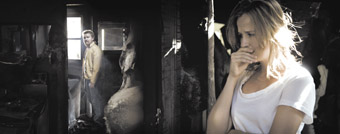
Anthony Hayes, Claire van der Boom, The Square
THIS YEAR, SYDNEY FILM FESTIVAL DIRECTOR CLARE STEWART SEEMS TO HAVE FINALLY GOT THE BALANCE RIGHT BETWEEN POPULAR HITS, OBSCURE GEMS AND FILMS THAT CROSS THE DIVIDE. THE NEW OFFICIAL COMPETITION, PLUS Q&AS WITH VISITING DIRECTORS AND PRODUCERS, GAVE ADDED ENERGY, AND FILMS IN THIS CATEGORY WERE GENERALLY WONDERFUL WITH STAND-OUTS BEING THE EVENTUAL SYDNEY PRIZE-WINNER, UK DIRECTOR STEVE MCQUEEN’S HUNGER, NEW ZEALANDER VINCENT WARD’S SAD AND LYRICAL RELIVING OF AN EARLIER DOCUMENTARY, RAIN OF THE CHILDREN, AND MY PICK, WHAT CANADIAN DIRECTOR GUY MADDIN CALLS HIS DOCO-FANTASIA, MY WINNIPEG, ABOUT THE SLUMBERING SNOWY TOWN WHERE HE GREW UP AND CONTINUES TO MAKE FILMS DESPITE IT BEING A “CITY OF SLEEPWALKERS.”
The two Australian films in competition were both world premieres and debut features for young filmmakers with long and chequered histories in the industry, Nash and Joel Edgerton with The Square, and Matthew Newton with Three Blind Mice. While both films were edgy and showed exciting potential, I’d question their inclusion in a competition with its stated focus on “courageous and audacious filmmaking” exploring “new directions in film”, since stylistically and content-wise both continued the recent Australian feature film focus on the gritty realist drama of men in isolation/crises in urban landscapes—also explored in Anthony Hayes’ Ten Empty—and lacked the experiment with form and technique that set other competition films apart.
The festival had its usual crossfire and debate. During the roll of credits after Michael Haneke’s revisited feature Funny Games (transplanted to the US with Naomi Watts and Tim Roth but, otherwise, shot-for-shot identical), I enjoyed a cross-cultural screaming match: “No-one should have to watch that. That was a SICK film. How could they show that.” “You didn’t even see it, you left half-way through.” “I came back in at the end.” “It’s not as if you weren’t warned. It was exactly the same as the last one he did.” I wonder later whether the aggrieved might have been the same person who complained about Bill Henson’s artwork. But the fracas highlights the power of cinema to still make people angry.
Having found Haneke’s film excruciatingly tense first time around, seeing it rehashed 10 years on left me completely cold. As an exercise it becomes sketchy with no dramatic tension (a friend suggests that it might have been scarier in German) but it does have an amoral bully protagonist, Paul (Michael Pitt), who implicates the viewer, often turning to camera to goad us or to lift us out of our complacency when we condone some violent bits (but not others) and cheer the heroine on. At one point the audience erupts into applause when Watts hoists a gun and shoots Peter (Brady Corbet) and Peter’s response, anticipating ours, is to grab the remote control and rewind, robbing us of any feelgood narrative. This film works in nice counterpoint to Three Blind Mice and The Square that also explore men’s violence and bullying tactics, suppressed and overt, in isolated cultures where any honest communication appears a sign of weakness: a navy boat far out to sea; a construction site in the bush.
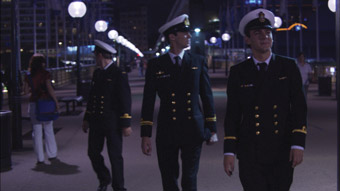
Three Blind Mice
three blind mice
Matthew Newton was racing against time to screen Three Blind Mice at the festival. As he revealed at the Q&A, he had to “abandon the film” rather than “finish it” and described the experience of watching it with an audience for the first time at the State Theatre as more nerve wracking than any acting he’s had to do. He is also onscreen as Harry, one of three central characters—sailors on leave before their ship takes off next morning—a manic smart-arse who riffs off the other two, coaxing, controlling, wheedling his way in; he has the power but we’re not quite sure why. Newton is good and the dynamic is nicely developed between his counterparts, loyal and solid Dean (Toby Schmitz) and Sam (Ewen Leslie), more vulnerable to attack. Newton fought to keep his key actors (rather than big names) and he steers clear of typecasting navy men as yobs. His research revealed navy guys as “men in computer clubs, drawn to discipline and maths…You don’t need muscles to bully someone” and this tenderness of and towards the characters outlines the underlying fears that bubble under the performances. As Newton observes, the scariest place to imagine and experience bullying is on a ship in the middle of the ocean; there is no escape.
But the outstandingly memorable performance is from Gracie Otto (she was also editor) as Emma. She manages to combine a kind of Katharine Hepburn fast-talking sassiness with contemporary flair and is a joy to watch. Newton’s script is unusual in that it foregoes the usual ‘hero’s journey’ to explore multiple points of view. Newton describes it as looking like “spaghetti on paper” and it’s a testament to his direction that it feels so energetic it could be improvised. Emma’s dialogue (and that of all the smaller characters) is unusually rich and tapered. This, combined with some of the best actors covering the gamut of generations, mainly from the stage and who can “follow the writer’s intention” (Jackie Weaver, Bud Tingwell, Alex Dimitriades, Barry Otto, Brendan Cowell, Heather Mitchell), and finely tuned editing that moves at complex cross purposes, means the characters twist and turn between comedy and thriller pretty successfully and by the end we are all standing on shaky ground.
the square
Nash and Joel Edgerton have been making short films on the Sydney scene for over 10 years and rose to prominence when Deadline won at Tropfest in 1997. Nash has had a career as a stuntman and editor and The Square’s success comes from a great sense of pace, timing, bleak humour and that kind of violence that knocks you out of your chair at times (and this time there’s no bully with his finger on the rewind button). Joel Edgerton’s script (he co-wrote with Matthew Dabner), again, is strong for a first-timer and focuses on Raymond (an intense performance from David Roberts, who Nash also had to fight to keep against the pressure to have bigger ‘name’ actors), an everyman whose end-justifies-the-means ideology wears increasingly thin when the bodies start to pile up (but there’s always concrete to cover them). Like Ten Empty (co-written by Anthony Hayes and Brendan Cowell) The Square is about men completely isolated from each other, unable to communicate except through filthy jokes, physical withdrawal or pure rage. In both films the consequences are severe for the women and families that support them: mental illness, suicide, violence and mayhem. Three Blind Mice is more nuanced in its exploration of degradation but it’s still bleak days for the Aussie male. I wonder about these characters on the edge as I look around my own world. I don’t seem to know these men—except through the current news reports of men killing their children—but, then again, the problem seems to be that they aren’t talking. Not about the things that will save them, anyway. With filmmakers like Hayes, Newton and the Edgertons, at least for now their stories are in good hands and I hope, with their low-budget and DIY approaches, they manage to keep making films fast and on the fly and as good as these first efforts.
Three Blind Mice received a special commendation at the announcement of the Sydney Film Prize by Gillian Armstrong and has been selected for the Toronto Film Festival.
Three Blind Mice, director, writer Matthew Newton, producer Ben Davis, executive producer Michael Favelle, original music John Foreman, cinematographer Hugh Miller, editor Gracie Otto, Sydney Film Festival, June 8, 10, release date TBA; The Square, director, editor, executive producer Nash Edgerton, co-writer, executive producer Joel Edgerton, co-writer Matthew Dabner, producer Louise Smith, cinematographer Brad Shield, editor Luke Doolan, Sydney Film Festival, June 15, 16, released nationally July 31
RealTime issue #86 Aug-Sept 2008 pg. 19
© Kirsten Krauth; for permission to reproduce apply to realtime@realtimearts.net
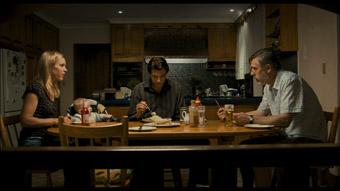
Ten Empty
ANTHONY HAYES’ NEW FILM TEN EMPTY VENTURES INTO SOME FAMILIAR TERRITORY. MADNESS AND THE CLAUSTROPHOBIC DRAMA OF DYSFUNCTIONAL FAMILIES HAVE LONG BEEN GRIST FOR THE MILL FOR AUSTRALIAN FILMMAKERS. IT MIGHT BE AN OPPORTUNE MOMENT TO REFLECT ON THE MEANING OF ALL THIS FOR OUR SENSE OF A NATIONAL CINEMA.
Local films often define their niches in terms of the mainstream, and if Hollywood has cornered the market in feel-good movies, Australians can try to differentiate themselves by promising a wrist-slashing good time. It works for Michael Haneke and the Europeans after all. Few seem in a hurry to make comedies in fear of being residually labelled with the Q word (quirky).
Ten Empty’s basic plot device of a prosperous, though unfulfilled brother returning to the sleepy badlands of Adelaide to reunite with his family recalls Ray Argall’s Return Home (1990). Once there, the protagonist is on the terrain of The Castle (1997), although the Kerrigans have now gone decidedly toxic. Like a suburban Wake in Fright (1971), the narrative represents a season in hell, where male dysfunction finds expression through alcohol and aggressive mateyness.
Elliot (played by Daniel Frederiksen), having had the good sense to move to Sydney, comes back for the christening of his step-brother. He finds the kind of family situation you associate with Appalachia rather than the Festival City of the South. Mum has suicided after discovering that Dad is rooting her younger sister Diane; Dad is alcoholic and unemployed, though now married to Diane; younger brother Brett is huddled in his room in the grip of paralysing depression (is it perhaps significant that co-writer Brendan Cowell is currently touring with the Bell Shakespeare Company’s production of Hamlet?).
The film begins impressively enough. A plane approaches the camera low and to the right of the frame. There is an eye for composition here, and an ear too, as the languidly morose music suggests. The moment the characters open their mouths, however, the jig is up. The mark of script development lies heavy on every utterance. Every hesitation is planned for effect; every awkward and evasive piece of dialogue signifies Awkwardness and Evasion. The cumulative effect is one of unremitting heavy-handedness. What can you make of a scene that begins with the line: “Don’t lay your Catholic guilt on me, Diane”?
This starts to become a more interesting film if we see it as foregrounding some fundamental issues for contemporary Australian cinema. It has frequently been remarked that the Australian cinema has an affinity for stories of madness. Angel Baby (1995), Sweetie (1989), Cosi (1996), Bad Boy Bubby (1993), and Romulus My Father (2007) come immediately to mind. Mental illness gives actors something twitchy to get their teeth into—Geoffrey Rush’s breakthrough performance in Shine (1996) provides a career-defining example.
Ten Empty opens up the possibility that we might see mental pathology as a metaphor for the Australian cinema at the current moment rather than merely a preferred subject matter. It is a rather banal interpretive move to read stories as allegories of their own production, but let’s press on and see where this ends up.
Like young Brett in Ten Empty, Aussie movies were once the golden boy, full of youthful promise and familial pride, but these days with Australian share of domestic box office for 2008 hovering around 0.9%, they don’t get out of their bedroom much any more. The hope of the family is that those who left and prospered (Baz, Hugh, Nicole and Russell) will come back to pull us out of the poo.
The strong case for putting madness at the heart of Australian cinema is in the way that schizophrenia involves an inability to make connections between the component parts of the self, and between the self and the social world. This lack of imaginative connection is one of the most interesting aspects of Ten Empty.
Everyone is hunkered down into their performances in a way that distances them from each other and, more importantly, from the audience. This is an Actors’ film—literally—directed and written by actors, after the fashion of Richard Roxburgh’s success last year with his family drama, Romulus My Father. I get the sense that its makers are more at home in the theatre as the place they have learned their craft. It is an oft-repeated observation that few Australian filmmakers watch many movies. Certainly we have rarely embraced the examples of Godard, Truffaut, Fassbinder or even Tarantino in having a tradition of cinephiles becoming filmmakers in this country. Mark Hartley’s recent Not Quite Hollywood has to import an American, Tarantino, as the most articulate defender of Australian film history.
The writing similarly exists in a vacuum where there seems to be little conception of what an audience can bring to a film. Watch a Hollywood movie like Iron Man or a skilful Australian one like Lucky Miles (2007), and the film has a sense of where to put a joke, of when to push the audience out and when to pull them back in, of what it does and doesn’t need to say. Look at the last scene of The Unfinished Sky (2008), where the crucial revelation that the heroine has been interned in a detention camp is a small triumph of understatement, confident that the audience will supply the affect.
Like a schizophrenic who has no sense of how her words will be received, Australian films too often need to prove their professional expertise by doing everything themselves, putting everything on the page in script development, with the result that they become badly overdrawn. Where The Castle managed to get away with its satire of the outer suburban lower middle class, the impression you get from Ten Empty is that the filmmakers look down on the suburban types they can only signify through theatrical caricature. Why else would you put a line like “It’s such a nice marinade on the aubergine” in a character’s mouth?
It is also significant that most Australian films about madness situate it in the dysfunctional family. You can quickly list a line of movies which emerge out of the claustrophobia of the family: Soft Fruit (1999), Swimming Upstream (2003), The Boys (1998), Home Song Stories (2007). As Screen Australia represents a very recent marriage in the family of our film institutions, it might be worth asking whether the dysfunctional family might be another symbol of the Australian film industry.
What immediately occasions this observation is that the South Australian Film Corporation put money into Ten Empty on the basis that it was shot in Adelaide and employed many members of the local production industry. Now, not too long ago we Croweaters were horribly offended by that nasty, brutish Victorian Premier’s description of Adelaide as a backwater, but that is positively sympathetic compared to the view of the city we get here. This is aptly summed up by the protagonist when he screams: “You stay here, you rot.”
I reckon I’ve eaten my weight in hors d’oeuvres at government-sponsored sessions where we ponder how to keep our best and brightest from abandoning the state and moving to the Sodom and Gomorrahs of Sydney and Melbourne. Yet in this film Adelaide is the place you leave, the place where time has stood still, the dark and depressed place of infantile regression.
I can only applaud the filmmakers’ desire to bite the hand that feeds them, but you have to wonder what state government agencies make of the result—or if they care. The importance of Australian films in policy terms has too often ended with their production. If they are lucky, they strut and fret their hour upon the art cinema screens (Ten Empty was released on nine prints, which was better than five other Australian films so far this year) and then are gone/tales of sound and fury…
Ultimately the pathological disconnections here are with the distribution sector and the audience—and the audience knows it too. Feature films in Australia are too often made for the sake of being made, rather than being made to be distributed and watched. Australian films have been short term answers to the political problems engendered by the persistent demand for a production industry. The problem becoming increasingly clear is that these motives too rarely extend to consumption and to any sense of connection with an audience. It was encouraging that Federal Arts Minister Peter Garrett, in his speech at the 37 South market event at Melbourne’s International Film Festival, stressed that with the introduction of the producer offset scheme, direct government funding would henceforth be directed more to marketing and distribution subsidy.
So maybe I’ve come around to a sympathetic response to Ten Empty. It’s an important film as a gauntlet flung into the face of our cinema. We have to start to conceive of films as things designed in the spirit of connection: connection with an audience, connections with revenue streams, connections with some sense of film history and contemporary screen culture. If we stay here, we rot.
Ten Empty, director, writer Anthony Hayes, writer Brendan Cowell, producer Naomi Wenck, cinematographer Tristan Milani, editor Luke Doolan, Sydney Film Festival, 9 June, currently screening.
RealTime issue #86 Aug-Sept 2008 pg. 20
© Mike Walsh; for permission to reproduce apply to realtime@realtimearts.net
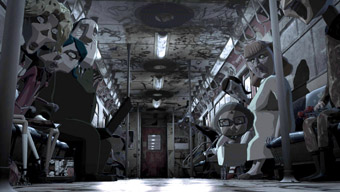
Ephemeral
FESTIVAL FILM VIEWING IS A VERY PARTICULAR EXPERIENCE. WATCHING THIS YEAR’S SELECTION OF 15 SHORT AND MEDIUM LENGTH DOCUMENTARIES, FICTIONS AND ANIMATIONS COMPETING IN THE DENDY AWARDS AND SERVED UP IN QUICK SUCCESSION OVER ONE DAY OF THE SYDNEY FILM FESTIVAL, I SENSED THE PHYSICAL EFFECTS OF FILMIC TIME.
The day opens with Stefan Moore’s 52-minute brisk and informative The Cars That Ate China. Interspersed with a range of music, the slick style holds attention as the accumulating seriousness of the subject matter creeps up on you. Alarming statistics fly by in text on the screen (forget 1 million bicycles, by 2020 there will be 140 million cars in Beijing!). Moore and his team manage to convey the complexity of the crisis with a mix of humour and pathos amidst the madness. He also ranges wide for his subjects. A social activist conjures an ugly metaphor of Beijing as “a raped city—and the girl is still taking bookings” to express his powerless disgust at the destruction of the hutangs (older parts of the city) for roads.
The Chinese are “intoxicated by aspiration,” reports a knowing American adman. “Not all will own cars but all aspire to and that is enough.” To get rich is now glorious. And why not, you ask yourself as you watch the cheery members of the VW Golf Car website organise their first wedding; people running trucking and carwash businesses in the city returning to visit relatives in villages where cars are still mysterious machines. We enter a gated community where residents (almost entirely celebrities) glide around in Bentleys. “You wouldn’t be seen dead in a Japanese car,” says the Chinese entrepreneur while bored women drape themselves on car bonnets in that enduring and meaningless conjunction. Meanwhile savvy car hoons scramble through traffic. The film ends as one young man pauses to consider for a minute what might be happening to China and then moves swiftly on.
Director Rhys Graham fills the 27 minutes of his film Skin with intriguing detail, recounting the tale of Geoff Ostling who on retirement from his teaching job, decided to embark on a full body tattoo. What makes the time seem short is the filmmaker’s comprehensive approach to his subject matter and a couple of details: the tattoo is composed almost entirely of Australian flowers and the tattooist is the artist eX de Medici. As well as the subject and his partner, we hear from an assortment of experts including doctor, botanist, a taxidermist and the curator of a Japanese tattoo museum to which Geoff Ostling would like to donate his skin when he finally runs out of time.
At 26 minutes, Rare Chicken Rescue, directed by Randall Wood also flies by on the strength of its idiosyncratic subject matter. Mark Tully is a complex character—a poultry fancier and breeder who lives with his parents and occasionally takes to the road to attend gatherings of mostly male fanciers or to visit other breeders on the lookout for that elusive azeel or Sumatran. Tully speaks to the off-camera filmmaker and along the way introduces us to a range of rare breeds both animal and human, the former artfully displayed against coloured backgrounds in extreme close-up (my favourite, the Transylvanian Naked Neck) all of this set to wild klezmer music. As the endearingly depressive Tully confesses his true regard for the ducks and chickens that saved him from himself, you can feel this film pleasing the audience (the timing of sighs and laughter is near communal). As one whose childhood chores including feeding one scary bunch of hens, I kept my distance but the film won Best Documentary.
An odd collection of three films vied in the category of Most Innovative. The animation Ephemeral (director-producer Tony Radevski, Jongshu Oh) was a worthy winner. Set in the closed world of a train carriage, it focused on the collective imaginings of a motley collection of passengers held captive to the movements of a rolling drink can on the carriage floor. Rendered entirely in tones of black, grey and white (with the can the only red), the physiognomy of the John Brack-like characters had me musing on just how far animators can extemporise on the body and still have us recognise it as human. Though the claustrophobic atmosphere and muted palette took some concentrating at 15 minutes, the endlessly inventive play with perspective kept this film rattling right along.
In Spirit Stones, director Allan Collins follows a group of Noongar elders from Australia’s south-west corner as they recount their mysterious tale of stones falling from the sky which each had experienced in the oppressive times of the 1940s and 50s. These stones (sometimes hot) moved through tents, walls and tables without leaving a mark. Here time slows, reflected in two distinctive formats (HDTV and Super 8) alternating colour and grainy black and white to echo shifts between past and present in the still vivid memories of the elders as they move through the haunting landscape.
Like the distracted children at its centre, I lost myself altogether in the 8-minute abstraction of Keri Light’s Wanderlust/Wonderlost.
In the Fiction category, 3 films competed for the prize.
Ali and the Ball, (director Alex Holmes, 15 mins) was a neatly constructed short featuring an impressive performance by Ali Soummaka in the role of an optimistic boy living with his little sister and distraught mother in the dead zone of a detention centre. The Sound of Cry, directed by Michael Mier (9 mins), cast unfamiliar light on a community of Maori Queenslanders through the story of a white boy who shows up uninvited at a traditional Maori funeral to bid farewell to his friend.
I would willingly have spent more than the 12 minutes with the third film, Summer Breaks. Writer-director Sean Kruck shows promise aplenty in this easygoing observation of indolent youths skating close to trouble in the sweltering suburbs. This film was selected from the Dendy finalists to receive the Rouben Mamoulian Award.
The CRC Award is presented each year by the NSW Government’s Community Relations Commission to a film whose content reflects the multicultural experience in Australia. Rachel Landers’ powerful A Northern Town reveals a complex picture of race relations in Kempsey, the town that famously returned the largest no vote in the 1967 Referendum to recognise the rights of Aboriginal people. Anchored in an indigenous owned and operated aged care facility housing both black and white this film takes its time to uncover a shared and troubled history.
In style, Ten Pound Poms (director Lisa Matthews) is pretty familiar fare, making the most of some interesting archival material along with first person reflections from nine Britons who migrated to Australia in the post-war years and variously stayed put or not.
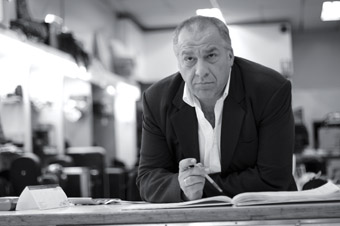
Tony Niholakopoulos, 296 Smith Street
The prize went to recent VCA graduate John Evagora for his short and sweet fiction 296 Smith Street. Competing with two 52-minute documentaries, Evagora’s film is a stylish short fiction, shot in black and white and focusing on the daily grind of Ahmed (Tony Niholakopoulos) a suburban pawnbroker dealing with sellers, the occasional buyer along with neighbourhood eccentrics and violent blow-ins. Dialogue is sparse and idiosyncratic, characters deftly drawn. It’s spare but hits the mark with its careful timing and consistent mood. We read between the lines to build a picture of this community as Ahmed calmly takes care of business and everything in between.
Even though late in the day seemed somehow untimely for the Animation selection I was intrigued by Dennis Tupicoff’s sophisticated mixed means animation Chainsaw (25 minutes), and less so by the charmingly cute Lucille (director Tali Gal-on, 6 mins) and Glen Hunwick’s endearing if predicable Mutt (8 mins) which picked up the Yoram Gross Animation Award.
But it’s late in the day and I’ve experienced nine films, nine locales, and inhabited nine different time zones. I arrived in the bright morning and shuffle out into chill night.
–
Dendy Awards 2008, Sydney Film Festival, 13, State Theatre, Sydney, June 13
RealTime issue #86 Aug-Sept 2008 pg. 22
© Virginia Baxter; for permission to reproduce apply to realtime@realtimearts.net
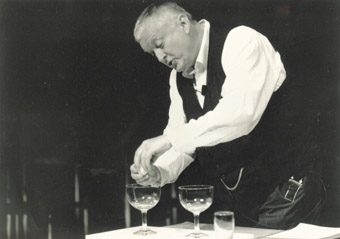
Peter Kubelka, 1994
IN SEPTEMBER ONE OF THE WORLD’S FOREMOST EXPERIMENTAL FILM PROPONENTS, PETER KUBELKA, FROM AUSTRIA, WILL BE IN RESIDENCE AT THE NATIONAL FILM AND SOUND ARCHIVE IN CANBERRA. THE VISIT PRESENTS A UNIQUE OPPORTUNITY TO SEE THE MAN PRESENT HIS FILMS AND ACCLAIMED LECTURES—INCLUDING A COOKING DEMONSTRATION!
Since the 1950s Kubelka has championed both experimental cinema and a history of film art radically different from that of Hollywood or ‘auteured’ European art cinema. In 1964 he co-founded the Austrian Filmmuseum in Vienna and has been its curator ever since. He was also a co-founder of New York’s Anthology Film Archive and has been a professor in film at the Art Academy in Frankfurt since 1978.
Kubelka is also famous for inspiring curatorial projects, including his cycle of film screenings, What is Film, and his plan for The Invisible Cinema: an ideal screening venue first conceived in 1958. Invisible Cinemas (their seats each separated by partitions) can now be found at Anthology Film Archives and the Austrian Film Museum in Vienna
Kubelka has made just over an hour of work in half a century, all of it unavailable on video and difficult to access. Yet its influence has been profound, with Jonas Mekas describing his films as “like a piece of crystal, or some other object of nature: it does not look like it was produced by man”, and Stan Brakhage calling Kubelka “the world’s greatest film-maker.”
But since the 1970s, Kubelka has also been dedicated to cultural de-specialisation and interaction, working to find cinema’s common history with architecture, archaeology, music and the culinary arts (focusing on what he calls “non-industrial cuisine”).
A guest research fellow of the National Film and Sound Archive in August and September, Peter Kubelka will present his famous lecture series—apparently works of art in their own right—only in Canberra. The three-day seminar will be held at the NFSA’s Arc Cinema.
The first two lectures use Kubelka’s own work to probe the idea of evolution as manifested in the development of cinema. This will be the first Australian opportunity to see legendary titles such as Kubelka’s flicker film Adebar (1956/57), his beer ‘commercial’ Schwechater (1958), the 1966 experiment in ethnographic film Unsere Afrikareise and 2003’s Poetry and Truth—Kubelka’s first film in over 25 years. The final lecture, “The Editable Metaphor” gives new meaning to the idea of “expanded cinema”, with what is promised to be a celebration of cooking, food, taste and smell as artistic expressions.
As a bonus, Kubelka will also introduce his restoration of Soviet director Dziga Vertov’s extraordinary 1930 experiment in image and sound montage, Enthusiasm. Writer Danni Zuvela will visit the National Film & Sound Archive to report on the Peter Kubelka experience for RealTime.
Peter Kubelka, National Film and Sound Archive, September; www.nfsa.gov.au for program and dates
RealTime issue #86 Aug-Sept 2008 pg. 22
© Keith Gallasch; for permission to reproduce apply to realtime@realtimearts.net
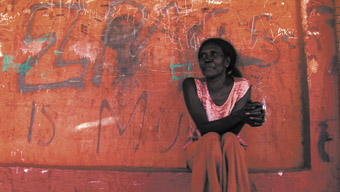
Frances Djulibing, River of No Return
WHERE YOU SEE A FILM, HOW IT’S PROJECTED, THE CONTEXT IN WHICH YOU SEE IT, AND WHO YOU SEE IT WITH CAN OFFER NEW INSIGHTS NOT ONLY TO THE FILM ITSELF BUT TO CINEMA AS A WHOLE. WATCHING THE DOZEN FILMS IN THIS FESTIVAL JUST AFTER AN AUSTRALIAN GOVERNMENT HAD FINALLY SAID ‘SORRY’ TO THE STOLEN GENERATIONS REINFORCED THE SENSE THAT RECONCILIATION, IF NOT TOTAL LIBERATION FROM THE PREVIOUS GOVERNMENT’S HUMAN-RIGHTS DENYING INTERVENTIONIST POLICIES, WAS NOW WELL AND TRULY ON THE FILMIC AGENDA.
The feeling of liberation from the past was heightened by the mix of red carpet partying and self-congratulation along with self-criticism and some extraordinary films and very heated discussions. Then there were the Chooky dancers who threatened to upstage everything in sight. The cultural vectors of these young Elcho Islanders simultaneously performing homage and send-up of Theodorakis’s Zorba as they spilled over from screen (Frank Djirrimbilpilwy Garawirritja’s Yolngu Djamamirr/Aboriginal Fishermen) to live on stage and onto the Opera House forecourt, offered a vision of cultural transformation endorsed by many of the films.
As in previous years, curators Darren Dale and Rachel Perkins offered the chance to see films that might not otherwise be seen at all and in circumstances that made it possible to observe patterns and samenesses as well as disruptions and differences that might otherwise go ignored or unobserved. They included films by indigenous filmmakers from overseas, allowing us to explore the connections that do or don’t exist between Aboriginal cinema and other indigenous cinemas.
In fact, the overseas films forged links to other cinemas entirely. Kevin Burton’s experimental Nikamowin/Song (2007), for example, deconstructs and reconstructs the Cree language with such inventiveness that it seemed the productive outcome of a head-on clash with Derrida and the German-Australian experimentalist, Paul Winkler (see Alec Gerbaz, “Innovations in Australian Cinema: An Historical Outline of Australian Experimental Film”, NFSA Journal, Vol 3, No 1, 2008).
Sikumi/On the Ice (Andrew Okpeaha MacLean) initially seems to be indebted to Atanarjuat/The Fast Runner (Zacharias Kunuk, 2001)—both are in a dialect of the Eskimo-Aleut languages group, both have a mise-en-scène dominated by wide, flat icy vistas, seal-skin encased bodies and whiskers with dangling icicles, and both tell a murder tale. At second sight Sikumi appears to be the offspring of an unruly union between indigenous, art and mainstream cinemas.
The boundaries between cinematic and other cultural categories proved even more porous with the Aboriginal films. A persistent theme was that of shifting ideas, images, sounds and other cultural material passing to and from Indigenous and mainstream cultures. As films such as Ten Canoes and Rabbit Proof Fence demonstrate, this is a two-way ticket.
In Darlene’s Johnson’s River of No Return, the captivating Frances Djulibing dreams of being Marilyn Monroe: sexy and a great comic actress with diamonds for a best friend. Frances’ long trudge along the dirt road between her home and Raminginging in north eastern Arnhem land becomes the symbol of the seemingly impermeable borders between Aboriginal and balanda (white) cultures that Frances must learn to cross.
The high walls white society has erected around its black members seen through Kelrick Martin’s unflinching lens in Mad Morro are too rigid for any productive interactions to take place. When released from jail after 13 years inside, there is no after care program available for 30-year old Morro to learn how to be an adult outside the prison walls; a lethal mixture of alcohol and his acquired helplessness lands him back where he started. But the film shows us what once might have been either dismissed—or hated—as a negative image of Aboriginal people. This documentary bravely crosses yet another border in search of a common humanity that knows no apartheid and shows us images that we’ve seldom seen on the screen.
Perhaps the most startling film of all is Debbie Carmody’s Courting with Justice which reconstructs an Indigenous Customary Law Court to ‘try’ the white pub manager cleared of charges of the manslaughter of Kevin Rule, a member of the Ngadju Nation. Fact and fiction, past and present, white and black truths all merge and inform each other in this outstandingly bold, intelligent film. The fear on the face of white actor Roy Billing playing the accused when confronted by the dead man’s family is as real as the grief of the family members. Like the classic Two Laws (Carolyn Strachan, Alessandro Cavadini, 1981) about the Borroloola people’s struggle for the recognition of Aboriginal law, Courting with Justice simultaneously builds and demolishes the boundaries between black and white film cultures and between black and white laws.
There is no film in this well-curated festival that does not explore the productive outcomes of cultural clashes. Even the most conventional, When Colin Met Joyce (Rima Tamou), is ‘about’ the mixed race marriage of Colin and Joyce Clague and explores the hybridised race-and-politics cultural family environment that together they created. On the far side of convention is Cornel Ozies’s Bollywood Dreaming with its snapshot of 16-year-old African-American-Aboriginal Jedda Rae Hill who skates, boxes and adores to dance to Bollywood movies (RT85, p18).
Storytime (Jub Clerc) mixes fiction with autobiographical experience. Who Paintin’ Dis Wandjina? (Taryne Laffar) explores reactions to the white graffiti artist who paints the symbol of the creator of fertility and rain for the Mowanjum Aboriginal peoples in the Kimberley in the wrong place and without permission (RT85, p18). Even the films most specifically Aboriginal in terms of content, Alan Collins’ beautifully mesmeric Spirit Stones and Angie Abdilla’s artfully creative Wanja: Warrior Dog don’t hesitate to explore the flows between tradtional and modern, fact and fiction, mainstream and non-mainstream.
When cinematic genres and categories get as confused as this we need to consider what we mean by indigenous cinema. It’s a cinema relatively so new that it doesn’t yet have a commonly accepted name. Nor is there an established critical framework in which to theorise it. Is it a single cinema that straddles local, national and regional borders? Is it a number of individual cinemas that can be treated as a sort of national cinema? Or is it simply a number of films that can’t yet be considered to be a cinema at all?
The term ‘indigenous’ is not appropriate because it can refer to something that is ‘native’ to a particular area—Dr Who, for example, is indigenous to the UK. While ‘Aboriginal’ makes sense in the context of Australia, it can cause confusion among those in other nations unaware of the significance of the capital A. Scholars, meanwhile oscillate between Third World, Third Cinema, marginal, anti-racist, multicultural, hybrid, mestizo, postcolonial, transnational, imperfect cinema, cinema of hunger, minority, minor, accented, intercultural and transcultural. First Nation may overcome many of the problems because it explicitly recognises the original inhabitants of colonised territories, though it shows few signs of catching on.
This is more than an arcane debate because, despite considerable ethnic, racial, language and other cultural differences, the various names all tend to present a single homogenous cinema engaged in political and aesthetic opposition to mainstream cinema.
It tends to be treated as a minority cinema alongside other non-mainstream cinemas with which it’s widely thought to share a common experience of being dominated and excluded by mainstream commercial cinema. Or, within postcolonial discourse, it’s treated as a sub-genre of a national cinema. Either way, indigenous films carry a set of cultural baggage supposedly differentiating them from mainstream, commercial Anglo-American, white cinema. It is commonly regarded as mainstream’s indigenous other.
Every year, the Message Sticks films show the cinematic terrain to be more varied than widely imagined. The relationship between First Nation and dominant cinema is by no means one of perpetual opposition and assimilation: minor cinemas are not necessarily cultural losers and mainstream cinema does not necessarily and continuously absorb and destroy its First Nation others. But it should be acknowledged that First Nation films usually form a part of a national cinema, and because Hollywood is the dominant cinema in most of these nations, First Nation filmmakers can find themselves as Sally Riley, Director of the Australian Film Commission’s Indigenous Branch, once said, “on the fringe of the fringe of the mainstream” (Philippa Hawker, ‘Black Magic: Aboriginal films take off’, The Age, June 19, 2002).
First Nation cinema’s relationship to the mainstream is certainly not one of equality. But this does not mean that the indigenous cinema is inevitably and necessarily crushed, contained or cannibalised by an undeniably powerful dominant cinema. The productive outcomes of tensions in the globalising processes show that locating Hollywood and First Nation cinema within each other is not necessarily an indication of cultural cannibalisation and that much greater diversity exists in Hollywood’s First Nation ‘others’ than is commonly imagined.
–
Sydney Opera House in association with Screen Australia and Blackfella Films, Message Sticks Indigenous Film Festival, Sydney Opera House, July 4-6; Tandanya, Adelaide, Aug 7-10; Deckchair Cinema, Darwin, Aug 21, Sir Robert Helpmann Theatrem Mt Gambier Aug 28-30
RealTime issue #86 Aug-Sept 2008 pg. 23
© Jane Mills; for permission to reproduce apply to realtime@realtimearts.net
![PeursDuNoir [Fear(s) of the Dark] - Burns 06, Charles Burns](https://www.realtime.org.au/wp-content/uploads/art/20/2054_sellars_fefars.jpg)
PeursDuNoir [Fear(s) of the Dark] – Burns 06, Charles Burns
THIS YEAR’S MIAF WAS FLUSH WITH RICHES. SELECTED FROM OVER 2000 ENTRIES, THERE WERE 150 FILMS IN COMPETITION AND 150 OUTSIDE OF IT. THERE WAS AN EIGHT-PROGRAM INTERNATIONAL SELECTION, MUSIC VIDEOS, DIGITAL ANIMATION, STUDIO AND PRODUCER SHOWCASES, A SERIES OF SAN FRANCISCO HISTORICAL ANIMATIONS, ANIMATED DOCUMENTARIES AND THEMED PACKAGES WITH TITLES LIKE LATE NIGHT BIZARRE AND STRANGE IDEAS AND BAD CRAZINESS. THERE WERE GRADUATE, TEEN AND KIDS PROGRAMS, ANIMATION 101 SESSIONS AND THE CAREERS IN ANIMATION FORUM, ALL ADDING TO THE CRUCIAL WORK MIAF DOES IN BUILDING A VIBRANT ANIMATION CULTURE FROM THE GROUND UP.
The technique focus this year was on puppet animation. I’ve been bored with CGI’s dominance so I welcomed it. MIAF curator Malcolm Turner, introducing the Icons of Puppet Animation screening, highlighted how puppetry can uniquely express the soul of an animated character. Jiri Trnka’s allegorical masterpiece The Hand (Czechoslovakia 1966, 17mins) was the exemplar. According to Turner, this was one of the first puppet animations to feature static faces, telling the story of a down-at-heel sculptor making art in his small apartment. An enormous, live-action hand breaks the frame, filling the apartment with its bulk and forcing the artist to make sculptures in its likeness, attaching strings to the artist and manipulating his actions, or destroying whatever non-hand art the artist produces. The allusion to totalitarianism is clear, but the state’s capacity to endlessly erase and reinscribe its own identity in order to control and dominate is also apparent. This is reinforced by the contrast between the puppet-artist’s mournful, unblinking face, which becomes a screen for the audience’s imagination, and the hand’s everchanging bulk, trying every trick it can—even dressing its fingers in lacy lingerie—to lure the artist.
Another Icon standout was Balance (directors Christoph & Wolfgang Lauenstein, Germany 1989, 8mins). Five identical, skinny, bald characters with sunken eyes and prison-camp greatcoats stand on a platform suspended in space with no visible means of support. If one moves, the platform tips and they all go sliding close to the edge and oblivion; therefore they must work with each other to maintain balance. It’s finally a devious and deadly game as curiosity, then jealousy, brings them undone. The bleak monochromes of the set and costume design give this an existential charge that is hard to shake off. Kataku (The House in Flames, director Kihachiro Kawamoto, Japan, 1979, 17mins), a fable about attraction and choice, is like a Japanese doll set come to life, all slow movement, glossy faces and hair, watercolour backgrounds and scenery, almost imperceptible stillness melting into exquisite motion poetry, mixing noh and bunraku styles. Pygmalion (Arnold Burovs, Latvia 1967, 9’45mins) is a brilliant union of clockwork figures and metronomic sound design as a sad, bearded inventor creates a mechanical woman only to become lost in her gaze and ultimately the op art scenery surrounding her. The Philips Broadcast of 1938 (Holland 1938, 9’30mins) featured George Pal’s amazing and beloved Puppetoons, incredibly flexible puppet characters that contort and shape shift with sheer glee, so skilfully realised and synchronised via Pal’s replacement animation technique [using multiple puppets or parts for each character move. Eds] that they look hand-drawn.
Of the contemporary puppet animations, the standout was Madame Tulti-Pulti (Chris Lavis & Maciek Szczerbowski, Canada 2007, 17’25mins), an intricate stop motion that took me somewhere I’ve never been before. The titular Madame boards a strange, steampunk train powered by an enormous turbine. Dressed like a 30s Parisienne, she settles into her compartment and tries to read a book. On the overhead bag rack, two men are hunched over a chess set. Whenever the train hits a bump, the chess pieces fly into the air and rearrange themselves in different combinations on the board. A freaky kid stares at the woman. Then a beefy pervert makes the fucking signal with the time-honoured ‘O’ sign of one hand penetrated by the index finger of the other. Poor Madame. She nods off and wakes up to find everyone gone and an alien green mist polluting the compartment. Shadowy figures glide past and, when she investigates, it appears that everyone but her has been the victim of, I think, an organ-stealing black market operation. Perhaps. I won’t pretend to know what it’s all about, suffice to say that Madame Tulti-Pulti has quite clearly taken a train ride to hell. The other remarkable aspect of this film, besides the scenery, the stage sets and the character of Madame herself, wafer thin and etched with grain, is the filmmakers’ technique of compositing live-action human eyes onto the puppets. A kind of hellish variant on the 60s animated TV series Clutch Cargo, it has a supremely bizarre, preternatural touch that plunges the viewer deep into an uncanny valley.
Live Life (Jonathan Pasternak, Israel, 2006, 5’30mins) is a self-consciously odd Day of the Dead puppet musical featuring decomposing versions of Albert Einstein, Joey Ramone and other celebs all gathered in The Ossiary, the famous Czech church adorned with 40,000 human bones. This lunatic troupe is led by Johnny Cash in a rousing rendition of the William Shatner song, “Live life like you’re gonna die, coz you’re gonna.” Even the Ossiary’s skulls join in on the chorus. I loved The Bridge (Vincent Bierrewaerts, Belgium, 2007, 13mins), about a boy who lives with his father on a mountain top. When he accidentally kills his dad, the boy grows up alone, thinking he’s trapped up on high, watching the bombing of the city far down below in some unnamed war. The only access to the outside world used to be a bridge that fell down long ago, but eventually the boy finds a tunnel down through the mountain and wanders the shell-shocked city alone. The puppet boy is masterfully rendered: pure expressive innocence memorably etched onto his bulbous eyes and round head.
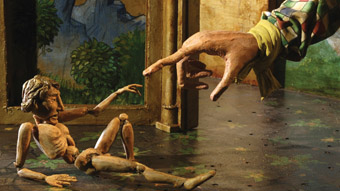
L’Animateur, Nick Hilligoss
The Australian Panorama was maybe the best Australian animation program of the last few years. L’Animateur (Nick Hilligoss, 2006, 3’45mins) takes a corny premise, the Garden of Eden, and infuses it with a meta-narrative on the joy of animation itself. A medieval jester lands on an planet uninhabited save for a few frogs. He unpacks a little portable stage set and places two lifeless wooden puppets on it. They are attached to strings but then he zaps them with some kind of beam and they move about autonomously. They see a tree with apples and, naturally, eat them. Flesh subsequently grows on their bodies, there is music cranked out by the jester and the frog audience dances in thrall. When the humans are fully realised, the jester pulls the floor out from under them and they fall to the ground. The jester packs up and flies to another planet, leaving behind the first human life on Earth and a performance those frogs will always remember.
Other Australian standouts included the hilarious, affecting Monkeynaut (Snooze Animation, 2007, 7’15mins) about what really went on in those early chimp-only space missions (hint: it involves lots of long, yellow fruit). Professor Pebbles (Pierce Davison, 2006, 12’45mins) is inventively realised with its tale of a minion of Satan who has a mid-life crisis on his 500th birthday and decides to go above ground for a change of pace, yet can’t quite shed his wicked ways. The lurid colour scheme and claymation weirdness make an imprint on the retina. The Goat that Ate Time (Lucinda Schreiber, 2007, 7mins) is really beautiful, both in terms of its textured technique and its sentiment, about a voracious goat who eats everything under the sun including clocks and watches, with the timepieces and their chronological ‘nutrition’ slipstreaming her into an endless, timeless present.
And, now, just as I ran out of time to see everything at the festival, so too I’m out of space, with just enough words to big up the portmanteau film Fear(s) of the Dark (Canada 2007, 85mins). Based on the work of 10 graphic artists and comic-book creators, and almost entirely monochrome, it weaves nightmares from the most basic of materials, black and white, for all nightmares emerge from the shadows. My favourite scary story was Richard McGuire’s about a man who is lost in a snowstorm and takes refuge in an abandoned house. Inside, he has to find his way around in compete darkness, the brief flickering of light from his candle exposing what looks to be floral patterned wallpaper, but may or may not be a woman’s dress. And ‘she’ may or not be holding a meat cleaver. The floral shapes melt back into the dark as the candle goes out and the games of illusion begin again. In the morning the whiteness of the outside world proves as treacherous as the black of night, with a glimmer of help for the man frustratingly melting back into the snow-covered landscape as clearly as it emerged.
Finally, congratulations to MIAF for its bold, imaginative programming. The only sour note is that all events weren’t sold out. Readers, do you know what you have in your own backyard?
Melbourne International Animation Festival 2008, ACMI, June 16-22, www.miaf.net/2008/home.html
RealTime issue #86 Aug-Sept 2008 pg. 24
© Simon Sellars; for permission to reproduce apply to realtime@realtimearts.net
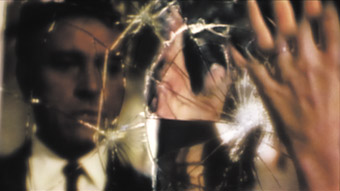
Matthias Muller and Christoph
Girardet’s Play (2003)
“THIS IS REALLY FUCKING RUDE, YOU KNOW? GIVEN WHAT HAPPENED—WHAT YOU DID. [PAUSE] SO YOU’VE DITCHED CELIBACY THEN?” THE OPENING LINE OF DIALOGUE IN STUART CROFT’S HIT (2003), ONE OF THE KEY WORKS FEATURED IN ARTISTS VS HOLLYWOOD, SETS UP A NARRATIVE EXPECTATION THAT THE FILM NEVER INTENDS TO FULFILL. INSTEAD—IN A CLEVER MOVE THAT SIMULTANEOUSLY DECONSTRUCTS THE ART AND CRAFT OF STORYTELLING WHILE CONFORMING NICELY TO THE LOOP IMPERATIVE OF THE CONTEMPORARY GALLERY—HIT PROCEEDS TO REPEAT THE SCENARIO (LOOSELY, A MAN AND WOMAN AT A BAR DISCUSSING A BETTING RING) WITH A SEAMLESS SERIES OF PERMUTATIONS ON THE STORYLINE.
Each time, though the dialogue remains the same, key changes are made to the characters’ gender and nationality. The repetitions become involutions, turning over the cinematic building blocks of character, performance and mise-en-scène, holding them up for us to inspect and reflect on how these different aesthetic choices construct our experience of a film.
Hit is emblematic of what Anne Demy-Geroe described as “the intimacy of the relationship between ‘cinema’ and ‘art’.” In her elegant opening address to the audience at the opening of Artists vs Hollywood, the director of the Brisbane International Film Festival noted that a Brisbanite in mid-winter is a rather spoilt spectator: there’s the opportunity to experience the latest video art, as showcased by Artists vs Hollywood, and then follow it with the special Film as Art program and a host of other offerings at the Festival. From all this activity, according to Demy-Geroe, whether it’s called artists’ film and video, or film by artists, or avant-garde cinema, it is evident that this kind of creative work has a home in both the gallery and the theatrical setting.
Nonetheless, Demy-Geroe couldn’t help being struck by the “sense of oppositionality” in the exhibition’s “delightfully combative” title. She located the show’s ‘versus’ in the staging of the battle between concurrent but antagonistic forces: a tension between engaging with the cinema as a critical subject and revelling in its guilty pleasures; between the very different processes of appropriation and approximation; between the endeavours of fine art and the ubiquitous presence of screens in our lives. The very naturalisation of the ever-present moving image, it seems, is what has attracted so many moving image artists to critique it. Croft does this—in Hit and in another work in the show, The Death Waltz (2008)—by making what are properly ‘meta-movies’—scripted, directed, acted, filmed and edited like other films, but with commentary on and exposure of the process, rather than the seduction of the spectator, the main game. Croft commits to the classically avant-garde gestures of detournment—using the film industry’s formal language turned back on itself—to expose the artifice and manipulation inherent in this most pervasive of products.
With its racy storyline and quick-and-dirty dialogue, though, Hit is dangerously seductive—at least before the story repeats in a new permutation. In a 2004 review of this work, Martin Herbert declared this makes the film like “a confidence trick”; you “cover for yourself by saying, ‘Ha-ha, I was just kidding.’ You’ve already handed over some capital, but if you’re smart you’ll leave before losing any more.” I thought emotional capital was fully restored by The Death Waltz, an entertaining filmic version of a murder mystery parlour game, where a group of dinner guests in a grand baronial mansion present another circular storyline (this time about a pair of soldier ghosts who dance a demonic waltz). One by one, they recount the gothic story, inflecting each version with a unique point of view. The innovative multi-view technique—entirely shot by the actors using a super-8mm film camera passed around the table in a circle—means that this very contemporary critique of narrative point-of-view touches base with analytic cubism, while reflecting the ongoing resonance of early cinema’s ghouls and devilry in artists’ films.
The other major methodology employed by the artists against the Hollywood machine is not imitation, but appropriation. Found footage film is nothing new—artist Joseph Cornell famously ‘reassembled’ film fragments in the mid-1930s in a technique analogous to Surrealist ‘automatic writing’—and the genre has remained highly visible in avant-garde film since. German experimental film pioneer Matthias Muller is among the most famous proponents of this approach, and while many of his films do evoke the Surrealists’ privileging of the free-associative, unconscious mind, the works in Artists vs Hollywood have a much more conscious, directed task, which is the use of select film fragments to examine the ‘dream factory’ itself. Muller’s work Play (2003), created with Christoph Girardet, consists of shots of different audiences responding to some theatrical moment; we never see what they are watching, and instead have to work it out from their variously rapturous, unimpressed and critical expressions.
A similar use of repetition for effect structures Candice Breitz’ Soliloquy Trilogy (2000), another important work by a major artist which isolates and ‘stalks’ (in the artist’s own words) three of the most iconic stars of recent Hollywood. In Jack (Nicholson), Sharon (Stone) and Clint (Eastwood), we see the star and only the star; Breitz has removed all other characters and shots which show anything but the celebrity, editing in black screens whenever the star is not foregrounded. Decontextualising the stars from their settings, Breitz defamiliarises our experience of the movies in order to force attention on the extent to which the cinema’s representative language is dependent on community for meaning.
What is perhaps most significant about this exhibition is the use of the space at The Block, a challenging venue for group showings of moving image. Housed in a series of sensitively constructed darkened spaces whose fanned shapes funnelled attention to the screen, these mini-theatres enabled each work to be considered in excellent conditions for light and sound.
As moving image curator Chrissie Illes has argued, there are critical differences between the staging and reception of moving image work in the cinema and in the gallery; in “the closed space of cinema there is no circulation, no movement, and no exchange…in the darkness, spectators sink into their seats as though slipping into bed.” This model, Illes notes, “is broken apart by the folding of the dark space of cinema into the white cube of the gallery.” To a significant extent, the success of Artists vs Hollywood lay in its rejoining of those pieces, its recasting of the black-box-within-the-white-cube in a coherent and sensitive way. Some might see the artworks in this show as typical of video’s ‘mise en ruine’ effect on the cinema—fragmenting film into meme-sized pieces in order to recombine them in new, separate artworks. These works of “tertiary cinema” which, according to author and curator Chris Dercon, “consume the whole of cinema”, would all translate into a more traditional white-wall gallery setting, but their nuanced dialogue with Hollywood, as both their matrix and their adversary, was greatly enhanced by the atmospheric setting here. Australian-born curator Joanna Callaghan’s highly developed, thoughtful selections and brilliant presentation generated a potent art—and cinema—experience.
Just after the show drew to a close, the world lost a significant artist: Bruce Conner, whose seminal film A Movie (1952) catapaulted the found footage film to a new level of criticality and rhythmic possibility, and which finds numerous echoes in Artists vs Hollywood. As the experimental film world mourns the passing of one of its brightest stars, recurrent amongst the fond remembrances has been the issue of the model staging of that remarkable film artist’s only solo show (at MOCA—Museum of Contemporary Arts, Los Angeles—and other venues) in 2000. As the conversation shifts to matters of detail about how best to showcase the ongoing evolutions of artistic moving image, Artists vs Hollywood was a timely example of what we can—and should—expect.
RIP Bruce Conner
November 18, 1933-July 7, 2008
Artists vs Hollywood, curators: Joanna Callaghan (UK), Lubi Thomas (Australia), Courtney Coombs (Assistant Curator, Australia), QUT The Block, QUT Precinct, Brisbane, June 12-28
RealTime issue #86 Aug-Sept 2008 pg. 25
© Danni Zuvela; for permission to reproduce apply to realtime@realtimearts.net
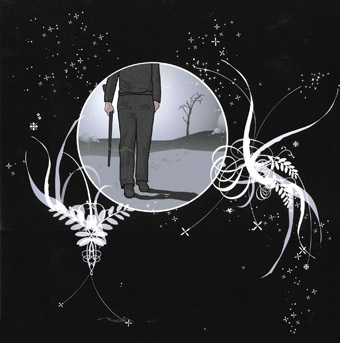
Phip Murray (RMIT Masters graduate), The Floating World (animation still), 2007
GIVEN THE HIGHLY COMPETITIVE CULTURE OF TERTIARY STUDIES, TRAINING INSTITUTIONS ARE HAVING TO LIFT THEIR GAME, EQUIPPING STUDENTS WITH SKILLS IN PROFESSIONAL PRACTICE AND TRACKING THE CAREER TRAJECTORIES OF GRADUATES. IN MEDIA ARTS, HOWEVER, MANY STUDENTS ARE ALREADY TECHNICALLY PROFICIENT, SOME ARE LIKELY TO HAVE BEEN OR ARE CURRENTLY EMPLOYED, IF PART-TIME, IN THE INDUSTRIES OF THEIR CHOOSING AND OTHERS ARE ALREADY INNOVATORS AND MIGHT EVEN HAVE THEIR OWN BUSINESSES. ABOVE ALL, THEY ARE NETWORKED. THEREFORE, INSTITUTIONS NEED TO RE-ASSESS THE ROLE OF PROFESSIONAL PRACTICE COURSES AND WORK EXPERIENCE, JUXTAPOSING THESE WITH STRATEGIES RELEVANT TO THE SKILLS, NETWORKS AND PROSPECTS OF THEIR STUDENTS.
rmit
Ian Haig, Lecturer in Media Arts at RMIT, believes that professional practice schemes have lost their formality, and that students now instigate their own projects and networks whilst at university. He comments, “Media art is constantly in a state of flux and is quite malleable, students must be entrepreneurial, and it’s difficult for institutions to teach this. Students tend to carve out a living on freelance projects that have developed through networks within the industry.”
Seen as a highly successful program in its day, an RMIT professional practice program simply titled ‘Internships’ was once offered to undergraduate media art students. Each class was conducted by an industry professional across disciplines such as animation, gaming and sound. Now internships are negotiated in an informal way but are often salaried and invaluable in forming long-term networks with media arts organizations and companies.
murdoch university
Mark Cypher, Senior Lecturer and Program Chair for Interactive Digital Design and Game Art and Design at Murdoch University believes it is far more useful to teach first year students strategies for self-learning. From first year, students are encouraged to learn the software themselves. Cypher argues that “there is no point in teaching students how to use Flash, for example, when by the time they graduate the scripting language is redundant. It is seen as a far more useful technique to teach students strategies for self-learning…Being aware and intrinsically motivated to learn about innovation is just a fact of life. What other option is there?”
Internet spaces such as Facebook, YouTube and MySpace offer students an easy and accessible way to negotiate marketing and management opportunities. Cypher believes that “once an artist gets enough people interested in their work and it’s posted on enough blogs, the work becomes viral. Curators will then see it and the artists will be invited to exhibit or pitch for a job.” In terms of university training, ‘real world’ units involving client projects (basically project management), are core units for the Media Art courses at Murdoch. Cypher then takes this one step further by “offering lectures on how to get the best ‘sponsorship licence’ for your Flash web and mobile games. The market for new forms of media is changing quickly and for those students who are technically, aesthetically (and to use an old term) street savvy enough, there is a brave new media world to be leveraged to their advantage.”
Cypher also believes there is a decreased need to offer meaningful in-the-field experience during media arts training within academic institutions. “Once upon a time students would jump at the chance to do volunteer or professional placement work to boost their CVs. But at the moment students are not interested in doing anything for free, nor are they interested in doing paid work.” Interested employers often ring with work opportunities for students. Attempting to turn these opportunities into professional placement units Cypher often finds that students aren’t interested. He suspects there are several complex reasons why this is happening: “Students may be burdened with uni work and feel that to take on anything extra would unbalance the situation. Some students are already in the field whilst going to uni. Some have expectations that work is easy to find and thus they can shop around for the right job! Most of my colleagues in the industry who are looking for applicants would agree that they are the ones being interviewed.” There is also a rise in interest from students taking up double degrees, for example art and computer science. Nowadays it seems students are much more interested in jobs and double majors that increase specific skill sets and thus employability.
swinburne university
According to Darren Tofts, Chair of Media and Communications at Swinburne University, a high percentage of his students enter employment in media arts jobs such as radio production, animation and communications research. He says although not studio based, and focused much more on academic learning, Swinburne is committed to professional learning strategies, but similarly to RMIT and Murdoch University, Swinburne puts an emphasis on student-initiated professional practice. For example, graduate placement opportunities used to be negotiated by the faculty and only a selection of students could take up the opportunity. Now all students take up placement opportunities but must negotiate for themselves. This is done as part of the Industry Based Learning program (IBL) and Media Communications and Games and Interactivity postgraduate programs.
Swinburne also holds an annual presentation evening of students’ work for graduates in the areas of sound, video, radio and communications. To add value to this event, Tofts is also committed to the introduction of an annual prize promoting to industry the quality of student work.
uts
At the University of Technology (UTS) in Sydney, students undertake production projects each semester. They can elect to participate in professional placements and are encouraged to develop their portfolio and publicly display their works throughout their study through events such as the biennial UTS Golden Eye Awards and other events and competitions. Gillian Leahy, Associate Professor and Program Director of Media Arts and Production at UTS, highlights the importance of collaboration: “All our students learn to work collaboratively and to take an idea through all stages into a completed media project which can be publicly exhibited in some way. Apart from the critical thinking and media skills they also learn, it is this ability to organise a project through all stages which makes them highly employable.”
disciplinary mergers
New media arts courses and departments set up in the 1990s have not all enjoyed consistent support from their universities, and some have been shut down or merged with other departments. Martyn Jolly of the ANU School of Arts reports that the Australian National University’s Centre for New Media Arts “was disestablished (in 2007), its teaching and research have been folded into the School of Art and a new department formed along with Photomedia, which I headed, so I now head the new Photography and Media Arts Department.” The University of Sydney used to offer a Bachelor of Arts (Digital Technology and Culture). Now, says Chris Chesher, director of the Digital Cultures Program, “We offer an undergraduate major in the Arts degree from the Digital Cultures program in the School of Letters, Art and Media in the Faculty of Arts.” But both Jolly and Chesher see advantages for their students in their multi-disciplinary departments, Chesher, like Mark Cypher, noting the attractiveness of the double degree.
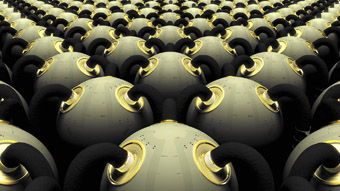
Michael Bongiorno (ANU graduate), PHOTON (animation stills)
anu school of art
Martyn Jolly reports that the Photography and Media Arts Department has developed a new Digital Media major which incorporates sound, networking, programming and physical computing along with video and animation in a single major. “We’ve just started with our first cohort of students, and we think the course is fairly unique in the Australian educational context. We have also just begun a Master of Visual Effects degree which focusses on the CG industry.”
Students are encouraged to participate in exhibitions and performances, and the recording, publishing and performance of new media and time-based arts. The school offers hands-on work experience, in Canberra or interstate, for students in their final year. There’s also a Professional Practice unit, which involves learning the basics of marketing, copyright and tax. Students are expected to go through the process of applying for a grant, including preparing a proposal, budgets, support letters from peers or host institutions and the preparation of support material. Martyn Jolly assesses the proposals as he would in his capacity as Chair of Arts ACT. The school’s graduates go on to be filmmakers, animators, sound and new media artists and teachers or to set up their own businesses or go on to higher degrees, like the Master of New Media Arts. The school’s staff includes composer and media artist Alistair Riddell.
university of sydney
Chris Chesher describes the Digital Cultures program as “something like a small department” within in the School of Letters, Art and Media in the Faculty of Arts. “We are an interdisciplinary, critical humanities program focused on relationships between information technologies and cultural change.” As well as the Bachelor of Arts, the faculty offers the Master of Digital Communication and Culture degree as a one year full-time postgraduate coursework program, which is also available as Graduate Diploma and Graduate Certificate. Chesher reports that “Digital Cultures undergraduates tell us they have been surprised at the level of interest from employers…look[ing] for graduates who demonstrate an understanding of new technologies and their creative and strategic values, but also have the contextual knowledge of a broadly-based arts degree. In many places, this combination competes well against narrow specialism.”
To this end, Chesher says that the program’s teaching “focuses consistently on the social contexts of information technology, and therefore intersects with a wide range of traditions: in fine arts, media and popular culture, sociology, cultural studies, philosophy, history, and so on.” Students can also select electives from Education, IT, Design Computing and also the Sydney College of the Arts.
Indicative of the push towards cross-disciplinary learning and practice, in 2009 the university is introducing a new program Bachelor of IT/Bachelor of Arts (BIT/BA). Chesher expects the degree to be very competitive, producing graduates with an even higher level of technical proficiency along with the breadth provided by the arts: “our strengths really lie in these areas of multi-skilling and the appreciation of innovation. Our newest postgraduate unit of study, Remixable Media, will be taught by Michela Ledwidge, a world leader in the field.” (Ledwidge mixes extant film material, re-playing it like video games. In her VJ performances with films, she treats each like a musical instrument. See RT 87).
Clearly there has been a substantial shift in attitude towards work experience and professional practice course as necessary approaches to preparing students for their careers. While the older model still holds, extending to trial grant applications and increased public performance and exhibition, there are expectations that students will be (if not already) autonomous—self-learning, entrepreneurial and seriously multi-skilled. It is just as clear that university media arts departments are, equally, adapting to a new generation of students.
RealTime issue #86 Aug-Sept 2008 pg. 26
© Nina Stromqvist; for permission to reproduce apply to realtime@realtimearts.net
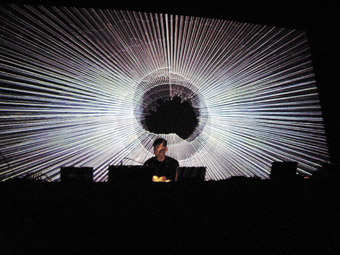
Frank Bretschneider, Elektra
photo Alex White
Frank Bretschneider, Elektra
WITH AN ARRAY OF WORKS AND PERFORMANCES THAT CELEBRATE NEW MEDIA AS OVERWHELMING SPECTACLE, MONTREAL’S ELEKTRA FESTIVAL IS A GLADIATOR PIT FOR THE NEW ROME WHERE MOST OF THE TIME NOONE HAS TO DIE, ALTHOUGH SOME MIGHT SUFFER.
The Elektra Festival is held annually, and its ninth outing in May 2008 consisted of gallery exhibitions, audio visual performances and a conference for new media festival producers from around the world. Elektra focuses on large scale concerts and electronic art installations shown at the excellent Usine C venue and gallery space, with satellite exhibitions and screenings around central Montreal.
Each of the four nights featured live audio-visual performances from high profile artists such as Frank Bretschneider, alva Noto aka Carsten Nicolai, founder of the seminal German label Raster-Noton, and TeZ of Optofonica. The presentation of these performances is intimidating with an enormous surround sound system and triple projection screen across almost an entire length of the space. The terrifying potential of this apparatus turned on a consensual audience was fully realised each night. TVestroy, a duo from Montreal found this still somewhat lacking and added a further 5 CRT screens and multiple strobe lights. The noise and light subsequently emitted was overwhelming leaving the audience and this reviewer unable to do anything more than either hope we wouldn’t die or get another drink.
The performances continued in this vein with Netherlands duo Synchronator exploring signal based video instigation using an array of custom built analogue equipment. I had been very keen to see Synchronator for a while and they did not disappoint with a 40-minute set exploring a territory that was less concerned with overwhelming spectacle than with focusing on what seemed to be genuine live experimentation. Synchronator utilise modulated electrical signals to directly produce violently colourful audio and video.
A momentary lull in the consistent light bombing came from Swiss-based Untitled Sound Objects who are usually configured for installation based gallery works. Their live performance utilised small platforms supporting a variety of substances such as sand and beads. These were modulated by small offset motors controlled by the artists. The amplified movement of the objects on each platform created the sound for the work and a macro camera focused on the vibrating objects produced the video. Their work was relatively quiet and subtle producing delicate, shimmering timbres.
The highlight of the concerts was Telco Systems, from the Netherlands, whose throbbing, howling music was perfectly accompanied with live video that maintained a discernible and intrinsic relationship while also managing to be very beautiful and engaging in its own right. The video produced was a series of organic, two dimensional monochrome patterns constructed in realtime and relationally linked with the audio. It’s rare when the phrase “like Pansonic but good” can be uttered aloud without fear of serious reprisals from peers but that’s how good they are.
The theme of Elektra seemed to be about dual and intrinsically related sensory stimulation. So the unannounced but glaringly obvious intention behind much of the programming seemed to be a series of attempts to produce synthaesthesia in the audience. The inclusion of Kurt Hentschläger’s Feed epitomises this concern. The work originally premiered at the Venice Theatre Biennale in 2005 and has been shown by Elektra three times over the past two years. Shown each night of Elektra after the concerts, the audience was limited to 100 and every night it sold out.
To enter Feed the audience must first sign a waiver. Any audience members who have a personal or family history of photosensitive seizures, a heart condition, high or low blood pressure, anxiety, claustrophobia, migraines or headaches or simply don’t feel well that night are precluded from the experience. The reason behind this water tight waiver is that Feed has triggered seizures in people with no known history of epilepsy and panic attacks in the audience are almost guaranteed. Ten clearly marked safety officers surround the audience who are seated in the middle of the room. The screening process and the work’s reputation made me anxious before I even sat down.
Feed operates in two sections. The first consists of a live 3D animation video that has direct correlations with the sound. A lone, naked, thin androgynous figure floats in a black space, occasionally thrashing and convulsing as though electrically shocked. This figure is then cloned again and again until the entire screen is filled with floating, convulsing dead bodies. The audience is then suddenly enveloped in thick theatrical smoke from more than 10 heavy duty smoke machines. This becomes so thick you cannot see you own hand more than an inch in front of your eyes. 30,000 watts of strobe lights are then triggered from above in sync with the music, performing complex sequences.
The combination of smoke and strobing causes a complete loss of depth of field and spatial orientation. The white and red light flashes occur on the edge of the viewer’s eyeball, actually silhouetting it against the optic nerve. Patterns then form and it becomes possible to see the blood vessels in the eye and the shape of the retina. Other effects are generated by the brain’s repeated attempts to make sense of the experience. At the peak of the work my vision rippled like water when my eyeball was vibrated by the 5,000 watts of sub-woofer the work requires. Feed is both terrifying and beautiful, opening up a field of penetrative art that conducts itself beneath the surface of the skin.
For the past two years Elektra has invited and flown producers and directors from some of the biggest electronic arts festivals and organisations in the world to meet together at the festival. Ars Electronica, Transmediale, Radar and more than 20 others were represented. Electrofringe festival, part of This Is Not Art from Newcastle, Australia was invited as the sole representative from the southern hemisphere. The marketplace included opportunities to represent our festival, meet Canadian artists and plot together into the wee hours. While Electrofringe feels very small in the company of such giants it was an amazing opportunity to develop an understanding of the global electronic arts scene and realise the unique and beautiful aspects of our own little community.
Elektra Festival, Usine C, Montreal, Canada May 7-10, www.elektrafestival.ca; International Digital Art Marketplace May 8-9
www.usine-c.com
RealTime issue #86 Aug-Sept 2008 pg. 27
© Alex White; for permission to reproduce apply to realtime@realtimearts.net
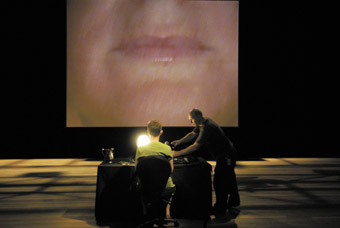
Barbara Campbell and technician Richard Manner preparing for night 1001 webcast of 1001 nights cast at Performance Space at Carriageworks, March 17, 2008
photo Heidrun Löhr
Barbara Campbell and technician Richard Manner preparing for night 1001 webcast of 1001 nights cast at Performance Space at Carriageworks, March 17, 2008
“MY OTHER IMAGE OF THE PROJECT IS THAT OF A HOME; AS SUCH IT COULD ACTUALLY PRECEDE ME. IT COULD ALWAYS EXIST AS A HOME-SPACE, AND ONE THAT I COULD INHABIT QUITE COMFORTABLY RATHER THAN DRAG AROUND LIKE A BURDEN.”
BARBARA CAMPBELL
During the two-and-three-quarter years or so between June 21, 2005 and March 17, 2008 I lived at four different addresses in Melbourne, which is to say that I moved house three times. It is my impression today that these moves involved numberless hours of hushed sorting, packing and unpacking of furniture and belongings. And numberless mornings of improvising what I needed from those various boxes, bags or teetering stacks of things that were to hand. Home now in Melbourne, where I am writing this reflection, is a rundown weatherboard house; there is a gas fire crackling and, on the mantlepiece above, a vase of early hyacinths—their scent pervades the room.
During the same two-and-three-quarter years or so I was one of 243 contributors to Barbara Campbell’s online performance project 1001 nights cast, which culminated in a webcast from Sydney’s Performance Space at CarriageWorks on March 17. Throughout the preceding interval of 1000 evenings, Campbell lived or stayed at 33 different addresses in seven countries across the globe. And wherever she was residing, or perhaps simply pausing in her travels, at sunset she performed for live webcast a story composed just hours earlier; a story delivered to her online, by a writer with whom she had been in contact through the day, at first with a ‘prompt’ for inspiration—a word, or a cluster of words sourced from an online news report about the Middle East.
From its inception 1001 nights cast was confidently reliant on the transnational reach of internet communication: on its ability to condense and elude geographical borders into an experience of spatial ambiguity. Yet a conceptual key to the structure of the project lies in the definition of Campbell’s storytelling as ‘performance’: as an event webcast over 1001 nights, this would take place in real time determined to the minute by the geophysical fact of sunset in the artist’s location. The video broadcast telescoped the action of this event into an image of the artist’s mouth—the moist, pliant movement of her shaping and voicing each word of the day’s story with lips, teeth, tongue, and breath. [For each broadcast Campbell placed a numbered stud, corresponding to the number of the story, into her tongue piercing. Eds] The story itself might be clearly understood as an elaborate invention, a fictive tale. But for the several minutes of its telling, some partial, fleshly proof of the storyteller’s living presence could be witnessed. In an interview of July 2006, Campbell affirmed, “My audience will just have to wait to be assured that I’m still there the next day. I hope that some sort of transference happens then: if I’m alive during this performance, then you too must be alive, watching and listening” (RT73, p30).
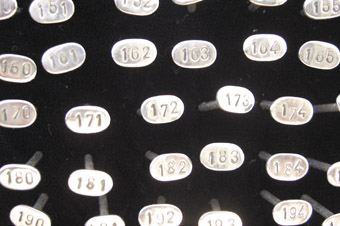
ft – Barbara Campbell, tongue studs for 1001 nights cast (detail), sterling silver, each 0.4 x 0.8 x 2 cm, 2007
photo Barbara Campbell
ft – Barbara Campbell, tongue studs for 1001 nights cast (detail), sterling silver, each 0.4 x 0.8 x 2 cm, 2007
Though appearing on a flat screen, the fleshly proof of Campbell’s survival was provocatively that of a threshold opening onto her body’s interior. The audience for the final performance at CarriageWorks viewed the video magnified to spectacular proportions, as though to dramatise the playful excess of fears and desires, words and images that the project had garnered up to that occasion.
The foregrounding of the mouth as a visual focus emphasised that, from its inception, the logic of 1001 nights cast was existential—a matter of turning and returning attention to subjective, interior experience. This logic is invoked by the website’s explicit reference to the legendary figure of Scheherazade, the Arabic woman who gains a reprieve from death by nightly weaving spells of stories that demonstrate the variety and complexity of the human condition. A similar logic—though, in Campbell’s case, of reprieve from mourning—can be inferred from the website introduction: “In a faraway land a gentle man dies. His bride is bereft. She travels across continents looking for a reason to keep living. Every night at sunset she is greeted by a stranger who gives her a story to heal her heart and continue with her journey” (http://1001.net.au/).
Hence for its 1001 nights Campbell’s project was essentially premised on the space of the body-mind, and on a question about being and time, a question that might now be risked outright, rather than enacted and displaced into allusion: ‘how does the time of the everyday lifeworld relate to the time of emotional pain?’ Yet even as it reinterprets Scheherazade’s wise and clever recourse to ‘a talking cure’, the 1001 nights cast was never detatched from circumstances of the contemporary lifeworld—or at least from meanings given to these circumstances by published journalism on the Middle East situation. Through the prompts and their sources the project’s motivating question has always carried collective, societal implications; it has always considered, therefore, the time of everyday lifeworlds that are beset by violence, conflict, political rupture and uncertainty.
Ritual, and collaborative preparation for ritual were Campbell’s modes of interrogation. Paradoxically these were also the project’s means of domesticating its existential bias, which was each day ‘brought home’, and into untold homes, via the screens of personal computers. The webcast’s atmosphere of precarious intimacy; the imaginative and affective stimulus afforded by the prompts and stories, all proved profoundly resilient—as indeed did Barbara Campbell. Impressively so. Without doubt, I have been gratefully reassured by the sustained ritual of her performances.
Campbell felt highly accountable to her audiences, and particularly to those who wrote for her project. As the first and last of the 243 writers, she thoroughly empathised with the emotions produced by the fixed deadline each day, emotions which might easily range from euphoria—creative freefall—to severe anxiety. By her own account, this empathy was heightened on the date of her final performance: she later described the episode in a group email to the project writers: “After six hours of narrative struggle I had nine documents open with half-formed ideas and bits of nothingness. At 4pm (before a sunset time of 7.10pm) I threw it all away and channelled you all into a structure that was robust enough to handle everything I wanted to say…I had just enough time to shower, change and taxi to the theatre to make it to the 6.30pm tech run.”
An audience of 100 writers and supporters had gathered at CarriageWorks, and Campbell appeared in a smart green dress, a dress the colour of an unmown lawn after steady rain. This green seemed chosen to represent a state of vibrancy, flourishing renewal.
Campbell’s unrehearsed solution to the challenge of the ‘1001st night’ was to reiterate the prompt and closing lines of stories already archived on the project website. Using a compact, antiphonal form, she paid tribute to the collaborative momentum of the 1001 nights cast, and tested—if such a test were needed—the generative potential of that which would formally outlast the two-and-three-quarter years or so of her performance practice.
Barbara Campbell has confirmed that the 1001 nights cast website “will remain up for the forseeable future.” One-thousand-and-one prompts can be found neatly stacked under the heading “Search the Archive.” They are rendered in jewel-like shades of watercolour. Arrayed with them are links to the stories that Campbell first performed, and the stories’ opening lines. This is a veritable treasure-house of images.
Unlike the contents of my own boxes and bags through the past two-and-three-quarter years or so, this stuff of manifold histories will always be buoyant—stored weightlessly, for sorting as a swift and weightless act. A hushed unpacking will surely yield appreciation of the critical relationship between improvisation and survival.
Barbara Campbell, night 1001 live webcast; Performance Space, CarriageWorks, Sydney, March 17, http://1001.net.au/
RealTime issue #86 Aug-Sept 2008 pg. 28
© Cynthia Troup; for permission to reproduce apply to realtime@realtimearts.net
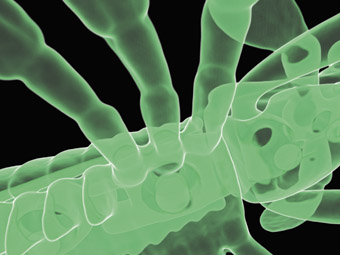
Erica Seccombe, Nanoplastica (2008), video still
THE HISTORY OF SCIENCE HAS BEEN IN LARGE PART THE REVEALING OF THE UNSEEN, WHETHER IN PERCEIVING, IN THE VISIBLE WORLD, STRUCTURES ELUCIDATED BY CATEGORISATION AND ANALYSIS, OR BY USING PROSTHESES (THE MICROSCOPE AND ITS ELECTRONIC DESCENDENTS) TO SEE WHAT WE HAD ONLY EVER GUESSED AT (ATOMS, ELECTRONS, NEUTRONS, PROTONS, MAYBE QUARKS). IN THE ERA OF BIOMIMCRY WE LOOK AT HOW NATURE WORKS IN ORDER TO SEE HOW WE MIGHT BENEFIT. FOR EXAMPLE, TERMITE MOUND AIR-CONDITIONING HAS LESSONS FOR REDUCED CARBON PRODUCTION IN BUILDING DESIGN. HOWEVER, CANBERRA ARTIST ERICA SECCOMBE, MIMICKING SCIENTIFIC INVESTIGATION, OFFERS US A DEEP LOOK NOT INTO NATURE BUT, REVEALINGLY, INTO MAN MADE TRIVIA.
The three large digital projections in Nanoplastica evoke a visual voyage into the innards of the tiny, semi-transparent invertebrates that populate the great oceans and the human gut, as we’ve seen on countless television documentaries. But Seccombe’s creatures are something else—plastic toy animals, poor mimickings of nature found in chocolate packs for children.
In a residency at the ANU Research School of Physical Sciences and Engineering, Dr Tim Senden X-rayed the toys for the artist on the Microcomputed Tomograph (XTC). As CCAS director David Broker reports in his catalogue essay: “In conjunction with the XTC facility, Dr Ajay Limaye, from the ANU Super Computer Facility and Vizlab…custom designed a high resolution 3D volume rendering program called Drishti that enables researchers to interpret their micro X-ray data visually. Under his instruction Seccombe has learned to use this technology independently. Nanoplastica…enables the viewer to see inside the replica’s tiny interior structures, manipulate its density and rotate volume 360 degrees in a virtual space. It’s actually hard to believe one’s eyes as the edited visual record of the process presents this most miserable of subjects in the dazzling lights of astonishing beauty.”
For Broker, “Seccombe’s deliberate use of novelty consumer items in conjunction with state-of-the art technology generates an interesting collision of popular culture with elite artistic and scientific pursuits. Though the starting point may be considered frivolous, this is work that reaches beyond Pop, crossing into the science/art paradigm, ultimately including new media experimentation.” For the viewer, the immediate surprise comes from the artist’s deployment of hi-tech equipment to reveal just how natural synthetic creation can appear under the microscope—but, after all, human beings and their animal kin simply rearrange molecules and atoms to make all kinds of things. Nothing is, perhaps, too far from nature, certainly not in Erica Seccombe’s Nanoplastica. RT
Erica Seccombe, Nanoplastica, CCAS, Canberra, May 24-July 5
RealTime issue #86 Aug-Sept 2008 pg. 29
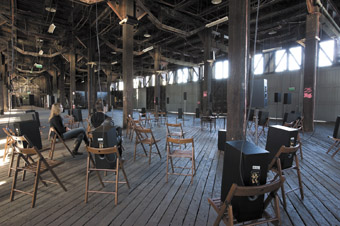
Janet Cardiff and George Bures Miller, The Murder of Crows
photo Jenni Carter
Janet Cardiff and George Bures Miller, The Murder of Crows
EXPERIENCING SYDNEY THROUGH THE FILTER OF THE 2008 BIENNALE, IT SEEMS AS THOUGH THE CORPORATE CHARACTER OF THE CITY IS CHANGING: EMBRACING AND CELEBRATING THE CHARACTERFUL GRUNGE OF HISTORIC INDUSTRIAL SITES RATHER THAN BULLDOZING AND SWEEPING ALL REMNANTS AWAY FOR MORE DESIGNER APARTMENTS. ALONG WITH THE STANDARD GALLERY VENUES OF THE MCA, ART GALLERY OF NSW AND ARTSPACE, THE 2008 BIENNALE OF SYDNEY HAS ONCE AGAIN SECURED PIER 2/3 (UNDER SIEGE FROM EXPENSIVE RESTAURANTS BUT STILL A GLORIOUS DRAFTY SHELL OF A WAREHOUSE) AND ALSO ADDED THE WONDERFUL CRUMBLING INDUSTRIAL PLAYGROUND OF COCKATOO ISLAND.
The Biennale seems even more abundant than usual with over 150 artists contributing, but at Wharf 2/3 we are offered a succinct selection of 3 works, allowing for focused, unpressured contemplation. The first piece consists of reproductions of some of Futurist Luigi Russolo’s Intonarumori (Italy), but they are frustratingly silent—like pictures in books. What do these things sound like, and how do they work? While the intention to illustrate the origins of sound art and exploratory music is clear, the inclusion of these inert replicas feels like a hollow educational gesture.
Any discontent quickly dissolves viewing the mesmerising untitled painting by Doreen Reid Nakamarra (Australia). Placed horizontally just off the ground, to be viewed from above, the rivers of intricate dots make the work pulsate and strobe before your eyes. Adjusting you begin to see the illusion of three-dimensional sculpted peaks and troughs of hills and valleys, based on the landscape around the Pollock Hills area in Western Australia, home of the Marrapinti people. Though two dimensional, it is far from inert and absolutely dazzling.
The rest of the cavernous space is given over to The Murder of Crows (2008, Canada) a massive sound installation by Janet Cardiff and George Bures Miller. Although the intention is to foreground sound over sight, it is certainly visually impressive. Ninety-nine speakers are distributed around the space—on the floor, in the ceiling and placed on some of the chairs arranged in a circle. These are centred around one large old-style gramophone horn, from which Cardiff’s own voice emanates, quietly recalling disturbing scenes from her dreams. Cardiff’s narrative is interspersed with soundscapes and orchestral and choral compositions in which each instrument or voice is delivered by an individual speaker. Initially I am sceptical—100 speakers is rather excessive (even the idea of the artists’ 40 Part Motet seemed decadent)—and the assignment of one speaker per sonic element is quite literal, a kind of long-hand methodology considering the complex developments in spatialisation such as wave field synthesis. But as I hear the string section of an orchestra start up instrument by instrument enveloping me in a sphere of soaring song, or hear the individual voices of a Russian marching chorus approaching, or the wingbeat of a swooping crow pound the air above me, I cannot help but give over to the sonic wonder—it’s a spectacularly immersive experience.
The 30-minute work, is described as a soundplay, and is reminiscent of a particular style of radiophonic feature. The dreamscape offered in the narrative is engaging and dark, yet the compositions retain a gentler melancholy tone traversing a range of musical styles from contemporary classical, post-rock to pop-folk. While the music is neatly sutured together with evocative soundscapes to form a shifting dreamland, the use of so many styles occasionally felt like the 100 speaker system was a demonstration model being put through its paces. That aside, it was undeniably a listening feast.
A very pleasant free ferry ride whisks you across to Cockatoo Island, which offers too many works to absorb in just one outing. In some incredible victory of common sense over the stultifying strictures of public liability, works are installed in dusty warehouses with creaky staircases and uneven floor surfaces, amongst bits and pieces of defunct machinery. And the works thrive in this environment. Australian Mike Parr’s retrospective Mirror/Arse feels truly fetid and dangerously infectious installed in room upon room of the old Sailors’ Home. Videos are secreted in claustrophobic spaces, with speakers further spread, making the whole building quake with moans, shouts and cries from the various tortures Parr has inflicted on himself over the years.
On a far point of the island in an old fuel storage tank is Nalini Malani’s ‘The tables have turned,’ A Shadow Play (2008, Pakistan/India). Animals, objects and scenes are painted on cylinders of acetate, which are placed on revolving turntables with a collection of coloured lights scattered around the floor. The colliding shadows are reminiscent of rock paintings and shaman magic, and the curved wall of the tank offers a perverse replication of a cave. But the work is sadly diminished by the sonic element of a radio drama voice telling tales of Helen of Troy which bounces around the reverberant walls. Sean Gladwell’s Ghost Rider (Australia, 2008), is another work which looks better than it sounds. Accompanying the poetic video of cyclists travelling down empty streets late at night and releasing their trusted bicycles to their own trajectories (‘ghosties’), were two rows of bikes mounted at shoulder height, emitting tiny sounds (run by large amplifiers), creating an indifferent haze of buzzing, burring and humming. There was something overly fussy about the sound installation which failed to really resonate the bike frames and the work as a whole.
In the centre of the Turbine Hall is the ultimate soundscape of the Biennale. Standing amidst Jannis Kounellis’ architectural, overlapping sails strung from floor to ceiling like a web, the caw and squawk of Cockatoo Island’s seagull population accompanies the strains of the Internationale emanating from Susan Philipsz’ single speaker tucked in amongst ancient machinery (UK/Germany, 1999). While perhaps an obvious gesture given the theme of revolution, the melancholy irony of Philipsz choice is undeniably effective. Then there is the roar of truck engines and the harmonically surprising roundelay of horns floating out of the small machinery room which houses Chen Xiaoyun’s video work : A Mythical Wild Animal–Symbol of Durance (China, 2008). The artist stands in the centre of circling trucks and with frenzied fervour, whip in hand, tries to corral them—is it mastery of man over machine or tragic futility? Set in a muddy wasteland at night, this is a curiously beautiful work, the shooting angles and choreography of bright blue trucks suggesting a kind of contemporary baroque reminiscent of Matthew Barney.
The rich soundscape of the Turbine Hall exemplified what I found most satisfying about these components of 2008 Biennale of Sydney. There is a cohesive sense in Carolyn Christov-Bakargiev’s curation of the desire to explore the relationship between things—how works rub up against each other, infect each other with new meaning. This is evidenced in the inclusion of historic works (with varying degrees of success), but is most strongly manifest in the way works resonate with their sites—how they are part of their surroundings—in the real world.
2008 Biennale of Sydney, Artistic Director Carolyn Christov-Bakargiev,
June 18-Sept 7
RealTime issue #86 Aug-Sept 2008 pg. 30
© Gail Priest; for permission to reproduce apply to realtime@realtimearts.net
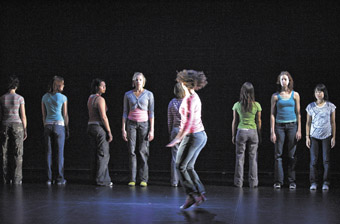
LINK Dance Company Production, Oscillate, Mountains Never Meet, choreographed by Martin del Amo
photo Jon Green
LINK Dance Company Production, Oscillate, Mountains Never Meet, choreographed by Martin del Amo
DANCE GRADUATES FROM AUSTRALIA’S TERTIARY COURSES ARE POSSIBLY MORE PREPARED THAN THEY HAVE EVER BEEN FOR THE REALITIES OF THE WORKING WORLD. TERTIARY COURSE LEADERS, DRIVEN BY EVER TIGHTER BUREAUCRATIC RESTRICTIONS, ARE FOCUSED UPON DELIVERING STRONG EMPLOYMENT STATISTICS AND INDUSTRY STAKEHOLDERS, SUCH AS FUNDERS, COMPANIES AND CHOREOGRAPHIC CENTRES, ARE KEEN TO CHANNEL YOUNG TALENT INTO A DIVERSITY OF CAREERS.
waapa
All the major institutions share a focus on improving the interface with the professional world. At Edith Cowan University’s Western Australian Academy of Performing Arts (WAAPA) Nanette Hassall, coordinator and senior lecturer, says, “We have tried to develop a number of different ‘pathways’ for students beyond graduation. We spend considerable time in the last year of both Diploma and BA courses to facilitate transition. In the BA there are opportunities for performance overseas and third years take secondments and industry placements here and overseas. Related classes examine the industry in Australia and specific opportunities for graduates. Students choreograph a public season and work with media students to produce a high quality online bio. There are units in both courses that cover dance teaching methods. Units enable students, with some additional training, to engage in allied health areas, particularly yoga and Pilates. BA students can move directly or at a later stage into the one year Graduate Diploma of Education at Edith Cowan University.”
qut
This focus upon a diversity of career outcomes is common, with strong results for non-performance careers. At Queensland University of Technology (QUT), discipline leader Shaaron Boughen says, “We have a very good rate of success in placing our dance education graduates: 95-100%. Performance focused students can take at least 12 months to transition into full time work. The percentage fluctuates from 60-75% going into performance jobs, 15-20% into postgraduate study and the remainder into private studio teaching and other areas of the industry. Our 2008 intake into the Dance Education strand of the Bachelor of Fine Arts is the first year to experience training for three years in a vocationally focused dance degree. We have increased performance opportunities for our Education students and offer a broader range of dance genre and style training to better prepare them for dance teaching in high schools. Their curriculum studies are offered intensively in a fourth year as a Graduate Diploma. We are always updating and adjusting our course offerings in response to industry and student needs.”
Reinforcing this emphasis on diversity, Julie Dyson, National Director of Ausdance, noticed upon a recent visit to Queensland, “QUT dance graduates working as social workers and in police departments.”
vca
At Melbourne’s Victorian College of the Arts (VCA), head of school Jenny Kinder says, “VCA students are supported in a variety of ways to face the inevitable uncertainties of a dance career. Recent curriculum changes have focused on career sustainability. Subjects such as Performance Management include improved training strategies which embrace dance science as well as performance psychology, injury prevention and management. A huge advantage for VCA students is the vibrant Melbourne dance scene and the involvement of practicing dance artists such Rebecca Hilton, Phillip Adams, Carlee Mellow, Gerard Van Dyck, Linda Sastradipradja as teachers and/or choreographers in the program. Bedrocks, a VCA-wide transition program, assists graduating students to kick start their careers as independent artists. Graduating dance students are also supported through ongoing training in their first year out.”
adelaide centre for the arts
The incorporation of practicing professionals into the teaching cadre is a strength of institutions where the focus is upon performance. Sally Collard-Gentle at Adelaide’s Centre for the Arts, says, “The Bachelor of Dance Performance trains dancers for a wide range of settings, including theatre, independent production, film and television industries. The thrust is professional training with dance industry elite choreographers. Teaching staff are sourced from national and international dance companies and have a minimum of seven years professional experience. Industry plays an active part in the evaluation of technique, training and production performance.”
link dance company
The last word in preparation for a performance career in Australia is WAAPA’s LINK dance company, which simulates the professional performance career within the university setting and includes dancers from most of the national undergraduate courses. Michael Whaites, Artistic Director of LINK says, “All 2007 dancers from LINK are currently working in the industry. I am constantly seeking new ways to give the dancers real experiences in the industry and the confidence to steer their careers proactively. Two initiatives for 2008 extend our scope. The dancer in residence program employs an experienced professional dancer to join the company for a season. Students observe real world studio practice, extend their networks and discuss the realities of being a freelance artist. The Room To Move project offers local choreographers space and time with the company to research and develop ideas without production pressure. In 2008 we are working with nine choreographers. We are about to do a workshop in Amsterdam, a residency at Rosas in Brussels, perform at Laban in London, and possibly in Berlin.”
ql2
Outside the universities, institutions such as QL2, the former Choreographic Centre in Canberra, have a range of projects for graduates and graduating students. Soft Landing is an annual program preparing graduates for professional practice. In 2007 Solon Ulbrich worked with 11 graduates to produce a showing in the theatre and a forum with audiences. Soft Landing 2 in 2009 will culminate in a site specific season with choreographer Brian Lucas at the National Gallery of Australia.
QL2 also offers the On Course program for current tertiary students, primarily ex-Quantum Leap youth group members, to develop their choreographic ideas in a supportive environment and present work to Canberra audiences. In their Visiting Dancer program, tertiary students and interstate dancers work in a QL2 project and secondments enable students to join Quantum Leap projects in supporting roles.
dancehouse
At Melbourne’s Dancehouse there are a range of opportunities for graduates, including the annual open presentation season, Coming Out! and Learning Curve, the mentoring residency that gives graduates the opportunity to work with an established choreographer. In 2008 15 graduates worked with Russell Dumas and Dancehouse is currently considering opening the program up to include a mix of graduates with established and mid-career artists. Dancehouse also offers Summer, Winter and Spring Training Intensives, two weeks of classes for professional and advanced dancers, which include recent graduates.
ausdance
Ausdance offices around Australia engage with graduating dancers in space initiatives, presentation platforms and projects such as Dance Week. Ausdance works with the Tertiary Dance Council of Australia to present the biennial Options festival of career options for graduates and last year facilitated a joint meeting between the Tertiary Dance Council of Australia (TDCA) and artistic directors to encourage dialogue and joint projects.
company support
Regularly funded contemporary dance companies offer a range of secondments to graduating students. Lucy Guerin Inc and Force Majeure accommodate around 30 per annum, Chunky Move between 50 and 60. Generally companies report positive experiences. Larger institutions such as WA Ballet with its Young Dancer program encourage young talent but emphasise the dwindling number of full-time dancer positions and the growth of the independent sector. While many course leaders cite prestigious alumni lists in companies across Australia and internationally, there is another trend in the opposite direction, which finds mid-career and mature artists returning to university to acquire new skills to supplement their performance and choreographic careers.
a creative australia
On a positive note, A Creative Australia, the Rudd Government’s new $6.6 million fund for young and emerging artists, supports companies to offset the income that would otherwise be earned from presenting better known or more commercial works; projects that support young and emerging artists in developing professional skills, expertise and networking; and projects that engage young artists and audiences.
RealTime issue #86 Aug-Sept 2008 pg. 31
© Sophie Travers; for permission to reproduce apply to realtime@realtimearts.net
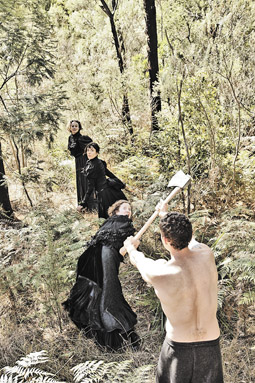
Axeman Lullaby
photo Jeff Busby
Axeman Lullaby
TEN YEARS OLD, MELBOURNE’S BALLETLAB OPERATES ON A PORTFOLIO OF STATE AND FEDERAL PROJECT FUNDING ARRANGEMENTS, USING UP AND WEARING OUT PRODUCING STAFF THROUGH A RELENTLESSLY AMBITIOUS SCHEDULE OF CREATION AND PRESENTATION. ARTISTIC DIRECTOR PHILLIP ADAMS SEES 2009 AS A POSSIBLE NEW ERA OF STABILITY FOR THE COMPANY. CHARACTERISTICALLY POSITIVE, HE RATTLES OFF A LIST OF INDICATIONS OF THE COMPANY’S GOOD ARTISTIC AND ORGANISATIONAL HEALTH. EXECUTIVE PRODUCER MATT MORSE HIT THE GROUND RUNNING AT THE PRESENTATION STAGE OF ADAMS’ PREVIOUS WORK, BRINDABELLA, EIGHT MONTHS PREVIOUSLY. WITH A NEW WORK, AXEMAN LULLABY, ABOUT TO OPEN, A EUROPEAN TOUR FOR BRINDABELLA IN 2009 AND AN INTERNATIONAL RESIDENCY TO CREATE ANOTHER WORK IN NOVEMBER THIS YEAR, ADAMS HAS GROUNDS FOR GOOD CHEER.
BalletLab is positioning Axeman Lullaby in a ‘suite’ of productions which will target a range of markets and continue to tour while the company prepares a major commission in 2010 to mark the opening of The Museum of Old and New Art in Tasmania. The company’s sponsorship relationship with Moorilla (its winery and museum), has led to this extraordinary opportunity to create a promenade performance of scale. Details are not forthcoming, as Adams is sworn to a secrecy he finds hard to contain.
Following a subdued response to Origami in 2006, Adams created Brindabella in 2007. He is delighted with its resonance with audiences at the sell-out Melbourne season and with European presenters. The collaboration with American choreographer, Miguel Guiterrez, created a bacchanalia of thrilling moments, veering dangerously close to chaos but contained with the coherence of composer David Chisholm’s delightful score. Adams says, “Working with Miguel opened me up to so many things.” He is excited about how this experience inspires Miracle, the piece to follow Axeman, which presents a trio of new works from Adams, Rebecca Hilton and John Jasperse.
“Miracle is entrenched within the US market through John”, Adams explains. “Brindabella is opening up Europe for us finally, and Axeman will do the same for the regions here.” Never one to underestimate his audiences, Adams has complete faith that Axeman’s themes will resonate in the regions. He goes on to link Axeman to Brindabella as “an exploration of masculinity and Australian suburban gothic. The compelling image of the axeman’s blows is overtly sexual, violent and unsettling. Located in the Australian bush but closely linked to suburban life, the axeman represents the horror lurking just beyond the back fence.”
Adams showed me Axeman’s strikingly cinematic marketing materials. He cites months of research into the Australian cinema of the 70s and 80s, such as The Last Wave, Walkabout and Razorback. “These films offered me an eerie portrayal of our past and an unsettled vision of our future. I am fascinated by the melodramatic figure of the axeman in regional Australian life.” Adams says, “All Australians have a relationship with him, whether through actually knowing someone who still takes part in these competitions, or through television, the Easter show…In this production, there are three women and one male dancer circling the overtly masculine axeman who will be played by real life woodcutter Lawrence O’Toole. I was inspired by Thomas Kenneally’s novel, The Chant of Jimmie Blacksmith, which made a huge impression upon me in my youth. The image of the blackfella slicing up the women in the shed towards the close of the Fred Schepisis film has stayed with me forever.”
For Axeman Lullaby, Adams’ list of collaborators is shorter than in previous productions (in Origami BalletLab explored a collaboration with architectural firm BURO to create an extraordinary folding set). Adams puts that down to, “my growing confidence in my choreography in relation to the visual arts.” While not formally trained in visual arts, Adams has consistently contributed to the scenography and costuming of his productions and has nurtured a distinctive personal aesthetic from an early age. His interest in the creation of a strong visual context for his productions is an area to which he dedicates extensive research. For Axeman, Adams visited a wood-chopping competition in Bairnsdale, regional Victoria. He documented the stories of the wood-cutters and their families on film and brought hundreds of off-cuts of wood back to his studio. “I have created a Rosalie Gascoigne floor”, Adams says, elaborating how he will assemble the timber into a projection surface.
In all three works of his suite, Adams will collaborate with David Chisholm, the Melbourne based composer with whom he shares a taste for experimentation. Adams is thrilled with the “high modernism” of Chisholm’s composition for Duo Sol in Axeman. Playing live, the violinist and pianist will “literally tear their instruments apart.”
While Adams admits that Chisholm’s music is core to the drama of his work, he recognises that touring with live musicians is not always possible. In Miracle, Chisholm’s score will be created and recorded in the US with the leading International Contemporary Ensemble (ICE), but it will not tour.
In Miracle, it’s the technology which will pose the challenge. Media artist Cazerine Barry will travel with the company to the Experimental Media and Performing Arts Centre (EMPAC) in Rensselaer, New York. The work BalletLab presents alongside Hilton and Jasperse’s creations there is already pushing Adams into hyperbole.
When I suggest that such challenging propositions cannot make life easy, Adams is quick to respond: “I feel increasingly comfortable with the role we play nationally. I do not want to play it safe. It’s about questioning, storytelling and open-mindedness.” He states with arresting clarity, “It’s not about getting more sophisticated or more mature; that has happened over time in what I am creating. I am just getting more responsible for what it is that I narrate to the world through my art.”
Read a review of Axeman Lullaby in RealTime 87.
BalletLab, Axeman Lullaby; Chunky Move Studios, Melbourne, Aug 7-17,
www.balletlab.com/about/
RealTime issue #86 Aug-Sept 2008 pg. 32
© Sophie Travers; for permission to reproduce apply to realtime@realtimearts.net
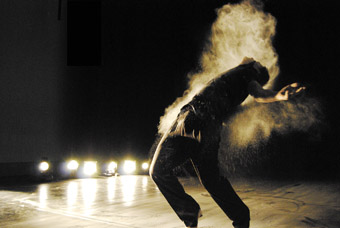
Joshua Thomson, Remember Me
photo Gavin Webber
Joshua Thomson, Remember Me
WITH THE STAGE SET AS A CLEANSWEPT COUNTRY HALL, A LIVE ‘BAND’ WARMING UP, DANCERS MILLING WITH THE FOLKS IN THE FRONT ROWS OF THE AUDIENCE AND A PLEASANT, EXPECTANT BUZZ, I WAS MOMENTARILY TRANSPORTED BACK TO MY CHILDHOOD, ATTEMPTING THE PRIDE OF ERIN WITH MY DAD AT THE TARADALE HALL AND EAGERLY AWAITING HOMEMADE BUTTERFLY CAKES AT SUPPER. BUT DANCENORTH WAS JUST SOFTENING ITS AUDIENCE UP, GENIALLY INVITING US IN AND ENTRUSTING US WITH THE INTIMATE MINUTIAE OF THEIR OWN EARLY LIVES TO THE 3/4 TIME OF AN AIRY WALTZ BEFORE EXPLODING ANY EXPECTATIONS OF A SIMPLE SENTIMENTAL JOURNEY.
The Townsville based contemporary dance company’s latest offering, Remember Me, presented in collaboration with the Australian Festival of Chamber Music, further cements Dancenorth’s growing reputation for edgy and physical choreography, compelling narratives and willingness to incorporate a wide range of media into their performances. Composer Iain Grandage created the score for Remember Me after having worked with artistic director Gavin Webber on the dancenorth/Splintergroup production Lawn a couple of years ago, and was Webber’s first choice as composer for this project.
The concept for Remember Me was born from a chance encounter the company had when touring their earlier work, Underground, last year. Rehearsing at the historic World Theatre in Charters Towers, they followed the strains of music to find a group of sprightly 70-somethings enjoying an afternoon dance. Further enquiry revealed that this was a weekly ritual, a communal sharing of activity, afternoon tea and husbands: as Shirley explains during Remember Me, wives loan their men to the widowed ladies, “…at the dances, that is!”
Choreography and score for Remember Me were developed during several improvisational blocks involving the whole company. The trust between Webber and Grandage is evident in the final product: it is impossible to distinguish if the dancers are responding to the quartet of musicians or vice versa, and in some passages, the complicity is astonishing. Miki Tsunoda’s plaintive violin and percussonist Ian Brunskill’s flatlining wineglass accompany dancer Hsin-Ju Chiu’s memories of her brother. She apparently explains their games in Chinese as she puts a helmeted and somnambulent Matthew Cornell through a series of extraordinary manipulations which fall somewhere between a balancing act from a Chinese circus and pure sibling torture. Cornell’s core strength makes the complex moves appear completely involuntary, truly at Hsin-Ju’s mercy.
Josh Thompson and Kate Harman initiate another poetic sequence which begins with lagging mimicry of small gestures, becoming larger and larger, the lead and the mimic constantly swapping roles, to a soundscape of dreamy strings. They are gradually joined by Kyle Page and Alice Hinde, then Hsin-Ju and Cornell, and finally Sarah-Jayne Howard. Patterns formed by curtains, window frames and weatherboards fill the ‘walls’ (huge video screens) while the dancers move like falling dominoes in response to one another’s gestures, right down to the exhalation of breath, one after the other. Thompson and Hinde take it even further with a duo of dancer and shadow, one upright, one on the floor, seamlessly changing places and mirroring expressions, every gesture melding precisely to the music.
The screens periodically fill with footage of the Charters Towers’ social dancers telling us their lives. They appear chirpy, optimistic and grateful, though Webber’s intuitive editing poignantly hints at lost loves and lives (the long shot of an empty couch, for instance).
The audience gets to meet the social dancers in the flesh after the interval, as Gary the MC announces a jive and sets off another round of introductions, adding incidental details. The genteel dancehall ambience, the mingling of young and old dancers, lasts just long enough to warm and lull us before the social dancers retire, and the dance dissipates into a frantic sequence of panic and burnout culminating with an increasingly violent Harman kicking the inert Thompson across the floor, screaming at him to “get the fuck up.”
Breathing hard, Harman takes to the mike to deliver a soliloquy about love, loss and memory, asking us only to remember her if we can deal with what we see. The dancers line up each holding a framed picture of themselves as children as the screens fill with faded pictures of the social dancers in their prime.
In semi darkness Hsin-Ju helps Thompson dress, like an elderly couple assisting one another. They lie down on the floor in an embrace and Page, the youngest, arrives to cover them with dust. Kirsty McCahon’s double bass and Grandage’s cello reverberate ominously as we witness this burial, this scattering of ashes. The dancers rise, breathing out puffs of dust, and their imprints
remain like an accident outline. The others return to daub one another, shaking off layers and
laying down more dust until they are all ghosts, floating and crumbling, falling and flailing, creating fog and patterns of increasing complexity on the floor.
The dancers spin on the floor, digging their own graves, as an old face and hand appear on the screen. Page and Harman repeat a haunting pattern of approach and retreat, macabre memories of love and desire, until Page is alone and all we hear is his failing breath and a bell tolling.
Dancenorth, Remember Me, director Gavin Webber, musical direction, original composition Iain Grandage, choreography Gavin Webber and dancers Sarah-Jayne Howard , Grayson Millwood, performers: Hsin-Ju Chiu, Matthew Cornell, Kate Harman, Alice Hinde, Sarah-Jayne Howard, Kyle Page, Joshua Thompson, lighting design Ben Cisterne, Bluebottle, sound design Luke Smiles, costume design Sarah Jobling; Dancenorth Theatre, Townsville July 8-13 www.dancenorth.com.au
RealTime issue #86 Aug-Sept 2008 pg. 33
© Bernadette Ashley; for permission to reproduce apply to realtime@realtimearts.net
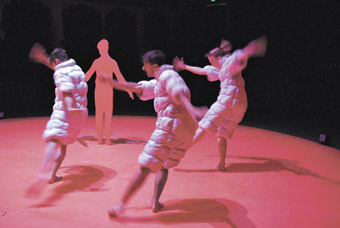
Tim Harvey, Luke George, Jo Lloyd, Apparenty that’s what happened
photo Rohan Young
Tim Harvey, Luke George, Jo Lloyd, Apparenty that’s what happened
THE TITLE, GIRLS ON BOYS, EVOKES THAT NOTION THAT CHOREOGRAPHERS MAKE WORK ‘ON’ DANCERS. IT’S A RELIC OF THE BALLETIC IDEA THAT (MALE) CHOREOGRAPHERS MAKE WORK ON (FEMALE) DANCERS. THE CHOREOGRAPHER-DANCER DUO PARALLELS OTHER BINARIES, MIND-MATTER, NATURE-NURTURE, MALE-FEMALE. THE GENDERED REVERSAL—GIRLS ON BOYS— NEVERTHELESS RETAINS THE IDEA THAT CHOREOGRAPHY IS SOMETHING THAT IS APPLIED TO THE DANCER, HERE, THE MALE PERFORMER.
The concept of Girls on Boys was developed by Gülsen Özer, who selected five female choreographers who in turn produced five short dance pieces, each made with a male dancer. The first piece, I think it’s my birthday, was made by Yumi Umiumare ‘on’ Gerard Veltre. Butoh-influenced, the performance consisted of a slightly comic, ordinary set of moves. A clown of the everyday, Veltre exhibited a muscularity evocative of the gym. Sometimes staccato, distorted or drawing on mime, he used clothes to mark different sections of the work. The last construction was a kind of crop circle formed out of disbanded items. Placing himself in the middle, he concluded the piece by singing Happy Birthday to himself in a head-stand. There was a sense here of Umiumare’s taking the performer where she found him, enlarging the amplitude of his everyday performance qualities and ‘turning up the volume’ as a means to bring the piece into the theatre.
Dani-Ela Kayler’s piece for Lee Serle, titled Lady Purple, did not depart from the mundane, if comprising some rather odd movement qualities. The program notes clarified the character of movement here, referring to a puppet master and his marionette. If Serle was the marionette, then Kayler was the puppet master, again evoking an instrumental sense of producing work on bodies. Serle’s movements, however, were not evacuated of life as the notion of the puppet might suggest. Rather, they were discombobulated—his head moving independently of the rest of his body; a broken-necked lizard. Legs were posed against torso; a pelvis rotated at odd angles; a limp wrist dangled. The face scanned the crowd, with an odd expression. Was this a person or a weird resemblance come to life?
Boy, from Jo Lloyd for Adam Wheeler, was a more rhythmic piece, formed out of a sustained simplicity. For most of the piece, Adam bounced on the floor, his body straight as a ramrod. The legs softened and pushed, softened and pushed. Deviations slowly emerged, a twist, a gesture, all couched within the rhythmic tenor of the piece. Dianne Heywood-Smith and David Backler created El Abrazo (The Embrace), situated within the world of ballroom dancing, turned solo. Although the work referred to tango, this singular dancer could only gesture towards an absent other, unable to share weight in the merging of bodies. There was a whimsical edge as the dancer revealed his yearning for a partner, while assuming the facade of masculine self-sufficiency. Finally, Dianne Reid and Luke Hickmott gave us Magnificent Sadness, physically more complex than the other pieces. Led by different body parts moving into and out of the floor, Hickmott covered the floor in a way in which the other pieces did not, engaging in a range of movement qualities. The pace of his execution, the density of muscular tone, the sense of tension, and breadth of focus varied, as well as the way in which space was covered added a depth to this short piece.
All the pieces acknowledged the placement of audience, each in their own way, in a square around the action Umiumare more or less made a spiral, ending in the middle, Kaylor worked the sides of the square, Lloyd zigzagged the space, while Heywood-Smith forged a long slash across the middle. Finally, Reid navigated the space in all three-dimensions.
It was interesting to reflect upon a series of pieces involving men as performers, with no women onstage, also to speculate on the transfer of movement from a woman to a man. The brevity of each piece, including their development process, kept the work as a series of vignettes, enacting the concept of choreography on a body, inflected by an unusual a-gender.
Jo Lloyd’s new work, Apparently that’s what happened, at Art House’s Meat Market, was also performed in the round. The space of the performance was interspersed by a series of wooden cutouts, silhouettes resembling the three performers, caught in the headlights in stark poses. As the piece progressed, each of the three performers extracted a silhouette and lay it down in a same-shaped space on the floor, completing the jigsaw. Given the theme of the piece, the smoothing over of the floor, by filling its gaps, may have represented an accumulation of sense. The piece itself aimed to address the perspectival nature of experience, its incompletion from the point of view of subjectivity.
An event has occurred; but who has a god’s eye view? Each of the performers, partly obscured by the standing silhouettes, articulated a certain perspective to music which seemed to break with the reality of everyday time. Solos, duets and, finally, repeated group movements suggested an achievement of accord not present in the earlier sections. In the finale, falling snow was projected onto a cavernous darkness, while performers in puffy snowsuits moved mesmerically, their repetitions slowly sweeping the room like a rotating radius.
The story moved from disjointed objects and solos to a series of interrelations amongst performers, towards some kind of sameness or group harmony. In seeking to open out the work’s focus on the limitations of individual perspective, the stage design amplified this state, obscuring the audience’s visual sweep with its cutout figures. As the work progressed, individual viewpoints were brought into relation with other perspectives, to a final sense of belonging. I wonder whether the group identity at the end was something beyond the human or was meant to stay in the realm of the mundane? Is it ever possible to encapsulate the whole story? Not from this perspective.
Girls on Boys, curator Gülsen Özer, choreographers/performers Yumi Umiumare/Gerard Veltre; Dani-Ela Kaylor/Lee Serle; Jo Lloyd/ Adam Wheeler; Dianne Heywood-Smith/David Backler, Dianne Reid/Luke Hickmott, music Wendy Morrison, Dancehouse, Melbourne, May 28-June 1; Apparently that’s what happened, choreographer Jo Lloyd, performers Jo Lloyd, Luke George, Tim Harvey, design Jenny Hector, music Duane Morrison, David Franzke, Arts House, Meat Market, Melbourne, June 25-29
RealTime issue #86 Aug-Sept 2008 pg. 34
© Philipa Rothfield; for permission to reproduce apply to realtime@realtimearts.net
LIKE DAVID PLEDGER OF MELBOURNE’S NOT YET IT’S DIFFICULT, PERTH’S AIMEE SMITH HAS BEEN DEVELOPING AN ABIDING INTEREST IN MEDIATED AND POLITICISED BODIES; IN BODIES TORN AND TWISTED BY WAR TALK, OR BOXED IN AND ENERGISED BY TELEVISUAL EXCESS. AS PART OF STRUT DANCE’S PRIME CUT, SMITH PRESENTED BREAKING, ARGUABLY HER MOST FORMALLY RIGOROUS AND STRIPPED BACK VERSION OF THIS AESTHETIC.
Though ostensibly much lighter, Jonathan Buckels’ gorgeously ridiculous piece, Solo, had a subliminal sting in its tale too. Two men waited silently at a bar playing abstruse and highly repetitive games with beer coasters—just long enough to lead one to think that Solo might be a durational performance art work (a development I would have welcomed). After the audience passed from boredom to curiosity to meditation, a smart young woman (Rhiannon Spratling) entered, accompanied by vibrant music, walked past, completely indifferent to the pair’s antics or even their presence. After a series of competitive and pointless interactions between the two (including one where the hapless Rob Griffin attempted to sleep as Buckels dripped beer on him), the pair devised ways to arrest Spratling’s interest, finally engaging in wonderfully stupid popular dance sequences with her. Here too, masculine insufficiency was writ large, neither man really able to offer the woman much by way of genuine interaction.
Finally, Griffin dragged on a trunk from which emerged a thin, vivaciously over-the-top, rollerskater (Stephen Rogers), whose grinning, camp choreography eclipsed the pair as we moved to masculinity as a kind of day-glow performance. As artists such as rapper P.Diddy or Japanese conceptual artist Ujino Muneteru have put it, this is masculinity as “fabulousness” or “gorgeousness.” This performance unsurprisingly forces our protagonists to return to their impotent attempts at amusing themselves, alone, discarded again by the female object of their affections whom they had hoped would verify the very masculinity which their minimal tedium is supposed to embody. Although superficially little more than a bunch of silly games, Solo had embedded within it a subtly devastating critique of masculinity.
The opening of Smith’s Breaking also suggested a performance art aesthetic. At the far right corner of the stage was clustered a pile of intermittently ‘out-of-tune’ television sets, switching between images of war, commerce and chaos in a delicate pulsing of multiples akin to Nam June Paik’s work. Smith stood at the extreme left foreground, tightly lit from above and behind in a manner that made her already muscular form even more sculptural and carved by grey-gold glows and shadows—a sharp embodiment further enhanced by the monochromatic form-fitting costume. To the shuddering textures of radiophonic hiss and wide plateaus of crinkling sound by Ryoji Ikeda, Smith moved within a limited but sharp articulation of shape and bony mechanics. Movement of the feet or change of stance was rare and stochastically performed when it did emerge. Smith largely remained intensely locked to her position as something akin to a sculptural unit within the space, rather than as a plastic, affective unit or more subjectively humanised dancer. One extended sequence in particular seemed almost to be performed stork-like, rigidly supported through the musculature of one leg.
This combination—the sparse yet complex sonic detailing of the Ikeda score, the minimalism of the movement combined with the strong physical demands to execute it, the tendency of the light to catch Smith in an almost Grecian profile of visible concentration on her own performance, and her interactive position within the mise en scène—converged to create an ambivalent sense of what political agency or condition this intersection of body, sound, screen, media and movement might suggest. Too archly beautiful (at least according to its own austere values) to represent oppression, yet too complex in terms of where the motivating power of authorship or control might be emanating from (artist? choreographer? body? media? capitalism? empire? military?) to generate a site of resistance or overt critique as such, Smith’s performance itself masterfully affected a form of mediation. In this sense, her pairing of body and television images encapsulated both the form and the content of the piece. Our broadcasting devices do not, in themselves, generate either positive or negative effects. They are vessels into and out of which material flows. Precisely whether Smith’s subjectivity is liberated or oppressed by this process is beside the point. Her performance realised this dynamic of exchange in forms fleshy, audiovisual, technologised and lyrical, all at once.
Strut Dance, Prime Cut, Breaking, choreographer, performer Aimee Smith; Solo, choreographer, performer Jonathan Buckels, performers Rob Griffin, Rhiannon Spratling, Steven Rogers; Preparing To Be Beautiful (Chapter Two), choreographer Alice Lee Holland; Confessional, choreographer Deborah Robertson; PICA, Perth, June 5-8
RealTime issue #86 Aug-Sept 2008 pg. 34
© Jonathan Marshall; for permission to reproduce apply to realtime@realtimearts.net
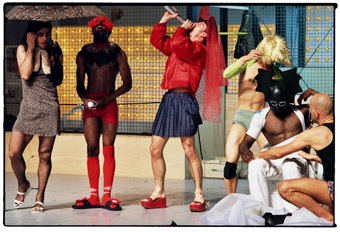
Les Ballets de Ci de La, Alain Platel
THE SCREENING PROGRAMS PRESENTED AS PART OF THIS YEAR’S REELDANCE FESTIVAL WERE GENERALLY STRONG AND, YET, ONE OF THEM CLEARLY STOOD OUT FOR ME: CONTEMPORARY DANCE ON SCREEN. A VERITABLE TREASURE TROVE FOR ANYONE INTERESTED IN CONTEMPORARY DANCE, IT BROUGHT TOGETHER THREE OF THE ART FORM’S BIGGEST NAMES: WILLIAM FORSYTHE, PINA BAUSCH AND LES BALLETS C DE LA B.
The program opened with One Flat Thing, Reproduced (Belgium/Germany, 26mins), a screen adaptation of William Forsythe’s work of the same title, originally created with dancers of the Frankfurt Ballet in 2000. Set in a vast industrial hall with natural light streaming in through large windows, it features 20 metal tables, amid which 17 dancers execute Forsythe’s extremely intricate and complex choreography, ranging from sharp-edged angularity to off-centre languidness.The piece is widely regarded as one of Forsythe’s masterpieces and acclaimed filmmaker Thierry de Mey has done an excellent job in translating it to the screen. His approach to filming is unashamedly subjective, his camera knows no boundaries and seems to be ubiquitous. It hovers above the tables at one moment and crawls beneath them in the next. It smoothly moves vertically but also frequently circles the action. With a camera of such flexibility, de Mey supports and reinforces the obsessively multi-directional choreography. At the same time, he offers the film’s viewers perspectives on the work that audience members at the live performance would never have.
In Pina Bausch (Germany, 45mins), a documentary on the grande dame of dance theatre, German filmmaker Anne Linsel has achieved something of a small miracle, managing to get the notoriously camera-shy Bausch talking candidly about her life and work with Tanztheater Wuppertal, the groundbreaking company she has directed for more than 30 years. Meticulously researched and masterfully edited, this film provides a comprehensive overview of Bausch’s achievements. Excitingly, it brims with excerpts from her shows, including the iconic scene from Nelken in which performer Lutz Foerster, clad in a tuxedo and standing on a stage covered with carnations, interprets the song The Man I Love in sign language. There is also an excerpt from Bandoneon (1982) with Australia’s Meryl Tankard at the height of her performative powers, repeatedly pushing the head of fellow dancer Nazareth Panadero into a bucket of water, all the while screaming, “Smile, Nazareth, smile!!!”
In addition to Bausch herself, the film also includes interviews with some of her longtime collaborators as well as many of her dancers, several of whom have been with the company for more than 25 years.
There is a lot of talk about trust between Bausch and her dancers. She admits to leaving them in the dark as to what exactly she is looking for during a rehearsal process and which bits of the generated material might make it into the show. One of her dancers sums up the relationship as resembling more a love affair than a work relationship. She then adds: “That causes a lot of pain.”
This film is a thoroughly fascinating document. It confirms Pina Bausch as a passionate artist of great creative and personal integrity and reveals the depth of the relationship between Bausch and her dancers, which has produced some truly stunning contemporary dance works in the last 30 years. At only 45 minutes, the film is a model of economy and restraint and left this viewer utterly satisfied.
The closing film, Les Ballets de Ci de La (Belgium, 55mins), celebrates the history of Belgium’s famous dance and theatre company Les Ballets C de la B on the occasion of their 20th anniversary. It was made by the collective’s founding member and key figure, Alain Platel. Integrating excerpts from shows with filmic portraits of some of the choreographers and dancers affiliated with the company, this insightful documentary sheds light on the socio-political context in which its work is created. In the most interesting sections of the film, Platel accompanies two of the company’s dancers as they return to their respective hometowns, small villages in Burkina Faso and Vietnam. In both cases, video footage of the dancers performing in Wolf (2003), a show directed by Platel, is shown to the dancers’ parents. It’s moving to see how they grapple with their sons having made a career for themselves in Europe, outside of the culture in which they brought them up. Pride is mixed with apprehension, a feeling shared by the sons, as Platel, in turn, shows the men coming to terms with their parents’ comments. Les Ballets de Ci de La powerfully confirms that it is the performers’ personal commitment, their thoughts, opinions and lives, that feed Les Ballets’ work that is internationally acclaimed for being deeply anchored in the everyday world with all its coarseness, imperfection and fragility.
Contemporary Dance on Screen, May 16, ReelDance International Dance on Screen Festival 2008, Performance Space, CarriageWorks, Sydney, May 11-18
RealTime issue #86 Aug-Sept 2008 pg. 35
© Martin del Amo; for permission to reproduce apply to realtime@realtimearts.net
COMPETING FOR THIS YEAR’S REELDANCE AWARD ARE 10 AUSTRALIAN AND NEW ZEALAND DANCE FILMS. FROM THE SYMBOLICALLY ABSTRACT TO THE PSYCHOLOGICALLY NARRATIVE, THESE WORKS REVEAL A PLEASING EVEN SURPRISING PULSE OF LOCAL CREATIVITY. ONE AFTER ANOTHER THEY ROLL OUT IN AN ALMOST GRUELLING MARATHON WHERE ATTENTION, PERCEPTION AND DISPASSION BECOME ACTS OF DISCIPLINE.
Deserving of (but not winning) the award for best film was Suzon Fuks’ Fragmentation, managing to be both technically bold and humanly warm. James Cunningham and Rob Tannion read the morning newspaper: but they do it upside down and on top of each other, on the floor and up a wall, sometimes collaborative, sometimes combative, but always attuned, always nuanced. With gentle athleticism they morph into a body with two heads as the camera dives in and backs away, stroking flesh in close-up and cutting up images of habit. Even the screen dances as it changes shape, splitting into multiple images or moving slender longitudes of vision sequentially across a dark horizon. Gloriously, the soundtrack is composed of the sounds of newspapers crumpling and feet on a floor, thickening this six minute film with dimension, depth and place. Rendered without a manipulative musical score, Fragmentation is authentically idiosyncratic and situation specific as body and media meld.
My award for ‘most lushly cinematic’ goes to Cordelia Beresford’s The Shape of Water. Actually winning the 2008 ReelDance Festival award, it features the choreography of Narelle Benjamin and dancers from the Sydney Dance Company cast as liminal human/sea creatures moved, apparently, by oceanic momentum. But it descends into a hair flicking water dance with lots of exposed flesh, displaying the unbearably stylised motifs of neo-classicism and Ashtanga yoga. Not creatures at all, these are but dancers with pointed feet shifting into a variety of impressive asanas. True flow and ebb is achieved cinematically, in the rocking house, perched on the edge of the cliff, reminiscent of Bondi, making ground unstable, providing tension. Will it fall?
Narelle Benjamin again teams with the Sydney Dance Company in Sam James’ Pod. Credits squirm and ripple, introducing a film where dancers emerge from and fold into a grey toned background, thick and dense like ancient humus. Mediated moments of emergence and disappearance make human and mossy worlds barely distinct. Bodies open and twist, almost primordial, almost amoeboid—if it wasn’t for those pesky pointed feet, again casting these bodies as those of anonymous dancerly dancers. Just once, inverted and relaxed feet sit atop swaying legs, made truly reed-like, conjuring the wind and dancer, relinquishing dancerliness, merging with nature. A soundtrack of strings and harp, supported by an electronic pulse, is a tad saccharin in a film yearning for sounds more globular and fleshy.
Sam James’ second submission, Quietly Collapsed, wins my ‘we’ve all been there’ award and confirms James’ eclectic talents. The camera pans, zooms and lingers over the backs of seated office workers: black and white characters only slightly tinged with colour. A blue computer screen pops up, as a particle of colour in a dull world, seemingly serene but masking the madness of deadlines. Rosie Dennis stands up to dance out this lurking madness amidst a soundscape that twitches, drills and speeds in eloquent and brain piercing constancy.
Award for ‘most cheerful’ goes to Morning Herd, directed by New Zealander Rick Harvie. Choreographer/dancer Ross McCormack is the farmer with an imaginary herd of cows, as he uses fences, gates, railings, grass and muddy earth as supports for choreography that is both stylised and quotidian. Cinematic space is intersected with posts and beams and fences that corral architectural vision in length and verticality. But it is the warmth of its colours: the greenness of green, and the brownness of brown I will remember.
‘Most poignant’ award goes to Shadow Play, featuring fine performances by Kirk Page and Alexandra Harrison. But it is the presence of Rininya Page (the late Russell Page’s daughter) that deepens the emotional intensity. The narrative of a troubled family borders on triteness but is saved by intense spurts of argumentative athleticism, a palette of golden light and the trace of a lost dancer.
Sue Healy’s Will Time Tell is taut and lovely (see our online Dance Write feature). Soma Songs by Daniel Belton shrinks dancers into disembodiment in architectural symbolism and Reset by the same director was eight minutes too long. Sean O’Brien’s Dis-Oriental is quirkily funny, manically scored and edited, yet remains strangely symmetrical in its framing of dancer Yumi Umiumare, who is revealed and hidden in plays of light and darkness.
ReelDance Awards, ReelDance International Dance on Screen Festival, May 18, Performance Space, CarriageWorks, Sydney, May 11-18
For full list of awards and various festival programs go to www.reeldance.org.au
RealTime issue #86 Aug-Sept 2008 pg.
© Pauline Manley; for permission to reproduce apply to realtime@realtimearts.net
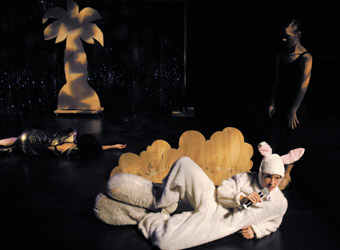
Elizabeth Ryan, Emma Saunders, Jane McKernan, No Success Like Failure
photo Heidrun Löhr
Elizabeth Ryan, Emma Saunders, Jane McKernan, No Success Like Failure
THE REASSURING, NON-JUDGMENTAL FEMALE LOVER IN BOB DYLAN’S “LOVE MINUS ZERO/NO LIMIT” (1965) “SPEAKS LIKE SILENCE/ WITHOUT IDEALS OR VIOLENCE” AND “KNOWS THERE’S NO SUCCESS LIKE FAILURE/ AND THAT FAILURE’S NO SUCCESS AT ALL.” I’M SURE THE FONDUE SET IS NOT TAKING ITS CUE FROM DYLAN’S IDEALISED LADY IN TITLING THEIR NEW SHOW NO SUCCESS LIKE FAILURE, BUT FROM THE SONGWRITER’S KNACK AT CHURNING OUT THE MEMORABLE AMBIGUITIES OF A BEAT POET-CUM-ZEN MASTER.
There’s a peculiar pleasure to be had it seems from obsessively watching failure, hence the current passion for ‘survivor’ reality TV shows of all kinds in which the success of one person is predicated on the failure of many. For these shows there is certainly no success like failure. Similarly, British television comedy has relished the failures of incompetents of all kinds and pushed the attendant embarassment further and further. Likewise, the UK performance company Forced Entertainment’s First Night (2001) wonderfully embodies every stage performer’s worst nightmares, and repeats the agony until it hurts.
While The Fondue Set don’t work the embarassment theme to the same degree, they do generate an enormous sense of uncertainty and unease, as if they’ve not quite worked out everything (they are their own stagehands, props have to be placed, costumes wriggled into, routines set up) or they’re improvising, and sometimes can’t get out of it.
For example, at the opening the Fondues come forward, sit down and chat to us about “the moment before something happens” when you come to the theatre. Soon they’ve whipped up an infinite regression and we’re somehow or other implicated in it: “You’ve also done some preparation to be here…You use your breath before sitting.” Before long we’re considering our family trees, and even when one of the trio drags us back to the present moment, the previous one is almost immediately invoked. A collective awkwardness hangs in the air…and then the show must go on.
At other moments, everything is immaculate as the Fondues expertly parody images of success, the feelgood preen of the ballerina or the taut urgency of strutting beauty contestants or a motivational spruiker for whom saying “Yessss!!” is all that is needed to succeed. But one of the trio is just as likely to have to don a rabbit costume with the hugest of feet and manage to move brilliantly in it—though she knows not why—or drag herself around the stage like some vamp who’s lost the use of her legs. They can list all the things you’d like to say no to (Bono, Martha Graham…), or learn “to say Yes to No!”, as things once again spin out. There’s mad tap dancing, unison sobbing, syncopated breathing and, finally, a return to infinite regression in a virtuosic failure even to find the theoretical niche for their work in these post-post-postmodern or whatever times.
Failure never looked so good, so silly, so successful…and so intelligent as The Fondue Set, with a helping push from collaborating director Wendy Houstoun, achieve a new level of wit in a bizarrely coherent show that is as carefully paced as it is manic and, uniquely, gives each of these talented performers their turn in the spotlight. And no silence. And, yes, violence, of a kind.
No Success Like Failure can be seen at ArtsHouse, North Melbourne Town Hall, Aug 13-16; http://www.artshouse.com.au
The Fondue Set, No Success Like Failure, creator-performers Emma Saunders, Elizabeth Ryan, Jane McKernan, collaborating director Wendy Houstoun, outside eye Julie-Anne Long, designer Agatha Gothe-Snape, lighting design Neil Simpson; The Studio, Sydney Opera House, June 4-8,
RealTime issue #86 Aug-Sept 2008 pg. 36
© Keith Gallasch; for permission to reproduce apply to realtime@realtimearts.net
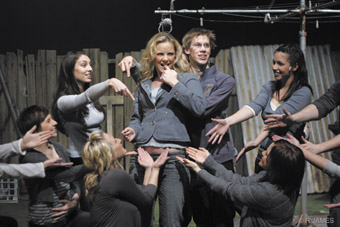
VCA Music Theatre Evening (Foundation) Course students performing in Eddie Perfect’s Up
photo R James
VCA Music Theatre Evening (Foundation) Course students performing in Eddie Perfect’s Up
THE CAREER OPTIONS FOR THE MUSIC GRADUATE ARE MANY: INSTRUMENTALIST, ENSEMBLE OR ORCHESTRAL MEMBER, COMPOSER, PRODUCER, MANAGER, TECHNICIAN, TEACHER OR, TYPICAL OF THE TIMES, A COMBINATION OF SEVERAL OF THESE. WHILE THE OPINIONS OF EDUCATORS VARY AS TO THE STRENGTH OF THE JOB MARKET (IT’S AGREED THAT MUSIC TECHNOLOGY IS A GROWTH AREA), THERE’S PLENTY OF EVIDENCE THAT TEACHING IS INCREASINGLY GEARED TO PRODUCING HIGHLY ADAPTABLE GRADUATES IMBUED WITH SOME BUSINESS SENSE AND A CAPACITY FOR SELF PROMOTION.
qut creative industries
Professor Andy Arthurs of QUT Creative Industries emphasises that creative industries education is not simply marketplace oriented, but is about the creative artist understanding the economic value of their skill and work. The overall approach, he says, is outward looking, endgendering in students a spirit that looks for and creates audiences, rather than simply expressing oneself.
To prepare undergraduate students to connect with the music industry there are course units dedicated to workplace experience including, in 2007 and 2008, attending the QMusic Big Sound annual music industry conference. The final examination for the Bachelor of Music degree involves staging a self-produced and promoted work for the public in venues chosen by the student. These have ranged from cafes to churches to the Tivoli and the Brisbane Powerhouse. A couple of years ago Arthurs suspected that the project was becoming a bit too demanding but students responded that they loved it and the sense of completion that came with it. Also project centred is the Master of Creative Industry degree which allows students to work within or across disciplines and in which a major project is the centrepiece over the 18 month period of the degree.
Arthurs is impressed with some of the idiosyncratic and entrepreneurial results emerging from QUT graduates, citing cellist Tara Simmons who has formed a group with three other cellists, with electronics, and “is generating her own material, new music, in her own voice.” Other students graduate into the world of production: a course specifically in sound design attracts students who might be otherwise deterred by the Bachelor of Music label, says Arthurs. By 2010, substantially improved facilities will make this course even more attractive.
A new QUT initiative that will focus on filling the hole between academic work and research or teaching, and professional experience is the creation of a Centre for Independent Music, aimed at merging practice with research and bringing non-academic musicians into touch with graduates. As Arthurs points out, “many practising musicians have never done a university course but have lots to offer.” The centre will include an A&R (artists & repertoire) Lab, “a kind of Brill Building for the digital age”, quips Arthurs. It will be available as well to third year undergraduates.
QUT comes up well on course experience evaluation—95% of recent graduates are happily employed, and many who have studied music are now teachers or working in sound production. But Arthurs points out that happiness is relative—not all musicians want to be fully employed, “they want to do 50% of this and 50% of that, or start small, or work from a portfolio of skills.”
waapa: music theatre
David King, who’s been with the Edith Cowan University’s West Australian Academy of Performing Arts for eight years, is rightly proud of the school’s 20 years of producing many of the best of Australia’s musical theatre performers. Currently, he says, half the cast in the Rocky Horror show are ex-WAAPA, as are the leads in Wicked and the casts in a number of forthcoming musicals.
King says he’s encouraged by WAAPA’s constant success, although he admits there’s never enough work in a competitive field, as reflected in course demand: 350 applications for a mere 18 positions for the three year Bachelor of Arts (Music Theatre) degree. The teaching, says King, is labour intensive: the course is taught by a discrete unit of five permanent staff and 25 sessional teachers, yielding unusually high contact time of 30-32 hours per week with students. And there are one on one singing lessons each week.
When we discuss career-readiness, King points out that students perform from the word go—to each other and teachers in their first year, and in eight productions a year in their second and third years.The productions range from small scale works, to amphitheatre shows to full scale musicals. Every afternoon of the 9am-6pm working day students are in rehearsal. King jokes that once they commence their career and a show’s on, former students might be surprised to find themselves with some spare time.
Courses also include learning to play piano (“it saves on hiring a pianist”) and aural training (recognising chords, understanding harmony and handling ensemble and part-writing—as in the challenges presented by Sweeney Todd, currently in rehearsal at WAAPA). There’s also a one year course in the history of the musical, and two years in the history of theatre. As for tracking graduate careers, King says that’s become easy with the internet. Former students keep in touch and their successes are conveyed to a new generation of students.
elder conservatorium of music, adelaide university
Stephen Whittington, assistant director of the Elder Conservatorium of Music and Head of Studies in Music Technology the University of Adelaide sees the job market for graduates as being “relatively strong in certain areas —such as those involved with technology; but weak in education as a result of continuing decline of investment in music at secondary school level.” As for jobs with professional ensembles such as orchestras, Whittington sees the number of positions as stable but without growth.
To assist students in career preparation at the Elder Conservatorium, Whittington writes that “undergraduate degrees all contain one course component in marketing and business skills including such things as writing grant applications, CVs and creating websites.” For graduates there is some scholarship money available from both the school and from the Helpmann Academy.
Given the emergence of new art form practices and the need to have some experience of cross artform work, Whittington describes how Adelaide has addressed this particular challenge in an inter-collegiate manner: “Some [Elder Conservatorium] courses do have an interdisciplinary or hybrid arts focus, and projects of this kind are encouraged through the Helpmann Academy—a body set up to facilitate cooperation between different schools. There is no one school in Adelaide that teaches music, dance, theatre, visual art, multimedia, so most such projects require the cooperation of two or more institutions.”
vca: music theatre—triple threat
While WAAPA mentions the term ‘triple threat’ in its course description, the new degree in music theatre at the Victorian College of the Arts headlines it as VCA Bachelor of Music Theatre—The Triple Threat. The degree co-directors are Martin Croft and Margot Fenley. Croft explains that ‘triple threat’ is an American musical theatre term that describes the high competitive advantage of an artist who can act, move and sing equally well.
I ask, given the great success of WAAPA’s training a generation and more of Australian music theatre artists in Perth, is it worth setting up a degree in musical theatre in Melbourne? Croft is of the opinion that “a music theatre school on the east coast in a major city has some significant advantages: Melbourne has a vibrant arts community and creates a lot of ground-breaking work, especially in small companies. And there’ll have been five major musicals in Melbourne by the end of the year. There are also smaller pro-am and professional shows, and the Pratt Foundation presents three shows a year.”
The new degree has evolved from a two-year foundation degree, now in its sixth year with an intake by audition for first year of some 18-26 students per annum, and by invitation only to the second year for 10 to 14 students. Croft says that each year agents and producers eagerly come to watch the students at work: “The employment success rate has been great and with a high percentage of graduates securing that rare possiblity—an agent.” Graduate careers are easy to track, says Croft, because former students keep in touch. Graduates from the foundation course are working in Wicked and have appeared in Shane Warne the Musical, The Lion King, Cats, Miss Saigon and others, not just in Australia but in Japan, Germany and North America.
The school has two full-time staff and six sessional teachers. Courses include units in acting, movement and dance (classical, jazz and pop) and musicianship, where the student acquires basic notation knowledge and basic keyboard skills. In their third year the students will perform major musicals while in their second they’ll be involved in the workshopping of new Australian musicals with their creators. Croft’s ambition, he declares with passion, is “not just to create triple threats, but good actors in all three departments—acting, singing and moving.”
northern rivers conservatorium arts centre
Regional universities and schools face substantial challenges, but can attract students by providing intimacy and focus in environments with few distractions. The Northern Rivers Conservatorium Arts Centre (NRCAC) in Lismore in northern New South Wales offers full-time Certificate and Diploma courses in contemporary music, drama, dance and screen. There are courses in contemporary music (blues, jazz, rock, pop, world, ethnic music, contemporary Western art music), technical production and music business.
Imogen Wolf, the Centre’s assistant director and vocal tutor, says that NRCAC aims to turn out students who are self-directed, multi-skilled and able to promote themselves. They leave as sole traders and with a promotional kit they’ve produced themselves, including a CD and related artwork. Wolf says the NRCAC’s Screen Studies students are an asset, helping the musicians create valuable video clips. There’s a business course which includes website building skills, entails marketing and self and event management. Wolf recalls “a woman enrolling so that she could learn how to manage her son’s band.” Students gain performance experience in concerts and in hotels in Lismore and Byron Bay. Most of the centre’s students come from this region but, says Wolf, there are always applicants from interstate. Some current students are from Israel. Our market is global.”
Appreciative former NRCAC students include singer-songwriter Jimmi Carr, Sal Yates (of Ghost Mountain), and Natalie Pa’apa’a, who majored in guitar, and Carlo Santone from Blue King Brown, who studied bass. Blue King Brown were the support act on the recent Carlos Santana tour and Pa’apa’a dueted with the great guitarist. Wolf points out that these kinds of artists are often accomplished musicians when they arrive at NRCAC, but are looking to hone their skills and improve their knowledge.
queensland conservatorium,
griffith university
Vanessa Tomlinson, Head of Percussion and Senior Lecturer in Music at the Queensland Conservatorium, Griffith University (QCGU), writes, “As there is no single career pathway for graduate students in music, curriculum content has been slowly changing from training toward a specific outcome (eg orchestral position, solo pianist etc) to an experiential education. For a percussionist this means a change away from a four-year curriculum focusing on solo performance and orchestral studies, to intensive units in jazz vibes, tabla, drum-set, latin percussion etc. These intensive courses are taught in group lessons alongside reduced hours in private tuition.”
An ensemble program entails “improvisation, collective composition, site-specific work, commissioning of new work, and re-contextualisation of more established works.” While opening up job opportunities, this approach also develops a skill base including administration, logistics, arranging and developing group dynamics, and, says Tomlinson,”with awareness and confidence about the musical world.” Work Integrated Learning has become an important part of the curriculum at QCGU and includes a Traineeship Program with The Queensland Orchestra, which the university is looking forward to formalising, and numerous possibilities in the music technology area.
Tomlinson uses performance examinations to showcase student abilities, the external examiners including composers, directors of new music ensembles and orchestral musicians. She says that by the end of their studies students may be involved in hybrid art forms, improvisation and conceptual art, and examiners are chosen in the area of developing expertise. Percussion is naturally a more flexible art form, having the joy of being whatever we define it as being!”
In 2008 QCGU will begin showcasing the graduating class to the public and invited guests from industry. As well, for more than 10 years, QCGU has hosted a registered agency, called Queensland Conservatorium Performers Agency, which contracts out current or past students of QCGU. Like QUT and other schools, QCGU is in the process of building a database for tracking the career trajectories of alumni.
It’s clear that as much as independence is being encouraged in students as an integral part of their music degrees and diplomas around the country, there are a growing number of strategies being put in place to make the most of the adaptability and entrepreneurial spirit being thus engendered.
RealTime issue #86 Aug-Sept 2008 pg. 37
© Keith Gallasch; for permission to reproduce apply to realtime@realtimearts.net
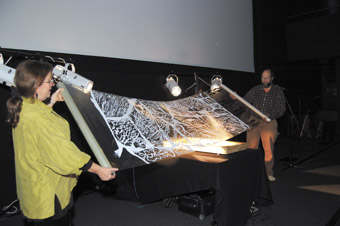
Warren Burt & Catherine Schieve, Sono Perception Sound Day
photo Peter Hislop
Warren Burt & Catherine Schieve, Sono Perception Sound Day
AS OF JULY 1 THIS YEAR THE NATIONAL FILM AND SOUND ARCHIVE (NFSA) RE-ACHIEVED INDIVIDUAL STATUS AFTER ITS SHORT-LIVED MERGER WITH THE AUSTRALIAN FILM COMMISSION (NOW DISSOLVED, WITH FILM AUSTRALIA AND THE FILM FINANCE CORPORATION, INTO SCREEN AUSTRALIA). NFSA IS NOW RUNNING A HIGH PROFILE. I MET WITH VINCENT PLUSH WHO IS ?MANAGER, RECORDED SOUND? AT THE ARCHIVE, TO DISCUSS THE SOUNDS OF AUSTRALIA PROJECT (THE 2007 SELECTION NOW AVAILABLE ON CD), THE RECENT CELEBRATORY SOUND DAY AND OTHER NFSA SOUND VENTURES.
Plush explained, “Sounds of Australia, The National Registry of Recorded Sound, was inaugurated in February 2007 as a way of drawing attention to the fact that the NFSA has a Recorded Sound Branch and quite a number of significant recordings of sounds and recorded music from over the past 110 years or so. It’s modelled on something the American Library of Congress do every year. They admit 50 American sounds into their national registry, all chosen by experts. Ours is a little different in that we start more modestly and admit 10 sounds per instalment. And we invite the general public to submit their ideas about how we should build a national registry of recorded sound.”
These sounds must be either recordings made in Australia, by Australians or of Australians, must actually exist on recordings that can be identified and be at least 20 years old. The public submit their proposals by the due date and, says Plush “they’re sifted down by one of our staff members who then sends out a list of 40 or so to a panel of industry experts who write their opinions. That brings it down to 20. While this is going on, we pursue things like who owns the rights to these things and, if we can’t secure the rights in some way, there’s no point in proceeding with the nomination.” After more whittling “we then take them to our director who ensures that there’s a widespread contemporality—that we have something from every decade; widespread media, meaning that we have not only recorded music but recorded voices, natural sounds…Then there’s genre—from popular music, through art music to Indigenous music to whatever.”
Plush describes the spread as “pretty broad, ranging from birdsongs of Australia to Professor Elkins’ original Aboriginal recordings to recreations of the Gallipoli landings by the BBC to Don Bradman and the 1931 Ashes and Gough Whitlam’s ‘Kerr’s cur’ speech. And now we’ve got Percy Grainger’s “Country Garden” played on the original piano roll.” And the late Billy Thorpe is included in the 2008 batch. “In the first round, we included the earliest known surviving sound recording. This was a parlour song called ‘The Hen Convention’ recorded in 1896 by Thomas Rome, an amateur sound recordist in Warnambool. He recorded a neighbour of his singing this song, the choruses of which are imitations of chooks and roosters. That really captured the wider ABC audience imagination and made the newspapers: ‘The earliest surviving sound of Australia is not Thomas Edison reading Mary Had a Little Lamb but sounds of a guy imitating chooks…’.”
On the NFSA’s Sound Day, June 18, the federal Arts Minister, Peter Garrett, announced the next 10 selections for the Sounds of Australia Project and launched the CD, a joint collaboration between NFSA and the ABC. The NFSA sees the project, says Plush, as raising awareness that “there is a recorded sound history of Australia and secondly that there is a government agency that collects it…The project’s a growing thing. It’s like a time capsule in sound. We hope that the CD will get into every school, every public library, embassy kits and so on.”
Sound artists also fall within the NFSA’s brief: “We’re particularly interested in collecting the archives of those Australian sound artists who’ve moved boundaries or who’ve done interesting things with the sounds of the natural environment.” Composer, sound artist, sound sculptor and instrument maker Ros Bandt “fits the profile beautifully—someone we believe is incredibly important, wonderful and treasurable.” Sound Day was the occasion for the launch of Bandt’s book, Hearing Places (co-edited with Michelle Duffy and Dolly MacKinnon for Cambridge Scholars Press, see RT 87). Bandt reciprocated by playing her tarhu, “a gorgeous zither-type instrument, which sounds like a cross between a viola da gamba and an erhu—designed by Peter Biffin. This was the perfect illustration of everything Ros Bandt’s on about, the meetings of cultures, the actual performance of music and improvisation around sounds.”
The first of the Thomas Rome Lectures (named after the recordist mentioned earlier) was also delivered at Sound Day. Michael Smellie, a former executive with SONY BMG, gave the first lecture. And a strong statement it is (downloadable from the NFSA website). Smellie reminds us just how successful the industry was from the 1960s to the 1980s, but in terms of “opportunities presented by the new digital era, we have, to date, missed the boat. In 2007…8% of Australia’s recorded music revenue came from digital applications, compared to a worldwide average of 15%; and 24% in the USA and 11% in Canada for example. This reflects our poor performance in digital applications employed, be it from the perspective of a consumer, producer, performer or distributor.” He eliminates the usual excuses, like the effects of American Idol, and blames limited education in music, but above all a lack of leadership, specifically of a united front to embrace the digital challenge: “I contend that there is no music industry as such in Australia. It is really a collection of small and medium sized enterprises who constantly seek to differentiate themselves. They have no real desire to co-operate, to be organised or to be integrated into a formal structure. Maybe we are closer to a craft group rather than a real industry. As long as this prevails, we have structural impediments to developing leaders.”
Although, given his background, he’s averse to suggesting it, Smellie declares that “he would like to see the Minister [Garrett] clearly articulate his vision for the industry and to define a leadership role in music for his department.” And he argues not for, as have some have suggested, “the cultural equivalent of the Australian Institute of Sport…[and its] focus on elite sports people [but an] equivalent of the Australian Sports Commission.” This he hopes would facilitate the “the creation of a network of digital innovators in the music space to enable them to leverage their work” and funding initiatives “perhaps with private equity investors and existing industry investors.” Finally, perhaps inspired by NFSA’s Sound Day, he proposes the inauguration of an annual Australian Music Day.
It’s clear that NFSA’s scope is comprehensive—Sounds of Australia, Sound Day and the organisation’s extensive archiving represent the work of composers, academics, sound artists, cultural groups, broadcasters and the popular music industry. Sounds of Australia’s annual patrons include the composers Paul Grabowsky and Peter Sculthorpe and, this year, singer Renée Geyer was added. Sound Day itself echoes the breadth of approach by including a concert, Sono-Perception, by Melbourne’s JOLT (p41), of contemporary sonic art and also the innovative Percy Grainger’s exquisite Free Music machines played by Catherine Schieve and Warren Burt. Earlier that day Grainger had been inducted into the National Registry of Recorded Sound with the Country Gardens piano roll from the playing of the composer in 1919, now sitting alongside other 2008 inductees, the Aeroplane Jelly Song, the Theme from Blue Hills, Slim Dusty’s “Pub With No Beer”, Peter Sculthorpe’s Irkanda IV, No Fixed Address’ “We Have Survived” and Billy Thorpe and the Aztecs’ “Most People I Know Think That I’m Crazy.”
But there’s more to NFSA’s sound archiving. The archive is building, for example, a collection of the work of composer Martin Wesley-Smith, in partnership with the National Library which is collecting the artist’s work on paper: “We collect the audio-visual archive”, says Vincent Plush. “The first instalments have arrived in 12 large plastic bins—old reel-to-reel tapes, slide carousels, the Apple Mac 3 , the Fairlight pieces, the documentation that goes with all this. We began the project publicly at the end of February with an evening called The Tears of Timor during which we assembled four of Wesley-Smith’s Timor-related pieces and presented them to an extraordinary overflow audience including Timorese activists and five ambassadors. It was a very emotional evening. The surviving members of the Wesley-Smith family came along: Sheila, the 91-year-old mum, the twins Peter and Martin, and Rob, the elder brother, who came from Darwin. We brought them all on stage and there was a standing ovation.” More performances of the composer’s work will be programmed across the next two or three years, including the music theatre work Quito. The Wesley-Smith archive, says Plush, will take at least three years to assemble.
Plush rattles off a list of possible candidates whose work warrants archiving: the late Tristram Cary and “that extraordinary florescence of Melbourne artists Warren Burt, Ros Bandt, Rainer Linz, Les Gilbert, Chris Mann…”
I ask Plush how he himself fits into the NFSA. Neatly it seems. He’s a composer, founder of Sydney’s Seymour Group, has taught composition and musicology in universities as well as writing reviews for The Australian. But he also spent 19 years in North America where he “ended up working for Vivian Perlis in the American Oral History Project and did 202 interviews. I did the first major interview with John Adams, the last interview with Frank Zappa. From A to Z and in between, many people who’ve since died—Cage, Lou Harrison, Carl Ruggles…” The interviews became the Main Street USA series in the mid-1980s for ABC radio, the first extensive introduction for many of us to American composition.
The NFSA’s inaugural Sounds Alive programme for 2007-08, devised by Plush, included a mobile-phone symphony created by visiting American composer William Duckworth, a program of new music for silent films created by young composers attending National Music Camp and an evening of Indigenous-inspired music performed by Topology and Iain Grandage. Among next season’s highlights will be a celebration of Voss on the occasion of the 50th anniversary of the first publication of Patrick White’s novel and the 25th anniversary of the first appearance of music from the opera by Richard Meale. For a country which pays so little attention to the history of its art, the NFSA’s ambitions are timely and admirable.
NFSA Sound Day, National Film and Sound Archive, Canberra, June 18; NFSA, Sounds of Australia, ABC Classics CD, ABC 476 6812; www.nfsa.gov.au
RealTime issue #86 Aug-Sept 2008 pg. 38
© Keith Gallasch; for permission to reproduce apply to realtime@realtimearts.net
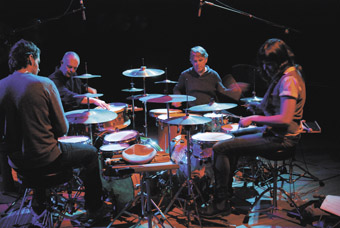
Synergy with Fritz Hauser
photo Timothy Constable
Synergy with Fritz Hauser
IN HIS REVIEW OF THE OPENING SYNERGY CONCERT THIS YEAR AT CARRIAGEWORKS (RT85, P48), REALTIME EDITOR KEITH GALLASCH CONCLUDED, “THE NEW SYNERGY LOOKS SET TO ENJOY A GREAT FUTURE.” BUT WHAT IS THIS ‘NEW’ SYNERGY? THE 35-YEAR-OLD PERCUSSION GROUP STILL HAS ONE OF ITS FOUNDERS MICHAEL ASKILL AT THE ARTISTIC HELM, AND IT’S ALWAYS HAD A VARIABLE MEMBERSHIP. AFTER ALL, THE PERCUSSION ENSEMBLE ONLY HAS A HISTORY OF 50 YEARS MAXIMUM—IT’S NOT A FIXTURE LIKE THE STRING QUARTET. AND AS ASKILL POINTS OUT, SYNERGY HAS ALWAYS “DONE DIFFERENT STUFF—PLAYING WITH THE SYDNEY DANCE COMPANY, TRYING JAZZ, AND DEVELOPING MIDDLE EASTERN AND AFRICAN COLLABORATIONS.” WHEN I BEGAN ASKING SYNERGY’S CORE MEMBERS WHAT THEY UNDERSTAND BY ‘NEW’, THE RANGE OF ANSWERS WAS INTRIGUING.
For the group’s chair, Meredith Brooks, it is very much related to the synergy with the group’s partners in drumming, TaikOZ, headed by ex-Synergy man, Ian Cleworth, and run under the same board and management. “New music groups these days can’t just take the intellectual path”, she told me, “they need to round out the experience by engaging an audience…talking to them, and capturing the visual aspects of a performance through lighting and choreography. TaikOZ has broken through doing that, and Synergy has learnt from them”.
Incidentally, Ms Brooks is herself a key part of Synergy’s newness. What was once a group run by the musicians themselves developed a board separate from the players 18 months ago: a necessary thing to do as the Australia Council’s best-funded key organisation. Brooks insists though that “it’s still their company; we just facilitate with our skills in offering a financial assessment of what they want to do.”
Newness for artistic director Michael Askill relates primarily to overcoming what he admits was “a fatigue factor” in recent years. “Two key players withdrew, Alison (Pratt) had a baby and Ian (Cleworth) went to TaikOZ. We had to make room for TaikOZ to establish their ensemble, their school and their audience. That’s now done. And halfway through last year we aimed to establish a regular presence for Synergy in Sydney, a roster of new works—ours or commissioned ones—and to re-establish the fact that we were well-positioned to play important world repertoire—like the Xenakis and Reich works in our first concert this year. I think we proved ourselves there.”
Significantly, that concert program was a project of Timothy Constable’s—Synergy’s Assistant AD, a position created by the new board. As Askill freely agrees, “Timothy can tackle huge solos I wouldn’t dream of undertaking.” Constable, meanwhile, admits that this program “was a nightmare practically! Very difficult music with doubts as to whether we could fit enough rehearsals in as well as making our debut at an American festival [Tucson Winter Chamber Music Festival, Arizona, May]. There’s just so much problem solving before the first note is played with our music—each new project is really new.”
But new projects like that are what Constable clearly identifies as ‘the new Synergy’—along with “pushing boundaries in the way percussion instruments are played, and exploring new instruments like ancient Tibetan singing bowls and gongs.” There has also been the arrival of Bree van Reyk at Synergy, from what Constable describes as “a scholarly background.” [Her MySpace entry however declares: “she was, for many years, in The Rebel Astronauts. Now she plays with Holly Throsby & Darren Hanlon, plays along with the Australian Opera & Ballet Orchestra, does concerts with Ensemble Offspring, and is a sometimes member of Rand & Holland, Charge Group, Coda and The Initials. Eds]
The point I made earlier about the recent invention of the percussion ensemble is reflected in the fact that many of the world’s great groups who pioneered the artform are rapidly approaching the end of their natural lives—Kroumata, Amsterdam and Nexus to name but three. So, how has Synergy survived? And is its future survival equally deserved?
Michael Askill’s answer is that Synergy was less about one or more dominant personalities—and one thinks immediately of other artistic groups like the Sydney Dance Company and the Australian Brandenburg Orchestra with inspiring founder/leaders—“and more about moving forward with new membership. There have always been great young players who wanted to be part of Synergy; I’d have surely drifted off too without their vitality. In return, I can pass on a few things I’ve learnt so that we can all share some sort of future vision.”
Timothy Constable is equally positive: “Synergy is defined by Michael, but I’ve been working with him long enough (since 2001) to absorb the spirit of the way he works. Of course there’s been creative friction between the generations. But Michael’s…very egalitarian and open to the ideas of others. I think that creates a rich tapestry that justifies our survival.”
Of course, there’s also the little matter of ‘succession planning’, which both Askill and Constable mention quite comfortably. “Timothy would obviously take over if I left”, says the former. “But succession planning isn’t an option these days for groups reliant on government funding. Like not going into the red (which Synergy hasn’t in the last 10 years) it’s demanded in return for the grant.”
Money is the board’s primary responsibility—paying for the reasonable ambitions of the artists. But what’s challenging it in an age of governments paying an ever smaller proportion of the bills, is that a group that clearly appeals to a powerful demographic of “emerging professional people” has not yet proved attractive to sponsors. One would have thought they were a whole lot more appealing than ‘classic’ companies with audiences in their 60s who’ve already bought everything they need in life.
Meredith Brooks admits that the 34 years or so of Synergy’s existence run by the performers may have been lost time in this regard. “Musos just aren’t into cold-calling potential sponsors”, she believes. “But they would appreciate the freedoms that more money would give them. To a certain extent we can choose to take profit from TaikOZ to promote Synergy. But we’ve had to turn down so many invitations to tour the [Meryl Tankard-TaikOZ] dance piece Kaidan for lack of a sponsor. We should have toured Synergy on in America after the Arizona festival this year—but it would have been impossible to move six marimbas without a transport sponsor; and we need a new home that can handle storage of all those instruments, allow 200 students to experience percussion and not drive the neighbours mad with the 130 decibels that TaikOZ generates! An island?” How about Cockatoo?
Or would that damage the fascinating point of difference that Timothy Constable identifies at Synergy? “European and US audiences—even our percussion colleagues like Fritz Hauser who played with us in June—go nuts over our sound and approach. It’s not any technical slickness; it’s the spirit of not being limited by the idea that percussion is simply a rhythmic entity. We’re into space.”
See review of Synergy’s Space and Time concert featuring Fritz Hauser
RealTime issue #86 Aug-Sept 2008 pg. 39
© Jeremy Eccles; for permission to reproduce apply to realtime@realtimearts.net
AUSTRALIA’S CONTEMPORARY MUSIC LANDSCAPE REFLECTS THE PHYSICAL ONE: SMALL, DIVERSE YET CONCENTRATED ACTIVITIES SCATTERED AROUND THE EDGES, WITH A SEEMINGLY VAST VOID IN THE CENTRE. TO FILL THIS GAP, BOTH PHYSICALLY AND INFRASTRUCTURALLY, THE MUSIC BOARD OF THE AUSTRALIA COUNCIL FOR THE ARTS HAS INSTIGATED SOUND TRAVELLERS, WHICH THROUGH THE PROVISION OF MODEST GRANTS TOWARDS TRAVEL COSTS ASSISTS THE NATIONAL TOURING OF CONTEMPORARY MUSIC—JAZZ, IMPROVISATION, SOUND, EXPERIMENTAL ELECTRONIC MUSIC AND CONTEMPORARY CLASSICAL.
The initiative is headed up by Joanne Kee of Ceres Solutions who has considerable experience in arts management, including managing the Song Company and consulting for the Jazzgroove collective. Curiously, Sound Travellers is run in partnership with Performing Lines, which has a strong record of touring theatre and performance—quite a different circuit to that of the contemporary music scene. Perhaps this is a cunning strategy to transfer knowledge across the arts sector and expand the audience for contemporary music.
Following an intensive period of consultancy the first tours are underway, combining an eclectic mix of styles and production scales. As well as augmenting the touring programs of established national events such as Liquid Architecture and Lawrence English’s Open Frame festival, the first program also includes the Mace Francis Big Band, improvisation ensemble Metalog (Jim Denley, Amanda Stewart, Ben Byrne, Natasha Anderson, Robbie Avenaim, Dale Gorfinkel), sound artist Tom Hall, the experimental electro pop duo ii (Jon Tjhia and Alex Nosek), the jazz ensembles Misinterprotato and Way Out West, multi-instrumentalist Colin Offord and, from the contemporary classical realm, Ensemble Offspring and IHOS Opera. Kee suggests that in the selection process they were looking to “support artists who have shown a commitment to touring. Added to that, with our eye on strategically developing networks and touring circuits, we are aiming for a mix of cities, states, genres and dates.”
The list of touring venues is particularly intriguing, located in every capital city and some key regional centres and ranging from small artist run spaces to major concert halls. Kee says, “It has been interesting working with the different genres, they all have unique qualities, but there is a blurring of boundaries both in musical genres and in scale and size. This provides all sorts of opportunities and definitely one of these is to connect smaller and larger scales of music making. I think it’s a real plus having a broader outlook. As for the actual circuits, there are existing paths around the country for sound art and jazz and we want to strengthen and enlarge them…[C]ontemporary classical music is a bit different in that there isn’t much of a pre-existing circuit, but I believe there is definitely enough interest to create one.”
Sound Travellers has been funded as a two year initiative, a relatively short time to set up a program from scratch and then learn from its development. I ask Kee about her hopes for the future: “I believe that we could make a significant change to the Australian musical landscape if we are given the opportunity to lay down a strong foundation and then given a chance to build on this…I believe that we can shift ways of working in these genres, in order to create opportunities for artists to spend more time creating, producing and performing. Plus dare I say, also to increase engagement with audiences…”
In the meantime, the second round of applications is coming up in September for tours during 2009. Hopefully Sound Travellers will continue to fill in the blank spaces on the map of contemporary music in Australia.
www.soundtravellers.com.au
RealTime issue #86 Aug-Sept 2008 pg. 38
© Gail Priest; for permission to reproduce apply to realtime@realtimearts.net
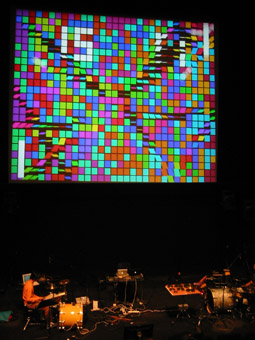
d.v.d ensemble
THE WAY SOUND AND IMAGE COALESCE IS AN ABIDING SUBJECT OF ARTISTIC INVESTIGATION. WE TAKE FOR GRANTED THE COHERENCE OF AURAL AND VISUAL CUES IN REAL LIFE, BUT IN ART HEARING AND SEEING CAN BE DISAGGREGATED. THE USE OF LIVE MUSIC WITH FILM IS AS OLD AS CINEMA ITSELF, EVEN OLDER THAN THE USE OF THE MOVIE SOUNDTRACK THAT WE TAKE FOR GRANTED. THE FOUR APHIDS REEL MUSIC FESTIVAL CONCERTS EXPLORED THE EVER-EVOLVING POSSIBILITIES OF THE RELATIONSHIP BETWEEN SOUND AND IMAGE.
The Saturday evening concert opened with David Young’s Creation (2008) for violin and percussion. This short but intense work drew its inspiration from a topographical map of railway lines in Victoria, shown on a cinema screen. The map reveals the country in cross-section, and as it scrolls horizontally across the screen it resembles the treble stave of a music manuscript, the map becoming a graphic score, and prompting the viewer to contemplate ideas of mapping, landscape and journey. In responding to the score, the performers interpret particular visual cues such as gradients or lines, making subtle music that augments and balances with the imagery. Typical of Young’s composition, the work is minutely crafted and delightful, rewarding close concentration by the audience.
The main work of the evening was a performance by Japan’s d.v.d. ensemble—two drummers and a video artist who combine rock percussion and video into an energetic, pulsing audio-visual mix. The drum beats control the imagery and action on screen as the two drummers, who sit facing each other across the stage, engage in a kind of duel, like competitors in a video-game parlour. Some of the imagery is in the style of pinball games and video games such as Pong, while other images suggest screensavers—bouncing geometric shapes, coloured bubbles and abstract dribbles, mainly in pastel and day-glo colours. One memorable image is of two cubes, each facet showing a video of a drummer. The cubes move about and mutate, morphing the video image as they change shape, before eventually shattering themselves and the image into fragments. Accompanied by the drumming and a synthesised video game-style soundtrack, d.v.d’s work is light and fun with a trace of comic irony, and while it’s perhaps best suited to the dance club, it addresses the representation of synaesthesia and explores the possibilities for the cueing of visual imagery and sound through movement.
The Sunday afternoon concert comprised six short works for guitar (Geoffrey Morris) and recorder (Genevieve Lacey) accompanying films and the remainder constituting a chamber recital. The opening film was Hans Richter’s wryly pointed surrealist Vormittagspuk (Ghosts Before Breakfast, 1928), with flying hats, a necktie with a mind of its own, an array of moving pistols, crockery that smashes and reassembles itself and men disappearing, addressing time, space and motion and making full use of the cinematic special effects of the day. Italian composer Maurizio Pisati has added a new soundtrack of synthesised elements and instructions for live performers. The overall sound is eerie, fragmented and chromatic in character with the film. Lacey and Morris respond to the imagery with brief, gestural figures that extend the tension and tease the audience’s awareness.
Pisati’s two translations for guitar of works by Salvatore Sciarrino and Domenico Scarlatti followed. His transcription of Sciarrino’s l’Addio a Trachis II (1980/93) makes extensive use of damping of the notes and the left-hand sliding along the fretboard, shifting well away from the typical sound of the guitar, in stark contrast to the Scarlatti work that was originally for harpsichord. Morris later gave us Giacinto Scelsi’s Ko-Tha (1) (1967), in which the guitar is laid flat on the performer’s lap and used as a percussion instrument. Morris handles these works delightfully, and the shifts from one to the other provide rare insights into the instrument’s possibilities. Genevieve Lacey’s rendition of Fausto Romitelli’s Seascape for solo contrabass recorder (1994) was equally engaging, revealing the instrument’s sensuous, sonorous, breathy and haunting sounds.
Morris and Lacey also accompanied Pisati’s films OER (Over Endless Resonances, 2007), in which a montage of fragments of manuscript gives visual effect to the live music, and Spiegelensemble (2008), which blends animations of paintings of Spiderman with slo-mo footage of street scenes and in which the live performance again responds to the imagery and soundtrack.
These Aphids concerts alternately explored and inverted the cinematic tradition of using music to augment action, sometimes using imagery to enhance live performance and enabling interactivity between media to examine the coherence between aural and visual cues.
Aphids Reel Music Festival June 2008, Creation, composer David Young, performers Yasutaka Hemmi, Eugene Ughetti; d.v.d. ensemble; Vormittagspuk, works by Maurizio Pisati, Giacinto Scelsi, Fausto Romitelli, performers Genevieve Lacey, Geoffrey Morris; ACMI Cinemas, June 26-29
See also review of the Ensemble Offspring-Louise Curham collaboration, Waiting to turn into puzzles.
RealTime issue #86 Aug-Sept 2008 pg. 40
© Chris Reid; for permission to reproduce apply to realtime@realtimearts.net
SONO PERCEPTION, PRESENTED AT SYDNEY’S CARRIAGEWORKS BY MELBOURNE-BASED JOLT, WAS SUCCINCT. AFTER BEING USHERED IN AT 7:30, I FOUND MYSELF BACK OUT ON THE STREET BY NINE. MAYBE THIS WAS JUST AS WELL, AS IT LEFT PLENTY OF OPPORTUNITY TO DIGEST WHAT HAD BEEN A FAIRLY ANODYNE EXPERIENCE AT BEST, DISAPPOINTING AT WORST. BILLED VARIOUSLY AS “A SONIC ARTS CONCERT” AND “PIONEERING PSYCHOACOUSTIC SONIC ART” (AND I AM FAIRLY CERTAIN MY TICKET HAD “EXTREME SONIC ART” PRINTED ON IT, ALTHOUGH I DEARLY HOPE I AM MISTAKEN), SONO PERCEPTION SEEMED INTENT ON BUILDING EXPECTATIONS OF A PROGRAM THAT CHALLENGED CONCERT HALL CONVENTIONS.
Instead, although some of the concepts and approaches appear to hold a great deal of possibility, it was difficult to find anything in either the staging of this event, or in much of its sonic content, that advanced notions of the aesthetic deployment of sound beyond the realm of music, or explored “sonic perception as the subject matter of the work” as outlined in the program notes.
Beginning life as an installation, Bruce Mowson’s Melting Moments seems to have suffered in its transplantation from gallery space to concert hall. Where Mowson’s work usually explores his themes of absorption, immersion and repetition with confidence, the sliding sine tones accompanied by a video projection of concentric rectangles and circles slowly shifting through a palette of ice cream colours failed to engage in such a large space. Several technical issues, such as pixilation of the image and the audibility of the air conditioning during the quieter sections, also served to inhibit the drift into the specific sensory registers of the piece that Mowson’s work is capable of inducing in a more favourable setting.
Following an apology for the absence of the previously advertised performance of Cat Hope (delivered as a species of chant, and about which the less said the better), the duo of Catherine Schieve and Warren Burt performed on the Electric Eye Tone Tool—one of Percy Grainger’s famous Free Music machines—which uses a bank of photocells to transduce light into electrical voltage. However, where Grainger’s machine used scores prepared on rolls of plastic, which were then pulled across the photocells mechanically (much in the manner of a player piano), Schieve and Burt pursued a more performative, and at times literally ‘hands on’ approach, with the resulting sound now produced by digital oscillators and samples instead of the analogue electronics of the original. Their three short works saw Schieve and Burt elicit a stream of electronic yibbles and blurts with their hands, delicately manipulating the timbre of a choral structure with strips of shaped cardboard, and together wielding a four-metre long graphic score painted on clear plastic sheeting to induce an alternately serene and garrulous babble, all of which explored the potential of Grainger’s design.
With its spidery metallic framework housing four mechanically operated violins, James Hullick’s Gotholin machines also seemed to contain plenty of both musical and performative potential. Yet despite Hullick’s claims for his machine as being a form of automata or robot, on this occasion it seemed to serve simply as a computer-controlled prosthesis rather than displaying any kind of autonomy. Apart from brief moments of four-mechanical armed action, the performance consisted largely of a limited range of bow scrapings drawn from just one or two violins, with the mechanical arms appearing to mimic the gestures of the performer at his laptop. The intrusion of Hullick’s own violin bow into the scheme of things part way through the performance served only to destroy any remaining expectations that the machine might be given a chance to ‘do its own thing’ (whatever that might be). Perhaps technical issues intervened to make this a rather lacklustre performance, but the meagre sonic offerings of scratches, tinks and occasional tones, however they were produced, were unremarkable.
Closing the night was Speak Percussion member Jeremy Barnett’s performance of American experimental composer James Tenney’s Having Never Written a Note for Percussion (1971). Barnett’s performance of this deceptively simple piece—an extended crescendo and decrescendo played on a gong—was exemplary. However, the staging of the work in darkness, except for a red spotlight on the gong that ‘mickey moused’ the rise and fall in volume by fading from dim to bright and back again, seemed to circumvent Tenney’s intention for the work, trading perception for didacticism. Given how simple and deliberately obvious the form of the work is, this visual analogue to the change in volume was not just superfluous but detrimental. Perhaps worse still was that Barnett was left to labour away in darkness, which not only obscured his involvement but also left a number of people I spoke with confused as to how such a straightforward work was actually produced, undoubtedly placing a further impediment to the perception of the sounds at hand.
Unfortunately, as a whole the night seemed to suffer from a kind of curatorial or promotional overstatement, ultimately working against its theme of perception. Only the first and last items could be said to have had an attentiveness to sensory perception as a specific concern, in so far as they could—or in fact needed to—live up to those claims. Perhaps it was only that these attempts at framing the evening came across as so much ‘preaching to the choir’ (on several occasions a vocally critical one at that), but even this could not turn these disparate components—all interesting in themselves—into a cohesive program.
JOLT, Sono Perception: a sonic arts concert, Bruce Mowson, Catherine Schieve, Warren Burt, James Hullick, Speak Percussion, presented by JOLT & CarriageWorks, CarriageWorks, Sydney, June 20
RealTime issue #86 Aug-Sept 2008 pg. 41
© Peter Blamey; for permission to reproduce apply to realtime@realtimearts.net
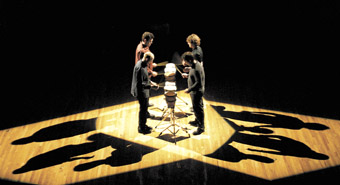
So Percussion
courtesy the artists
So Percussion
LET’S FOCUS FIRST, NOT ON THE SCALE OF THE CANBERRA INTERNATIONAL CHAMBER MUSIC FESTIVAL AND ITS SOUNDS ALIVE PROGRAM—LARGE ENSEMBLES, CHAMBER GROUPS, SEXY VOCALISTS, TECHNICAL PROWESS—BUT ON THE POWER OF A SINGLE FIGURE, AT ONE INSTRUMENT, A CROWD RISING IN A TERRACED WAVE FROM HIS HUMBLE PLACE ON A WOODEN PLATFORM. AS ROB SCHWIMMER PLAYS—SWEET, RIPPLING, STRIDENT, LAUGHING; WHETHER TICKLING IVORIES, OR PLAYING THE AIR OVER THE WACKY THEREMIN TO CREATE SOUNDS REDOLENT OF HAWAII, CRÈME DE MENTHE AND RY COODER PULLING A THROATY RIFF—DISTANCE BECOMES SMALL.
I worry when, in interview, a classical violinist, James Cuddeford of the Grainger Quartet, states that people lose intimacy in the back row (of a 200-seat theatre), presuming contemporary audiences can no longer hear acoustically even through moderate distance. To me this is a furphy. This is not how sound exists. Schwimmer at the piano on stage also plays my throat, my membranes. Vibration becomes a wave becomes vibration, traveling from air through to fluids via folds of skin. Music is this intimacy, a kiss. Perhaps the deepest of contacts we can achieve.
So, whether we listen to Schwimmer playing solo, or in madcap mayhem with co-performers Mark Stewart and Melissa Fathman in Polygraph Lounge, we are not held to arrest by distance. The lounge show yokes Led Zeppelin with Aaron Copland and Moby Dick; plays everything from keyboards to guitar, conch shells and jellyfish with an extraordinary intelligence and musicianship; its success relying on an audience’s knowledge of musical timbres, techniques and histories. The physically painful over-amplification of their sensitive performance abuses our subtle organs and misunderstands the nature of both sound and ‘fun.’
When the Dean-Emerson-Dean trio performed in a dashingly proclaimed “only fully-acoustic concert on the program!”, I travelled easily with them from rasping vast bored spaces to the feather fall of a pin. Paul Dean performs as if his body lives and grows within the bore of his clarinet. His brother Brett’s Night Window—an intimate exploration of palpitations, canyons, crevices and small hearts crying in the night—displays an epic depth of craftsmanship: stringy, silken, profound. It is a consummate danse macabre with moments of Shostakovich-like paranoia thrown in.
The Brisbane group Topology created some curious distances. Robert Davidson built his Taken (2002) out of stories from the Stolen Generation. Perhaps Ruth’s Story reveals too strong an influence of the docu-dramas of John Adams and Steve Reich. Mimicking the rhythms of Aunty Ruth’s spoken voice, Davidson creates a curious distance with his use of cut edits and repetition of ‘key’ emotional phrases in video footage. The effect, for me, is a truncation of her individuality and in the end the potency of her story. Her magnified face almost becomes a vaudeville mask. Davidson admitted in an interview with Vincent Plush on ABC Radio National’s The Music Show (May 16) that he would now utilize those spoken rhythms less prescriptively.
Iain Grandage’s Mirramirratjara (2006) for small mixed orchestra is more delicate. While respecting what is and is not his to reveal or imitate (“these are not my songs”), his work yet seems caught between an orchestrated ostinato of white grief/guilt and the very different qualities—pride, joy, a comfortable humility?—evident in the Aboriginal elders’ singing and dancing in the projected footage. Perhaps the effect would differ if the elders were indeed present “around a campfire” as initially intended. Still, I perceive, in the footage of clapsticks hitting into sand, an intimacy strikingly at odds with that of the orchestral performers with their instruments.
Donnaccha Dennehy, the director of Dublin’s Crash Ensemble, took as his ground base the “moments of ecstasy (both luscious and dark)” of several impassioned traditional Irish Sean Nós songs of love and death. Structurally, the work oscillates between equal tempered and a quasi ‘just’ tuning, and between free form and measured time. Traditional singer Iarla O Lionaird had his bars counted for him throughout the piece, which provided an intriguing visual cue to the piece’s complexities. Relentless as waves breaking over craggy rocks, this piece premiered at an Irish regional arts festival to an audience strongly familiar with the tradition it explores. Epic, driven, exciting and grossly over-amplified, it was an exercise in powerful emotion, textures and motions. I’ve never heard a trumpet asked to ramp its way through tonal landscapes like this.
In comparison, an evening with New York-based, Czech émigré Iva Bittova (with Sounds Alive director Lisa Moore at the piano) was a night in the arms of a familiar—particularly, perhaps, for the large Czech contingent in her Canberra audience. Bittova’s forte, most evident in her own compositions or those of Janacek and Bartok, is her sharp, nasal voice, pulling sounds in a spectrum from human to animal, redolent of the soils of her native country. It is a sound which instils in me, too, a thirst for belonging.
Yet this is not a superlative performance. Some of the concert’s repertoire, which ranged from Don Byron to Rufus Wainwright to Ravel, clearly does not suit her voice. It is nothing like the radical vocal expressiveness/expressionism present in the performance of Bingen by Jouissance in the ‘mainstream’ part of the festival. There, Deborah Kayser’s voice carved an achingly layered geology of quarter and semitones, scrolling through melisma with consummate musicianship and passionate grace. Perhaps Bittova is not interested in thus extending her voice or the song form. Her voice does, however, relate very intimately with her violin.
Michael Gordon’s Van Gogh Opera is, by contrast, a piece shaking to the bones, in which the singers are in almost constant over-extension. Based on Van Gogh’s letters to his brother Theo, the artist’s alienation, social awkwardness and endless struggle are captured in a music that is relentless and obsessive, maintaining a hard edge that suddenly breaks us to tears. I found myself begging Gordon to give the soprano some release—but that would be a different composition.
New York’s So Percussion performed the whole of Steve Reich’s Drumming with an extraordinary mix of attentiveness and release. Fine, disciplined, controlled, graciously aware of each other, their collaborators and the architecture of the work, the performers moved within the piece’s comings and goings, its rhythmic and visceral patterns over 75 minutes. This superlative performance allowed full course for Drumming’s buildings and breakings of tension across this span of time. This was playing the line between assertion and allowing—one of the great mysteries of intimacy—played at its most generous and satisfying.
Sounds Alive ‘08 was a discrete program of 12 concerts within the Canberra International Chamber Music Festival. Robert Davidson’s Taken and Iain Grandage’s Mirramirratjara were also part of the National Film & Sound Archives own, similarly titled Sounds Alive annual program.
Canberra International Chamber Music Festival, artistic director Nicole Canham; Sounds Alive ’08, artistic director Lisa Moore; Street Theatre, Canberra, May 7-8
RealTime issue #86 Aug-Sept 2008 pg. 42
© Zsuzsanna Soboslay; for permission to reproduce apply to realtime@realtimearts.net
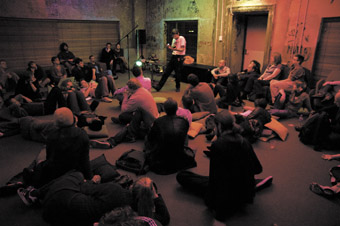
Rafael Toral, Liquid Architecture, Brisbane
photo Tom Hall
Rafael Toral, Liquid Architecture, Brisbane
CREDIT SHOULD GO TO THE TIRELESS BRISBANE DIRECTOR OF LIQUID ARCHITECTURE 9, LAWRENCE ENGLISH, FOR BREAKING WITH FORMALITY AND DELIBERATELY GENERATING A MORE CONVIVIAL ATMOSPHERE FOR THE RECENT GIGS HE’S STAGED AT BRISBANE POWERHOUSE’S ROOFTOP THEATRE. TONIGHT WE ENTER A DIMLY LIT SPACE SURROUNDED BY SIX EXCELLENT SPEAKERS AND COVERED HAPHAZARDLY IN COMFY FLOOR CUSHIONS. THE RECLINING AUDIENCE WATCH PERFORMANCES WHICH EACH OCCUPY A DIFFERENT REGION OF THE ROOM. THE RELAXED VIBE IS HELPFUL AND POSSIBLY NECESSARY, A STRATEGIC WAY OF SOFTENING THE RELATIVE AUSTERITY AND SERIOUSNESS THAT LIQUID ARCHITECTURE, AN INCREASINGLY DIGNIFIED ELDER-STATESMAN OF THE AUSTRALIAN SONIC ART SCENE, TRADES IN.
Lying on one’s back with eyes closed is a pretty decent way to enjoy the evening’s first act, Nat, aka Nat Bates, who is also LA’s co-founder and national director. It’s easy to connect the dots betweens Nat’s own artistic practice and LA’s broader curatorial focus and predilection. The emphasis is on ‘close listening’, sound treated as abstract matter to be cut into shapes and forms and arrangements of varying detail, flow, texture. This kind of sonic treatment broadly expresses two things: the basic mutability and transformative potential of sound material, and the sensual pleasure derived from tracking these movements with the ears. Nat’s sloping and sliding blocks of dark noise, snatches of visualised sound (doors slamming, wind gushing), and spinning spatialisations inevitably recall the strategies of concrete music maestros like Michel Chion; this is clearly the tradition he operates out of. The trick with the performance of concrete music is to coax a feeling of ‘liveness’ of dynamic or heightened ‘realtime’ presence from essentially prerecorded material. Not an easy thing to do.
Next is the renowned Portuguese electronic artist Rafael Toral, who a few years ago ditched his generally well appreciated habit of massaging lush drones and loops from electric guitars in favour of the Space Program, his new direction focusing on improvised performance and manipulation of homemade electronic gear. Toral has proper improvising chops (he is a member of electro-acoustic super-group MIMEO and a regular on the European free jazz scene) and this gives his work an expressive, embodied edge missing from so much electronic music. His set is simultaneously funny and sonically high-minded, incorporating squeaky, sawdust-thin mini-amp generated feedback, light-respondent bursts of noise and jerky, spasmodic dance moves.
From the back of the room Toral comes over like an over-enthusiastic young Dick Smith grappling joyously with some malfunctioning, misfiring new electro-gadget. Giving the ‘dork-electronics’ angle even more credence Toral peaks his 30-odd minute show by carefully prodding a giant amplified slinky. Like those other historic spring instrument luminaries Ernie Althoff and Hugh Davies, Toral illuminates the continuum between scientist, sound artist and endearing weirdo.
Ian Wadley’s musical journey has ranged from 80s/90s indie-pop ubiquity (Small World Experience, Holy Ghosts, Minimum Chips) through singular brushes with genius (drumming for Jandek at SXSW), to his more recent transition into a solo, improvising, electric guitar mangler. A hyperbolic critic once described his music as “Derek Bailey channeling Jimi Hendrix” which despite being one of the more ridiculous formulations ever dreamt, does actually makes strange sense. Wadley merges a loosely Bailey-esque contempt for structure, continuity and closure with a Hendrix-ish feedback-threatened heavy tone. But where these two giants brought pinprick focus and intensity to each successive moment, Wadley’s constructions conjure the kind of blasted freeform drift that recalls confusion, queasiness, amnesia, and slowness to the point of collapse. His guitar sings like a drunk and the music goes nowhere, but ultimately that’s true of all things and not at all unpleasant.
Seeing out the evening, the revered German electronic manipulator Markus Schmickler proceeds to do basically the only thing left for laptop musicians at this juncture, which is to immediately and absolutely overpower the audience through extreme shifts in intensity and dynamically ridiculous levels of complexity/chaos and sounds that attack and redirect the imagination away from the banal reality of a bloke in a room with a computer. The set is a huge dose of excitement and stimulation, sounds eliciting disgust, horror, wonder and visions of catastrophic meltdown, with the brutality/beauty balance pitched just right. Schmickler might be standing motionless and unexpressive behind his computer, but his sound ‘performs’ bloody vigorously, like it just popped a truckload of steroids in preparation for the Olympics. Schmickler’s long career suggests he is a very astute and thoughtful artist, something of a scene-setter, so I hope to hear a few more interventions of such heady physicality disrupt the sometimes listless, cerebral flow of contemporary computer music.
Liquid Architecture 9, Nat Bates, Rafael Toral, Ian Wadley, Markus Schmickler, director Lawrence English; Brisbane Powerhouse, Brisbane, July 4
Reviews of Sydney and Melbourne Liquid Architecture concerts will appear in
RealTime 87.
RealTime issue #86 Aug-Sept 2008 pg. 43
© Joel Stern; for permission to reproduce apply to realtime@realtimearts.net
THE CHALLENGE IN DESCRIBING THE WORK OF THE NECKS IS THAT IT FALLS OUTSIDE ANY CONVENIENT STYLISTIC CATEGORY. THERE IS NO DISCRIMINATING THE MYRIAD INFLUENCES. MOST OBVIOUS MIGHT BE THE JAZZ TRIO TRADITION, BUT THE NECKS’ DRIVING RHYTHMIC PULSE ENCOMPASSES MINIMALISM, WHILE THE BREAKDOWN OF RHYTHM SUGGESTS FREE JAZZ AND THE SUBTLE EXPLORATIONS OF TIMBRE ARE TYPICAL OF THE AVANT-GARDE. THESE, HOWEVER, ONLY TOUCH THE SURFACE OF WHAT MIGHT BE CALLED AN ORGANIC MUSICAL WORLD.
The Necks mesmerise their audience with large scale improvisations, insistently repeating musical fragments, placing them under a kind of auditory microscope, drawing attention to the listener’s habitual modes of musical recognition. Once associations start to emerge, there’s a liberal treatment by the musicians of stylistic elements that happen to fall into the stream of musical consciousness, showing no preference or prejudice. This level of observation also draws the ear closely into the quality of timbre, to a pure sonic appreciation, even before any stylistic associations start to take hold.
Never allowing one voice to dominate, the music undergoes an organic growth that gains momentum and direction through the collective, democractic input of the three musicians. Individual contributions reveal subconscious worlds of musical influences, however the growth of cells within the larger musical framework cannot be referenced easily. What emerges is a composition with flavours from a gamut of musical influence, although treated and constructed in a way that then reveals an original musical identity.
So what informs a complete, improvised performance? The musical fragments, interrogated to the point of being beyond recognition, are shaped by the visceral energy created on stage, a musical development that leads to prolonged moments of intensity and ecstasy. The remarkable individual restraint and sympathy amongst the musicians leads to the cultivation of a musical organism that becomes its own creature.
You could feel this democratic principal in action throughout the May 28 concert at the Sydney Opera House’s Studio. Even when Tony Buck began the second improvisation, rubbing a cymbal against the floor tom to create a soft drone, the other two players, although silent, were still ominously present. Original video works by Buck were screened alongside the two improvisations. Projected on three large screens behind and above the trio, these were constructed in a similar way to the music—from an extremely limited set of motifs explored throughout the duration of the work.
The first improvisation established a sense of pulse early on which then diverged into three trajectories. This breaking down of rhythm, with continuing musical momentum and drive might be described by John Coltrane’s term, “multi-directional rhythm”—different tempi occurring simultaneously. What impressed me was that, despite the breaking down of pulse the work still managed to maintain a sense of structural integrity, clearly moving into new sections and phases. The accompanying video, showing a naked woman slowly and repeatedly ascending a wooden staircase at varying speeds, created a mesmeric sense of timelessness.
The similarly spare second video commenced with images of light on water that gradually revealed a woman swimming beneath. The music also began on a different tack, Buck’s cymbal swirling on the floor tom, drawing the ear into subtle nuances of timbre, followed by Lloyd Swanton’s single pitched, high register, arhythmic pizzicato line, sounding more like bubbles rising than a double bass. Buck then began to stir bells with his foot and swirl a shaker, sustaining this fluid, pulse-less sound world while Abrahams explored a motif in the upper register of the piano, right where the break occurs between those notes dampened by the pedal and those that always resonate freely, once again drawing the listener into The Necks’ subtle treatment of sound.
This free time, sonically rich musical world then organically established a sense of pulse, finding its way into a 6/8 groove, gradually shifting emphasis to morph into 4/4 and then back to 6/8, slightly reminiscent of the music of Steve Reich. Throughout the concert, as with multi-directional rhythm, there were fluctuations in tempo resulting in divergence again much like the phasing technique of Reich.
Leaving The Studio, I feel immense satisfaction at having experienced a concert of improvised music that, through intensive exploration of materials, engendered a strong sense of musical identity. It’s a refreshing experience. The Necks concert demonstrates a music making practice that shows no signs of tiring.
The Necks, musicians Chris Abrahams, Tony Buck, Lloyd Swanton, video Tony Buck, The Studio, Sydney Opera House, May 28
RealTime issue #86 Aug-Sept 2008 pg. 42
© Simon Charles; for permission to reproduce apply to realtime@realtimearts.net
IN THE EVENING OR IN THE EXTREME EARLY HOURS OF THE MORNING, AUDIENCES ARE INVITED TO LUPA ART, A SMALL, EMPTY WAREHOUSE SPACE, TO ENGAGE WITH A SURREAL WORK TITLED SPOOL, THE CREATION OF MELBOURNE ARTIST LIZ RÁCZ AND FRENCH EXPERIMENTAL COMPOSER JÉRÔME NOETINGER.
Entering the space, gallery visitors are given torches and offered a shot of liqueur. Navigating Lupa Art at 3am is much like inhabiting that half-lucid state between waking and sleeping, and this unusual sensation is augmented further by the peculiar sonic and visual instances that viewers/listeners are soon to encounter.
In the centre of a completely blackened room our torches reveal an aged piano, perched on an old worn rug, its top opened, a tape loop feeding into a player concealed inside. The sounds emanating from within—unfamiliar and non-naturalistic sonic swells and events—create an air of uncertainty, the audience unable to anchor them to a source. The palette of almost tactile hisses creates an atmosphere that is at once thin and wispy, yet all the while filling the air with an inescapable misty density. This blanket of sound is then layered with intermittent rising waveforms that build gradually only to be cut dramatically, the result resembling the hissing of a reversed recording of the striking of cymbals. The visibility of the tape assures gallery visitors of the recorded nature of the sound, yet the ambiguity of its content provokes questions, What is this a recording of? And what is the meaning of this recording's unnerving surroundings?
After circling the piano, the audience soon notices, with their torches, a dilapidated sink at the rear of the space. Beside it sits another tape deck playing the same tape loop material. Navigating the room further, they discover small, finger-sized markings that have been produced by erasing the graphite covering the walls. Frenetic sketches of horses and other figures cover the ceiling. The gradual discovery of these markings in the dark, with the invevitable pre-dawn drowsiness and the dense sonic atmosphere, induces in viewers a beautiful sense of revelation.
Spool is an enigmatic and poetic installation, both brooding and surreal. Liz Rácz and Jérôme Noetinger have managed to create an immersive environment that is at once engulfing and ripe with a multitude of subtleties, transporting its audience into an uninhabited space of sonic and visual peculiarities and ambiguity.
Spool, visuals Liz Rácz, sound loops Jérôme Noetinger, Lupa Art, Melbourne, June 22-29, www.lupaart.blogspot.com
RealTime issue #86 Aug-Sept 2008 pg. web
© Jared Davis; for permission to reproduce apply to realtime@realtimearts.net
![Phoxai Pholsavatdy (South Australian School of Art student), Untitled, constructed print [2006]](https://www.realtime.org.au/wp-content/uploads/art/20/2075_anderson_phoxai.jpg)
Phoxai Pholsavatdy (South Australian School of Art student), Untitled, constructed print [2006]
“AUSTRALIA’S VISUAL ARTISTS DOUBLE IN NUMBERS.” THIS WAS THE BLUNT HEADLINE OF AN AUSTRALIAN BUREAU OF STATISTICS MEDIA RELEASE ANNOUNCING THE FINDINGS OF THEIR APRIL 2007 STUDY WORK IN SELECTED CULTURE AND LEISURE ACTIVITIES. THE 2006 CENSUS, ON THE OTHER HAND, INDICATED A DECLINE IN THE NUMBER OF INDIVIDUALS WHO IDENTIFY THEIR MAIN OCCUPATION AS VISUAL ARTIST. LOOKING AT THE VARIETY OF STATISTICS THAT ARE REGULARLY ROLLED OUT IN DISCUSSIONS OF THE CULTURAL SECTOR, IT QUICKLY BECOMES CLEAR THAT THERE IS A LOT OF INCONSISTENCY AND UNCERTAINTY SURROUNDING THE DATA—DIFFERENT QUESTIONS GENERATE DIFFERENT RESULTS.
The confusion increases even further when we begin to consider the nature of the job market in the visual arts. For while it is clear that the number and range of jobs in the sector has increased over the last few decades—as a result of significant development in the visual arts infrastructure—the impact of this on the nature of employment as a visual art practitioner is less clear. Just what does it mean to talk about ‘the job market’ in the visual arts? As my brief survey of some half a dozen art schools demonstrated, it all depends on how you understand the job of being an artist.
“If it is to be considered as an employee/employer relationship”, says Victorian College of the Arts (VCA) Head of School, Su Baker, “I think the ‘job’ concept is not helpful.” Artists, she suggests, are more “like entrepreneurs setting up new companies or projects…more like primary producers than industrial workers.” In this context, they function as sole traders or small businesses. “Most fine artists would be termed micro businesses”, says Queensland College of Art’s (QCA) director Paul Cleveland.
Some institutions—like QCA and the University of Tasmania’s School of Art (UTAS)—identified a distinct difference in the employment prospects for fine art students when compared with those graduating in fields such as design or photography, or even the broader field of ‘visual communication.’ While opportunities for employment in these latter fields are identified as being generally strong, as Noel Frankham of UTAS put it, there are “few jobs as artist.” Amanda Lawson, Dean of Arts at University of Wollongong, takes a similar position, noting “very few of our graduates will go into full-time art practice.” However, opportunities are seen to improve for those who undertake further studies in areas such as teaching or arts administration.
“I don’t think the job market in Australia has ever been strong for artists”, says Edith Cowan University’s Clive Barstow, who also notes that “industries that employ people for their creativity are relatively limited in comparison to the USA and Europe.”
But the view that the employment market for art school graduates remains weak is countered by others. Jan Davis of Southern Cross University takes the view “that it is stronger than it has ever been for our graduates.” RMIT’s Elizabeth Grierson places art school graduates firmly within the booming creative economy: “The job market for creative innovative knowledge workers—which includes art graduates—is extremely strong. The old idea of the artist only working to produce paintings or sculpture et al and exhibit in galleries is now superceded by a wider spread of possibilities for art graduates. The marketplace is not a ‘means-end’ site of art labour. This 19th and early 20th century idea has passed and with it we witness the reinvention of the marketplace and new possibilities for art graduates to be productive leaders in the cultural knowledge field.”
Such a position involves a rethink of what might be involved in an artist’s career, and perhaps also how artists might define their occupation. Certainly, it suggests that artists may now be far less likely to describe themselves by way of a single medium or mode of practice.
As Su Baker points out, in the period immediately after graduation artists may “work at a number of jobs to get their careers started”, but this mix of jobs might well continue, with artists developing a “portfolio approach to their earning capacity.” Thus, artists may well find that their career involves undertaking work within a number of different occupational categories at the same time. This notion of the ‘portfolio career’—a term coined by Charles Handy in the early 1990s—is now seen as an increasingly important trend in employment generally. As Jan Davis notes, “I think that other fields of employment are becoming more like the arts (in terms of short term project employment etc).”
One further possibility is that the ‘portfolio career’ of many artists might not only be structured around earning capacity. Instead, it involves a mix of professional activities not all of which are focussed on income generation. In this respect, it may well be that much primary art making activity—particularly for emerging artists, but also for many more established artists—is actually cross-subsidised by other income earning activity, which may, or may not be arts based.
Significantly, many professional development activities undertaken by students and emerging artists are voluntary or not-for-profit in nature. So while Kay Lawrence from the University of South Australia (UNISA) notes that the “job market is weak for visual arts graduates in South Australia”, she also points out that “on the whole our graduates are pretty adept at making opportunities for themselves, setting up artist-run-spaces and galleries [and] art zines.” What is less clear is how these activities translate into paid work. For example, it needs to be noted that many exhibition opportunities—in artist-run spaces, as well as contemporary art spaces and regional galleries—do not always generate an economically profitable outcome for artists. However, as Su Baker notes, “when you ask an artist how their work is going, or if they are working, they will take this as meaning their art work, even if it isn’t making them any money.”
![Helen Mok (Sydney College of the Arts student), A place to belong (blue sky), [2008]](https://www.realtime.org.au/wp-content/uploads/art/20/2076_andersen_sca.jpg)
Helen Mok (Sydney College of the Arts student), A place to belong (blue sky), [2008]
Support for professional development activity is common across the arts schools, as is marketing and promotional support for graduate exhibitions and other activities and, increasingly, the development of programs that involve in-the-field experience. Some art schools, such as those in SCU, RMIT and UNISA, have developed specific internship programs. All the art schools who responded to our queries also offer courses in ‘professional practice.’ While these vary in their approach, most make use of material developed outside the university sector by service organisations such as the Arts Law Centre or the National Association for the Visual Arts (NAVA).
NAVA’s range of information sheets on key issues in the visual arts have been used extensively in the teaching of professional practice within art schools for well over a decade. About five years ago NAVA, working with the Australian Council of University Art and Design Schools (ACUADS), developed a model curriculum for professional practice units, which has been taken up to varying degrees by art colleges around the country. “Most art colleges draw from it, cherry picking what they need”, says NAVA director Tamara Winikoff, “sometimes as part of studio practice, rather than as a separate unit.”
However, this does not seem to have eliminated the demand for professional and business related information and training from either emerging or established artists. Part of the problem appears to be that the importance of business and professional skills and knowledge is not always apparent to students at the undergraduate level. “When artists are a few years older, they realise they do need it”, says Winikoff. NAVA’s most recent development in this area is a web portal focussing on professional arts information and exchange. The site—www.artistcareer.com.au—has been developed in partnership with the Australian Business Arts Foundation (AbaF).
In 2006 AbaF were allocated federal funding to deliver specialist business training to visual artists, with the objective of assisting them to “increase income from their art practice.” Over the last 18 months some 1100 artists have participated in the program. According to AbaF CEO Jane Haley, the response to the program from artists has been very positive. However, she notes that discussions with representatives of some artist-run initiatives and contemporary art galleries have not always been so positive. “They took a fairly dismissive position regarding artists acquiring business information”, says Haley, “They expressed the view that artists didn’t want and didn’t need the skills to be business people.”
Such a position is in sharp contrast to the position that is increasingly being articulated from within Australia’s art schools, although as Jane Haley notes, there have been limitations to the delivery of professional practice modules within university based visual arts programs. “We’re meeting with artists five years out, and they just don’t have the knowledge”, she says.
But as these indicative comments from SCU’s Jan Davis suggest, art schools do appear to be addressing the issue: “Our most recent review of the Bachelor of Visual Arts was centred around addressing issues of employability—in terms of embedding particular skills in the curriculum such as taxation and marketing knowledge, of increasing knowledge about the arts industry, but also of encouraging an increased level of professionalisation and awareness of the nature of employment in the arts.”
RealTime issue #86 Aug-Sept 2008 pg. 44
© Peter Anderson; for permission to reproduce apply to realtime@realtimearts.net

Tim Burns, Exploding TVs for the Sake of Art, digital prints on canvas
A RECENT RETROSPECTIVE AT URBAN DINGO GALLERY IN FREMANTLE DOCUMENTS THIRTY YEARS OF THE WORK OF AUSTRALIAN ARTIST TIM BURNS. SUCH A MOVE SIGNALS A DESIRE FOR A DEMARCATED BODY OF WORK, FOR THE UNITY OF WHAT WE MIGHT CALL AN OEUVRE. BUT HOW TO DOCUMENT WORK THAT HAS BEEN LARGELY CONCEPTUAL AND OFTEN PERFORMATIVE?
There is the authored body of work, and then there is the person. No ‘Tim Burns’ without Tim Burns, and both Burns are elusive and novelistic. I am reminded of the Maltese Falcon, and then of DeLillo’s 1978 novel Running Dog, in which a female journalist pursues rumours of a missing reel of film purporting to show Eva Braun engaged in unspeakable acts with Hitler in the bunker. In DeLillo’s 1997 opus Underworld, seemingly unrelated orders of being are meaningfully connected in a grand paranoiac arc of megalomaniacal intentionality, which begins with a 1951 baseball game between the Brooklyn Dodgers and the Giants. The American critic James Wood coined the term “hysterical realism” to capture this literary trend which, he argues, is characterised by a fear of silence, and creates instead “a perpetual motion machine that appears to have been embarrassed into velocity.”
Tim Burns might or might not be a hysterical realist, but there is little doubt that Don DeLillo would know what to do with both of the Burns, and how to situate their codependent artistry. He would begin in 1981, with a single canister (or two? three?) of 16mm film, on which is written Against the Grain. He would use a formal prose, as if assembling a catalogue, and take 500 pages or more to cleverly link every one of the artist’s subsequent concerns back to this 78-minute independent film. He would flesh out the artist’s refusal to respect the hierarchies of place. He would recreate a scene in the film which is set in Burns’ mother’s kitchen and then skip a decade or so to an apartment on the Lower East Side to hint at the everyday hustle of life in New York (the struggle to keep the kitty litter clean etc) before returning to Perth, to the slaughter of sheep on a wheat belt farm. Gunpowder, bombs, and bicycles would proliferate. There would be the odd disaster, large and small.
DeLillo would abut terror and humour to demonstrate the way that hierarchies of things are flattened and disrespected, in good and bad ways. He would talk about women, about men, about karaoke clips, about a kind of manic investment and rifle-quick abandonment. He might even mention Buckminster Fuller, but only because he had just read an article about him in a magazine, but he would connect it in some way. He would draw upon the files that I took away with me from the exhibition, extracting a list of names, part of the history of art and film and theatre and friendship and infamy: Bette Gordon, Lindzee Smith, Robert Cooney, Jim Jarmusch, Ian de Gruchy, Sandy Edwards, the Cantrills, Daniel Keene, Heather Woodbury, and Charlotte Rampling in Alice Springs…The names would go on and on, both familiar and unknown, but all meaning something to someone somewhere.
But I am barking up the wrong tree. This exhibition stands as a reminder that when writing of the work of artists—and the lives of mortals—the metaphor of the book is to be mobilised cautiously. Do we search for connection, or do we not? Should we look for our ends in our beginnings? Indeed, should we even have beginnings, middles, and ends? How the hell does an artist develop, anyway?
Linearity did not seem to be an issue with the Urban Dingo exhibition. The show was bound by the space of the small gallery and by the kind of energetic improvisational logic familiar to those who have known or worked with Tim Burns. The exhibition seemed to operate by a strategy of quotation and accumulation: ‘Let’s not forget that I also did this, and this. And this.’ And Tim Burns has done so many things over the last 35 years. Like many artists who have stepped out from under (or in) what the arts bureaucrats call ‘silos’ (note the conjuncture of Cold War militarism and art) his work is impossible to characterise: relentlessly time-based, contextual, collaborative, ephemeral, driven.
In the documentation I saw disjunctions and adjacencies rather than connections. No interest in the flowering or fruiting of a career here; nothing autumnal. Such organic metaphors (other than those associated with the worthy realms of trash, rubbish and refuse) are outside the purview of Tim Burns. Instead we are well across whole planets of colliding practices. Histories of technologies compact and implode; super 8, video, 16 mm, projections. We glimpse theatrical performance, should-have-happened-but-didn’t-quite happenings. We are with installation, broadcast media, painting; we are collecting things from the street. We are in Melbourne, in New York, in Alice Springs, in Hamilton Hill.
Collaborating, or working alone.
Many of the images on the walls seemed to be stills from film, theatre and installations, digitally rendered onto canvas and sold as multiples. Like yesterday’s loose buttons, the images had worked their way toward an unhinging. I struggled to stitch them back into place. It is so like Tim Burns, I thought, to surrender the integrity of the past (can we still use that word?) to the work at hand, which is, for all of us, going on and getting by.
Tim Burns’ work has always been shaped by tight or invisible budgets, and by the unsentimental technologies of paranoia (be it terrorism, the CIA, broadcast media or arts funding bodies). A stubborn avant-gardism, take it or leave it, underlies his work. It has a guerrilla quality, which marks him as of the street, and at the crest of the historical moment. The moment does not pass. It just becomes another moment. And another, until all the moments run out. And that is a moment I cannot imagine.
Fotofreo 2008, On Record, Tim (3rd degree) Burns Retrospective, Urban Dingo Gallery, Fremantle, April 10-May 5
RealTime issue #86 Aug-Sept 2008 pg. 46
© Josephine Wilson; for permission to reproduce apply to realtime@realtimearts.net
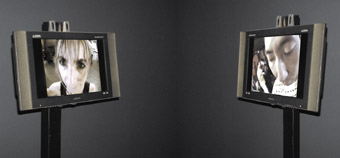
Julie Traitsis, Open Embrace
photo Amy Marjoram
Julie Traitsis, Open Embrace
THE DISCOMFORTING POTENTIAL OF NEXT WAVE’S 2008 FESTIVAL THEME “CLOSER TOGETHER” WAS REALISED IN JULIE TRAITSIS’ RELENTLESS VIDEO-LOOP OF A COUPLE DANCING THE TANGO AND MICHAEL MENEGHETTI’S LIVE PERFORMANCE ON A STRIP CLUB STAGE. THE WORKS EXPOSED “IDEAS OF CLOSENESS AND ITS CONFLICTED NATURE” BY ENTANGLING THE AUDIENCE IN THE AWKWARDNESS OF PROXIMITY.
With his feet encased in strap-on stilts and his arms in crutch-like supports, Michael Meneghetti clambers on all fours up the stairs on to the stage at the Men’s Gallery. Crouched like a praying mantis on these simple splints of untreated pine, he stalks the length of the stage. His face is obscured by a homespun version of a gimp mask as he purveys the packed-in crowd who holler enthusiastically as he begins to gyrate.
Meneghetti’s kinky shed fashion is rawer in construction than clear acrylic stripper heels, but it similarly exacerbates the tension in his movements as he laps his crotch about the club’s silver poles. The splints force him into a slow elevated crawl that’s animalistic and oddly slinky, his pace matching the strippers in the downstairs bar who slither about like stoned snakes.
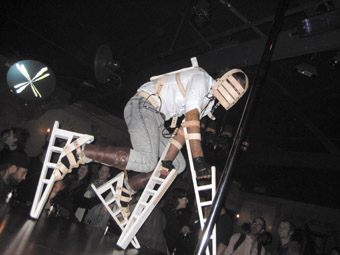
Michael Meneghetti, Vixen
photo Paul Chan
Michael Meneghetti, Vixen
In this work titled Vixen, Meneghetti seems strangely vulnerable, the blockish wooden saddle complete with stirrups strapped to his back mocking his tenuous position perched on stilts. Yet he also displays much physical strength and stamina as he hoists himself about. The contrast creates a tension that had been similarly apparent in Meneghetti’s Goanna Pull Contest (VCA Student Gallery, Victoria Park Gallery, 2006). That performance enacted an unusual country game between two men who lie on the ground facing each other. They are joined together by a leather belt strapped around the backs of their heads, then with their backs arched and their arms braced against the floor they proceed to try to drag one another forward tug-of-war style. Brute aggressive force was coupled with the clear pain of the exercise; the pure competitive, albeit stupid, machismo made for strangely gripping viewing.
Vixen was equally compelling, feeding off the hyped up, lurid surrounds of the strip club. This time the elevation of Meneghetti’s bent body was accentuated by the height of the stage, and the no-touch etiquette clearly applied to his threateningly precarious prowling. The carpentry body extensions were consequently both constricting and protective. As was the mask made of slotted wood that hid his face from voyeurs (much like the peculiar expression of satisfied boredom worn by strippers) whilst also appearing stiflingly claustrophobic.
The artist’s restricted movements pointed both to the (typically male) striptease audience hobbled by rules that restrict their responses and to the strippers who writhe about in the spotlights that were now highlighting Meneghetti’s tight-fitting, acid washed jeans. The physical limitations Meneghetti imposed on himself referenced the whole convoluted power dynamic of the striptease, stripped of clothes, stripped of money, either way you are exposed and you are performing.
Julie Traitsis’ video installation Open Embrace occupied the quieter, confined darkness of the AV gallery at Kings ARI. Invasive camera footage awkwardly enfolded the viewer into a tango embrace, Traitsis having strapped video cameras to the heads of a dancing couple. Two screens opposite each other showed the dancers’ looming faces as they self-consciously concentrated on their steps. The footage also offered peripheral glimpses of a suburban tango school with other couples in denim and tracksuits hesitantly practising the ‘dance of desire.’
The couple took turns wearing the camera-helmet as they rehearsed. The resulting neatly synched videos suggest simultaneous filming yet the recording contraption is never visible. This furthers the sense of intrusion, the viewer feeling pressed between the couple like an invisible chaperone; the unrelenting closeness of the head-held camerawork and the embedded flow of its movements turning the intimacy of the Open Embrace tango into a claustrophobic vise. As well, the privilege of being able to stare was made discomfortingly complex by the couple’s trust in Traitsis’ intervention. Their stilted expressions as they try hard to disregard the camera’s presence are awkwardly endearing, depicting the gentle discomfort of trust. With the humour of the situation quietened by this unexpected response to their predicament, Open Embrace becomes a genuine and disconcerting study in the complicated dynamics of proximity.
Engaging with Open Embrace is undoubtedly an awkward experience. Despite the closeness of the couple their tango is one of technical restraint, the effect disquietingly void of desire. The installation exacerbated this quality, with the flat screens mounted on clunky stands like hybrids of gym equipment and art easels. These heavy supports stood apart, allowing room for the audience to enter the dancers’ bisected embrace.
Lured like an insect into this space lit up by screens, the viewer attending to one video has the ever-present sense of the other behind them. This created an urge to oscillate attention between the screens, a pressure of captivation akin to the dancers avidly locked on their timing. Wedged in the intimate space of Traitsis’ arrangement, the spectator becomes embedded in and tries to keep up with this skewed adaptation of desire.
Michael Meneghetti, Vixen, part of Nightclub 1, Pure Pleasure, curator Ulanda Blair, Next Wave, The Men’s Gallery, May 21; Julie Traitsis, Open Embrace, part of Next Wave’s Remote program, Kings ARI, May 9-31
RealTime issue #86 Aug-Sept 2008 pg. 46
© Amy Marjoram; for permission to reproduce apply to realtime@realtimearts.net
“A GOOD OUTCOME”, TRUMPETS THE AUSTRALIAN’S EDITORIAL ON JUNE 7 AFTER CRIMINAL CHARGES WERE DROPPED IN THE HENSON AFFAIR. THE OZ DECLARES IT A “MORAL PANIC”, HYPOCRITICALLY REAFFIRMING ITS FENCE-SITTING POSTURE THROUGHOUT. IT THEN PROCEEDS TO DISTRIBUTE “LESSONS TO BE LEARNED” IN THE INTERESTS OF FREEDOM OF EXPRESSION FOR ALL CONCERNED—CHILD PROTECTION ACTIVIST HETTY JOHNSTON, THE POLICE, THE ARTS COMMUNITY AND ESPECIALLY THE REGIONAL GALLERIES WHO REMOVED HENSON’S WORK. EVERYONE EXCEPT PRIME MINISTER KEVIN RUDD AND THE MEDIA, OF COURSE.
Paul Sheehan, always quick to jump on a controversial bandwagon, wrote off Henson and his supporters in a Sydney Morning Herald piece, “Artists Crying Out for Martyrdom”:
If you confront people long enough, don’t whine when you yourself are confronted. If you mine the terrain of adolescent sensual awakening for commercial gain, if you spend years living on the artistic edge, while gaining public attention and financial reward, don’t complain when your actions begin to carry the taint of exploitative voyeurism. (SMH, May 26).
Note the pseudo-biblical cadences of these phrases and the innuendo masquerading as moral outrage, conveyed by the word “taint.” It’s Sheehan who’s imposing the “taint”, not Henson. Miranda Devine’s one foray into art criticism argues that “comparisons to Caravaggio and Michelangelo miss the point that Henson’s art is photography, which has none of the ambiguity of painting” (SMH, May 25).
Really? So photography cannot be as three dimensional as painting? There’s a long history of photographers out there since the invention of the daguerrotype demonstrating otherwise. You may not find their photos in Dolly magazine but you will find them in the most reputable art galleries around the world.
The most comprehensive account of the Henson exhibition to be published in the press comes from Roger Benjamin, a research professor in the history of art at Sydney University, whose review of the exhibition, which he was one of the few to see before it was raided by NSW police, states that:
Henson’s figures are neither pornographic nor commercial…In so far as they deal with sexuality at all, they tend to confuse, not to excite. This is because they project mixed signals…Understanding is stretched, things do not add up, and the viewer’s senses are troubled. (The Australian, May 31).
In other words, Henson’s work confronts and disturbs the spectator, which is surely the task of all serious art.
Henson’s comments in a 2002 ABC documentary, re-screened by the ABC after the controversy began, that his work is often appreciated by young people, suggest that the general population, including the parents of the adolescent girls Henson has photographed, may not all be outraged by his work. Indeed, up until now, apart from the 65,000 who saw his 30 year retrospective in Sydney in 2005, which passed without any adverse comment, most people appear to have been unaware that Henson’s work even existed. The woman who commented on the letters page in the Sydney Morning Herald that she’d rather her 13 year old daughter go to an “(uncensored) Bill Henson exhibition than read a Dolly magazine” (SMH, May 26) may be part of a rising groundswell.
On the rather risky assumption that at least some of the letters published in the Sydney Morning Herald might represent the ‘general population’, I’d like to single out the comments of Zuzu Burford from Heathcote, who wrote: “There is a certain irony that World Youth Day is being held by an organisation that successfully covered up paedophilia for several decades in a city where art is confiscated as pornography” (SMH, May 26).
I teach and write about music, film and cultural studies, and I have cited Henson’s work when talking about photography, the gaze, voyeurism, fetishism and the spectator, but also as an example of photography that is provocative, edgy and disturbing in its use of adolescent bodies in contexts that sometimes might appear sexualised and are sometimes placed in abject, even degrading contexts. But I strongly believe in the seriousness and sincerity of Henson’s purpose and the strength and power of his artistic statements. I’ve never tried to influence my students’ thinking about his work, but I have confronted them with it and encouraged them to engage with it in the same way I have with other contemporary artists such as Tracey Moffatt and Cindy Sherman.
An education kit available online for 9-10 (Middle Years) and 11-12 (HSC and VCE) students (www.artgallery.nsw.gov.au/resources/ed_kits/bill_henson), contains at least two images of adolescents that could be considered provocative and disturbing, but which are clearly not pornographic. In it, Henson says in an interview with Sebastian Smee:
I’m interested in that tender proximity, that ineffable, fragile, breathing closeness or presence which photography can animate while, at the same time, allowing no possibility for any familiar connection with the individuals in the picture. (Art Monthly, July 2006).
When interviewed on the cable television channel Ovation by Leo Schofield, Henson talked about the need for “distance” in his work, “without compromising the subject.” I interpret this as respect for the privacy of his models and a desire to photograph them with a sense of authenticity and honesty which is the exact reverse of any sense of exploitation. Robert McFarlane sums up well the dilemma of many spectators in responding to Henson’s work:
Henson is a master at remanufacturing the ineffable ennui of the young and freezing their emotions within the borders of large, well-crafted, mostly colour photographs…His images of vulnerable young faces sometimes hover dangerously close to fashion photography clichés, with subjects suggesting a maudlin scent of self-indulgence. Closer inspection, however, reveals a different, deeper reality. (SMH, July 11, 2006).
It’s that “closer inspection” that is all-important. I believe that many people who dislike Henson’s work don’t, or refuse to, engage in the inspection it demands. Henson’s subjects are not flirtatious, and his works are suffused with an edgy ambiguity which sometimes, but by no means always, gives them their power to disturb as well as be admired. Some who do engage with the work will be justifiably disturbed by it. But as John McDonald puts it:
…even Henson’s detractors must admit that his photographs are ineffably beautiful. They portray the human figure as fragile and mysterious—in the same way that he transforms the twilight world of the suburbs. His subjects are no longer children, but not yet adults. They are caught between night and day, between freedom and responsibility. (SMH, May 24).
I find the image of the adolescent girl at the centre of the controversy extraordinarily beautiful. The lighting and the use of shadow is masterful and, yes, very Caravaggio-like, and there’s a glow to it which is almost numinous. It reminds me of seeing Renaissance paintings in galleries in Italy projecting a three-dimensional radiance and an ‘aura’, to use Walter Benjamin’s term, which is usually obliterated in reproductions. There is a warmth and a vulnerability in many of Henson’s subjects that evokes feelings of tenderness. I am in no way titillated, or sexually aroused by this image at all, as I might be by pornography, and I am not ashamed to admit I do look at pornography occasionally, although you won’t find any on my computer.
I am very moved by the young woman’s modesty and sense of innocence in Henson’s photograph, and the way she delicately places her hands over her groin. She is in an in-between, girl-woman zone which radiates beauty and delicacy and the only desire she invokes in me is a feeling of protectiveness. There’s a peacefulness and a serenity in Henson’s image which places it far beyond the ‘taint’ of pornography—it’s simply too beautiful to be pornographic or exploitative. As Roger Benjamin suggests:
This strange photograph is disturbing. We are compelled to look, and look again…The power of the image comes from the striking beauty of [the girl’s] facial features, superb in definition, held against the abjection of her body.(The Australian, May 31).
It engages, challenges, confronts and moves us, even if the ‘us’ in this article is predominantly male. And there is no doubt that there are differently gendered and highly subjective responses to Henson’s work; I have had arguments about it with a number of women. It’s also notable that most who have come to Henson’s defence are men. But I believe the image desexualises its subject. Her barely formed breasts and obscured pubic area project a sense of modesty and even chastity. When I sent the image to a colleague, feminist writer Debra Adelaide, who has a teenage daughter, she agreed it was “beautiful” and commented, “it’s almost as if he’s honouring her.” She also pointed out that she found it confronting, “like most good art should be”, in the sense of challenging the spectator to revise rigidly imposed ways of thinking about the representation of young adolescents and the ‘taint’ of sexualisation.
One of the more alarming aspects of the Henson case is that a number of pre-teen children I’m acquainted with, directly or indirectly, were fed knee-jerk responses to Henson’s images as ‘pornographic’ by their teachers. On the other hand, when I finally got to see the Roslyn Oxley9 exhibition the day before it closed—an extremely powerful, moving experience which demonstrated how tightly integrated into a photographic narrative all the images, human, landscape and still life were—there was a group of secondary school girls on a field trip to the gallery giving the photographs serious and thoughtful attention.
One could argue that other images by Henson are more voyeuristic, although I would suggest that they challenge the spectator’s sense of voyeurism, and draw attention to the fact that everyone to some extent is a voyeur. Martin Sharp’s comments that the model in the photo singled out for media attention, and mutilated in the process, “gave her trust to Henson…and this trust has been violated by the police and Kevin Rudd’s comments” sums up the degree of ‘taint’ to which Henson’s work has been subjected by a media beat-up.
Of course Miranda Devine had to have the last word on the subject after the media beat-up died in the water, suggesting that “If art…is a mirror to a society and its values… community tolerance for underage exploitation has found its limits” (SMH, June 14-1). For her argument Devine marshals an army of moral majority supporters led by Chris Goddard, Director of the National Research Centre for the Prevention of Child Abuse, at Monash University, along with “40 psychologists, social workers and child-protection advocates”, including priests, counsellors and artists Michael Leunig and Allan Zavod. I have no doubt that David Marr’s forthcoming book on the Henson case will tease out all the complexities surrounding the issue as well as its broader social and moral ramifications in terms of the confusion of serious art works with child pornography.
This article is an edited version of a seminar paper, titled “Bill Henson: An Appreciation”, given by Tony Mitchell at UTS, Sydney, June 5
RealTime issue #86 Aug-Sept 2008 pg. 50
© Tony Mitchell; for permission to reproduce apply to realtime@realtimearts.net
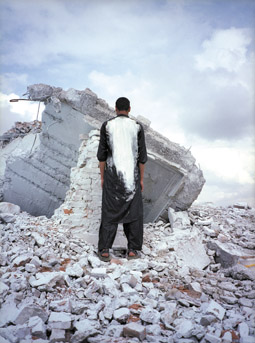
Linda Abdul, White House, 2005 (video still)
IN THE LEXICON OF INTERNATIONAL RELATIONS, SOFT POWER IS THE ABILITY OF A POLITICAL BODY TO INFLUENCE OTHERS, TO MAKE THEM “WANT WHAT YOU WANT.” IN SOFT POWER, AN EXHIBITION OF CHINESE VIDEO ART AT ADELAIDE'S CACSA, THE TERM OPERATES MORE LOOSELY AS AN ARRAY OF ADAPTIVE AND RESISTANT FORCES ROOTED IN THE SYSTEMS AND ARTEFACTS OF CULTURAL IDENTITY IN CONTEMPORARY ASIA. IN HIS CATALOGUE ESSAY, CURATOR SHEN QIBIN CHARACTERISES SOFT POWER AS “FORCES THAT ARE NOT ONLY INVISIBLE, MINUTE AND CRYPTIC BUT ALSO FLUID AND TRANSFORMATIVE.”
This is a slippery idea, one that video as the choice of medium in many ways works against. The sleekness of the video image, the assumption that it shows only a ‘truthful’ reality and the flat observational style of many of these works means that they seem at first viewing to present only a single view, an impermeable surface reflection of reality incapable of expressing multiplicity and complexity. For small and fugitive forces to emerge from the hard frame of video requires a type of open attentiveness in which acts and events—that seem to be only everyday—emerge as the markers and points of minute cultural negotiation.
Gulnara Kasmalieva and Muratabek Djumaliev’s (Kyrgyzstan) large scale video, A New Silk Road: Algorithm of Survival, is suffused with a fluid energy. Filling a room, it depicts the contemporary activity of the Silk Road, men collecting scrap metal, container trucks moving through the starkly beautiful landscape to a marketplace where clothing is produced and wrapped in plastic for transport elsewhere. The strong horizontality of the screens and landscape—with the Silk Road extending out of frame—creates a sense of travelling through, of trajectories reaching out, and the invisible flows of trade that have shaped these spaces for centuries.
The journey takes on the form of a pilgrimage as the drivers stop at various waypoints, a village with soccer playing kids where they sing and play accordion, a field culvert where they wash their trucks, the boy and horse who seem to have emerged from the landscape. These events and the Silk Road itself as a constant unwinding presence are markers of the adaptiveness and persistence of identity. As an algorithm is a series of steps for problem solving, the journey is a series of transformative leaps, energy moving from state to state, from that embodied in metal, to that of production and released in song to the momentum of travelling trucks.
This sense of transformative power is shared by Lida Abdul’s White House (Afghanistan) where small events (boys selling scavenged bricks; a woman continuously whitewashing the ruins of a house; the man who comes to stand in it) become powerful acts of reclamation. The transformation of energy through the smallest act suggests an exercise of power.
Erasure is at the core of Qui Zhijie’s Grind the Tombstones (China) and Chen Cheih-jen’s The Route (Taiwan). Zhijie ground two headstones (one western 19th century, one a 1500 year old Chinese grave marker) together eventually eliding the inscriptions altogether.The prints taken from the stones at various stages of erosion are readable from either direction as emerging from or reducing to blankness, a to and fro motion creating a precarious equilibrium between existence and erasure.
Where Grind the Tombstones elides the marks of history without changing it, in The Route Korean dock workers’ tactical restaging of a picket line links them to a history from which they were originally omitted. Filmed in black and white with archival footage and resonant with slogans used in the 1997 British dock strike—“Change the outcome”, “Reclaim the future”—The Route intervenes in the past to do exactly this.
The tiny accommodations of cultural change are as awkward as the children in Leung Mee Ping's Don’t Blame the Moon (Hong Kong). Dressed in their best, placed in front of various deities (Buddha, Christ, Krishna) and stating their ambitions to camera (“I’m Irshad, I want to be a teacher”) the children are as trapped by these bland statements as they are within the frame. Mahmoud Yekta’s (Australia/Iran) uncomfortable installation Slogun (the screen placed in the ceiling above a hospital bed in the gallery), unsettles with its images of floating fire, ice and oil on water and a boy’s nightmarish story, and in its disconnection from anything: the total elision of the power to know and locate oneself.
Soft Power is held together by the idea of multiple forces invisibly at work, of minute change wrought at the level where it is sensed rather than seen and the most successful works are those that convey this sense of energy loosed and transformed.
Soft Power: Asian Attitude was originally exhibited at Shanghai Zendai Museum of Modern Art in November 2007, and curated by the museum’s director Shen Qibin, with Binghui Hangfu & Biljana Ciric. Selection for CACSA by executive director Alan Cruickshank.
Soft Power: Asian Attitudes, curator Shen Qibin, Contemporary Art Centre of South Australia, June 6-July 13
RealTime issue #86 Aug-Sept 2008 pg. 48
© Jemima Kemp; for permission to reproduce apply to realtime@realtimearts.net
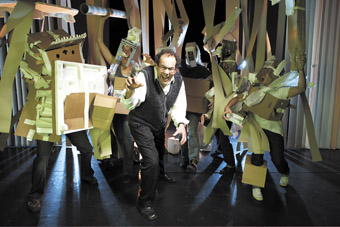
Chunky Move, Two Faced Bastard
photo – Jose Jorge Carreon
Chunky Move, Two Faced Bastard
MELBOURNE INTERNATIONAL ARTS FESTIVAL ARTISTIC DIRECTOR KRISTY EDMUNDS FREQUENTLY MAKES THE POINT THAT HER FESTIVALS ARE NOT THEME-DRIVEN, AND CERTAINLY THE DIVERSITY OF CONTENT GRAVITATES AGAINST ANY EASY ASSUMPTIONS OF CONNECTEDNESS. BUT CONNECTIONS DO EMERGE SUBSEQUENT TO PROGRAMMING, SHE SAYS AT A PRESS BRIEFING IN SYDNEY, DESCRIBING MANY OF THE SELECTED WORKS THIS YEAR AS “ECSTATIC AND CELEBRATORY, OPTIMISTIC EVEN.” ONCE AGAIN EDMUNDS HAS CURATED A FESTIVAL FOCUSED AND DIVERSE, CHARACTERISTICALLY IDIOSYNCRATIC AND RICH IN AUSTRALIAN PREMIERES (FROM MELBOURNE ARTISTS), ALONGSIDE INTRIGUING VISITING WORKS INCLUDING AN ABIDING AND INSTRUCTIVE NORTH AMERICAN PRESENCE.
patti smith
The placing of iconic American choreographer Merce Cunningham ‘in-residence’ at the centre of Edmunds’ 2007 festival allowed for a constellation of related artists and works to give weight to the celebration of a figure who anticipated and still realises the riches of artistic hybridity. In 2008 Edmunds has given welcome prominence to another American artist, a generation on from Cunningham, but with a similar network of connections across artform practices: the avant-garde poet, rocker and photographer, Patti Smith.
Smith’s residency includes two exhibitions: Patti Smith: Photography & Installation, focusing on the artist’s photography from 1967 to 2007, and Objects of Life, a companion piece to a biographical documentary by Steven Sebring titled Patti Smith: Dream of Life. The film, shot over 11 years, has its Australian premiere in the festival. Objects of Life comprises 14 large photographs by Sebring of Smith’s personal artefacts (“a childhood dress, an ancient urn containing the remnants of Robert Mapplethorpe…”) and a video of Smith in the act of painting.
Smith will give two concerts with her band and a third, more intimate one with Philip Glass in a celebration of the great American poet Allen Ginsberg in words and music. Both artists had performed with Ginsberg. Glass will also be celebrating the poetry of Leonard Cohen in Book of Longing (which had its Australian premiere at the 2008 Adelaide Festival). Two of Glass’ musicians, Andrew Sterman and Mick Rosso will present their own concert of originals and improvisation. Completing the American contingent, which also includes choreographer Deborah Hay (see below) will be the Grammy Award-winning sextet eighth blackbird in The Only Moving Thing, featuring new works by Steve Reich and Bang on a Can’s David Lang, Michael Gordon and Julia Wolfe.
the other music
Other music in the festival program comes from a very different tradition as exemplified in the program of Reinbert de Leeuw’s always adventurous Netherlands’ Schönberg Ensemble, performing works in concert by Louis Andriessen, Mauricio Kagel and Schönberg, but also John Adams. A second concert will feature works by the late Gyorgy Ligeti and Australia’s Michael Smetanin. Barrie Kosky will direct Australian composer Liza Lim’s opera The Navigator which premiered at the recent Brisbane Festival (the co-commissioner of this work with the Melbourne Festival).
Australian Indigenous music is represented on a large scale in The Black Arm Band and Melbourne Symphony Orchestra collaboration on a new compilation titled Hidden Republic, again drawing on the many forms of Aboriginal song from the perspective of Australian history and politics.
theatre
As is usual, local artistry is prominently on show in Edmunds’ festival. On the theatre front, the wonderful Back to Back Theatre will perform at Malthouse with the experimental music trio The Necks in Food Court, a part-concert, part-theatre work about humiliation experienced in public places. The long-awaited new Jenny Kemp work, Kitten, described in its press release as travelling “from the depths of despair to immense hope” should be a festival highlight, created in collaboration with Malthouse resident designer Anna Tregloan (promising a set-cum-installation that will transform the Beckett), composer Darrin Verhagin and choreographer Helen Herbertson. The Eleventh Hour, in their continuing exploration of classic texts and the meanings and other cultural items that constellate around them will stage their “nauticalised” Samuel Beckett: Endgame with Bach’s Chaccone.
Other local productions will greet audiences on the streets or take them to a suburban house or a workspace. Director-writer David Pledger’s performative installation, The Meaning of Moorabbin is Open for Inspection, will engage audiences with the auctioning of a red brick home. The Suitcase Royale will collaborate with the UK’s Lone Twin (Melbourne Festival, 2005, RT70, p5) on Newsboys, an evocation of an era when you could hear the news headlines spieled on the streets—which is just what Suitcase will do with words provided by Lone Twin. Melbourne live art performers Panther (Sarah Rodigari, Madelaine Hodge) will present Exercises In Happiness at a car tyre outlet, testing their audience’s expectations of life with questions and exercises. Polyglot Puppet Theatre will stage The Big Game—a huge board game for children in which the kids make the rules.
From Lithuania comes OKT/Vilnius City Theatre with their three and a half hour version of Romeo and Juliet, the family factions this time rival pizzeria owners. Belgium’s Victoria presents UK writer Tim Etchells’ (of Forced Entertainment) That Night Follows Day featuring 16 performers aged nine to 15 years of age re-enacting the mysterious ordering imposed on them by adults. Canada’s STO Union presents George Acheson’s 7 Important Things, a real-life barber’s reflection on the meaning of the 60s and the profound challenges of democracy, performed by the writer with the show’s director, Nadia Ross.
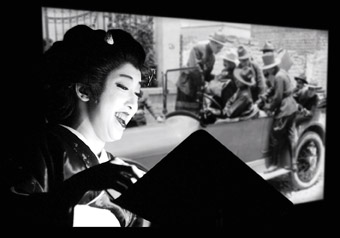
Teatro De Ciertos Habitantes, El Automovil Gris
performing with screen
Other live performances use film: “In 2007 DJ Spooky, America’s Paul D. Miller, went to Antarctica to record a film about the sound of ice…Terra Nova Sinfonia Antarctica is the result. This large-scale multimedia performance work transforms Miller’s first-person encounter with the harsh, dynamic landscape into multimedia portraits with music.” Mexico’s Teatro De Ciertos Habitantes performs to the 1919 silent classic El Automovil Gris (The Grey Automobile, about a gang exploiting the chaos of the Mexican Revolution; director Enrique Rosas), a small cast voicing some 50 characters in the traditional Japanese Benshi narrational style. Another classic is given new life with American composer and instrumentalist Philip Johnston performing with a singer and ensemble of musicians to FW Murnau’s powerful 1926 expressionist Faust (reviewed RT81, p26).
dance
Local dance is also strongly represented with new works from established artists. Working with an interior architect, Donald Holt, and a Japanese composer, Haco, Lucy Guerin builds her audience into the set of Corridor which explores the anxieties engendered by certain spaces and contemporary media technologies. Guerin is also co-creator with Gideon Obarzanek of Chunky Move’s Two Faced Bastard, this time inviting the audience to take the performers’ point of view, from a kind of backstage from which they glimpse the actual performance—or two performances in this dance play with the real and actual. Helen Herbertson and Ben Cobham premiere their new work, Sunstruck. KAGE’s Appetite brings together vocalist New Buffalo, playwright Ross Mueller, Kennedy Nolan Architects and performers to address a female mid-life crisis—”Can she reverse the side effects of contemporary life? Undo the damage done and find a new appetite for life?” You have to be there.
The festival’s international dance guests are Israel’s Batsheva Dance Company, and the influential choreographer and teacher Deborah Hay. Kristy Edmunds promises “a rejuvenated choreography” from Batsheva’s Ohad Naharin, which is to be hoped for after the vigorous but empty formalism of the company’s appearances at Adelaide and Sydney Festivals. The Deborah Hay Dance Company will perform If I Sing To You, originally commissioned by the Forsythe Company for an April premiere in Germany this year. Idiosyncratic UK movement and theatre artist Wendy Houstoun (one time DV8 collaborator and mentor for the Fondue Set’s new show, p36) presents Desert Island Dances and a re-staging of her seminal work, Happy Hour, seen in Kings Cross many years ago in a tiny bar: in Melbourne it’ll be seen at the festival’s Beck’s Bar.
sound
Sound culture makes a rare substantial Australian festival presence this year with two large scale hearings: echolocation, an electro-acoustic installation from US sound artist Alex Stahl, and 21:100:100, an exhibition, developed by Gertrude Street Contemporary Art Spaces, of 100 21st century sound works in concert and installation curated by Oren Ambarchi and Marco Fusinato. Echolocation refocuses our hearing so that dusk and dawn bird calls (miked beneath Princes Bridge and played across the city) are given due prominence alongside human noise. Mobile phone users will be able to ‘conduct’ the work and add their own voices to it.
On the interactive media art front, Australian artist Lynette Wallworth (RT79, p2) will premiere Evolution of Fearlessness in which audience touch triggers unspoken responses from women who have migrated to Australia after suffering horrifying experiences in countries such as Afghanistan, Sudan, Iraq and El Salvador. If the festival’s implicit if unplanned theme is about the passage from despair to celebration, ecstasy even, then Wallworth, along with Jenny Kemp, KAGE, The Black Arm Band and others, might tell us how to bravely travel Lucy Guerin’s narrow corridor to fearlessness or, at least, sense the pain and courage of others who have made the journey, actually or imaginatively.
Melbourne International Arts Festival, Melbourne, Oct 9 – 25, http://www.melbournefestival.com.au
RealTime issue #86 Aug-Sept 2008 pg.
© Keith Gallasch; for permission to reproduce apply to realtime@realtimearts.net
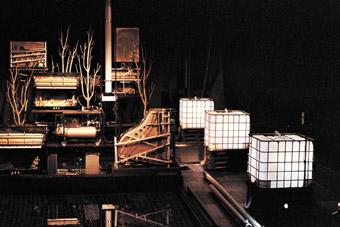
Stifters Dinge
photo Dimitri Lauwers
Stifters Dinge
THE KUNSTENFESTIVALDESARTS’ CENTRAL MEETING POINT IS BUZZING WITH PEOPLE, PEN IN ONE HAND, BEERGLASS IN THE OTHER AS THEY GATHER AROUND LONG TABLES COVERED IN PAPER. THE SCRIBBLINGS, DOODLES AND WINE STAINS INVITED BY COSTUME DESIGNER VALENTINE KEMPYNCK REVEAL AN ABUNDANCE OF LANGUAGES AND STORIES. PRESENTING 31 PROJECTS FROM 16 COUNTRIES, INCLUDING WORK FROM THE LOCAL FLEMISH AND WALLOON COMMUNITIES, THE 13TH EDITION OF THE PERFORMING AND VISUAL ARTS FESTIVAL PROMISED A MULTITUDE OF VIEWPOINTS AND VOICES, AND FOCUSED ON KEY CONVERGING THEMES: COMMUNITY, FESTIVAL OF LANGUAGES, END VERSUS BEGINNING. THE PROGRAMME ASKS, “WHAT, TAKEN TOGETHER, DO [THESE VOICES] HAVE TO SAY?”
Heiner Goebbels’ Stifters Dinge opens the festival with a majestically breathtaking theatre installation that pays homage to nature through musical, visual, sculptural, elemental composition. Two technical assistants manoeuvre tubes and powder before leaving us alone with this pulsing, breathing creation: an automaton that at moments seems to move into its own quasi-organic rhythm. It faces us, three enormous shallow rectangular pools filled with water from luminous tanks. Bordered by rows of speakers, it emits both strange and familiar languages, as pipes clunk and lights cross-fade from murky greens through dusky sepia to crisp blues, and occasionally flash blinding white. The heart of this machine lies beyond the pools, sometimes obscured by screens that rise and fall reflecting ripples, picturing a forest. As its shapes are revealed, we can make out sheets of metal, bare branches and five grand pianos heavily rooted at unexpected angles and levels. Gutted, modified, hybridised, encased in scaffold skeletons, the exposed innards of these instruments are electronic circuits forming new nuclei to control its tendon strings.
Each element of this musical box is visible: sheet-metal flexed for bass and piano keys depressed to sound melancholy chords. This industrial landscape reconstructs rain, mist, a sunset inside its metal confines. A lone piano plays Bach as showers fall into the pools through icy blue light. Later, the whole sculpture creeps towards us as another piano hurls jagged notes that become increasingly frantic, chromatic scales running out of control to a filmic climax until it halts, towering threateningly above us just metres away. But this is not the danger of raw nature. Goebbels and his team exercise precise control over this shifting landscape, ironically underlining human inadequacy in any attempt to ‘save nature’ by making it our ‘project’: a tendency the festival program points up as symptomatic of our heightened sense of ecological responsibility.
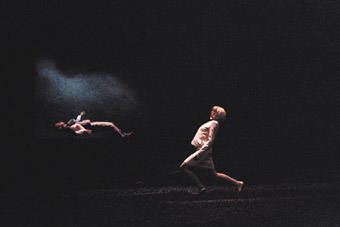
End
photo Catherine Antoine
End
Brussels-based Kris Verdonck’s End presents a similarly bleak outlook: a visually stunning apocalyptic landscape, a world that has suffered nuclear holocaust. Black clouds travel at an unnatural speed across the backdrop screen accompanied by crackling static and rumbling, ominous thunder. Black snow falls, covering the ground as nine figures repeatedly cross this desolate territory from one side to the other, always in the same direction, always on the same track. Their journeys are uncomfortable, restricted, burdened and, as time passes, they become dishevelled, their smart office wear loosened, sweaty, discarded, blackened. One man strains to inch forwards pulling a heavy load far behind him on the end of a taut rope, out of sight. Another man crosses inside a glass case, live birds fluttering around him as he describes horrific images of this decaying world: bombing, mutations, soldiers forced to continuously stare because their eyelids have dropped off in the cold, the corpses of schoolgirls bent over water tanks. A platinum blonde woman dressed head to toe in white makes her journey in contorted slow motion movements, echoing the distortions the speaker describes.
A terrifying growling, glaring beast lurches across; a car engine suspended in the air. Loudspeakers on wheels pass by, amplifying shrill, chilling operatic voices. A solitary flame traces a line along the ground. These figures, trapped in some sort of cyclical post-Beckett dystopia, will not be offered any respite as they traverse this world, “relics of a past that was still intact a few days ago. ” The images bore into us like a stuck record, stylus forever locked in the same groove, and feed our nightmares long after the show has finished.
The audience for Regarding, a collaboration between Brussels-based performer Isabelle Dumont, filmmaker Annik Leroy and writer Virginie Thirion, are initially left to find their own way around Meinhof, Leroy’s three audiovisual installations based on the infamous leader of the Rote Armee Fraktion (a German left-wing post-1968 terrorist group) who was found dead in her prison cell. The cavernous space presents excerpts from her correspondence and slow, static films depicting images of isolation and incarceration.
Having circuited the screens, we gather on bare benches in another dark corner to watch Regarding. This three tiered performance slowly unfolds, interrogating our relationship with war photographs and deconstructing the way we view violent images. In further claustrophobic films from Leroy the camera looks down narrow corridors and hovers slowly over a war photograph. We can hear a female voice speaking Thirion’s text, which intricately describes a photograph of an execution, recapturing the viewer’s every thought as she envisages the moments leading up to the deaths depicted. In a rectangle at our feet Dumont lines up pots and tools, then gradually begins to apply pastes, liquids, chalk, earth to her body with surgical precision, transforming herself into a battered corpse lying before us.
Inspired by Susan Sontag’s Regarding the Pain of Others (2003) this multilayered experience attempts to act as a remedy to a media-exacerbated, trivialised, disposable attitude to images of suffering. Like Goebbels’ Stifters Dinge and Verdonck’s End, this is a performance of duration and repetition, but rather than the engaged interactivity of the previous shows, this work demands a distanced contemplation of the processes we undertake while experiencing reality and representation.
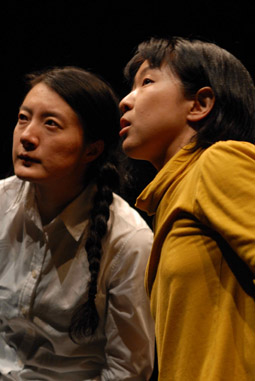
It is Written There
photo Lux Vleminckx
It is Written There
Tokyo-based Zan Yamashita’s It is Written There is a more formal exercise in sophisticated communication and its processes. On the way into the theatre each audience member is given a large square book of one hundred numbered pages, some of which display one word in both Japanese and English, some showing sequences of words, some with diagrams or stick figures. The program informs us that these have been compiled from Yamashita’s choreographic notes and Japanese pop lyrics, amongst other sources. Our task is to turn each page when its number is called. As we reveal a new page, four female dancers perform what we read. The translation from written to performed communication is complex and unpredictable: an arrow on the page triggers a sudden quick dash across the stage and we laugh in surprise, while “run” prompts a precisely executed slow motion sprint through a focused passageway of light, to the silence of the enthralled audience.
On page 21 there are raised white letters. Blackout, and the word is glowing: “STAR” appears on my lap, repeated tens of times throughout the dark auditorium. The relationships between word and image, static and time-based are examined with a playful energy, as charming, inventive ideas are presented to us page by page. Our books form a semantic barrier between us and the performers, interrupting our engagement with them, but also guiding us through a web of multiple interpretations: simplicity of physical composition and moments of stillness and silence leave room for an exercise in imagination. Despite the individual isolation of reading, the books bring the audience together as a community as we simultaneously turn pages and discover meanings. Could this distanced intellectual aesthetic provide some hope in the face of the destruction explored by the earlier performances? Perhaps contemplation and disengagement might allow an escape from a disturbing, cyclical future.
2008 Kunstenfestivaldesarts, Brussels: Stifters Dinge, concept, music, direction Heiner Goebbels, scenography, light & video design Klaus Grünberg, music collaboration Hubert Machnik, sound design Willi Bopp; Théâtre National, May 9-13; End, concept, direction Kris Verdonck, dramaturgy Marianne Van Kerkhoven, video Anouk De Clercq, music Stefaan Quix, light design Luc Schaltin, Kaaitheater, May 9-13; Meinhof, concept, realisation, camera Annik Leroy, editing Julie Morel, sound Marie Vermeiren; Regarding, concept, realisation Isabelle Dumont, Annik Leroy, Virginie Thirion, La Raffinerie, May 23-31; It is written there, direction Zan Yamashita, light design Asako Miura, sound design Mitsunori Miyata, book design Emi Naya, Beursschouwburg, May 9-13
RealTime issue #86 Aug-Sept 2008 pg. 54
© Eleanor Hadley Kershaw; for permission to reproduce apply to realtime@realtimearts.net
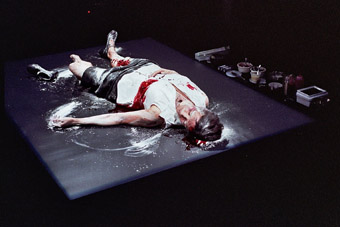
Regarding
photo Indra Van Gisbergen
Regarding
THE ACTOR ENTERS THE DARKENED ROOM, KICKS OFF ONE SHOE, AND LIES AWKWARDLY ON THE FLOOR. SHE LAYS OUT HER SUPPLIES: DISHES OF VARIOUS POWDERS, SYRINGES FILLED WITH RED AND BROWN CREAMS, AN ASSORTMENT OF LATEX APPENDAGES WRAPPED UP IN CLINGFILM. SLOWLY, METHODICALLY, SHE APPLIES THESE MATERIALS TO HER PROSTRATE BODY. A LONG, UGLY GASH ON HER LEG. A WOUND TO HER STOMACH, WITH BLOOD POOLING BELOW HER. CLOTHES CUT WITH SCISSORS TO GIVE THE IMPRESSION OF BEING TORN. A BULLET WOUND TO THE HEAD. AND SPRINKLED OVER THE WHOLE IMAGE, A LIGHT DUSTING OF ASH AND SOIL.
This is Regarding, a performance by Isabelle Dumont, accompanied during its hour duration by Virginie Thirion’s detailed and dispassionate spoken description of a snapshot of violence along with Annik Leroy’s projected film of photographs of war atrocities being casually handled and examined. Taking inspiration from Susan Sontag’s book Regarding the Pain of Others (2003), the piece is not just about the appalling nature of war but a live experiment into our reaction, as spectators, to viewing these images. Watching Dumont’s painstaking, but painless, reconstruction, I am always aware of the conceit—the piece does exactly what the brochure tells me it will, and there are no surprises. Except one. In the midst of my inner monologue, which ranges from questions of believability (is she using too much fake blood?) to those of situation (what would it mean to do this in a public space, rather than a darkened room for a paying audience?), I am interrupted by the unexpected turning of my stomach. Maybe it’s the pus from her abdominal wound, even though I just saw it come from a jar, or the efficient cruelty of the bullet to the temple, even though this is only the representation of cruelty. The image may be fake, but my reaction is suddenly real.
Brussel’s Kunstenfestivaldesarts has a long tradition of supporting new and experimental performance—for example, this year they presented Australian artist Rebekah Rousi’s tour de force, The Longest Lecture Marathon, first seen at the 2007 ANTI festival (RT 83, p30). This festival’s many co-productions included a Singapore collaboration, The King Lear Project, directed by Ho Tzu-Nyen and filmmaker Fran Borgia. The project had its first two parts shown on successive evenings at the Kunstenfestival and the trilogy was completed at the Singapore Arts Festival in June. The first part, Lear Enters, mixes reality television with traditional Shakespeare and postmodernist metatheatrics. Structured as a live audition before film cameras that continue to prowl the theatre, three actors successively choose from a menu of Lear archetypes they will attempt: Lear as god, Lear as madman, Lear as everyman. The set design, lighting, and soundtrack change according to their choice, and they give secret instructions to the ostensibly unprepared supporting cast.
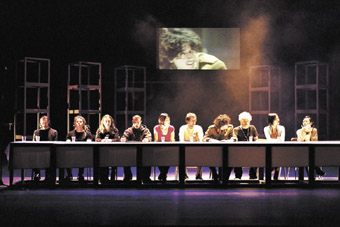
The Lear Project, Lear Enters
photo Roos Vandepitte
The Lear Project, Lear Enters
Although this live audition is clearly a contrivance, it is often convincingly spontaneous, as the Lear-wannabes improvise their audition banter and the rehearsed cast of supporting actors adapt to the shifting personalities. Additional complexity comes from interventions by an omniscient figure planted in the audience, who debates with the director during blackouts between each audition, drawing his arguments from significant works of Shakespeare criticism.
The experience is uneven, at times revelatory and at times simply heavyhanded—particularly during the second evening, which is presented as an open rehearsal within which three ‘problem’ scenes are tried in various permutations, with lengthy philosophising in between. But it saves its most wonderful moment for the very last: as we applaud what we think is the end of the production, the curtain rises on an empty stage, with all backdrops removed so that the rear wall of the building is visible. The huge stage doors open, revealing not only the cast and ‘film crew’ in the public park behind the theatre, but also small congregations from the local neighbourhood who have been enjoying a relaxing summer evening. As we continue to applaud, peering out into another world, a few of the outsiders notice us as well, and peer right back at our alien planet. It’s a stunning moment, when all the conventions and seriousness of the theatre world explode and dissolve upon exposure to the real world, and I feel caught in the act, unable to do anything more than just keep putting my hands together.
Another Kunstenfestival co-production is Rimini Protokoll’s Call Cutta in a Box, based around a one-to-one conversation with a call centre worker based in Calcutta. As with Regarding, much of the experience is what I expect it to be: I’m on the phone for most of the hour, and the conversation is directed along lines that evoke both the telemarketing profession’s appropriation of personal contact and the global economic factors of which outsourced Indian call centres are symptomatic. ‘What is the weather like where you are?’ ‘I hope you are healthy. Are you healthy?’ ‘Do you believe in reincarnation?’ I am wary of answering these questions, knowing that I am acceding to a proposition which is not yet fully known; that the friendliness with which they are asked is not genuine but designed to set up a situation in which I may find myself doing something I do not want to do.
But what’s curious about this experience is that it’s as much a comment on the conditions of theatricality as it is about economics or geopolitics. This is not so much a work about call centres, with an actor playing a call centre worker, as one in which the call centre worker plays herself. And what she is doing is always signed as play, as theatrical. This is indicated by the make-believe décor of the room I’m in, made up in exacting detail to resemble the offices of the Indian company for which she works. Or by minor illusions, charming but unambitious, such as when she claims to turn on the electric kettle remotely to make me a cup of tea. Or, most directly, when she asks me to lift up a desk plant, revealing a small box with tiny red curtains. Pulling the theatrical curtains apart reveals a web camera, via which she is then able to see me just as I am, at this point, looking at her.
Because of the doubling, in which she is herself and is playing herself, I have two overlapping frameworks within which to situate my reactions. I feel uneasy about my complicity in an arrangement where this woman is paid presumably low wages for my entertainment; but would I feel uneasy if her profession was that of actor, and if not, why not? I feel voyeuristic when she sends photographs of herself in social situations to the printer next to me, because it reminds me that she has a life outside of her job. But when an actor is working, why do I need to assume that this is what she most wants to be doing? Isn’t the idea that acting is its own reward, that the actor is enjoying revealing her true self, simply part of the ‘sale’ that the actor is trying to make with me? Finally, when this call centre worker makes her sale—which consists, she tells me afterwards, of my agreeing to sing aloud to her—she holds her phone out and asks, “Do you hear that? That is what we do when one of us makes a sale.” The sound I hear, piped over the internet from several continents away, is applause.
2008 Kunstenfestivaldesarts, Brussels: Regarding, concept, realisation Isabelle Dumont, Annik Leroy, Virginie Thirion, La Raffinerie, Brussels, May 23-31; The King Lear Project: Part 1, Lear Enters, Part 2, Dover Cliff and the Conditions of Representation, text and concept Ho Tzu-Nyen, direction: Ho Tzu-Yen, Fran Borgia, KVS, May 24-25; Call Cutta in a Box, concept Rimini Protokoll (Haug/Kaegi/Wetzel), Monnaie House, May, 9-31
RealTime issue #86 Aug-Sept 2008 pg. 55
© Theron Schmidt; for permission to reproduce apply to realtime@realtimearts.net
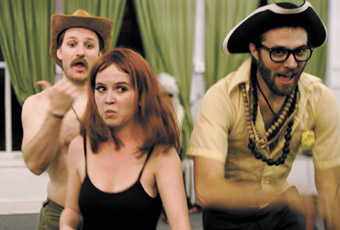
Nature Theater of Oklahoma, No Dice
photo Peter Nigrini
Nature Theater of Oklahoma, No Dice
GORDANA VNUK, THE ARTISTIC DIRECTOR OF EUROKAZ, RULES THE FESTIVAL WITH AN IRON FIST. SINCE ITS INCEPTION IN 1987, THE AIM OF EUROKAZ HAS BEEN NOT TO FOLLOW TRENDS IN NEW THEATRE, BUT TO ANTICIPATE THEM. CALLED, INTERCHANGEABLY, AN INSULT TO COMMON DECENCY OR A WASTE OF MONEY, AND ALMOST SHUT DOWN IN THE RELIGIOUS/NATIONALIST KITSCH IN THE POST-WAR CROATIA OF THE 1990S (WHEN THE CATHOLIC CHURCH RAGED AGAINST THE FESTIVAL’S PROPAGATION OF ANTI-FAMILY VALUES) IT IS THE KIND OF FESTIVAL AUSTRALIA WOULDN’T HURT FROM HAVING: AN ENERGETIC, VISIONARY PROCLAMATION OF DELIGHT, LESS ABOUT WHAT THEATRE IS, THAN WHAT IT COULD BE.
This year, a crosscut of the American avant-garde is coupled with a showcase of a very young generation of theatre-makers, pulled straight out of the Zagreb Academy of Dramatic Arts. Two worlds with colliding interests, you might think, but the first shared motif was confused multimedia. The brilliant Wooster Group questions that supposedly undeniable quality assigned to theatre: the immediate/unmediated reality of what we see on stage, the absolute truthfulness of the moment. The second and related motif resounds through the programs and discussions: performance is only detritus, a dead shell of the living, breathing creation that happens during rehearsal. To see something real, one needs to watch the rehearsal.
The stage is cluttered with TV and video screens, multiplying, flattening, displacing and subverting the images created there. The first part of Poor Theater: A Simulacrum is a reconstruction of The Wooster Group’s encounter with Grotowski: we see films of them watching a film of his Akropolis. Their visit to his studio in Opole, Poland, is both played on stage, with actor Sheena See performing Wooster director Elizabeth LeCompte, and on screen, as confusing footage from a hidden camera. The set turns out to be a re-creation of their New York studio, in which a detailed replica of Grotowski’s studio was made (including fake parquetry); here they perform their viewing of Akropolis with a simultaneous translation from Polish, and the last 20 minutes of a rehearsal based on completely re-creating Akropolis as it comes across from the film, in Polish. The second, shorter part is an homage to William Forsythe, his lecture re-created from tape with similar methods, culminating in a riotous madness that blends with the end of Akropolis.
Poor Theater, apart from being an ingenious essay in methods of transposition, continues The Wooster Group’s preoccupation with transmission of knowledge in the age of mass media: all older modes, from oral narration to guided learning, being increasingly replaced by the false didacticism of the screen. Everything on stage is a detailed simulacrum of a lost source: from the projection of ersatz New York parquetry, fragmented gesticulation of bodies cut up by film editing, conversations reported with stutter and repetition. The result is disturbing, often hilarious, and affectionate. For what the performance is about, ultimately, is The Wooster Group themselves, and their relationship with their theatre forebears.
Starting with traditional oral narrative as a model, Nature Theater of Oklahoma’s No Dice is an epic, four-hour replication of hours of telephone conversations between group members (ranging from artistic laments to complaints about work, drinking and eating disorders, to ‘dinner theater’ experiences). It employs tropes of oral epic (repetition, variation) which clash with the tropes of Shakespearian theatre (acts, climaxes), which in turn clash with the overturned tropes of good acting (misplaced foreign accents, hyper-articulation, exaggerated costumes). Modes of communication split apart, nothing quite matching: even the gesticulation employed is their own confusing invention (including, but not limited to, the sign of the cross, thumbs up, mimed wall and some nameless but recognisable gestures, such as intravenous drug use). It is a legible, but closed system of references, until it suddenly opens towards the end: the actors take their wigs and sunglasses off and address the audience: “The question is, what do we require in order to enjoy ourselves?” Communication itself, they conclude. Poignant, semiotically imaginative, intellectually provocative but emotionally rich, Nature Theater of Oklahoma’s performance—with its roundabout, illogical, confusing conversations—is a manifesto of faith in our ability to engage with each other through speech.
Cynthia Hopkins’ Must Don’t Whip Um is a high-energy concert/performance, or, as Hopkins introduces it, “a detritus geomancy dhikr”: a sufi ritual of remembrance and an attempt at divination from the remains of a life. The middle part of her Accidental Nostalgia trilogy, preoccupied with the ways one’s life and art are shaped by memory, narrates the disappearance of a fictional 70s pop artist turned sufi student, Cameron Seymour, through the obsessed eyes of her daughter Mary. Layers of representation peel off as the farewell concert we are witnessing is revealed to be Mary, performing in the staged reconstruction she devised from contradictory stories of people she met while filming a documentary on Sufism and Seymour. Mary’s failure to complete the documentary is admitted in filmed fragments (often simultaneously created on stage) in between Cameron’s raging songs, saluting a bellicose, consumerist America. This hybrid monster of multimedia, shifting personae, past and present, blending stage and backstage, is saved from collapsing into incoherence by its technical accomplishment and Hopkins’ charisma. The result lacks the profundity of some other works, perhaps, but was a welcome break from more serious, less danceable experimentation.
Some of the most interesting performances were student works. Generally less sentimental than their American colleagues, Croatian kids attacked form and convention with brio. Lutkina kuca—Zmija mladoženja (Doll’s House/Viper Groom), directed by Anja Maksic, takes Ibsen’s classic and literally empties it of content, replacing the realistic dialogue of the 19th-century bourgeoisie with a lesser-known fairy tale. The principal characters establish themselves in the opening minutes on an enormous bare stage which then collapses into a dreamlike, gauzy space, and the characters reappear as faces in the bedtime story Nora is telling her children, complete with the costumes, music and singing straight out of children’s theatre. Trapped within the cyclic, repetitive world of a popular fable, characters loopily recite Ibsen’s lines, allowing insight into the formal and fabulist clichés behind the text.
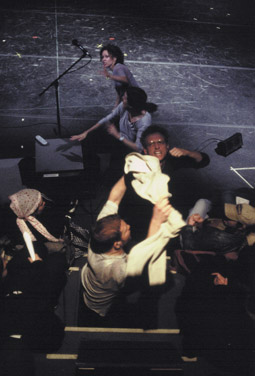
The Wooster Group, Poor Theater
photo Paula Court
The Wooster Group, Poor Theater
Neka cijeli ovaj svijet ili o…/Pokušaji 7, 8, 10 (Attempts 7, 8, 10) formally explores powerlessness. By setting up an enormous range of openings in the theatrical structure, Marina Petkovic teases out extraordinary results from performers and the audience in a way that belies her youth. Her actors drift off half-way into frustrated attempts to tell a story; the audience gleans information from silent video, unheard conversations, Petkovic herself interrupts to impose extra demands, ask questions, interrogate a well-known actor on his power within the spectacle machine. Given another performer’s tape recorder (“She mentions the urge to scream…can you respond?”), a dancer launches into a series of frustrated contortions, culminating in shrill cries, wails, howls; she never manages to scream, yet there is a riveting truthfulness in her search. The entire play, fresh and engaging in its unpredictable immediacy, can be identified as an attempt to forget the craft, sideline the rules.
There is, therefore, a third motif in the Eurokaz program: imperfection. This is often realised as dance—the seemingly absurd routine in between two acts of No Dice, its complex references only explained in the climactic ending; The Wooster Group’s loose carbon-copy of Forsythe’s choreography; and the circular, ritualistic repetition of A Doll’s House. Vnuk’s program draws connections between disparate theatre cultures, pointing out their shared, uncompromising desire to break out of mechanical form, to disregard the already-known. As Petkovic had announced, this is an attempt to create, not repeat.
The Wooster Group, Poor Theater: A Simulacrum, director Elizabeth LeCompte, Zagreb Youth Theatre, June 22-23; Nature Theater of Oklahoma, No Dice, concept, direction Pavol Liska, Kelly Cooper, Lado, June 23-26; Cynthia Hopkins & Gloria Deluxe, Must Don’t Whip Um, music, text Cynthia Hopkins, set, video, production design Jim Findlay, Zagreb Youth Theatre, June 28-29; Lutkina ku´ca—Zmija mladoženja, co-production Theatre &TD/ADU/Eurokaz, based on Ibsen’s A Doll’s House, direction Anja Maksi´c, Theatre &TD, June 22-23; Neka cijeli ovaj svijet ili O…/Pokušaji 7, 8, 10, concept, direction Marina Petkovi´c, Theatre &TD Café, June 28; Eurokaz International Festival of New Theatre, Zagreb, June 21– July3, www.eurokaz.hr.
RealTime issue #86 Aug-Sept 2008 pg. 56
© Jana Perkovic; for permission to reproduce apply to realtime@realtimearts.net
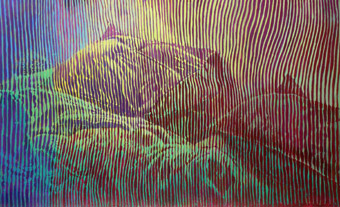
Line by Line, Dvora Morag
THIS INVITING GROUP SHOW OF THE WORK OF EIGHT ARTISTS—SEVEN OF THEM FEMALE AND IN A WIDE RANGE OF MEDIA—HAS BEEN THE LOGICAL FRUITION OF THE PHD RESEARCH OF CURATOR MARY PRIDMORE. HER OWN WORK, IN PAINTING, HAS RESPONDED TO THE PRE-EMINENCE OF THE MASCULINE IN MODERNISM. DREAM HOME SEEKS TO COLLECT AND CONTEXTUALISE CONTEMPORARY ART WHICH EXPLORES ‘THE DOMESTIC.'
The core of this show is a body of work by Israeli artist Dvora Morag, whom Pridmore met at the Cite Internationale des Arts, in Paris, in 2005. Her contribution to this show is from the series Line by Line, an acrylic on canvas which, in horizontal scroll format, documents the minutiae of domestic life, the fine details of interior spaces. Using strong colours and contrasts, Morag re-presents the home mimetically, her repetitive mark-making—vertical lines flickering over a figurative background—symbolise the repetitive aspects of daily chores.
This is a striking work; as an installation it was ‘meant to be.' Morag did not precisely measure the piece nor trim it to fit the gallery space, but as it was rolled out and displayed, it fit precisely the ‘Tall Gallery’ at the Plimsoll. With its subject matter the furnishings and features of any domestic interior, the work ‘reads’ as abstract from a distance and only falls into focus at close range. The over-painted lines have the flickering effect of early film stock. For subject matter, the artist very deliberately takes the unheroic and the ‘un-sexy’ and gives them significance and gravitas.
Morag takes the everyday and the ordinary and elevates and celebrates them. This response to the humble urban interior—the loungeroom or the boudoir, the realm of the female, the domestic, the day-to-day—informs Mary Pridmore’s research and, simultaneously and not a little contradictorily, reveals in the art world the often hidden significance of the female point of view. Pridmore believes that the domestic is now ‘out of the closet’ and a source of inspiration for contemporary artists.
All of the work in Dream Home, to a greater or lesser extent, takes elements of the domestic as its starting point, a potent symbol art making.
Carolyn Eskdale With Morag’s work setting the scene, the viewer discovers other artists exploring similar themes. Carolyn Eskdale’s on-going project of installations called, generically, “room”, deals with the processes and reconstruction of actual, remembered and imagined living spaces. This version is an installation of a reconstructed caravan annnexe and its adjacent room. It is eerily realistic, many viewers reporting a sense of recognition tweaked by the humble vertical blinds of the installation (apparently they are declasse these days).
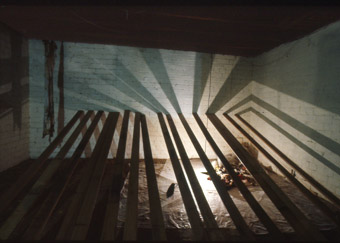
Pat Bassington, Book of Jonah
Pat Brassington’s sculptural installation, Book of Jonah, 1932, consists of floorboards leaning against the gallery wall. Underneath are some discarded items of her father’s, salvaged from his cellar. These small, trivial objects are instantly recognisable, expressing a sort of universality. A light source sends sharp, striped shadows onto the wall ‘echoing’ the lines in Morag’s work.
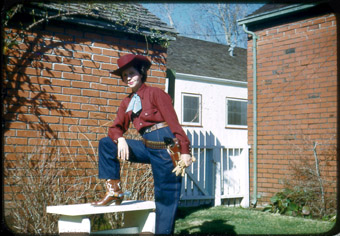
Elvis Richardson, Slide Show Land Dorothy
Elvis Richardson’s Slide Show Land Dorothy is created from a library of 30,000 slides of family portraits, holiday snaps and more, collected in part from op shops. Richardson attributes her ceasesless collecting to having been adopted. These particular slides recount a married couple’s daily round: there are dinnertable still-lifes along with images of the male as the ‘Marlboro man’ cowboy, the female portrayed as cowgirl and domestic goddess. These are esthetically pleasing, very recognisable, rather kitsch, often amusing and—like much of the work in Dream Home—tinged with pathos.
Dream Home, The domestic in current art practice, curator Mary Pridmore, artists Pat Brassington, Carolyn Eskdale, Ruth Frost, Stephanie Jones, Dvora Morag, Matt Warren & Deborah Pollard, Elvis Richardson, Plimsoll Gallery, Hobart, May 2-23
RealTime issue #86 Aug-Sept 2008 pg. web
© Diana Klaosen; for permission to reproduce apply to realtime@realtimearts.net
MICHELLE HEAVEN’S DISAGREEABLE OBJECT, A 2002 WORK RECENTLY REVIVED FOR ARTS HOUSE, IS AN INVITATION INTO A GOTHIC WORLD OF MANIACAL CRAVINGS, COMIC EXCHANGES AND FIENDISH OBSESSINGS…OVER A PEA.
Underground, in Melbourne’s Meat Market, the small audience is tucked in tight, an intimate gathering at one end of a basement. A tall, but small table is set aside, turned legs, painted black. A tiny chair sits under an archway. A pile of pods, a wire framed staircase, a taped up cardboard light…a black out. The sound of an electric fan turns through the space. Out of the darkness appears a black-clad maid. Her lips cover the length of a pea pod. She’s focused on biting into the flesh, teeth bared. Crunch. She eats, face twitching, chewing fast. Then flick, the pod is discarded. She stops and pulls a white cloth from the folds of her black apron-skirt and dabs her face, suddenly civilized. She stands. She places her goblet of peas on the chair and covers it with the cloth. Sliding away from the light, she dissolves into the blackness of the background. A tall man enters the scene, a looming figure. He lifts the cloth, takes from the goblet and stuffs his face. He stops fast, caught in the moment. Blackout. The audience laughs.
When the light comes up it is as if we have moved into another, distant time, a flashback that slowly reveals the body of the maid, now white capped, wearing a white dress coat. She turns against the wall. Is she mad…in mourning? The scratching sound of a record player catches. In the distorted static we can almost hear the sea. She detaches herself from the wall. Perfectly timed, out of time, she unwraps, now back in black. The record player plays faster than the dancer. Her movements dislocate and swoon; she falls in and out of a languid trance before transforming into a fastidious, sharply articulated figure, washing her hands under the black silhouette of a tap.
A growing sense of obsession drives this 30-minute show. Blackouts are used like jump cuts, shifting bodies, moving time. The need for the pea is revealed and hidden in stops and starts, distorted and disrupted movement, followed by invitations and dismissals. The competitive urges of the two characters, performed by Michelle Heaven and Brian Lucas, are often humorous and change quickly to something more macabre. Heaven stuffs the white cloth into her mouth. She spits out pods. Lucas hides behind archway pillars. Heaven hides behind Lucas. He bends forward and her face is revealed, conspiratorial. He sits up and it is the whiteness of her hand that we see tugging at his ear lobe. She offers him a large grotesque copy of the pea. He is reluctant. She forces it in and he swallows, gags and shudders, until she calms him down. The pea is the object of their exchange, a circulating relationship of cravings, as if in someway they are eating each other. The small woman and the tall man move together, a slow creeping, bending shape. Sudden movements are followed by space, a series of glances, and hidden intentions. It is all as funny as it is disconcerting.
Disagreeable Object is strongly cinematic. From the beginning it feels as if you’ve slipped into the celluloid of 1920s German Expressionism. Darkness is central to the premise and it is expressed thematically and through the production design. Light is literally limited and Ben Cobham’s design references the elongated and often bizarre shadows of films like The Cabinet of Dr Caligari or Nosferatu. The basement is set in scenic spaces: the stairs become noir-like shafts, a spotlight over the tall-small table creates a coffin, or an altar, and the circular light from a surgical theatre offers an eerie green to the alchemy of Heaven’s pea creations.
Louise McCarthy’s costume design works in a similar way; Heaven’s black bustled skirt, distorted by the back lit shape-changing of her body, echoes the quiet malevolence of Mrs Danvers in Hitchcock’s Rebecca. Likewise Lucas’s ill-fitting suit reminds one of Count Orlock or Riff Raff. His just too short trousers exacerbate his height, particularly in contrast to Heaven whose skirt laps the floor. Scale shifts through a combination of choreography, lighting and costume. Bill McDonald’s soundscape expands the timeless atmosphere of the characters’ world. Heaven is miked, her vocal effects evocative of squeaking trolleys and tight turning taps, of eating and stuffing and breathing, are heightened. McDonald contrasts this with electronic interference, radio waves and music from record players that work to create openings—reminders of the outside world.
The detail of the production of Disagreeable Object is intricate; the timing of movements, of bodies and of mood are precise. And yet there is a feeling of nostalgia and longing that transgresses a sense of time. Meanwhile, the disagreeable works in opposition to the urge, underpinning an insatiable desire for satisfaction from the object…then blackout.
Disagreeable Object, choreographer, performer Michelle Heaven, collaborator, performer Brian Lucas, lighting, set design Ben Cobham, sound Bill McDonald, costume Louise McCarthy, Arts House, Meat Market, Melbourne, June 25-29
RealTime issue #86 Aug-Sept 2008 pg. web
© Jessica Wallace; for permission to reproduce apply to realtime@realtimearts.net
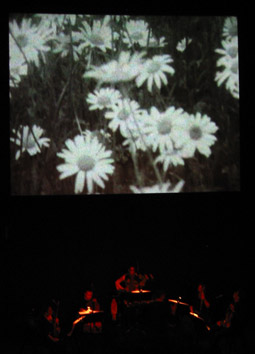
Ensemble Offspring, Waiting to turn into puzzles
WAITING TO TURN INTO PUZZLES IS THE TITLE OF A COLLABORATION BETWEEN EXPERIMENTERS: THE FILMMAKER LOUISE CURHAM, THE MUSICIANS OF ENSEMBLE OFFSPRING AND COMPOSER DAVID YOUNG. THERE IS, IN FACT, NO WAITING; THIS WORK FEELS LIKE A PUZZLE OUTRIGHT, SOMETIMES EXHILARATING, SOMETIMES FRUSTRATING, AND THERE IS NO EASY SOLUTION. WE WORK EAGERLY TO PUT IT TO TOGETHER. BUT WHAT KIND OF PUZZLE IS IT?
Curham's film is given the full-screen treatment at the Chauvel Cinema, its quickfire, imagery creating an urgent pulse while the musicians, tucked tightly to one side, conjure largely quiet, subtle soundscapes with rarely a collective beat. Sound and image here conjure different universes, yet we know they connect—we've been told pre-show that the musicians are responding to the film's images which are printed out as 'notated' score on their music stands, and each musician has a code which allows them to choose to follow a pre-determined stimulus. But how do music and image connect for the audience?
Certainly both seem to be focused on their materiality. Curham typically scratches and marks the film's surface and hand processes the stock, so that strange and wonderful things flower chemically. Young avoids conventional musicality, so that we are attentive to the very sound of each instrument and its curious melding with others, a condition intensified by the musicians exploring their tools and their responses to the film in a structured improvisation.
There's a likeness then, but the film demands to be watched, to be kept up with. The music never literally or even laterally accompanies the film, so there's no easy kinship. The sheer scale of the projected image and its insistence make the film visually loud, sometimes all consuming. Now and then it's quieter as it repeatedly stumbles up a nightime Tokyo lane, or lavishes flowers and trees with camera brushstrokes, or stares vacantly into a dull community centre. It's then that I'm more conscious of the music's calm chatter and extended sonorities. But when Curham's film reverts to its hundreds, maybe thousands of Pollocky creations flashing by, each brilliant and beautiful, and then she splits the screen, doubling the demands on our attention, it's then that you think (1) perhaps a joint before the show might've been a good idea, or at least an extra glass of the house red, and (2) I wonder what the music's doing now? It's then you listen and discover that it's creating its own beauty.
Curham and Young are not offering us a unified world. They're creating two very different experiences, with very different perceptual requirements, juxtaposing them and waiting for us to see and hear what happens. Unlike a jigsaw, where you know only too well what it is you're trying to piece together, here we don't know what we're making. Yes, it's a puzzle waiting to happen. When sound and image do come together, it's as if something has been solved, but then the film rushes on and the music takes another path…until they maybe meet later on. (Made susceptible by glimpses of Tokyo in the film, I think I hear, in one of the heightened musical passages, the ensemble of clarinet, two violins, cello and orchestra transform magically into a shimmering, gaguku orchestra.)
As these universes of music and image slip in and out of sync, the experience of Waiting to turn into puzzles (a phrase borrowed, not surprisingly, from Perec's Life, A User's Manual) can only be described as being oscillated between contemplation, delirium and their occasional, puzzling syntheses.
Ensemble Offspring, Waiting to turn into puzzles, filmmaker Louise Curham, composer David Young, musicians Diana Springford, James Cuddeford, Veronique serret, Geoffrey Gartner, Claire Edwardes; Chauvel Cinema, Sydney, June 7
RealTime issue #86 Aug-Sept 2008 pg. web
© Keith Gallasch; for permission to reproduce apply to realtime@realtimearts.net

Synergy with Fritz Hauser
photo Timothy Constable
Synergy with Fritz Hauser
The stage is set theatrically with clusters of percussive objects prophesying scenes to come in Synergy’s Space and Time program. Desks in each corner are cloaked in black sateen sheets heightening the sense of mystery about the shapes they conceal.
Percussionists Michael Askill, Timothy Constable, Bree van Reyk and Swiss guest artist Fritz Hauser take the stage quietly and directly, sitting straight-backed at their desks beneath harsh straw light. Their measured dispassion suggests the professional legitimacy of the artisan and forecasts a performance of unobtrusive depth.
Beginning as whispers, their clicks, taps, twangs and chinks build as the players strike their hidden instruments. Hauser channels seemingly African ostinati while Askill explores timbres of timber. Van Reyk shuffles beads until Constable signals them all into a frenzied unison and stop.
With silence comes darkness on all but Hauser who continues to forage for fresher combinations of sound. His every move is free and flowing yet completely controlled, yielding the precise result of the intent written in his brow. A subtle sense of the outsider is established between Hauser and Synergy that prevails for much of the evening.
While the visitor captivates the audience, Synergy’s players move to a nest of four inward facing drum-kits. Later, Hauser joins them, sharing their offering, then making it his own as the trio move forward to a set of Himalayan bells shaped like bronze bowls.
The bells rest on right hands while left hands circle the rims with wooden pestles. The continuous actions yield a sustained ringing and, for the first time in the improvised program, harmonic relationships surface. Consonance and dissonance merge in and out, pulsing like the pain I imagine in the kneeling percussionists’ feet. Again Hauser joins them only to diverge musically, taking the audience’s attention in tow.
When lights dim to end the concert’s first half, Synergy’s signature backdrop of Asian gongs waits patiently behind a stocky wooden table covered in metal artefacts promising different dramas to come.
When we return for the second half, the black cloths have been stripped from the desks. In a domestic tease Askill scrapes a cymbal as though scouring a dirty pot; Van Reyk slows the tap of rubber mallets on wood, enacting a bouncing ball’s eventual submission to gravity. Constable adds the twitter of a mobile phone, a doorbell and the twirl of a tiny ballerina in a music box on miniature piano. Incidental, everyday noises become the focus of Synergy’s improvisation, an idea completed back at their desks by Constable evoking an electronic key-finder on several pitched wood blocks. In an esoteric program these signposts are easy to latch onto; while risking the kitsch-factor they involve listeners where the monotones of ever-evolving sonic scaffolds can sometimes alienate.
Integrating the two halves, snippets of vocal material from the first are revoiced in the second by sound designer Bob Scott. Seated at the centre of the front row, he is the fifth musician, applying effects and sculpting the others’ efforts. Also marrying halves, the notion of the outsider is take up again when members of Synergy take turns as the autonomous outcast. While three players let one musical exploration wane, Van Reyk treads timely to the lurking gongs and asserts her presence by singing into them.
Sounds produced by Fritz Hauser’s mallets and sticks independently of drums and cymbals eclipse momentarily the whole gamut of sound being fashioned by Synergy. At times his brushes whoosh through the air—electrifying the space between sounds. Hauser’s cymbal scratching challenges the very basics of percussive perception.
The definitive quality of percussion instruments as opposed to melodic ones is that the sounds are made with noticeable attack and rapid decay. If sustained sound is required, the percussionist must repeatedly hit the instrument or object to give the impression of continuous sound. Most commonly, this involves lifting the stick, hand or other appendage and dropping or throwing it down onto the instrument. Hauser contradicts this vertical approach by utilizing a horizontal spectrum of movements. He shakes our expectations of duration by developing an idea such as scuffing to a point where the listener must find interest in infinitesimally small fluctuations in momentum and direction.
Hauser’s inventiveness and acute responsiveness to Synergy Percussion’s stimuli make him one of them and, equally, set him apart. Together, the wholly accomplished and charismatic Synergy has produced another captivating and, in this case, theatrical performance with a distinctly Australian essence.
Synergy Percussion with Fritz Hauser, Space and Time, performers Michael Askill, Fritz Hauser, Timothy Constable and Bree van Reyk, live electronics, sound design Bob Scott, lighting Neil Simpson; CarriageWorks, Sydney June 27-28
RealTime issue #86 Aug-Sept 2008 pg. web
© Felicity Clark; for permission to reproduce apply to realtime@realtimearts.net
Under the previous John Howard government and some state governments of the last decade, the threat of censorship was every present. It escalated to an unprecedented level in 2005 when Howard sought to increase the extent of elderly anti-sedition legislation in line with the Federal Government’s Anti-Terrorism Bill. Despite considerable protest and Senate Committee recommendations to the contrary, Attorney General Phillip Ruddock pressed ahead, promising to review the laws once they were instituted. He didn’t. Howard’s line was ‘trust me’, assuring artists and satirists that they were safe to speak their minds. No one believed him. With the arrival of a Kevin Rudd Government it was assumed that the law and order drive, neo-liberal political correctness, ministerial interference in funding decisions and media-driven censorship frenzies would fade or, better, be firmly repudiated. While the Goverment is addressing a wide range of rights issues (which we hope will lead to a charter) and has allocated $2.8m in the current budget for such, Prime Minister Rudd and Arts Minister Peter Garrett’s responses to the NSW Police seizure of work by Bill Henson from the Roslyn Oxley Gallery were deeply disturbing. A virtue of Rudd’s election campaign in 2007 was his and his team’s refusal to be rattled or wedged. Other than having to strategically buy into some of Howard’s bigger spending promises, Rudd played it cool and casual. Now, like his predecessor, he’s playing it fast and loose—gut reactions on the fly, an opinion on whatever’s put to him. All very presidential. Instead of deferring the Henson matter to the appropriate ministers, he chose to speak publicly, what’s more condemning the work and thereby Henson—a pronouncement of guilt that brands a man forever. Rudd can only appear impatient, imperious and unjust, and worse, opportunist, given heightened public concern about sexual exploitation and abuse of the young. The censorious pall of the last decade hangs over us still, and now grows more toxic, sucking the air out of difference, stifling nuance. Australian art may well be poisoned by this episode, made cautious and more self-censoring in every way from creation to marketing to funding. We hope that the defenders of Henson’s art, including the 2020 Summit Creative Australia participants [see their Open Letter, p15], many other artists, arts critics and a wide range of commentators, not to mention the Member for Wentworth Malcolm Turnbull, will clear the air, allowing for clear thinking, uncluttered by prejudice and those ever ambivalent attitudes to art in this country.
RealTime issue #85 June-July 2008 pg. 1
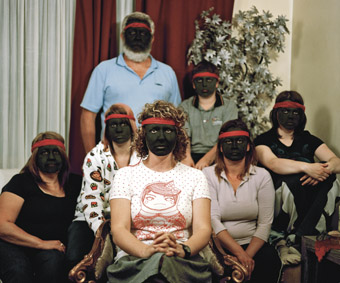
Bindi Cole, Wathaurong Mob (2008) from Not Really Aboriginal
Bindi Cole “explores how black you need to look to be considered Aboriginal and how white Aboriginals cross the cultural divide…Ultimately a celebration of Aboriginality in all its forms.” Part of Next Wave at the Centre for Contemporary Photography, Melbourne till July 5
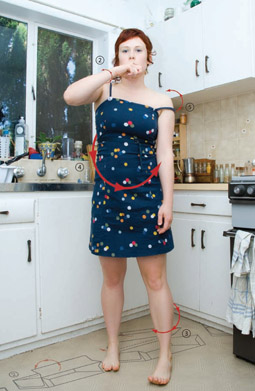
Alison Currie, 42a
photo Edwin Comey
Alison Currie, 42a
performer Alison Currie in 42a, an interactive installation-based work, part of a new triennially funded project to encourage independent artists to create works at the nexus of visual arts, new media and performance at Adelaide’s Experimental Art Foundation, June 26-July.
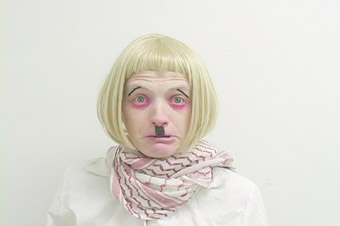
Tamy Ben-Tor, The Dance of the Albino Rat
courtesy of the artist and Zach Feuer Gallery, photo Zach Feuer Gallery
Tamy Ben-Tor, The Dance of the Albino Rat
Biennale of Sydney artist Tamy Ben-Tor, The Dance of the Albino Rat, documentation of performance at Stux Gallery.
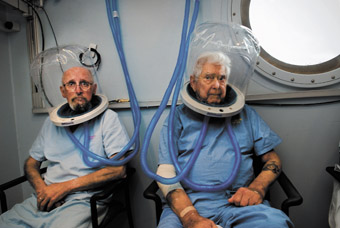
Leonard and William
photo Richard Kendall,
Leonard and William
Richard Kendall’s portrait of Leonard an William was one of 4 winners of the Head-on: Alternative Portraits prize at Australian Centre for Photography until June 7
RealTime issue #85 June-July 2008 pg. 2-3
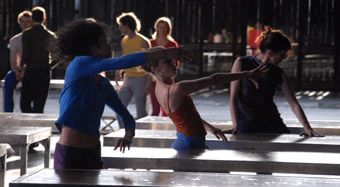
One Flat Thing, Thierry de Mey
The screening programs presented as part of this year’s ReelDance Festival were generally strong and, yet, one of them clearly stood out for me: Contemporary Dance on Screen. A veritable treasure trove for anyone interested in contemporary dance, it brought together three of the art form’s biggest names: William Forsythe, Pina Bausch and Les Ballets C de la B.
The program opened with One Flat Thing, Reproduced (Belgium/Germany, 26mins), a screen adaptation of William Forsythe’s work of the same title, originally created with dancers of the Frankfurt Ballet in 2000. Set in a vast industrial hall with natural light streaming in through large windows, it features 20 metal tables, amid which 17 dancers execute Forsythe’s extremely intricate and complex choreography, ranging from sharp-edged angularity to off-centre languidness.The piece is widely regarded as one of Forsythe’s masterpieces, and acclaimed filmmaker Thierry de Mey has done an excellent job in translating it to the screen. His approach to filming is unashamedly subjective, his camera knows no boundaries and seems to be ubiquitous. It hovers above the tables at one moment and crawls beneath them in the next. It smoothly moves vertically but also frequently circles the action. With a camera of such flexibility, de Mey supports and reinforces the obsessively multi-directional choreography. At the same time, he offers the film's viewers perspectives on the work that audience members at the live performance never would have.
In Pina Bausch (Germany, 45mins), a documentary on the grande dame of dance theatre, German filmmaker Anne Linsel has achieved something of a small miracle, managing to get the notoriously camera-shy Bausch talking candidly about her life and work with Tanztheater Wuppertal, the groundbreaking company she has directed for more than 30 years. Meticulously researched and masterfully edited, this film provides a comprehensive overview of Bausch’s achievements. Excitingly, it brims with excerpts from her shows, including the iconic scene from Nelken in which performer Lutz Foerster, clad in a tuxedo and standing on a stage covered with carnations, interprets the song The Man I Love in sign language. There is also an excerpt from Bandoneon (1982) with Australia’s Meryl Tankard at the height of her performative powers, repeatedly pushing the head of fellow dancer Nazareth Panadero into a bucket of water, all the while screaming, “Smile, Nazareth, smile!!!”
In addition to Bausch herself, the film also includes interviews with some of her longtime collaborators as well as many of her dancers, several of whom have been with the company for more than 25 years.
There is a lot of talk about trust between Bausch and her dancers. She admits to leaving her dancers in the dark as to what exactly she is looking for during a rehearsal process and which bits of the generated material might make it into the show. One of her dancers sums up the relationship between Bausch and the dancers as resembling more a love affair than a work relationship. She then adds: “That causes a lot of pain.”
This film is a thoroughly fascinating document. It confirms Pina Bausch as a passionate artist of great artistic and personal integrity and reveals the depth of the relationship between Bausch and her dancers, which has produced some of the truly stunning contemporary dance creations in the last 30 years. At only 45 minutes, the film is a model of economy and restraint and left this viewer utterly satisfied.

Les Ballets de Ci de La, Alain Platel
The closing film, Les Ballets de Ci de La (Belgium, 55mins), celebrates the history of Belgium’s famous dance and theatre company Les Ballets C de la B on the occasion of their 20th anniversary. It was made by the collective’s founding member and key figure, Alain Platel. Integrating excerpts from shows with filmic portraits of some of the choreographers and dancers affiliated with the company, this insightful documentary sheds light on the socio-political context in which its work is created. In the most interesting sections of the film, Platel accompanies two of the company’s dancers as they return to their respective hometowns, small villages in Burkina Faso and Vietnam. In both cases, video footage of the dancers performing in Wolf (2003), a show directed by Platel, is shown to the dancers’ parents. It’s moving to see how they grapple with their sons having made a career for themselves in Europe, outside of the culture in which they brought them up. Pride is mixed with apprehension, a feeling shared by the sons, as Platel, in turn, shows the men coming to terms with their parents’ comments. Les Ballets de Ci de La powerfully confirms that it is the performers’ personal commitment, their thoughts, opinions and lives, that feed Les Ballets’ work that is internationally acclaimed for being deeply anchored in the everyday world with all its coarseness, imperfection and fragility.
Contemporary Dance on Screen, May 16, ReelDance International Dance on Screen Festival 2008, Performance Space, CarriageWorks, Sydney, May 11-18
RealTime issue #85 June-July 2008 pg. web
© Martin del Amo; for permission to reproduce apply to realtime@realtimearts.net
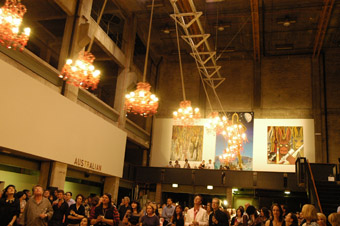
Casula Powerhouse Opening with Suzann Victor’s Contours of a Rich Manoeuvre III
photo Joanne Saad
Casula Powerhouse Opening with Suzann Victor’s Contours of a Rich Manoeuvre III
DESPITE THE FACT THAT ONE FEATURES A SINGLE CHINESE ARTIST, BOTH EXHIBITIONS, AI WEIWEI: UNDER CONSTRUCTION AT CAMPBELLTOWN ARTS CENTRE AND AUSTRALIAN AT CASULA POWERHOUSE, FOREGROUND THEIR SPECIFIC LOCATION IN WESTERN SYDNEY, WITH ITS ASSOCIATIONS OF MULTI-ETHNIC COMMUNITIES, RELATIVE SOCIAL DISADVANTAGE AND REAL VULNERABILITY TO THE ABSTRACT TRANSACTIONS OF GLOBAL CAPITAL. IN HER INTRODUCTION TO THE CATALOGUE FOR UNDER CONSTRUCTION, THE CENTRE’S DIRECTOR LISA HAVILAH DESCRIBES HOW THE PROJECT WAS HATCHED IN THE CONTEXT OF CAMPBELLTOWN’S INTEGRATION INTO SYDNEY’S HEADLINE ACT OF CONTEMPORARY ART, THE BIENNALE, TWO YEARS PRIOR, AND THE CURATOR CHARLES MEREWETHER’S INTEREST IN ENGAGING THE COMMUNITIES OF WESTERN SYDNEY.
Ai Weiwei’s thematic concern with the effects of a rapidly modernising China, including his own role as a collaborator on many significant building projects, is thus woven back into local issues. Not only is Australia’s current prosperity linked largely to China’s demand for raw materials to feed its modernisation, but also the changes such massive development has wrought on the world’s economic balance of power have direct knock on effects for Australian communities, as much as for Australian values, including commitments to heritage, environmental conservation and sustainability.
Over at the recently re-opened and refurbished Casula Powerhouse, ex-Artspace director Nicolas Tsoutas also cites the demographics of the region as a major consideration in putting together the exhibition titled Australian. Along with a number of alumni from the recently dismantled visual arts course at University of Western Sydney (and some current art world stars), the exhibition includes the work of young local artist Sadar Sinjawi, who settled in Casula from Kurdistan. Tsoutas, like Havilah, claims that the particular social and economic pressures in the local area (Liverpool has one of the country’s highest rates of forced mortgagee sales), shadow the work created for the show. While not all the artists consider themselves ‘political’, their work resonates with these broader social phenomena. Commissioned under a curatorial rubric—the complexity of what it means to be Australian today—the work addresses themes such as the environmental impact of exotic species, street culture, the status of national icons, spirituality, migration, Indigenous politics and cross-cultural identity, all permeated by the language of globalisation.
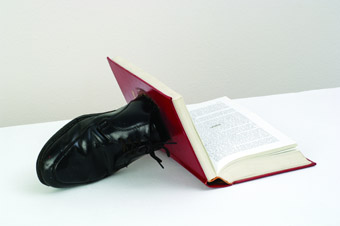
Ai Weiwei, Untitled, 1986, book with shoe,
courtesy the artist and Galerie Urs Meile, Beijing-Lucerne
Ai Weiwei, Untitled, 1986, book with shoe,
Which brings us back to Ai Weiwei’s overarching theme: the price and effect of a China gone global. Ai Weiwei’s work is unnerving in its ability to evoke China’s massive scale, in terms of territory and population, while figuring very few people. The masses are mostly conjured in absentia, through images of traffic, endless housing developments, left luggage or a veritable army of empty chairs. This absence keys in to the predominant aesthetic of the artist’s work in this exhibition: minimalism. Whether in his objects, installations or photographs, Ai Weiwei draws on the language of minimalism, more overtly at times, with his cubes and floor pieces that look to Robert Morris and Carl Andre (such as A Ton of Tea 2006, and Souvenir from Beijing, 2002), more subtly at others. One curious effect of this is that the China he presents is muted, quiet, and formally ordered, not a chaotic and dynamic powerhouse of industry and ideas.
The other effect is that Ai Weiwei’s China appears to be already framed by a Western eye. Certainly his work squarely addresses the history of Western art. One room is dedicated to early pieces from the mid-1980s made while living in New York which pay homage to Marcel Duchamp, Andy Warhol and Joseph Beuys in turn; another work renders Tatlin’s Monument to the Third International as a floating chandelier. His photographic and video documentation of Beijing’s Olympic makeover, and his ‘up yours’ gesture to symbols of global power (such as Study in perspective—White House, 1999), also betray the mediation of a Western eye. It is where this familiarity is less evident, such as in those objects assembled from the detritus of ancient temples destroyed by the forces of modernisation, that the work really bites. The resonance of these ancient relics is very strong; they evoke the irredeemable loss of the past and cultural heritage, and the ruthlessness of progress at any cost. Bed (2004) a floor sculpture made by laying together grooved ironwood recovered from a dismantled Qing dynasty (1644-1911) temple, is particularly poignant. But Ai Weiwei’s hybrid sculptures also exude the spirit of invention and resourcefulness of a nation so spoilt for cultural riches it can afford to squander them. Table with Two Legs on the Wall with Different Angles (2004) and Tables at Right Angles (1998), both made from Qing dynasty furniture, playfully enact cultural contortions while retaining a melancholy air about the indignities of having to perform to a foreign audience.
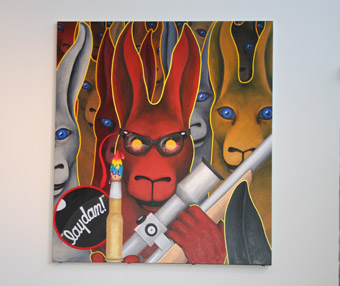
Gordon Hookey, Deneo C The Verry Verry Really Deadly Divine Sublime Bitchewmen Bhharbee Blhhaktjinn 2008
photo Joanne Saad
Gordon Hookey, Deneo C The Verry Verry Really Deadly Divine Sublime Bitchewmen Bhharbee Blhhaktjinn 2008
The documentary style and austere aesthetics of Under Construction stand in stark contrast to the riotous colour and almost Baroque aesthetics of Australian. Such exuberance is still rare in contemporary Australian art, and makes for a welcome change. Gordon Hookey’s gaudy, deliberately cack-handed comic satires of contemporary Australian politics dominate the main exhibition space at either end. David Griggs’ garishly coloured billboard-like paintings of life lived tough in the Philippines, Savanhdary Vongpoothorn’s intricate perforated canvases and Guan Wei’s multi-panel constellation painting all grapple with Judy Watson’s permanent floor installation and the space’s awkward architecture. Tucked away behind the main room, the lush aesthetics continue in Shaun Gladwell’s video installation, Planet and Stars Sequence, Maria Fernanda Cardoso’s wearable sculptures, Emu Wear, and the latest incarnation of Nike Savvas’ vibrating atom installation, Where Painting Begins: Atomic in full sunlight.
Gladwell’s videos record the artist in four different cities, street busking with his aerosol can. He makes small works on cardboard featuring images of stars and planets, using the containers of everyday multinational products for masking, and then erases each with black paint. It is a simple gesture that effortlessly connects the trajectories of global commodities with the art object, and links the artist’s process with an attempt to claim and control a creative space outside those trajectories. The work is greatly enhanced by its installation in a claustrophobic dead-end of the gallery, under a rail-track whose pylons sport readymade graffiti.
Another work whose installation makes great use of the Powerhouse’s industrial scale and readymade environment (including its permanent installations) is arguably the strongest here: Suzann Victor’s Contours of a Rich Manoeuvre III, a kinetic sculpture suspended above the gallery’s main room, comprising 12 red crystal chandeliers attached to a metal rod. From a motionless start, the pendulums begin to swing and gradually form a pattern: alternate chandeliers cut through the air with great pace and precision, resembling the goosestep of Chinese soldiers. As the movement slows, a new pattern emerges: the chandeliers form a sinuous line that recalls the trail of a Chinese dragon. (Its reflection in Judy Watson’s floor work caused Gordon Hookey to remark that the Rainbow Serpent had been woken!) This is a beautiful work in every sense: an elegant design, a memorable image, an affecting conceptual thread about the choreographed movements that those caught between cultures—in this instance Western and Eastern— must perform.
In probably unintended ways, these two exhibitions complement each other, offering alternative perspectives on the place of the artist in a globalised world, and alternative artistic strategies to engage with the effects of that globalisation.
Ai Weiwei, Under Construction, curator Charles Merewether, Campbelltown Arts Centre and Sherman Contemporary Art Foundation, Campbelltown Arts Centre, May 1-July 26; Australian, curator Nick Tsoutas, new work from 12 artists, Maria Fernanda Cardoso collaborating with Ross Harley, Sean Cordeiro/Claire Healy, Shaun Gladwell, David Griggs, Gordon Hookey, Dani Marti, Raquel Ormella, Nike Savvas and Stephen Little, Sadar Sinjawi, Suzann Victor, Savanhdary Vongpoothorn collaborating with Richard Johnson, Casula Powerhouse, Casula, Sydney, April 5-Sept 7
RealTime issue #85 June-July 2008 pg. 4-5
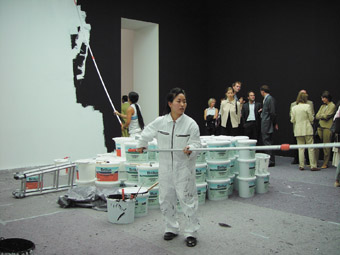
Nedko Solakov, A Life (Black & White), 1998, photo Giorgio Colombo
courtesy of the artist, Arndt & Partner Berlin/Zurich and the collections of Peter Kogler, Vienna; Susan and Lewis Manilow, Chicago; Hauser and Wirth, St. Gallen; Museum fur Moderne Kunst, Frankfurt am Main.
Nedko Solakov, A Life (Black & White), 1998, photo Giorgio Colombo
IT’S BIENNALE TIME AGAIN AND ARTISTIC DIRECTOR CAROLYN CHRISTOV-BAKARGIEV HAS ANNOUNCED THE THEME OF THIS YEAR’S EVENT AS “REVOLUTIONS: FORMS THAT TURN…A CELEBRATION OF THE DEFIANT SPIRIT EXPRESSED IN OVER 180 WORKS INCLUDING NEW AND AVANT-GARDE FROM LAST CENTURY.”
Many works in this year’s exhibition will be participatory, encouraging audiences to take the plunge to discover “new ways of looking and thinking about the lives they’re living.” We have been forewarned that “movement is a strong feature—works turn, spin, reverse, mirror, make noise and even blow up.”
Most interesting among the new media artists on the bill are Janet Cardiff and George Bures Miller who will create at Pier 2/3 a new work entitled The Murder of Crows, a 100 speaker work that envelops the audience. They refer in their works to “the world of film theatre and spectacle, as well as to the ways in which technology affects consciousness.” The installation will be structured like a play or a film but with images created by voice, music and sound effects. Inspired strongly by Goya’s The Sleep of Reason Produces Monsters, the work uses multiple soundscapes as well as composition in a blend devised to “challenge its audience’s view of the world”, and who could ask more of a work of art than that?
There are plenty more puzzling installations of the kind that generally turn up at biennales just to confuse us—rooms full of desks, chairs, whiteboards (someone should compile an inventory of materials sacrificed to art in biennales). Geoffrey Farmer turns aeroplane interiors into Airliner Open Studios. Raquel Ormelia upsets a Wilderness Society office. Lara Favaretto uses one ton of confetti, talcum powder and four hermetic stage ventilators. In A Life (Black & White), Nedko Solakov employs two painters to cover gallery walls in black, then white, then black again. There are ”public social sculptures” by Norwegian artist Anders Kieliesvik whose past work includes Happy Mountain Circus, in which performers in remnants of clown costume appear to be lurking on the edge of a precipice as in some actor’s nightmare.
For the truly adventurous, the Biennale put a call out for volunteers to work with artist Christoph Büchel who plans to create a punk rock band with four members over 80 years old. The band will rehearse God Save the Queen—the Sex Pistols version. Other performances will come from Dora Garcia, Joan Jonas and Ana Prvacki. Garcia will create a Lenny Bruce performance that never happened when the comedian was forced out of Australia in 1962 for performing obscenties (four letter words). Ana Prvacki will produce “a music-derived painkiller from saliva collected while practicing the flute.” Joan Jonas is a pioneering American performance artist working with video and live action and creating myriad exotic personae.
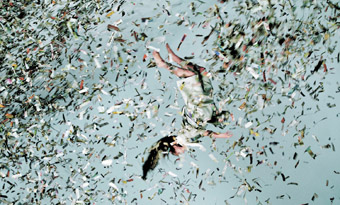
Rosemary Laing, weather #12, 2006
courtesy Galerie Lelong, New York, Galerie Conrads, Dusseldorf and Tolarno Galleries, Melbourne
Rosemary Laing, weather #12, 2006
The online venue work Inanimate Alice (www.inanimatealice.com) by Chris Joseph and Kate Pullinger has been described as “a digitized, interactive and dynamic story for the modern reader… that highlights the need for a new definition of reading and literacy.” It’s built around the story of a young girl growing up in the first half of the 21st century, and her imaginary digital friend, Brad. Over ten episodes, each a self contained story, we see Alice grow from an eight year old living with her parents in a remote region of Northern China to a talented mid-twenties animator and designer with the biggest games company in the world.”
William Kentridge, Dan Graham, Chris Burden are all represented in a number of works (including a lecture/performance within a video installation from Kentridge on Cockatoo Island) as are less familiar names from around the world many of whom are still early in their careers. Australian representation abounds—Stuart Ringholt, TV Moore, Raquel Ormelia, Mike Parr, Rosemary Laing, Tracey Moffatt, Vernon Ah Kee, Gordon Bennett, Richard Bell and Shaun Gladwell.
Held at diverse venues including Cockatoo Island and in the western suburbs of Sydney, the Biennale ‘constellations’ are envisaged as “public conversations involving a wide range of participants on topics related to contemporary art, its place in society, cross-cultural and urban experiences, cultural politics and the making of art exhibitions.”

Tamy Ben-Tor, The Dance of the Albino Rat
courtesy of the artist and Zach Feuer Gallery, photo Zach Feuer Gallery
Tamy Ben-Tor, The Dance of the Albino Rat
The youthful Christian pilgrim hordes who will have just vacated the city will be thankfully replaced throughout June-July by another kind of faithful when all manner of artists, curators, academics, poets, philosophers, activists and others will travel to Sydney to take part in the Biennale, to “understand, engage with and challenge” the works and ideas brought together under its banner. RT
2008 Sydney Biennale, June 18-Sept 7, www.bos2008.com
RealTime issue #85 June-July 2008 pg. 6
© Virginia Baxter; for permission to reproduce apply to realtime@realtimearts.net
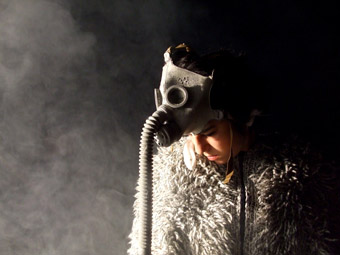
Comeback
courtesy Monster Truck
Comeback
OPENING NIGHT OF THE PLATEAUX FESTIVAL SAW THE FOYER FILLED WITH PEOPLE EATING TRI-COLOURED ICE-BLOCKS COVERED WITH SOMETHING THAT UNEXPECTEDLY CRACKLED AND POPPED IN YOUR MOUTH. IT WAS A GOOD METAPHOR FOR WHAT WAS TO COME OVER THE NEXT TWO WEEKS. THE INTERNATIONAL FESTIVAL TAKES PLACE ANNUALLY AT THE MOUSONTURM KÜNSTLERHAUS IN FRANKFURT, GERMANY, FOCUSING ON NEW DIRECTIONS IN CONTEMPORARY PERFORMANCE WHETHER IN THEATRE, DANCE, SOUND OR VIDEO. EIGHT YEARS ON, IT’S BUILDING A REPUTATION AMONGST ARTISTS AND PRESENTERS AS A PLATFORM FOR EXCITING, AMBITIOUS AND PROVOCATIVE WORK.
Comeback, a sugar-coated fairytale from the young German company Monster Truck opened the festival. It is a nightmarish theatrical spectacle that has overtones of Forced Entertainment’s Bloody Mess and, from Australia, My Darling Patricia’s Politely Savage. Comeback explores the things we are afraid of—mostly from childhood—and is realised as a fantastical nightmare featuring a candy dome-shaped house, a wolf in sheep’s clothing, a depressed donkey and libido-crazed wardrobe. It has very little dialogue, instead popular music shapes the non-linear narrative: AC/DC’s Thunderstruck when a heavy storm of candy floss blows in; Fancy Pants for the horny cupboard; and Ground Control to Major Tom to accompanies the precarious journey of a tin of beans travelling into the dark of night.
All of this might seem clichéd and obvious but the Monster Truckers are skilled makers, storytellers and performers. The entire set is handmade and remade for each performance by the five artists. Sugar and water boil for hours to make toffee windows that are re-installed in the house each day only to be smashed with an ice-pick in the evening; a candy floss machine is restocked with kilos of sugar for a snow sugar blizzard which leaves a deliciously sweet smell in the air; the roof of the house is rebuilt and re-covered in metres and metres of aluminium foil.
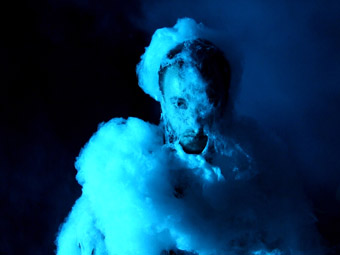
Comeback
courtesy Monster Truck
Comeback
My delight with Comeback was in the level of detail realised in each of the dreamlike images, the raw and recycled aesthetic of the set and costumes, and the surprising dramaturgical choices made to realise this fantastical tale. Leaving the theatre it felt like I had visited a surreal playground. I was giddy on the pandemonium, delighting in the chaos of night.
Throughout the festival the work of filmmaker Björn Renner played on a continuous loop across three screens in the foyer. Shot on 16mm the films ranged from a pop-music video clip (The Knife) to a claustrophobic afternoon tea with a fractured mother and her two grown, (co-)dependent sons (Exquisite Moments). Renner’s films are visually rich pastiches of child-like illustration, collage and animation spliced with film.
The main theme of the films’ emotionally disturbing content is dysfunctional relationships, whether with self, mother, teacher or partner. Each frame in Renner’s films appears like a blank canvas which the artist fills with absurd, surreal, sublime and ultimately compelling images. His films reminded me of a textured scrapbook—cluttered and overloaded with cut-outs, ideas and cultural references that were, at times, homoerotic and Freudian and, at others, innocent and naïve.
I was particularly drawn to the use of sound in Renner’s films. Composers Robin Spurrier and Michael Hansson use a diverse and heavily textured palette that ranges from the enchanted beauty of the harp to an extreme mash-up of noise. There was a seamless integration between sound and image that added to the unsettling experience for the audience.
Requiem is the latest show from the Swiss experimental sound group Velma. For this new work they transformed the large theatre at Mousonturm into a 1970s analogue sound recording studio complete with tan lo-pile carpet, a wood-panelled soundproof room (which doubled as a surface for projection) and moveable soundproofing boards. The audience sat inside the studio with the musicians watching the ‘session’ which included a manic drum solo, whispered a capella singing and a ‘melody’ played on a muted Casio keyboard.
The first half of the show was engaging and quite funny (even though the German audience wasn’t laughing) as the performers ‘set up’ for the gig. The non-performing bordered slightly on ‘acting’, however not enough to appear contrived, and the theatricality deployed in presenting experimental sound was exciting and visually superb. I could have watched the drummer all night: he looked like he had walked straight off the set of a Blaxploitation flick while one of the women in the group was a dead-ringer for Charlotte Gainsbourg. For a good 30 minutes I was happily taken for the ride. The group stuck strictly to Vatican rules about the duration of a requiem, making the show a little too long, and a little flat in the second half, too restrained and, at times, predictable and clichéd—especially in the way women were portrayed. The men played instruments and dictated the rhythm and flow of the show while the women had a sexual revolution, rubbing butter on glass and making love to a chair.
In a much more intimate show, Phantomgeschichte, using a screen and a miniature stage, Nicola Unger from the Netherlands tells the true story of her landlady “who charges too much rent for her flat in Rotterdam” and whose life changed forever one night in 1975 when she attended the same party as the most wanted man in the world, a terrorist, The Jackal.
Unger’s performance is quiet and considered. She sits in close proximity to the audience with her collection of cardboard cut-outs making the experience very personal. Using shadows, projection and simple animation, she tells the story of this night. She sets the stage, literally, for the events that are to follow, introducing the characters one at a time: “You will be a stewardess, and have three children and one of them will be disabled. You will work for Interpol. You will be the underdog. You will take fingerprints. You will check passports.”
Scenes change with the click of a finger as Unger slides people, palm trees and motorbikes across her miniature stage on long sticks. It’s easy to lose yourself moving between the one-dimensional world of cardboard cut-outs and projected images—each telling the same story in a very different way. This aesthetic contrast worked well although I preferred the miniature stage where I could watch Unger concentrating, preparing for the next character’s entrance.
As the story of the night unfolds, the focus shifts to the present day and becomes a comment on the war on terror with Osama Bin Laden taking the place of The Jackal. In the closing stages of the show, Unger highlights the media’s ongoing obsession with ‘a really good story’ whether then or now. As the show’s title suggests, this is a story that never dies.
Plateaux Festival: Monster Truck, Comeback, creators Manuel Gerst, Matthias Meppelink, Boris Nikitin, Sahar Rahimi, Cecilie Ullerup Schmidt, Ina Vera; Björn Renner Films, director Björn Renner, co-director Christoffer Paues, sound Robin Spurrier, Michael Hansson; Velma, Requiem, creators Christian Garcia, Christophe Jaquet, Valerie Liengme, Arantxa Martinez, Stephane Vecchione, music velma, lighting design Laurent Junod, sound design Ludovic Gugliemazzi, costumes Tania D’Ambrogio, scenography Serge Perret, production & dramaturgy Anja Haelg; Phantomgeschichte, concept, performer Nicola Unger, narrator Duro Toomato, sound Jonathan F Brown; Moustonturm Künstlerhaus, Frankfurt, April 17–26
RealTime issue #85 June-July 2008 pg. 8
© Rosie Dennis; for permission to reproduce apply to realtime@realtimearts.net
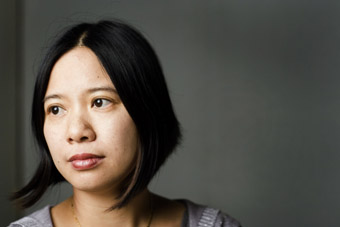
Liza Lim
photo courtesy Brisbane Festival
Liza Lim
COMPOSER LIZA LIM’S OPERA YUE LING JIE (MOON SPIRIT FEASTING) WAS ONE OF THE HIGHLIGHTS OF LYNDON TERACCINI’S 2006 BRISBANE FESTIVAL. NOW HER LATEST OPERATIC WORK, THE NAVIGATOR, AGAIN WITH THE ELISION ENSEMBLE WITH WHOM SHE HAS BEEN ASSOCIATED FOR OVER 20 YEARS, WILL PREMIERE AT THIS YEAR’S BRISBANE FESTIVAL IN JULY-AUGUST. THIS PROMISES TO BE ANOTHER STANDOUT EVENT WITH THE ADDED EXCITEMENT OF DIRECTION BY BARRIE KOSKY. LIM HAS COLLABORATED WITH KOSKY BEFORE ON THEIR MUTUAL ADAPTATION OF AESCHYLUS’ THE ORESTEIA, PERFORMED IN MELBOURNE IN 1993. WHEN I SPOKE TO HER AT HER WEST END HOME SHE WAS EAGER TO BEGIN THE PRODUCTION PROCESS WITH KOSKY WHOM SHE APPRECIATES AS A DIRECTOR WHO WILL APPROACH THE WORK WITH NO PRECONCEPTIONS. SHE FULLY EXPECTS HER OWN TO BE “BLOWN OUT OF THE WATER”, AND ANTICIPATES THIS PROSPECT WITH RELISH.
The Navigator is Lim’s third opera work to date and she avers enthusiatically that opera is her favourite medium: “I would just keep writing and writing them.” The impetus to embark on this form came when Kosky called her out of the blue about collaborating on The Oresteia. Lim believes that this is “probably the best way to start writing operas, by just falling into them.” The Oresteia was “very much about ritual and possession” and Lim sees a preoccupation with these concerns in her later work. Moon Spirit Feasting was about “communicating with spirits, or memory, cultural memory, the kind of knowledge contained in these stories being evoked, brought to life, through ritual.” The Navigator is mainly based on the Tristan and Isolde story combined with some personal links Lim has with Wagner’s opera. She first heard Wagner’s version in her early 20s when “it probably went over my head”, but since listening to an orchestral rehearsal of Wagner’s overture in Sydney later on she now regards the work as one of the absolute gems in the classical repertoire: “It was a revolution in musical language. The Tristan chord which is the kind of thing that people talk about broke all the rules of musical grammar.” Lim heard the prelude again in 2004 and “just kind of fell in love with music again.” (She had at the time put music on the backburner while she prioritized being a mother.) When she heard Wagner’s complete opera played at a music festival in Brisbane a connection was forged on an entirely new level: “It was like a door opening.”
The process of creating her new work began in 2005 so it has been quite a journey from the beginning to now. In a nutshell, the Tristan and Isolde story is of unrequited, adulterous love achieving transcendence in death, but Lim is not interested in this aspect at all. In her mind, “the subject of the opera is desire, not just sexual desire, but the erotic in the widest sense of unbelievable aliveness, of being in contact with some kind of ecstatic information.” Pausing, she muses: “That’s probably the topic of all my operas—some kind of ecstatic transformation.” She has seen what she describes as a fantastic production in Germany of Tristan and Isolde directed by Kosky, and she quotes his depiction of the work as “a fugue of the senses.” This strongly connected with Lim who values hearing, sight, touch and smell as ways of personally operating in the world, of exchanging with the world.
Another source of Lim’s new work is the Mahabharata—not the stories, but the key moments which Lim regards as “the point of absolute risk when you stand to lose everything to gain something, and that again is a portal to some kind of transcendency. You’re teetering between extremes, and in that teetering you go beyond ordinary concerns. You have a wider horizon.” As a corollary, what Lim finds exciting about the process of making a big project is all the unpredictable ways it might go because it depends on “being really present in the moment, whether it’s the actual thing of writing it, or when in rehearsal you see the configuration of bodies and the personalities and what people bring to it. I’ve written a score, but the way that score communicates is absolutely dependent on the presence of the performers and their energies, the aliveness they can bring to it.” This is why Lim finds it useful to talk about the work as a fugue of the senses because, in her view, the performers are not representing, not playing roles. “In that moment they are a particular constellation of energies, and that is what the work is about.”
Lim had worked before with her librettist, Melbourne poet Patricia Sykes, on a large work called Mother Tongue [2005] and proposed that they should make an opera together. “I really felt at that time that her kind of writing was what I would want to work with in a theatrical setting as well. The writing is complete in itself as a form of poetic expression, but it also opens up spaces in which music can exist, in which theatre can exist. Look at the different ways in which art forms exist in time. Music time flows in a certain way, theatre time flows in quite a different way. And then of course you have some things on a page. I just thought that those time flows could be counterpointed in an operatic form. There’s so much marvelous poetry I read, but it doesn’t allow me an entry. The music transforms the poetic into something else, although sometimes I think that can be a bit unbearable for a writer. It’s a very tense relationship. But Patricia is willing to engage in a dialogue about it.”
I suggest to Lim that her music is kinetic and she responds that she likes that word, because she does think very much of the physical gestures of the music and because, particularly in the case of instrumentalists, it’s very much an expression of a physical relationship that’s even more dramatised when you’ve got a singer whose body is her instrument. Lim finds her singers totally awesome considering what they’re required to do and because there’s no holding back. “Audiences find that quite frightening too. The vulnerability as well, inviting the audience to look at that aspect of themselves.” When pressed she submits she has extended her language in this work, particularly in the area of lyricism. The ritual aspect and the explosions of colour are all there, but there’s a lyricism as well. “Longing, yearning is a huge element. The tension between desire and the experience of desire. There’s a paradox in there. There’s the triangular relationship between the person who desires, the object of desire, and the pathway between them which, if it disappears, kills desire. It is the geometry of desire which is looked at in different ways.”
2008 Brisbane Festival, The Navigator, composer Liza Lim, librettist Patricia Sykes, director Barrie Kosky; Judith Wright Centre of Contemporary Arts, July 30-Aug 2
RealTime issue #85 June-July 2008 pg. 10
The 2008 Brisbane Festival includes in its potent line-up of performances, new works such as Elision ensemble’s production of Liza Lim’s new opera, The Navigator, directed by Barrie Kosky, alongside classics re-visited like Macbeth in the Contemporary Legend Theatre of Taiwan’s The Kingdom of Desire, replete with 22 performers, 15 musicians, Chinese opera and acrobatic fights and set in ancient China, and the British company Cheek by Jowl’s all Russian cast version of Chekhov’s Three Sisters, performed in Russian and directed by Declan Donnellan.
Peter Brook directs a monologue performed by long-time associate Bruce Myers in The Grand Inquisitor. Christ returns to Earth in Seville during the Spanish Inquisition, performs miracles and is, of course, judged a heretic. The Grand Inquistor is adapted by Marie-Hélène Estienne from Dostoyevsky’sThe Brothers Karamazov, and has not a little resonance with our own increasingly censorious times. The Queensland Theatre Company will premiere The August Moon about the impact of 2006’s Cyclone Larry. Within days of the disaster, playwrights Adam Grossetti and Jean-Marc Russ ventured north to witness the aftermath of the cyclone, documenting personal accounts of the trauma including tales of injustice which provided the material for their dramatisation.
A unique dance offering comes in the form of bODY_rEMIX/gOLDBERG_vARIATIONS, a ballet in two 45-minute acts featuring ten dancers from Marie Chouinard’s company which was founded in Montreal in 1990 and constantly travels the world’s arts festivals. The choreographer’s distinctive approach entails dancers working onstage with ballet barres, crutches, pointe shoes, harnesses and ski poles, adding a surreal prosthetic dimension to dance, extending reach and reshaping bodies.
Brisbane sound artist Joel Stern and “engineer, sculptor and self-confessed tinkerer” Beh Wattenberg come together to create The Swell String: “an obscured portal emits thunderous rumbles, metallic shimmering, pure tones and beautiful harmonic drones.” This experimental sculpture can be experienced at the Judith Wright Centre of Contemporary Arts.
More audience engagement comes in the form of an interactive work by leading UK media artist Gina Czarnecki, resident in Australian in recent years where she worked with Australian Dance Theatre on Devolution. The festival will premiere her latest creation, Contagion, at QUT’s Creative Industries Precinct: “Participants explore ideas of biological infection and the spread of information, knowledge, rumour and myth in society…”
In an interesting and distinctive move, initiated in 2006, the festival established its own curated fringe, titled Under the Radar, featuring in 2008 Black Curtain Theatre Movement of South Africa, The Lonesome Buckwhips of New Zealand, Legs on the Wall, Queensland’s Sandro Colarelli and provocative new works from emerging performers around Australia. RT
2008 Brisbane Festival, artistic director Lyndon Terracini; Brisbane, July 18-Aug 3;
www.brisbanefestival.com.au
See page 27 for another Brisbane Festival media arts venture, Big Square Eye.
RealTime issue #85 June-July 2008 pg. 10
© RealTime ; for permission to reproduce apply to realtime@realtimearts.net
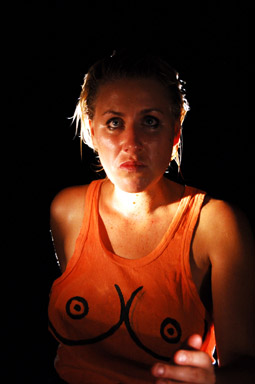
Brown Council, Runaway
photo William Mansfield
Brown Council, Runaway
WITH A STRONG PRESENCE AT THIS YEAR’S NEXT WAVE FESTIVAL AS WELL AS AT NATIONAL AND INTERNATIONAL FRINGE FESTIVALS, A NEW GENERATION OF YOUNG SYDNEY-BASED PERFORMANCE MAKERS IS CLEARLY GOING PLACES. CONSIDERING THE CURRENT VIBRANCY AND DIVERSITY OF SYDNEY’S EMERGING ARTISTS COMMUNITY, THIS IS HARDLY SURPRISING. AT PRESENT THE COMMUNITY TEEMS WITH TALENTED YOUNG INDEPENDENTS WHO HAVE CREATED ONGOING ENSEMBLES, INVENTIVELY SEEKING OUT AND STITCHING TOGETHER OPPORTUNITIES TO SUSTAIN THEIR PRACTICES.
They take advantage of emerging artists initiatives and mentoring schemes provided by contemporary arts organisations such as PACT Youth Theatre, Performance Space and Urban Theatre Projects as well as by federal, state and local funding bodies. In addition, they have also been rather proactive in creating their own opportunities through self-instigated, artist-run initiatives. The Cab Sav series, housed at Lanfranchis Memorial Discotheque until the venue’s demise last June, immediately springs to mind. Other initiatives include Quarter Bred, a residency program supported and housed by PACT Youth Theatre, and Underbelly, a public arts lab and festival, at CarriageWorks, now in its second year. Earlier this year, the Imperial Panda Festival, presented in small alternative venues, played to full houses every night of its two-week season.
Sydney’s young independents comprise a wide range of artists from various backgrounds and include performers, musicians, new media artists, writers, producers and designers. It is striking how close-knit and self-sufficient the community has become, with artists supporting each other’s practices, taking on various roles in their respective productions—on stage, behind the scenes and front of house.
brown council
The members of the all-female artistic collaboration Brown Council—Fran Barrett, Kate Blackmore, Kelly Doley and Di Smith—met when studying at Sydney’s College of Fine Arts (COFA). Straddling contemporary performance and the visual arts, their work is strongly concept driven, peppered with references to the history of performance art, but at the same time firmly anchored in the realm of high theatricality, incorporating outrageous wigs, costumes made of sheets and lots of fake blood.
In Milkshake, a short performance piece, later turned into a video work, Barrett, Blackmore, Doley and Smith are clad in hand-painted skeleton costumes, their faces made up to look like skulls. Subverting the overt sexuality of many music video clips, they perform a stylised booty dance routine to hip hop artists Kellis’ chart-topper Milkshake, while simultaneously drinking a litre of milk each. As they gyrate their hips and shake their torsos, they literally turn into human milkshakes. What started as a good-natured booty dance turns into an act of performative endurance. There are burps and pained facial expressions; it is obvious that the performers are on the brink of vomiting.
Brown Council’s first full-length work, Six Minute Soul Mate, which recently premiered at the Next Wave Festival in Melbourne, is a very different affair. Exploring the nature of love and romance within a contemporary quick fix culture, it consists of nine six-minute monologues in front of brightly coloured heart-shaped backdrops, emulating the structure of speed dating events.
post
Since starting to work together as a group in 2004, Post (Zoe Coombs Marr, Mish Grigor and Nat Rose) have gradually developed a distinctive theatrical style, fusing a penchant for brightly coloured lycra with an astute eye for political satire. Their most substantial work to date is their full-length theatre show, Gifted and Talented [RT80, p46]. Receiving significant critical interest when first performed at PACT in 2007, it has since become a hit on the festival circuit with seasons at the 2007 Melbourne Fringe Festival, the 2008 Adelaide Fringe Festival and the 2008 Brisbane Festival’s Under the Radar program.
Set behind the scenes of an eisteddfod, Gifted and Talented is an hilarious yet disturbing critique of the constant striving for perfection and obsession with imposing control over other people’s bodies. Dressed in multi-coloured fluoro tracksuits, Coombs Marr, Grigor and Rose play suburban mums who viciously discuss the failings of their amateur dancer daughters, all the while chain smoking, downing cans of Solo and gorging sausage rolls with gallons of tomato sauce. In an unexpected twist, Post link the cruel strategies their eisteddfod mums with acts of government sanctioned violence as reported in the wake of the prisoner abuse scandals in Abu Ghraib and Guantanamo Bay.
Post’s new work, Swimming Home in Heels, a 10-minute performance installation set in a hotel room for one audience member at a time, recently premiered at Next Wave. Exploring notions of lies and intimacy, it will form the basis for a new full-length theatre show, Shamelessly Glitzy Work, to be developed in residency at Performance Space later this year.
janie gibson
With two memorable solos, performed at short works nights at Performance Space and Lanfranchis in 2006 and 2007, Janie Gibson has established herself as a powerful and original performance maker with a keen interest in over the top characterisation and fantastical monologues. She recently created her first group work, The Whale Chorus, collaborating with performers Alex Grady, Matt Prest, Georgie Read and Phoebe Torzillo [RT84,p36]. Gibson directed the work as well as performing in it.
The Whale Chorus gingerly teeters on the line between dream and nightmare. It’s populated with centaur and gnome-like creatures as well as a troubled young family. There is exuberant ensemble dancing inspired by 1980s dance films as well as intensely delivered renditions of well known pop songs. There is also a narrative of sorts constantly looping back on itself, evoking David Lynch’s complex dream logic. Amongst all this, Gibson occasionally appears as a mysterious queen of evil, majestically delivering lines of comic book cruelty: “Do you dare me to stick my long extended fingernails into this electrical socket? Do you?”
Gibson’s next project, titled Cassandra, is a surreal domestic drama set in a space halfway between a kitchen and a karaoke bar. The performers, some from Whale Chorus, will take turns playing an exaggerated nerd character, Cassandra, donning a brown wig, a T-shirt with a pillow underneath, pants and glasses and clutching a bowl of Weetbix. Cassandra will be developed at Underbelly at CarriageWorks in July and presented at the Brisbane Festival’s Under the Radar.
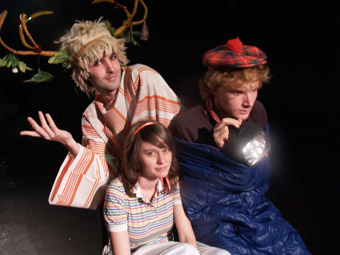
Pig Island, Simply Fancy
pig island
After meeting at the Sydney University Drama Society (SUDS), Nick Coyle, Charlie Garber and Claudia O’Doherty formed Pig Island in 2006. Since then they have created three full-length works, rapidly gaining a reputation as one of Sydney’s most exciting young theatre companies.
Their wildly imaginative and often deliriously funny self-devised shows have struck a chord with audiences and critics. Winning the Golden Gibbo Award for Best Independent Production at last year’s Melbourne International Comedy Festival for their first show, The Glass Boat, their most recent production, Simply Fancy, was picked up by Neil Armfield for a three-week season at Downstairs Belvoir Street where it played to good houses in January, before moving on to the 2008 Melbourne Comedy Festival.
Simply Fancy dazzles with its highly energetic performance style and dialogue-based text that is both fresh and inventive. Its rollicking storyline revolves around the quest of a dad and his two teenage children for a pineapple, kiwi fruit and guava to make a fruit salad for Grandma’s birthday. This absurdist, madcap adventure features a vast array of locations and characters, the most memorable being the mantaray, an enigmatic creature half praying mantis half stingray. Pig Island are currently preparing to take Simply Fancy to the Edingburgh Fringe Festival in August this year.
RealTime issue #85 June-July 2008 pg. 12
© Martin del Amo; for permission to reproduce apply to realtime@realtimearts.net
ART, IN ITS MULTITUDINOUS FORMS, IS AN INHERITED FEATURE OF HUMAN ACTIVITY, GENETICALLY (THE PROPENSITY FOR AND THE NEED TO MAKE ART) AND CULTURALLY (THE FORMS WE INVENT, SHARE, PASS ON AND INNOVATIVELY MUTATE). ART IS DEEPLY TIED TO OUR WELLBEING AND IS INTEGRAL TO HUMAN ECOLOGY: ARTS’ DIVERSE FORMS ALLOW US TO CHOOSE THE WAYS IN WHICH WE CAN MAKE OR ENJOY ART, WHAT ROLES WE CAN PLAY IN AND THROUGH IT, WHAT COMMUNITIES WE CAN BELONG TO. THE SUSTAINABILITY OF ART PRACTICES IS NOT SIMPLY AN ECONOMIC ISSUE, IT’S ONE OF HUMAN ECOLOGY.
Sustainability is a word familiar to us from both ecology and business, and these days its parallel uses are being drawn closer and closer together. Business has become very conscious of the economic advantages of ecological awareness, and there are companies and corporations merging profit-making and environmental responsibility well ahead of more cautious governments, but without the prospect of profit they might be less enthusiastic. Sustainability in the arts refers to the capacity to survive: art as a tradition worth maintaining and growing, art as individuals, groups and companies functioning as businesses, of a kind, and art as an ecology—a complex of local and global networks of learning, exchange and influence. Art is a complicated totality; we need to see it as such, and address its wellbeing as an ecosystem.
sustaining the sector
In A Sustainable Arts Sector: What will it take?, authors Cathy Hunt and Phyllida Shaw have created a brief guide to how a sustainable arts organisation should function; they report on and compare UK and Australian arts councils’ strategies for building sustainability, including through remedial programs; and they detail changes in funding outside of governments (a gradual but palpable shift from sponsorship to philanthropy). It’s a timely essay, practical in spirit but always mindful that the prevalent business or managerial model for arts funding and management has its limits when it comes to encouraging innovation and supporting the long-term development of artists and their visions, not least in the small to medium sector where much of the future of art is generated.
The strength of the essay is that although still in the arts managerial mode it addresses the ongoing need for government funding as part of arts sustainability and that it sees the art sector as a totality, making some sense of the occasional use of the word ‘ecology.’ While there’s little room for artform detail in an essay, the emphasis on commonality focuses shared dilemmas and suggests the potential of a united vision. This is at its strongest in the essay’s conclusion where the authors delineate the beneficial impact for the arts of the UK National Lottery which “provided the opportunity for a significant change, including a wholesale review of the challenge of sustainability.” The authors conclude their essay “with an invitation to the new Australian Government to initiate a discussion about the establishment of an endowment to create a new funding source for the arts in Australia—a Future Fund for the Arts, financed by the Australian Government in partnership with the state governments and the private sector, through a special tax incentive linked to corporate and individual investment.”
Set up as a foundation this fund would provide support for “artistic and organisational risk and innovation; projects and programmes lasting seven years or more; longitudinal reseach into the long-term impact of the arts.” Hunt and Shaw think that with “state, federal and local government funding focused on the short to medium term and a Future Fund addressing a long term agenda, the sector’s sustainability is more likely assured.”
the 2020 summit
Invited members of the arts community, including Hunt, went to the 2020 Summit with this vision, or something similar, in mind. ACTU President Sharan Burrow called for a future fund for the entertainment industry including investment in multimedia and internet production and what looked like an inspired idea, a “cultural schoolbag” to give Australian school children cheap access to museums, film and the visual and performing arts.
The provisional document that came out of “Towards a Creative Australia” section of the 2020 Summit opens with the ambition “to double cultural output by 2020. To achieve this there is a need to implement policies that will produce a sustainable creative sector and support artists, build educational capacity, integrate Indigenous and settler perspectives and recognise the centrality of the arts and creativity to the whole economy.”
It’s an odd ambition, to “double cultural output.” A better goal surely would have been to make the arts in Australia sustainable instead of setting a meaningless number as your target. It’s like saying to government we’ll double our effort if you give us the money to make us sustainable without saying what sustainability means. It looks like a productivity model rather than one addressing capacity and effectiveness. If artists and organisations struggle to sustain themselves now, how will they fare with doubling their output, however much their ranks increase over the next decade. Richard Letts, in his response to Hunt and Shaw in Plaform Papers 16, reports that “the recent census shows a quite striking decline from 2001 to 2006 in the number of people declaring their main occupation to be [an artist] in the main art forms” by some 20% on average, this after “an upward trend of at least four decades duration.” Whatever the reason for this, and Letts suggests several, all of them disturbing, it’s enough to make you wonder about the viability of arts training courses and the sustainability of careers in the arts. Let’s hope the doubling notion just goes away.
The strong call at the summit for increased art in schools (practitioners-in-residence “via a national mentoring plan”, mandated arts courses, creativity summer schools, in-service teacher arts training) was promptly made real in part with the 2008 Australian Government Budget allocating “$5.2 million over four years to the Australia Council to improve access to quality artistic experiences for students in primary and secondary schools and tertiary institutions.” There will be “grants of up to $20,000 for individual professional artists, and $100,000 for arts organisations, to develop and deliver arts learning experiences through in?school residencies.”
Again sustainability is ignored. While a national artists-in-schools scheme is an admirable goal and a requisite part of any arts education program, how does it mesh with artist availability, training and capacity? How many students will it actually reach compared with, say, the ACTU’s “cultural schoolbag”, where kids might see art where it usually happens? Just how seriously has any of this been thought through? Again it’s superficially attractive—more work opportunities for artists and companies who can accommodate the load or see it as a career option or something on the side aiding survival.
One of the high priorities singled out by the Creative Australia team at the summit was for “A National Endowment Fund for the Arts”, a title rich in irony in these censorious times, recalling the diminution of the US’s National Endowment for the Arts (NEA) triggered by conservative responses to the funding of provocative American artists like Robert Mapplethorpe and Karen Finlay. Naming aside, it’s a pity that a future fund wasn’t the priority above all others, it’s the only one that could pull all the others together and make sustainability its focus.
the budget
While the 2008 Budget realised some of the 2020 Summit’s Creative Australia arts-in-education dreams long before the government has to announce what it will do with the recommendations, the overall picture is of yet another Australian Government failing to address the sustainability of the arts. Once again programs look like initiative spending, attractive in the short-term but vague in the long. Yes, it’s great to have more emerging artists, and better supported, terrific to have artists in schools, and wonderful to have “creative communities.” But are there the networks, the administrators, producers and the artists (not just the numbers, but their appropriacy and capacity) to realise these schemes, to make them endure?
“A Creative Australia”, the young and emerging artist program, allocates “$6.6m for young and emerging artists and young audiences.” (Perhaps the reference here, otherwise unexplained, to “young audiences” suggests the possibility of the “cultural schoolbag?” idea). On the surface this looks admirable, nurturing the next generation of artists, but for what kind of future? The current generation is not well sustained.
Creative Australia says the budget paper, “will provide support for: performing arts companies to offset the income that would otherwise be earned from presenting better known or more commercial works; projects that support young and emerging artists in developing professional skills, expertise and professional networking; and projects that engage young artists and audiences, particularly in demonstrating best practice in the areas of youth arts and new technologies.”
$10 million over four years will be invested, says the budget announcement, in “a Creative Communities program to improve opportunities for Australians to participate in arts and cultural activities in the places where they live. Funding will be allocated by the Australia Council for high quality participatory arts programs that enhance community wellbeing, encourage innovation and assist communities to find creative solutions to the issues they face.” On the other hand the budget cut of $4.3m from Regional Arts Australia over four years is expected to reduce touring (likewise the National Gallery of Australia has accommodated cuts to its funding by halving its touring exhibitions from ten to five).
It has to be said that while the initiatives for emerging artists, arts-in-education and creative communities look focused and impressive at first glance, the amounts of money are modest when spread over four years. And the Australia Council has to manage new programs while dealing with staff cuts amounting to $2m.
a word about business
Just as Hunt and Shaw temper the art-as-business model (addressing the vocabulary that positions artists variously as supplicants and business people) so did Justin Macdonnell, returning from a successful stint as artistic director of the Carnival Center for the Performing Arts in Miami, Florida and now Executive Director of ANZArts in Australia, a think tank for the creative industries. He reminded his Currency House audience that “the arts are innovative, that is their nature”, but “the chances are you’re stuck with a legal structure, funding model or work practices that belong in another age.”
Macdonnell fears that, “In a world of financial uncertainty, investment is not going to the creation of artists who make new work but to sustain those who interpret old work.” He asks how can arts companies innovate with “unweildy institutions of part-time volunteer boards and full-time burnt-out management…with little left over to devote to such things?” He points out that for “about 50 years in the English speaking world, the arts…have been urged, even compelled by their funding masters to emulate the business model”, not least by having a board made up of managers, accountants and lawyers “to guide and restrain the wilful artist—as though it were the arts that regularly had the corporate crashes, bankruptcies and shady dealings. That push has almost eliminated arts boards’ ability to make informed judgments about the very arts they govern.” It will be interesting to hear what alternative models Macdonnell has in mind. In the meantime, read his paper, Investing in the Future: the Arts and Innovation at www.currencyhouse.org.au; it gives some indication of what Macdonnell achieved in Miami.
sustaining & building arts ecology
The Make it New? papers and consequent programs emerging from the Australia Council’s Theatre Board and Manager John Baylis have addressed the challenges of building networks and freeing artists of various burdens by creating producer and management models that support innovation, thus initiating an ecological approach to sustainability for the small to medium performing arts sector.
Although controversial, the Board’s funding of producers seeks to reinforce and develop the growing networks for touring, resourcing, presenting and commissioning that have sprung up in recent years, providing artists with producers who know the terrain and the niches here and overseas where works will fit and prosper (we’ll have more on this with reports from Australia and the UK in RealTime 86).
The Theatre Board’s recently announced MAPS (management and production services) scheme aims “to bring more independent theatre and dance works to the stage” by “provid[ing] independent Australian theatre and dance artists with subsidised production, management, touring and marketing support.” One of the key points in Make it New? and one in line with Macdonnell’s thinking, was that the ‘one model fits all’ approach to management and governance for small groups was cumbersome, inefficient and un-creative. Australia Council for the Arts chief executive Kathy Keele said in a press release that MAPS, a partnership between the Australia Council and arts funding agencies in Queensland, Victoria and Western Australia, “provides a flexible support structure that frees these artists from administration so they can focus on what they do best—creating work. Through MAPS they will be able to tap into the skills, networks and infrastructure normally only available to artists working for established arts organisations.” MAPS will be delivered by Performing Lines in Western Australia, Strut & Fret in Victoria and a partnership between Metro Arts and Brisbane Powerhouse in Queensland.
In New South Wales, Arts NSW and the Australia Council have announced the Regional Performing Arts Centre Partnerships scheme. Part of the Local Stages initiative, it “aims to develop hot-houses for the performing arts in regional communities…Based at the Illawarra Performing Arts Centre, Bathurst Memorial Entertainment Centre and Griffith Regional Theatre, the partnerships will support residencies, workshops, performance nights and funding for local creative projects. Each performing arts centre (PAC) receives $100,000 per annum towards the costs of a dedicated producer/animateur position and a production budget for that person to support local professional theatre-making.” Like MAPS the aim is to reduce administrative pressure on artists, make better use of existing facilities and improve local government investment, growing networks and developing creative hubs, thus improving sustainability for innovative artists. Which artists get the support and how will be a key issue and, as Hunt and Shaw remind us, what might make all of this work is a willingness to adopt a long-term view after more than a decade of politicians leaning towards short-term initiative funding.
despoliation & rights
While 2020 Summit ideas were being debated and promulgated and the Budget for the arts largely, if mysteriously, praised, artists were otherwise on the receiving end of a good thrashing. The Age headed its report on Summit 2020 participants’ message to Rudd about the Bill Henson censorship fiasco, “Arts elite attacks Rudd over images”, recalling the 1996 election campaign Liberal Party assault on artists as ‘an elite.’ On other fronts, Michael Duffy in the Sydney Morning Herald announced “the disappearance of significant Australian artists, in any art form”, declaring that “the dead hand of subsidy” was stifling artistic greatness. A report to NSW Arts Minister Frank Sartor recommended the closing down of the states regional writers centres, suggesting that “[b]etter outcomes may be achieved by addressing the needs of regional writers on-line”! Sydney Writers Week banned a student magazine covering the event. An exhibition to mark the 60th anniversary of what Palestinians call al Nakba (the catastrophe) at Leichhardt Public Library (Hebron and Leichhardt are sister cities) was visited by New South Wales counter-terrorism taskforce sedition unit the night before it was to open. The library then shut down the exhibition. And it goes on.
It seems that we need more than an arts future fund to make Australian art sustainable. David Throsby argued for an Australian Cultural Policy in Platform Paper 7. And beyond that we need an Australian Charter of Rights. The 2008 federal budget includes $2.28m over two years to consult on and implement various human rights legislations and treaties. Hopefully, the anti-sedition laws that John Howard’s government strengthened in 2005 (see Jonathan Biggins, Platform Paper 10, Satire or Sedition: the threat to national security) will be removed but, more importantly, freedom of expression given its proper place in our constitution. You can’t sustain the arts with money and practical policies if it’s vulnerable willy nilly to censorship and ministerial interference. Or make it sustainable only in terms of what its functional value is. As Richard Letts reminds us, our first responsibilty is to art for art’s sake—”it’s much closer to the core than art for the sake of business or the economy.”
Cathy Hunt and Phyllida Shaw, A Sustainable Arts Sector: What will it take, Plaftorm Papers, No 15, Jan 2008, Currency House, Sydney
RealTime issue #85 June-July 2008 pg. 12, 42
© Keith Gallasch; for permission to reproduce apply to realtime@realtimearts.net
AS MEMBERS OF THE CREATIVE STREAM OF THE AUSTRALIA 2020 SUMMIT, WE WISH TO EXPRESS OUR DISMAY AT THE POLICE RAID ON BILL HENSON’S RECENT SYDNEY EXHIBITION, THE ALLEGATIONS THAT HE IS A CHILD PORNOGRAPHER, AND THE SUBSEQUENT REPORTS THAT HE AND OTHERS MAY BE CHARGED WITH OBSCENITY.
The potential prosecution of one of our most respected artists is no way to build a Creative Australia, and does untold damage to our cultural reputation. The public debate prompted by the Henson exhibition is welcome and important. We need to discuss the ethics of art and the issues that it raises. That is one of the things art is for: it is valuable because it gives rise to such debate and difference, because it raises difficult, sometimes unanswerable, questions about who we are, as individuals and as members of society. However, this on-going discussion, which is crucial to the healthy functioning of our democracy, cannot take place in a court of law.
We invite the Prime Minister, Mr Rudd, and the NSW Premier, Mr Iemma, to rethink their public comments about Mr Henson’s work. We understand that they were made in the context of deep community concern about the sexual exploitation of children. We understand and respect also that they have every right to their personal opinions. However, as political leaders they are influential in forming public opinion, and we believe their words should be well considered.
We also call on the Minister for Environment Heritage and the Arts, Mr Garrett, to stand up for artists against a trend of encroaching censorship which has recently resulted in the closure of this and other exhibitions.
We wish to make absolutely clear that none of us endorses, in any way, the abuse of children. Mr Henson’s work has nothing to do with child pornography and, according to the judgment of some of the most respected curators and critics in the world, it is certainly art. We ask for the following points to be fairly considered:
1. Mr Henson is a highly distinguished artist. His work is held in all major Australian collections including the Art Gallery of NSW, Art Gallery of SA, Art Gallery of WA, National Gallery of Victoria and the National Gallery of Australia.
Among international collections, his work is held in the Solomon R Guggenheim Museum, New York; the Victoria and Albert Museum, London; San Francisco Museum of Modern Art; the Los Angeles County Museum of Art; the Denver Art Museum; the Houston Museum of Fine Art; 21C Museum, Louisville; the Montreal Museum of Fine Art; Bibliothèque Nationale in Paris; the DG Bank Collection in Frankfurt and the Sammlung Volpinum and the Museum Moderner Kunst, Vienna.
Major retrospectives of Mr Henson’s work at the Art Galleries of NSW and Victoria attracted more than 115,000 people, and produced not one complaint of obscenity. His work has also been studied widely in schools for many years.
2. Mr Henson has been photographing young models for more than 15 years. Until now, there has been no suggestion by any of his subjects or their families of any abusive practices. On the contrary, his models have strongly defended his practice and the feeling of safety generated in his process, and have expressed pride in his work.
We suggest that the media sensationalism and the criminalisation of laying charges against Mr Henson, his gallery and the parents of the young people depicted in his work, would be far more traumatic for the young people concerned than anything Mr Henson has done.
3. The work itself is not pornographic, even though it includes depictions of naked human beings. It is more justly seen in a tradition of the nude in art that stretches back to the ancient Greeks, and which includes painters such as Caravaggio and Michelangelo. Many of Henson’s controversial images are not in fact sexual at all. Others depict the sexuality of young people, but in ways that are fundamentally different from how naked bodies are depicted in pornography. The intention of the art is not to titillate or to gratify perverse sexual desires, but rather to make the viewer consider the fragility, beauty, mystery and inviolabilty of the human body.
In contrast, the defining essence of pornography is that it endorses, condones or encourages abusive sexual practice. We respectfully suggest that Henson’s work, even when it is disturbing, does nothing of the sort. I would personally argue that, in its respect for the autonomy of its subjects, the work is a counter-argument to the exploitation and commodification of young people in both commercial media and in pornographic images.
Many of us have children of our own. The sexual abuse and exploitation of children fills us all with abhorrence. But it is equally damaging to deny the obvious fact that adolescents are sexual beings. This very denial contributes to abusive behaviour, because it is part of the denial of the personhood of the young. In my opinion, Mr Henson’s work shows the delicacy of the transition from childhood to adulthood, its troubledness and its beauty, in ways which do not violate the essential innocence of his subjects. It can be confronting, but that does not mean that it is pornography.
Legal opinion is that if charges were laid against Mr Henson, he would be unlikely to be found guilty. The seizure of the photographs, and the possible prosecution of Mr Henson, the Rosyln Oxley9 Gallery or the parents of Henson’s subjects, takes up valuable police and court time that would be much better spent pursuing those who actually do abuse children.
4. Perhaps the most distressing aspect of the trial-by-media to which Mr Henson and his work has been subject over the past few days, is how his art has been diminished and corrupted. The allegations that he is making child pornography have done more to promote his work to possible paedophiles than any art gallery, where the work is seen in its proper, contemplative context. It is notable that the attacks on Mr Henson’s work have, almost without exception, come from those who are unfamiliar with the photographs, or who have seen them in mutilated or reduced images on the internet.
If an example is made of Bill Henson, one of Australia’s most prominent artists, it is hard to believe that those who have sought to bring these charges will stop with him. Rather, this action will encourage a repressive climate of hysterical condemnation, backed by the threat of prosecution.
We are already seeing troubling signs in the pre-emptive self-censorship of some galleries. This is not the hallmark of an open democracy nor of a decent and civilised society. We should remember that an important index of social freedom, in earlier times or in repressive regimes elsewhere in the world, is how artists and art are treated by the state.
We urge our political leaders to follow the example of NSW Premier Neville Wran, when in 1982 a similar outcry greeted paintings by Juan Davila. At that time, Mr Wran said: “I do not believe that art has anything to do with the vice squad”. With Mr Wran, we believe the proper place for debate is outside the courts of law.
Alison Croggon, Writer
Wednesday, May 28, 2008
For further information, please contact Alison Croggon
alisoncroggon@aapt.net.au
Signatories: Louise Adler, CEO & Publisher-in-Chief, Melbourne University Publishing, Geoffery Atherden, Writer, Neil Armfield, Artistic Director, Belvoir St Theatre [invited but could not attend the summit], Stephen Armstrong, Executive Producer, Malthouse Theatre, James Baker, tax advisor and accountant, Geraldine Barlow, Curator, Larissa Behrendt, Professor of Law, University of Technology Sydney, Cate Blanchett, actor, Daryl Buckley, musician, Leticia Cacares, theatre director, Karen Casey, visual artist, Kate Champion, choreographer, Artistic Director Force Majeure, Rachel Dixon, new media developer, Phoebe Dunn, Chief Executive Officer, Australian Commercial Galleries Association, Jo Dyer, Executive Producer, Sydney Theatre Company, Kristy Edmunds, Artistic Director, Melbourne International Festival of the Arts, Saul Eslake, economist, Richard Gill, Artistic Director, Victorian Opera, Peter Goldsworthy, writer, Marieke Hardy, writer and broadcaster, Sam Haren, Artistic Director, The Border Project, Frank Howarth, Cathy Hunt, creative consultant, Nicholas Jose, writer, Andrew Kay, producer, Ana Kokkinos, filmmaker, Sandra Levy, Matthew Lutton, theatre director, Nick Marchand, Artistic Director, Griffin Theatre, Sue Maslin, Producer, Film Art Doco Pty Ltd, Elizabeth Ann Macgregor, Director, Museum of Contemporary Art, Callum Morton, visual artist, Rosemary Myers, Artistic Director, Windmill Performing Arts, Rachel Healy, Director Performing Arts, Sydney Opera House, Liza Lim, composer, Jan Minchin, Director, Tolarno Galleries, Helen O’Neil, executive producer, Charles Parkinson, Artistic Director, Tasmanian Theatre Company, David Pledger, theatre director, Marion Potts, theatre director, Katrina Sedgwick, Festival Director, Adelaide Film Festival, Mary Vallentine, arts manager.
Additional signatories: the following support the appeal contained in this letter without necessarily endorsing the detailed argument: John Coetzee, novelist, Ramona Koval, writer and broadcaster, Julianne Schultz, writer.
RealTime issue #85 June-July 2008 pg.
© Alison Crogon; for permission to reproduce apply to realtime@realtimearts.net
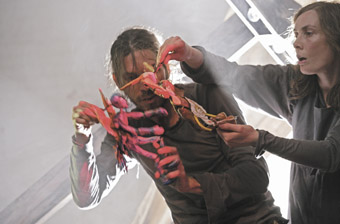
Black Hole Theatre, Coop
photo Jeff Busby
Black Hole Theatre, Coop
THE 2008 UNIMA INTERNATIONAL PUPPETRY FESTIVAL WAS DRIPPING WITH HISTORICISM, ITS BROCHURE PRINTED TO RESEMBLE A YELLOWING, WELL-THUMBED DOCUMENT, WHILE WOODEN MECHANICAL STRUCTURES (ROMEO E JULIA’S MARIONETTES, CLATTERING TOYS IN THE MECHANICS ALIVE EXHIBITION) FEATURED IN OTHER PUBLICITY. MANY SHOWS HARKED BACK TO ROMANTIC OR EXPRESSIONIST MODES, WHILE MARIONETTES AS PRECURSORS OF CYBERNETICISM WERE CONSPICUOUSLY ABSENT. THE BEST OF THESE WORKS OVERTLY ENGAGED WITH HISTORICAL DISTANCE, WHILE OTHERS ASSUMED THAT 19TH CENTURY IDEAS TRANSLATE TO NEW CONTEXTS.
South African visual artist and theatre-maker William Kentridge’s Woyzeck On The Highveld exemplified this historical and formal ambivalence. His plastic works and films are deeply historicist. Their dark tones (Kentridge works in black and white charcoals), exaggerated physiognomies and focus on (usually male) individual protagonists faced with hostile, modern environments likens his aesthetic to European Expressionism à la Schiele, Nolde, Kirchner, Murnau etc. This is heightened by Kentridge’s choosing to adapt Georg Büchner’s classic precursor of Expressionism, Woyzeck. Casting the protagonist as a poor African servant of the effete, white ‘Captain’(dressed as a bourgeois civilian and with no military role in this version) suggested one could read Woyzeck’s oppressed condition and eventual madness in racial terms. Nothing further was made of this though, while the mise en scene—especially the heavy-handed neo-Romantic music and Kentridge’s animations—suggested that Woyzeck’s fate was as much a product of modern urban life as it was of sociopolitical forces.
In short, Kentridge’s production was highly traditional and conceptually uninspiring. Nevertheless, moments of genuine surrealism and disturbing defamiliarisation shone through. At one point, Woyzeck’s marionette repeatedly tried to set a table devoid of literal props while behind him animations of each object (complete with sound effects) moved of their own accord. Woyzeck’s world seemed to come alive around him (like his own mechanised form) in ways both threatening and beautiful. Similarly an interlude in which a carnival ringmaster proclaimed how any animal (like Woyzeck) could be disciplined to perform intelligent acts on command, was here enacted by a beautiful, snuffling, marionette rhinoceros, whose open wooden ribs established its kinship with both Dürer’s print of the astonishing products of empire, Rhinocerus AD 1515, and to that other prize of human conquests: the hull of a tall ship.
Unlike Kentridge, the local artists behind Red Lashes applied a critical eye to their deployment of art historical materials, drawing on similar European dramaturgical precedents—notably modernism and Expressionist cabaret. Here however these performative concepts and ideas (rough songs, shadow play, themes of perverted village life, dark mines and Grimm fairytale imagery) were invoked ironically. Historicism thereby acted as commentary, as a game or mask which these performers invoked while constantly peeking around the corner of their own theatrical assumptions. Red Lashes’ artists are in love with the imagery of Expressionism, but not with Expressionism as a way of depicting actual social existence. A canny sense of theatrical nominalism and pastiche lies at the heart of the artists’ work.
Red Lashes depicts the town of Guells, where a devoted daughter longs for the return of her dead father and so drops her heart beneath the floorboards where it is transformed into a beast which hungers, mewls and sings, suggesting the result of an implicity incestuous union. In Red Lashes’ dark, compulsive Freudian tales, the use of puppetry, objects and historicism function to distance the audience—not to disarm the tawdry effect but to free the tales for poetry and critical play. In the end Red Lashes suggests that beautiful stories, such as one told by the father, often conceal darker truths and so should be treated sceptically. A closing image shows the female protagonist holding to her breast a glowing red heart like some kind of demonic spawn of truth and poetry.
If Red Lashes gave birth to a child of ‘rough music’ (the term for medieval tricks and aural provocations visited upon newlyweds), then Coop from Melbourne’s Black Hole Theatre was its more precisely and smoothly structured sibling, emanating from a more overtly Artaudian and Surrealist sensibility. Originally devised as a musing on Hieronymus Bosch’s sensually grotesque altarpiece. The Garden Of Earthly Delights (1504), under the title In The Beginning…Uhmmm… (2006), Coop (2007) has evolved into a sophisticated work exploring themes identified by Artaud in his commentary on Bosch. Artaud’s desire to smash through reality, representation and language was motivated by his characterisation of the universe as a demiurgical construction, of creation not as the product of a loving god but rather a demotic trickster and conjurer who has doomed us to false or incomplete perception and to a language insufficient to express reality. Although one can read Coop’s raging, mute patriarch as God—or as a homeless man who imagines himself to be God—the curses and arbitrary rages he visits on his children/companions are more suggestive of Artaud’s Demiurge.
Like Artaud’s work, Coop is resonant with Christian imagery. Coop’s wild, dishevelled young man who returns to the patriarchal fold could be the Prodigal Son, though a later scene where two of the characters animate small marionettes to whom the father-puppet gives miniature wings before jealously ripping them off and kicking the damned male puppet, also suggests the Fall of Satan from his original place as God’s most favoured angel. And is the woman a daughter, sibling, lover, or all of these in her guises as Eve and Mary to these males? Whichever she is—and no single interpretation is satisfactory—she is an object of possessive conflict between them.
The physicality of the performers is particularly astute. They hunch, crawl, grab and stroke—sometimes equipped with wax hands on sticks like ex votos. They gape, contort and shriek as though not quite human. They too are overtly puppets, animated animal-object-things which inhabit this space, given life as much by surrounding scenographic structures (Ben Cobham’s gorgeous set whose crossed arch of exposed beams suggests a wrecked ark or the ribs of Jonah’s whale) and sounds (a wonderful electroacoustic, and often quotational, radiophonic score from Kelly Ryall) as by their own souls or desires. In a particularly haunting moment, the woman is seduced and aroused by the spidery hand of the young man, here given its own life through the addition of a glowing infantile doll’s head.
Amidst such incestuous co-minglings of plastic and meat (also featured is a comically dancing chicken carcass, complete with red boots, choreographed by Michelle Heaven) Lautréamont’s Surrealist adage of humans and objects sharing their desires to produce that which is as beautiful as the coupling —on a dissecting table of a sewing machine and an umbrella—is potently active. While Kentridge revivifies a body now suffering from rigor mortis, director Nancy Black and her collaborators generate a production whose diverse fusions of materials and projections of desire remain conceptually unresolved and endlessly open to new readings.
UMIMA, 20th Union Internationale de la Marionette Congress and World Puppetry Festival, Handspring Puppet Company, Woyzeck On The Highveld, adapted from Georg Büchner, director, co-designer, projections William Kentridge, co-designer, puppet master: Adrian Kohler; Playhouse.April 8-12; Red Lashes, writer Jeffrey Jay Fowler, director Timothy Watts, devisors, performers Michelle Anderson, Oda Aunan, Brendan Ewing, Sharney Nougher, lighting Chris Isaacs; Perth City Farm, April 8-11; Black Hole, Coop, devised by the company, director Nancy Black, designer, lighting Ben Cobham, performers Rod Primrose, Tamara Rewse, Conor Fox, sound, music Kelly Ryall, choreography Michelle Heaven, dramaturg John Paul Hussey; Yirra Yaakin Theatre, April 11-12; UNIMA, April 2-12, www.unima2008.com
RealTime issue #85 June-July 2008 pg. 16
© Jonathan Marshall; for permission to reproduce apply to realtime@realtimearts.net
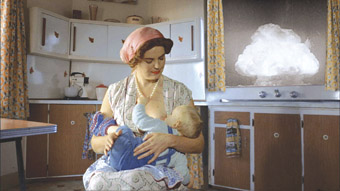
Janet Merewether, Maverick Mother
IN JANET MEREWETHER’S MEMORABLY IDIOSYNCRATIC AND HIGHLY INVENTIVE JABE BABE [BEST DOCUMENTARY, AFI AND IF AWARDS 2005, RT68, P18], THE SCREEN IMAGES OSCILLATE BETWEEN DOCUMENTATION OF THE SUBJECT, A YOUNG WOMAN SUFFERING THE LIFE-THREATENING MARFAN SYNDROME, AND RICHLY STAGED, WITTY PROJECTIONS OF HER FANTASY SELVES. IN MAVERICK MOTHER THE FILMMAKER HAS NOW TURNED HER CAMERA ON HERSELF USING A SIMILAR FORMULA, IF MORE COMPLEXLY AND EVEN MORE REVEALINGLY.
The film’s three-way dynamic comprises informal footage showing Merewether going about her life, meeting with family and friends as she resolves to have a child at 39 years of age and then grapples with the demanding experience. A second strand conjures often comic theatrical visions of herself, again beautifully staged; while the third, where she confronts the camera, or points it into a mirror she is facing, deepens the autobiographical richness of the film with intimate moments of self doubt, confusion, pleasure, fear and grief.
Shifting between these three perspectives, Merewether tells her story chronologically, from the time she decides to act on her feelings and have a child, to just how she does it (she’s not in a relationship), to telling her tolerant mother and disapproving father, to living through the pregnancy and a long and painful birthing, to becoming a proud mother, but one anxious about something missing. It’s the accumulation of anxiety, leavened by the comic theatrical asides and a home movie-ish lightness, that gives the film its emotional strength. From the beginning it’s clear that Merewether is not eager to be a single mother, but she can’t find a man to share parenting. So the solo mother option appears to be the only one. Sex with a bisexual friend yields no result (except his lover smashing a piano), the sperm bank option involves a six to nine month waiting list and, anyway, the description of the donors seems limited to hair, skin colour and occupation. And it feels humiliating for the filmmaker to be labelled as “socially infertile.” Merewether reflects on the irony of the sperm shortage given how men “splash their sperm around” (we watch it shoot onto and dribble down plush red velvet furnishings accompanied by male groaning), but notes the drop in donor numbers since offspring can legally trace their male parent. And then, chance plays its hand—Merewether’s pregnancy is the result of a one night stand at a Nine Inch Nails concert. Suddenly the implications and likely consequences of single motherhood loom large.
Despite a very supportive household and network of friends, Merewether suffers the absence of intimate sharing during pregnancy and acutely in early motherhood. She appreciates how society now tolerates single mothers in ways impossible in her mother’s generation, but she has to live with her father’s blunt espousal of those older values (along with belittling comments about Merewether being a weirdo artist and mothers as managers of ‘minutiae’). She tries to establish contact with the father of her child, hoping for a key male in her son’s life, but the man (a good dancer, she says, and into extreme sports) responds to neither letters nor phone calls, only visiting well after the birth. He’s as reticent and as non-committal as the tactfully blurred image we see of him when he finally appears.
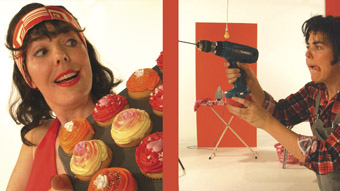
Janet Merewether, Maverick Mother
What appears to strengthen Merewether is her beautiful child, her mother’s acceptance, her brothers promising to take some responsibility for the boy, and hearing American writer Peggy Drexler on radio praising single mothers as mavericks “who make up the rules as they go along.” We viewers need strength too, sharing with Merewether numerous frustrations, the intimacy of a naked transforming body, a lot of birthing blood and baby shit, and tears as the filmmaker weeps into camera shortly after her baby has suffered a dangerous choking episode.
Stress and fear in Maverick Mother are, however, often made light of in the staged scenes, most of them brief if meticulously crafted episodes. Some play on cliches—baby floating on drifting pink cloud, baby in a cabbage patch, baby carried by stork, caveman bludgeoning a potential partner with his club, spinsters at spinning wheels. Merewether is frequently costumed herself—as a doll “left on the shelf”, as a blonde-wigged, cigarette puffing bad mum in sexy leopard print outfit in an apartment in disarray, or a young mother in the 50s about to be deprived of her illegitimate child. In the opening credits she is elaborately dressed and coiffed in baroque mode, large mock breasts bared, squirting milk, as she plays both actress and director while apt period music plays.
Drexler’s notion of solo, maverick mothers potentially reducing global violence yields other images: Merewether as a peasant suckling her child, the World War I dead seen in black and white through an open door behind her; as a 50s mother, an A-bomb plume filling the window; and as a 21st century career woman mother, the twin towers of September 11 smouldering in the near distance. Getting used to the idea that she will have to play mother and father, she reflects on what her father taught her—how to renovate—and we see her alternating between cake-baking housewife and butch home handyman. There’s a wry sense of joy in these transformations, of anything being possible. Merewether begins her film saying she felt like she’d been living on the sidelines of life; at its end she declares, “I am now inside the experience of living.”
Finally, we watch mother and child, “just the two of us”, at the beach in black and white, small frame footage, iterating the home movie idiom of Merewether’s film and the ties it suggests between past and present, and the very big differences. We hear her say, “I have juggled directing this film and directing my new life.” And we applaud her successful balancing act. Baroque is the right word for this film, its neat chronological structure, its tri-partite framing and witty fantasy-making and, as with the best Baroque music, the emotional power unleashed by careful, ostensibly casual crafting by writer-director, cinematographers, composer, editor and production and post production designers collaborating seamlessly.
in memoriam: jabe babe
It is with great sadness we report that Jabe Babe, the wonderful subject of Janet Merewether’s documentary Jabe Babe, died of heart failure, a complication from Marfan Syndrome, aged 34 on April 6. Merewether’s film is a fine tribute to her. Eds.
Maverick Mother, writer, director, producer Janet Merewether, director of photography Justine Kerrigan, pregnancy & birth cinematography Jackie Farkas, video camera Maverick Mother, writer, director, producer Janet Merewether, production & costume designer Melinda Doring, editor?Jan St Vincent Welch, post production designer Tim Ritcher, sound designer Liam Egan, composer Felicity Fox, Produced by Screen Culture Pty Ltd. 52 minutes. www.maverickmother.net. Premiere screening: SBS TV, Feb 1. DVD sales www.marcom.com.au
RealTime issue #85 June-July 2008 pg. 17
© Keith Gallasch; for permission to reproduce apply to realtime@realtimearts.net
CORNEL OZIES’ BOLLYWOOD DREAMING STARTS OUT LIKE PURE BOLLYWOOD—AN ATTRACTIVE YOUNG WOMAN DANCING ELEGANTLY AND FLUENTLY IN TRADITIONAL INDIAN DRESS TO A HEAVY, PULSING BEAT ON SAND BEFORE A WIDE ROCKY OUTCROP. CUT TO A YOUNG GIRL IN PLAITS AND SHORTS SITTING ON THE TOP OF A SKATE BOARD RAMP, TELLING US IN VOICEOVER: “I’M DIFFERENT FROM OTHER GIRLS IN BROOME ‘CAUSE I SKATE, I DO BOXING, KICK BOXING AND LIKE I’M THE ONLY PERSON IN BROOME IN LOVE WITH BOLLYWOOD…IT’S PRACTICALLY MY WORLD.”
Bollywood Dreaming (8 mins) is a thoroughly confident short documentary about an engaging, ambitious girl, Jedda Rae Hill, daughter of an African-American father and an Aboriginal mother from Broome. When not addressing herself to camera about her dreams—to be a skate board hero, a WAAPA student, a Hollywood actress, a Hindi speaker and Bollywood star—she and her mother bicker gently about the risks that boxing and skateboarding threaten to a youthful complexion. In between we see Jedda skateboarding, shot mostly below the knee, emphasising the speed and her pleasure in it, and pulling back for the odd fall. An extended Bollywood episode confirms how much she’s learned from watching the films over and over.
Bollywood Dreaming ends on a slightly sad note. For all her ambition and potent sense of self, Jedda muses, “I doubt they’ll be hiring any Aboriginal African-Americans. But it’s a dream.” This short film is perfectly constructed and intimately realised, director Cornel Ozies doubtless benefiting from the considerable experience of the film’s writer and director’s mentor, Mitch Torres, and the expressive camera work of David Tindale.
Two films deal with the Dreaming. Karla (writer-director Karrie Anne Keating, 7 mins), the story of how fire came to the Nyungars of the Pinjarra region, uses a mixture of traditional dance, story-telling around a camp fire and paintings, some of which are enlivened by simple animation. It’s Kelton Pell’s telling that is the film’s great strength: first we hear him, later we see him in close-up, then in the glow of the fire and finally engaging his young audience. Rob Bygott’s cinematography works the play of light and dark adroitly and Kimberley West’s editing maintains the film’s momentum as it shifts between formats. In Who Paintin’ Wandjina (8 mins), three senior Aboriginal women from the Kimberley region learn of a young graffiti artist who is covering Perth with images of Wnadjina, the spirit who came to earth in the Dreaming to give the people their law. Writer-director Taryne Laffer cleverly juxtaposes the voice of the artist (he remains anonymous) with the three onscreen women speaking in turn about the damage they feel the graffiti will do to their culture. It generates some sympathy for both sides of the argument even though the promise of resolution seems unlikely.
There’s no doubt that the graffiti artist’s work is inventive, often subtly placed and rich in colour. He originally thought he was doing the Aboriginal people a favour by spreading the image. But, as the women say, “Where is the spirit, where is the land, where is the story?” And the rich colourings offend because traditionally Wandjini are painted only in black, yellow, red and white. A “watering down” of the image’s power and meaning is feared, especially since, as one of the women explains, her people have no intellectual copyright in the image. Mark Parish’s cinematography alternates between the relative stillness of the women and rapid flow of graffiti images (editors Kimberly West, Rob Bygott), emphasising their viral spread.
Writer-director Mandy Corunna’s Wrong Way (7 mins) is straightforward documentary storytelling about teenagers who fall in love not knowing that they’re cousins (a result of the way families had been separated). Her mother forces the lovers apart but soon they elope, baby in arms, heading by bush track 87km to New Norcia but are deterred by pursuers. Eventually they find another town to live in and raise 12 children, but the girl’s mother always fears some kind of payback. The film is narrated onscreen by a descendant and reinforced with old photographs and simple re-enactments. Most affecting is the story of the journey told by the young wife, recorded in her old age in 1999.
Your’e Not Playing That! (4.30 mins) is as obvious as its title. A little boy in an AFL football-mad WA household would prefer to play rugby, much to his father’s horror, not least because he’s named his son Alex after his footballer hero Alex Jesaulenko. In a brief reverie, the boy imagines himself as a rugby superman knocking down an opponent (his father as another super hero) on his way to a touchdown. If the tone is comic, the father’s anger is nonetheless palpable. But the boy’s mother is sympathetic. Cut to a professional rugby player in a dressing room, snapping awake from this childhood recollection and about to play before his parents for the first time. The family await the start of the match, full of anticipation, except for dad watching football on the mobile. Mum sets him right. The end. Writer Kelli-Cross’ film is feelgood fun, given a little dark oomph by Trevor Jamieson as dad.
Bollywood Dreaming is clearly the best film in this edition of Deadly Yarns, not only because it’s subtly and expressively crafted, but because it focuses on a distinctive subject—a young Aboriginal woman indentifying with male sport and Indian film in her search for a place in the world. It’s about the options for making a life, a hybrid life, drawing on a distant culture, and no stranger than the Indigenous appropriation of country music and hip hop. Who Paintin’ this Wandjina is also a strong film, especially after several viewings. It uses the beauty of art—original, spiritual Indigenous art and its dextrous graffiti copies—and the deftness of its filming to explore the contentious and emotionally disturbing subject of cultural ownership. These films look like promising career beginnings. Collectively they confirm the ways in which Australian Aboriginal people live hybrid lives, and have hybrid dreams while their Dreaming dreams on.
–
Deadly Yarns 3, Indigenous Short Films for ABC TV’s Message Sticks; developed and produced with the assistance of Screen West, Lottery West, ABC TV and FTI [Film & Television Institute WA], 2007
RealTime issue #85 June-July 2008
© Keith Gallasch; for permission to reproduce apply to realtime@realtimearts.net
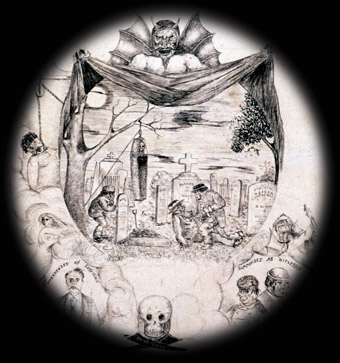
Bernard Lloyd, Homo Tasmanicus, image courtesy of WL Crowther Library, State Library of Tasmania
THAT THERE IS A NOTION OF TASMANIAN GOTHIC IS A LONG ACCEPTED ONE; A DEFINITION OF WHAT IT MIGHT CONSIST OF IS QUITE ANOTHER MATTER. I HAVE MY OWN VERSION, OF COURSE, AND IT MAY WELL BE QUITE DIFFERENT FROM THE INTERPRETATIONS PRESENTED TO AN ENTHUSIASTIC GROUP OF LOCAL FILM WATCHERS IN THE PEACOCK THEATRE, ITSELF A ROOM THAT ECHOES WITH AN OLD UGLINESS. THIS COMFORTABLE VENUE IS LOCATED ALMOST PRECISELY IN THE AREA WHERE WHALES WERE CARVED INTO MORE MANAGEABLE CHUNKS WHEN THE TOURIST PRECINCT OF SALAMANCA WAS ONCE A THRIVING DOCKLANDS. TYPICAL TASMANIA REALLY: AWFUL YARNS AND FACTS ABOUND ALL THROUGH THE PLACE, FROM MINOR DETAILS TO DEEPER HORRORS OF GENOCIDE AND EXTINCTION. THERE ARE A LOT OF WAYS TO GET THE CREEPS ON THIS COLD ISLAND.
The event I was attending was the screening of the results of a pilot guerilla filmmaking program run by the energetic Rachel Lucas and facilitated by Wide Angle Tasmania, an organisation that lives up to its name, presenting programs like this one, teaching more advanced, focused technical skills and screening local filmic endeavour.
Guerilla filmmaking is, like Tasmanian Gothic, another term open to varying interpretation, but it was easy to see what it meant here—get a camera and get going. The films were shoestring budget efforts, made to a tight schedule that left little time for contemplation or frippery. The emphasis on demystifying process and empowering these newer filmmakers to tell their stories and make screen-ready narratives yielded varying results, but one has to start somewhere, and this program was about getting people out of the blocks. I must admit to liking this kind of approach a lot and it echoes the old punk adage: this is a guitar, these are three chords, now form a band.
Rachael Lewis’ awfully tense footage of a chicken attempting to cross a road seemed to be a gag but then got quite dreadful as the possibility of seeing something die on screen was dangled. The film was called Les Roadkill and we’d already been treated to loving close-ups of car-damaged native animals by the time the chook appeared.
Watching Vivien Mason’s Two Heads Are Better Than One I was prepared to dismiss a discussion of the old two-headed Tasmanian myth as just too daft, but this documentary style film did its research well, finding an explanation for the myth—a lack of iodine in local soils had resulted in a plague of goitre and consequent neck scars—before presenting a chap who had made a decent living out of selling two-headed images on postcards. Another documentary, Tracie Walsh’s Slaughter at Pittwater, led us into the uglier aspects of Tasmania’s history, discussing an Indigenous massacre, Aboriginal resistance and a subsequent legal cover up.
The jewel in the crown of this screening was Homo Tasmanicus by Bernard Lloyd, a terrific research effort into the true tale of a gruesome tussle by factions of doctors for the possession of the body of one the last of the Tasmanian Aboriginal people, William Lanny. The narrative is constructed from extensive quotations from letters of one Doctor Crowther, who so coveted the scientific prize that he was oblivious to human dignity. This ugly tale, filled with midnight digging, body snatching and dissection yielded a feeling of hideous, immoral murk. The awful narrative was well supported by a smart decision to use extant historical imagery, all made to resemble the projections of a magic lantern, that ancient flame powered device that predated film itself. This was the Gothic moment of the evening, the screen mostly black, allowing us to peer voyeur like into our hideous past. Satisfyingly nasty.
Wide Angle Tasmania, Summer Screen Safari: Tasmanian Gothic, Screening and Discussion; Peacock Theatre, Salamanca Arts Centre, March 12; www.wideangle.org.au
RealTime issue #85 June-July 2008 pg. 18
© Andrew Harper; for permission to reproduce apply to realtime@realtimearts.net
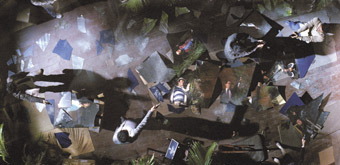
The Mad Detective
THE HONG KONG FILM INDUSTRY, LIKE THE CITY ITSELF, CHANGES CONVULSIVELY. GONE ARE THE DAYS OF A VIBRANT COMMERCIAL INDUSTRY BASED ON EXUBERANT GENRE FILMS. IF THE LOCAL PANORAMA SECTION AT THE RECENT HONG KONG INTERNATIONAL FILM FESTIVAL IS ANYTHING TO GO BY, THE POSSIBILITIES HAVE POLARISED INTO BIG BUDGET HACK-AND-SLASH HISTORICAL EPICS CO-PRODUCED ON THE MAINLAND OR SMALL CITY-SPECIFIC YOUTH FILMS MADE CHEAPLY BY FILM SCHOOL GRADUATES.
It seems that the last man standing in the commercial cinema is Johnnie To Kei-fung. He had three films screening in and around this year’s festival and, at the time of writing, several attempts are underway to bring these films (and the man himself) to Australian cinemas. To is a prolific figure, having directed over 50 films in the past 25 years and producing many others through his company Milky Way Image. He has won numerous awards with films such as The Mission, Running Out of Time, the two recent Election films and Exiled.
After years of moving between styles in order to gain international recognition as an auteur, To seems to have found a mature vision with his recent films, The Mad Detective and Sparrow. He is an unashamedly commercial director working in crime stories and occasionally comedies, but one who wants to push genre filmmaking to the limits of abstraction. It is no accident that his films have become staples at the Cannes, Berlin and Venice film festivals over the past couple of years.
The Mad Detective marks To’s reconciliation with scenarist Wai Ka-fai with whom he collaborated on the equally bizarre Running on Karma in 2003. Wai has an established thematic interest in visionary protagonists who are powerless to change their destiny. Long-time To star Lau Ching-wan plays Bun, a cop whose curse is his ability to see people who aren’t there.
The self is an essentially porous construction in this film. By placing himself in the physical position of others, Bun can identify himself completely with them and thereby recreate crimes. Hence, his unorthodox methods of detection include being zipped into a large carry bag and thrown downstairs. He also looks within people and sees the deeply divided components of their psyches, including a killer with seven different personalities. As one who is ever more conscious of the fat, middle-aged accountant and the Japanese schoolgirl simultaneously struggling for ascendancy inside him, it’s difficult not to take the detective’s madness seriously.
The film involves the continual adjustment and refinement of its abstract premises for the audience. There is no early overarching explanation of the detective’s powers or his hallucinatory plight. Each scene plays out like the solution to a piece of puzzle which, in turn, sets up a further puzzle. Our understanding of the narrative situation unfolds incrementally. In one scene, Bun intervenes to stop a young girl shoplifting and then argues with his wife who protests his interference. It turns out that his wife is upset because the girl wasn’t really there. It’s only some time later, however, that we realise that the wife wasn’t there either.
While this sounds rather cryptic, the film was a commercial success in Hong Kong because it rewards the audience for figuring out the puzzle as the film progresses. It’s a film which makes you feel smarter at the end than when you went into the cinema.
Sparrow, which premiered at the Berlin Film Festival earlier this year, is a long-term To project, shot over three years between other projects. It is much lighter in tone than most of To’s recent crime films, dealing with a group of small-time pickpockets who are recruited by a mysterious temptress to win her freedom from a threatening sugar daddy.
The story proceeds through a series of set pieces in which the object is to imply everything while telling the audience as little as possible. The film shimmers along with a minimum of dialogue. The female protagonist’s sexual allure is established in the way she takes a cigarette from the mouth of one of the heroes, takes a drag leaving lipstick on it, and then wordlessly returns it to his lips.
Glorious spatial play abounds unencumbered by dialogue. The gang pursues the woman into a tiny elevator, only to find they are jammed into the space with two workmen carrying a huge fish tank. All the threat and the tension in the scene has to be spoken with looks, just as the space has to be broken up and reassembled through montage.
This push towards a purely formal organisation of narrative finds its crescendo in the final encounter featuring black umbrellas, driving rain and the swirling abstraction of figures pirouetting in the dark. It is one of the most deliciously choreographed and cut sequences in contemporary cinema.
The lightness of tone comes from the way To foregrounds the aspect of play in genre narrative, and so it comes as no surprise that he organised Triangle, the third of his films shown at the Hong Kong festival. The challenge here was that Tsui Hark should script and direct the first third of a film, deliver it to Ringo Lam who would make the middle, and then pass it on To who would provide the end. In the spirit of Lars von Trier’s The Five Obstructions, Triangle explores the idea that art-making is a playful process in which you constantly set yourself challenges which you then try to overcome.
The story echoes or allegorises the challenge of this collaboration as three buddies try to pull off a heist, while trying not to betray each other in the process. The result is surprisingly coherent despite Tsui’s characteristic disregard for narrative clarity, and the marriage of To’s more elegant and elegiac sensibility with the smash and grab cynicism of his colleagues. Where Lam has the treacherous female character apparently fatally wounded, To miraculously (and gracefully) resurrects her and reconciles her with her husband. The discontinuity works as a kind of wink to the audience, highlighting and celebrating the arbitrary nature of the game of artistic form.
Johnnie To Kei-fung, The Mad Detective, Sparrow, Triangle [with directors Tsui Hark and Ringo Lam], 32nd Hong Kong International Film Festival, March 17-April 6,
www.hkiff.org.hk/eng/
RealTime issue #85 June-July 2008 pg. 19
© Mike Walsh; for permission to reproduce apply to realtime@realtimearts.net
![En La Ciudad de Sylvia [In the City of Sylvia]](https://www.realtime.org.au/wp-content/uploads/art/19/1942_city_of_sylvia.jpg)
En La Ciudad de Sylvia [In the City of Sylvia]
JOSÉ LUIS GUERIN’S IN THE CITY OF SYLVIA, WHICH TOURED IN AUSTRALIA RECENTLY AS PART OF THE LA MIRADA SPANISH FILM SERIES AND IS PROGRAMMED FOR THE 2008 SYDNEY FILM FESTIVAL, EMERGED FROM LAST YEAR’S CANNES FILM FESTIVAL AS ONE OF THE MOST IMPORTANT FILMS OF THE YEAR. IT IS ONE OF A GROWING NUMBER OF DRAMATICALLY MINIMALIST WORKS—THINK OF THE FILMS OF HOU HSIAO-HSIEN AND TSAI MING-LIANG FOR STARTERS—WHICH PARES DOWN ITS NARRATIVE TO ALLOW THE CONSTRUCTION AND MANIPULATION OF CINEMATIC SPACE TO COME FORWARD.
The story, such as it is, is a vaguely autobiographical one about a young man who briefly met the eponymous Sylvia in a Strasbourg bar six years previously. (In real life, Guerin returned to Strasbourg 22 years after the initial encounter.) He has now returned to the city in the hope of finding her, or at least seeing where his obsessive return to their meeting will lead him. He sits at a café, follows a woman whom he mistakenly believes to be Sylvia, and revisits the bar where he encounters another woman. End of story.
Guerin, who introduced the film when it screened at the Hong Kong Film Festival recently, said that he wanted to take narrative and character psychology out of the film, so that the audience would be forced to concentrate on gesture and the processes of watching and listening.
The nameless protagonist, played by Xavier Lafitte, spends most of the film simply watching women. He is equipped with lightened contact lenses so that he appears to be a pair of shining eyeballs. The erotic power of looking is clearly important here. Women repeatedly stare down from advertising posters, returning his look, and challenging that of the camera. When the man has a sexual encounter with the woman he meets at the bar, all we see are the two looking at each other. We don’t see them having sex, or perhaps we do in this exchange of looks.
It is, of course, one of the banal commonplaces of bad film theory that movies are all about voyeurism, particularly male voyeurism. Guerin is clearly interested in this proposition but also in going beyond it to explore the ways in which looking is a vital part of our spatial orientation to the world and to the cinema. The opening sequence, in which the central figure sits at an outdoor café looking and sketching, becomes a rich forest of glances performing a multitude of functions.
The astonishing thing about the scene is the way it sustains and varies itself while little or nothing of narrative interest occurs. The man barely speaks, and only shifts position once, though in the minimalist context of the film, be assured that this is a moment of some excitement! He mainly looks from place to place, inviting us to look, really look, at the images.
My emphasis thus far on looking risks devaluing the importance of the soundtrack, which provides a primary means of interpreting the denseness of the physical environment. As the man follows the woman he thinks might be Sylvia through the labyrinthine alleyways of the city in the middle section of the film, we start to concentrate on the sound of trams, street musicians, bottles rolling on the pavement—the everyday transformed.
These are all sounds which would normally be relegated to the peripheries of our attention but as Guerin puts it: “When the figure disappears, the surroundings appear.” The lack of dialogue and non-diegetic music focuses attention on the soundscape. At one moment I was shocked to hear non-diegetic music fade up, until a car drives through the foreground, and with a sudden shock of recognition, you see that its radio is the source of the music. Guerin uses devices such as this explicitly to draw our attention to the interaction of picture and sound.
A drunken old woman sits on the footpath and kicks away a bottle. Some time later we return to the same framing, and though the old woman is now absent, we hear someone off-screen kicking over a bottle. There is a thrill of recognition here. Passersby in the street start to appear as choreographed performers and recurrent characters, such as an African man selling odds and ends, take on the significance of a chorus.
The effect is something like Jacques Tati’s masterpiece Playtime, in which the world is made strange and wonderful by the play of form. It is a vision of a world transformed not merely by male desire, but rather by looking and listening closely—by cinema.
When I suggested the comparison with Tati to Guerin (who also teaches at the Pompeu Fabra University in Spain), he accepted it enthusiastically. He is that rare type of filmmaker—certainly if we compare him to most of his Australian counterparts—who speaks knowledgably about a wide range of films. There are rich echoes of Hitchcock’s Vertigo here too, not to mention Chris Marker’s Sans Soleil.
The film is often screened (though unfortunately not in Australia) with its companion piece/predecessor, Some Photos in Sylvia’s City, which began as a video journal kept by Guerin. The resultant piece is composed entirely of still images in the style of Marker’s famous La Jetée. This totally silent, black and white film is something like the sketches which the protagonist scribbles in the first sequence of Sylvia. It is at once a blueprint for the latter film and in a kind of dialectical opposition with it.
While In the City of Sylvia remains resolutely within the minimal nature of its story, some Photos in Sylvia’s City uses intertitles to establish a didactic comparison with the motif of the male artist’s obsession with women in the European literary canon from Dante to Petrarch to Goethe. In Guerin’s latter film, the down-scaled version of this literary precedent becomes the graffiti “je t’aime Laure” (the subject of Petrarch’s passion) repeatedly spray-painted on the walls of Strasbourg.
Guerin’s triumph is the transformation of urban space into an eroticised aesthetic space through a rich variety of artistic practices, including writing and filmmaking, but in both instances, a world transformed and animated by desire.
En La Ciudad de Sylvia [In the City of Sylvia], director, writer José Luis Guerin, 84 mins, 2007; 32nd Hong Kong International Film Festival, March 17-April 6, www.hkiff.org.hk/eng/; screening in the Sydney Film Festival June 8.
RealTime issue #85 June-July 2008 pg. 20
© Mike Walsh; for permission to reproduce apply to realtime@realtimearts.net
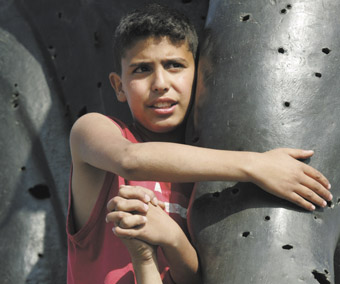
Beirut Diaries
THE SYDNEY ARAB FILM FESTIVAL, MANAGED BY INFORMATION AND CULTURAL EXCHANGE (ICE), EXISTS IN ORDER TO CREATE A CRITICAL SPACE WHERE THE COMPLEXITY AND DIVERSITY OF ARAB EXPERIENCE CAN BE EMBRACED. OBVIOUSLY, THIS IS A VERY IMPORTANT UNDERTAKING WHEN THE MAINSTREAM MEDIA IN AUSTRALIA RELIES UPON AN ARRAY OF PREDOMINANTLY NEGATIVE AND MISLEADING STEREOTYPES. THE FESTIVAL PROVIDES THE OPPORTUNITY TO ENJOY ALTERNATIVE REPRESENTATIONS OF ARAB CULTURE, WITH AN EXPLICIT EMPHASIS ON PERSONAL STORYTELLING AND SELF-REPRESENTATION.
Viewers came out in force for the 2008 festival, making it clear that there is not only a political need for these alternative critical spaces in Australia, but a deep hunger for them. Films serious and whimsical, unashamedly romantic and stridently political were all embraced by sell-out crowds.
The history of the festival itself reveals that this vision has taken shape over a number of years. The first Sydney Arab Film Festival was held in April 2001 over three days at The Roxy Parramatta in association with Casula Powerhouse’s East of Somewhere exhibition. In 2004, ICE hosted A Big Night of Arab Shorts, showcasing local short films by Arab-Australian filmmakers. In 2005, a major event was staged with 48 local and internationally produced films screened across Campbelltown, Parramatta and Bankstown. After a break in 2006, the 2007 festival was held over four consecutive Sundays at Parramatta Riverside Theatres with three international guests and additional forums presented at other venues along with TONE, an exhibition presented by Casula Powerhouse.
The 2008 festival has taken a much more streamlined shape, running over four days in one venue—a strategy that appears to have paid off in terms of attendance and profile.
The festival opened with a sold out Australian premiere of Caramel, a luscious Lebanese and French co-production directed by Nadine Labaki, who also stars in the film. The film traces the complex stories of four friends whose daily lives intersect at a Beirut beauty salon. Recently released in Lebanon and France, Caramel has become the most successful Lebanese film ever to be released in both countries. Nadine Labaki has been named by Variety magazine as Middle East Filmmaker of The Year. Hopscotch will release Caramel in Australia in mid-2008.
Three other feature films screened at the festival. Seventh Heaven, a new feature from Egypt was introduced by festival guest, director Saad Hendawy. His film explores the complex relationship between Bakr, a celebrated but conflicted Sufi dancer, and Hanan, an independent and wealthy single woman who works as a high-class prostitute, previously uncharted territory for the Egyptian cinema.
On an entirely different note, the Tunisian film TV is Coming, directed by Moncef Dhouib, offered audiences a whacky and biting satirical comedy. In the sleepy Tunisian town of el-Malaga, news of the arrival of a German television production sends the town’s cultural committee into a frenzy of cultural production and intense self-censorship.
The festival’s closing night introduced Underexposure, billed as the first Iraqi feature film since the beginning of the war on Iraq and the first uncensored feature film from that country in over a decade. Directed by Oday Rasheed, Underexposure weaves together stories of fictional characters with real footage of the landscape of war-torn Iraq. This strategy worked to highlight the difficulty for filmmakers of even thinking through how to represent what has happened to their country and the difficulty of negotiating the huge volume of televisual imagery that has already come to stand in for their experience.
The closing night also saw the launch of ICE’s Changing Lives project which includes a website that facilitates digital storytelling by young Arab-Australians. The first group of these beautifully crafted digital stories by young Iraqi-Australian women can be found at www.changinglives.com.au.
Two major forums, one on Palestine the other on Lebanon, were presented at the festival, both chaired by Dr Paula Abood. The festival marked the 60th anniversary of “al Nakba”, the Catastrophe of 1948 for the Palestinian people when their land was taken from them. In the first part of the substantial double session—Palestine Films & Forum—Maher Maghrabi, a writer and a journalist for The Age, powerfully worked the metaphor of the wall for the audience in order to introduce a documentary, The Iron Wall. Directed by Mohammed Alatar, it potently illustrated the political significance of the Israeli settlements and outposts that have been built in Palestinian territories and provided a detailed picture of how the ongoing building of the wall is fracturing Palestinian land and people. The film featured interviews with prominent Israeli and Palestinian peace activists and political analysts. The second part of this forum revealed a very different approach to the Palestinian situation in the fictional short film Before the Wind Blows, by Samer Najari. Three young people—a World War II Japanese pilot, a young Lebanese woman during the civil war of the 1980s, and a young Palestinian man from a refugee camp in the Occupied Territories—are each having their portrait taken as they prepare to depart on their respective suicide operations.
The second forum focused on women’s contributions to the Palestinian struggle. It was introduced by Randa Abdel-Fattah, lawyer, writer and author of the acclaimed novel Does My Head Look Big in This? The short film Make a Wish, directed by Cherien Dabis, carefully crafted the graceful story of Miriam, a young Palestinian girl determined to muster together enough money to secretly buy a cake to celebrate the birthday of her missing father. The documentary Women in Struggle, directed by Buthina Canaan Khoury, introduced four Palestinian women who were former political prisoners in Israeli jails and who spoke about their resistance, their experiences in prison as well as their current daily life under occupation.
The equally packed session on Lebanon focused on films made by Australian residents who traveled there, documenting the aftermath of Israel’s 2006 attack. In the short documentary A Wishful Smile, Mirna Nassar explored the experiences of two residents of Qana in southern Lebanon devastated by the bombing of their village. Lebanon Burning, directed by academic and journalist Peter Manning and produced by businessman Mohsen Safieddin, reported on the targeting of civilian factories and infrastructure by Israel. Manning has written Us and Them: A Journalist’s Investigation of Media, Muslims, and the Middle East, examining many of the issues with which the Sydney Arab Film Festival is in dialogue. A major medical supply factory run by Mohsen Safieddin’s family was targeted by the Israeli offensive and obliterated in the attack. It was disappointing to learn at the forum that Lebanon Burning, a story that so far has not been told by the Australian media, has been rejected by both SBS and ABC.
In another documentary session, Beirut Diaries: Truth, Lies and Videos followed the experiences of a young woman who takes part in a downtown Beirut tent camp that served as the physical and emotional heart of the protest movement after the February 2005 assassination of Lebanese Prime Minister Rafik Hariri. This feature length documentary, directed by Mai Masri, provided powerful access to the everyday political activism on the streets of Beirut, revealing a wide range of divisions and alliances among young people concerned about the future of their nation.
Professor Ghassan Hage had launched the festival with a beautiful, strong speech that emphasised the importance of the event as a space where positive identity formation and dialogue can take place, perhaps in a way similar to the hopes of the tent camp in Beirut Diaries. The power of film, in particular, as a medium that can, as Hage describes it, help us pull ourselves together, was certainly exemplified by the success of this year’s festival.
It’s exciting to see the Sydney Arab Film Festival truly start to come into its own in 2008 as the result of years of grassroots community activism. The vision, the hard work, the hopes and the dreams of the organising committee are clearly beginning to pay off.
2008 Sydney Arab Film Festival, festival directors Fadia Abboud, Mouna Zaylah, organising committee Firas Naji, Phillip George, Alissar Gazal, Mohamed Duar, Paula Abood, Khaled Sabsabi, Fatima Mawas; Information and Cultural Exchange, Parramatta Riverside Theatres, April 10-13
RealTime issue #85 June-July 2008 pg. 21
© Megan Carrigy; for permission to reproduce apply to realtime@realtimearts.net
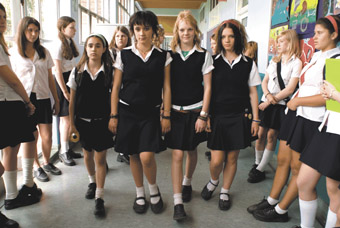
Hey Hey It’s Esther Blueburger
THE ONLY JEWISH GIRL AT AN UPTIGHT PRIVATE CHRISTIAN GIRLS SCHOOL, 13-YEAR-OLD ESTHER BLUEBURGER (DANIELLE CANTANZARITI) SERIOUSLY STRUGGLES TO FIT IN. ONE OF THE FEW LINES SHE SPEAKS TO ANYONE AT SCHOOL PRETTY MUCH SUMS IT UP, “I KNOW YOU HATE ME, BUT MY MUM THINKS YOU’RE COMING TO MY BAT MITZVAH.”
Writer-director Cathy Randall has described Hey Hey It’s Esther Blueburger as a female twist on the Holden Caulfield tradition, made in response to her own experiences of growing up without access to female outsider heroes.
Esther finds her own way to fit in by breaking out. This happens in part because she meets Sunni (Keisha Castle-Hughes) who plays the drums, goes to the local public school, has a cool, relaxed mum (Toni Collette) and does not judge Esther for being different.
Esther also breaks out successfully because she has a seriously camp sensibility. The opening sequence of the film gives an almost aerial view of the school grounds as uniformed schoolgirls choreographically embrace their lunch. It’s a satirical homage to Busby Berkeley that makes eating school lunch look like synchronised swimming or perhaps more like a propaganda film for the Hitler youth. In fact, this high angled view of the playground is Esther’s. It’s what the film’s production designer Nell Hanson calls “Esther-Vision.” It is not quite reality but it reflects the way Esther sees things with her impressively quirky imagination.
Esther-Vision is, in many ways, what drives this film. It comes on with varying degrees of intensity throughout. When Esther is peer-pressured into giving a guy a blowjob in a back alley on a night out, instead of the act we see her dancing in garish bright colours atop a makeshift stage. When Esther clandestinely attends Sunni’s public school as a Swedish exchange student, it’s a ruse that produces a strange piece of performance poetry for her new class. She is suddenly compelled to repeat it upon return to her private school and is chased off the edge of the stage by a school prefect for her efforts.
This is not a traditional teenage comedy but it draws on many major elements of that genre. What makes the film work is its ability to use the over-the-top camp satire of Esther-Vision for sharply observed social critique. At one moment during Esther’s bat mitzvah, all the mothers and grandmothers in attendance seem to chase her around the family garden recommending hairdressers and putting down her rather geeky appearance. Such a moment might border on cheap and clichéd satire but it works as critique, partly because we see all of this from Esther’s point of view.
This comic critique extends perhaps most unflinchingly to the dysfunction within Esther’s nuclear family. Her twin brother Jacob (Christian Byers) travels on his own hilarious journey of teenage identity crisis from obsessive genius to expelled, fantastical axe wielding menace, to becoming Jewish Orthodox.
Esther’s mother, Grace Blueburger (Essie Davis) also goes on an emotional journey as a result of Esther’s escapades. She never moves too far away, however, from the inhibitions arising from her obsession with living up to her middle-class cultural expectations. Esther’s father, Osmond Blueburger (Russel Dykstra) maintains a stronger sense of empathy with his children throughout the film but remains somewhat in the background.
Thankfully, the film does not resolve the family’s dysfunctional relationships in the final dinner scene. Esther’s parents still fail to really acknowledge her but have come to some self-awareness and a sense of humour about the way they all misunderstand each other.
It has taken more than six years to realise this gorgeous project. In 2002, Randall won a scholarship to attend the Los Angeles Film School’s Feature Development Programme. In 2003 she received an AWGIE award nomination for best un-produced screenplay. It was then picked up as the first feature produced by Miriam Stein with Tama Films, the company Stein set up in 2003. The South Australian Film Corporation provided incentives for the feature to shoot in South Australia.
Hey Hey It’s Esther Blueburger was one of two Australian films selected for the Generation section of the 2008 Berlinale, along with The Black Balloon. Since 1978, the Berlin Film Festival has had a special section dedicated to films that look at the world from the viewpoint of children and youth (a children’s section has been introduced to the Sydney Film Festival in recent years). It is exciting to see Randall’s first feature film being celebrated at home and overseas. Let’s hope it continues to reach Esthers everywhere and to foster the camp imagination in all of us.
Hey Hey It’s Esther Blueburger, writer, director Cathy Randall, producer Miriam Stein, director of photography Anna Howard, production designer Nell Hanson, editor Dany Cooper, original music Guy Gross, sound designer Liam Egan, Tama Films, distribution Disney; www.estherblueburger.com
RealTime issue #85 June-July 2008 pg. 22
© Megan Carrigy; for permission to reproduce apply to realtime@realtimearts.net
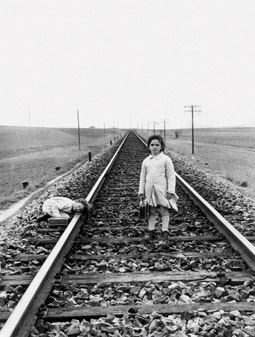
The Spirit of the Beehive
Many RealTime readers will be familiar with the films of Abbas Kiarostami and have read about his photographic work (reported from an exhibition in Beijing in RealTime 84, p24). He’s soon to direct Mozart’s Cosi Fan Tutte for the English National Opera. Spain’s Victor Erice, filmmaker and reviewer, is a much less familiar figure having made only three, albeit acclaimed, feature films (The Spirit of the Beehive, 1973, The South, 1983, The Quince Tree Sun, 1992) over some 30 years.
An exhibition of film, video, photography and painting by the two artists will be accompanied by filmed dialogues. Erice and Kiarostami are the same age and their films share some common preoccupations with childhood and our place in the landscape as well as distinctively poetic and contemplative styles of filmmaking.
Correspondences: Víctor Erice and Abbas Kiarostami offers a rare opportunity, beyond film scholarship and documentaries, to engage with filmmakers through their other means of expression and their communication with each other. To be able to see some of their key films, like Erice’s remarkable The Spirit of the Beehive (a superior companion piece to Guillermo Del Toro’s Pan’s Labyrinth) in this context will make for a very special cinema experience. RT
Correspondences: Víctor Erice and Abbas Kiarostami, curators Alain Bergala, Jordi Balló, Centre de Cultura Contemporània de Barcelona and la Casa Encendida de Madrid, ACMI Screen Gallery, Aug 21-Nov 2. Complementary film program to be announced,
RealTime issue #85 June-July 2008 pg. 22
© RealTime ; for permission to reproduce apply to realtime@realtimearts.net
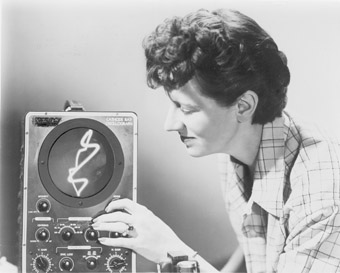
Mary Ellen Bute (USA), pioneer of visual music and electronic art
courtesy of GoMA
Mary Ellen Bute (USA), pioneer of visual music and electronic art
WITH CENTURIES OF NEAR-CONTINUOUS PRACTICE, THE ART OF VISUAL MUSIC HAS FASCINATED AND OBSESSED COUNTLESS ARTISTS AND SPECTATORS. THE 24 SESSIONS OF THE AUSTRALIAN CINEMATHEQUE AT THE GALLERY OF MODERN ART’S VISUAL MUSIC PROGRAM ARE BOTH AN IDEAL ENTREE FOR THE UNINITIATED AND A KIND OF ABSTRACTIONIST CRACK FOR THE LEGION OF FANS OF THIS HYBRID GENRE. EXCITEMENT GREETED THE COMMENCEMENT OF THIS PROGRAM, WHICH IS SHAPED BY THE MAJOR 2005 SURVEY SHOW AT THE LOS ANGELES MUSEUM OF CONTEMPORARY ART AND THE HIRSHHORN MUSEUM AND SCULPTURE GARDEN IN WASHINGTON DC IN THE SAME YEAR. AS THE INTRODUCTION TO THAT SHOW’S CATALOGUE STATES, THE HISTORY OF VISUAL MUSIC IS THE HISTORY “OF A REVOLUTIONARY IDEA: THAT FINE ART SHOULD ATTAIN THE NON-REPRESENTATIONAL ASPECTS OF MUSIC.”
The GoMA Visual Music program explored ways in which film and fine art have historically conversed, through the lens of what is variously referred to as colour music, motion painting, lumia, and non-objective film. What transpired was more a survey of the international cinematic practice of visual music, with all the criticisms to do with the limitations of scope, alongside accolades of significant achievement, that such a survey was inevitably going to attract.
One of the show’s most noteworthy events was the extensive Silly Symphonies program featuring the lively animated audio-visual choreographies of folk tales and nursery rhymes produced by Walt Disney between 1929 and 1939. The 35 Silly Symphonies films, not part of the Hirshhorn show, were framed with an introduction by Russell Merritt, co-author of a recent book on these early musical animations. Beautiful 35mm prints gave audiences an opportunity to re-live (or experience for the first time) the dynamism of classics such as The Ugly Duckling (1939) and the still creepy Babes in the Woods (1932). Silly Symphonies highlighted what the young Cinematheque, so far, does best: marshall its formidable resources to produce an eye-popping assemblage of historically important works. Securing the prints alone for this, the most comprehensive collection of its kind ever to be presented internationally, is doubtless a serious achievement. While I couldn’t help remembering, as The Big Bad Wolf (1934) screened, the stories of strike actions by un-screen-credited, unhappy and exploited Disney animators (allegedly ‘compensated’ for chronic underpayment with ‘Disney family cameraderie’), and was nagged by the other persistent dark rumours about Uncle Walt’s red-baitin’ habits, this program was nonetheless an unqualified, blue-ribbon triumph.
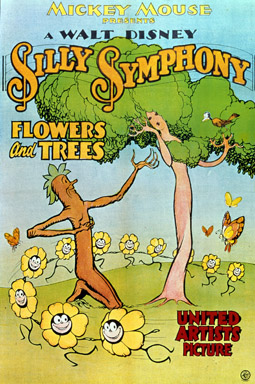
poster Silly Symphonies
courtesy of GoMA
poster Silly Symphonies
Other invaluable linkages between the art of visual music and the mainstream motion picture industry are made in the Saul Bass program. Regarded as the father of the modern film title sequence, Bass’s acid-bright Lissajous spirals in the opening credits and subjective vertigo sequences of Hitchcock’s 1958 gem are a reminder of the cooler, more mathematical modality of psychedelic art. Of course, the program essentially belongs to the hotter, pansensual, consciousness-expanding variety of psychedelia and its various cinematic and machinic iterations by generations of artists, filmmakers and scientists. The incredible Rare Classics program, curated by GoMA guest Cindy Keefer of the Center for Visual Music in LA, was a prime example of the kaleidoscopic approach to moving abstraction by numerous artists in the early-to-mid 20th century.
The Rare Classics program abounded with priceless opportunities to witness the genre’s often-referred-to-but-rarely-seen works, such as John Stehura’s pioneering (1960-1965) computer animation, Cibernetik 5.3, Jud Yalkut’s decidedly brown-acid Turn, Turn, Turn (1966) and some mind-blowing footage from early expanded cinema performances. Along with the unforgettable experience of witnessing the ‘recreation’ film of Oskar Fischinger’s R-1 ein Formspiel (c1926-1933), from his 1920s (!) multiple-projector performances (restaged by William Moritz/Fischinger Archive), there was extraordinary conservation footage of Charles Dockum’s 1952 MobilColor Performance at the Guggenheim Museum (still the Museum of Non-Objective Painting at that time). Watching the latter was, for me, an inescapably dual experience: on the one hand, the sensuously deliquescing rainbow fields emanating from this seminal colour organ were among the purest of visual highs, on the other, the knowledge that Dockum spent so much of his life on work which had (at most) a couple of outings generated wracking sympathy pains. In a move that resonates unpleasantly with the position of fine art film in art institutions in general, the Guggenheim, angered that the machine (which had been part of the inventor’s visual music exploration for nearly 20 years) didn’t play endlessly on a loop and required operators, trashed the MobilColor projector for parts.
No less heart-breaking was the extensive screenings of films from the distinguished career of Stan Brakhage, featuring the characteristic jewel-hued swirls of translucent aniline dyes which, applied with fingers to film stock, gave the avant-garde godfather the cancer which killed him in 2003. Brakhage’s very embodied visual music, often analogised to Abstract Expressionism, epitomises what Amelia Jones has called the “Pollockian impulse” to register the ‘presence’ of the artist in the traces of gestural marks; here not on canvas laid on the floor, but filmstrips stretched over a lightbox—in Jones’ words, “’proof’ of the vigorous act of making.” Brakhage’s reference to his work as “visual music” and “moving visual thinking” definitely justifies the inclusion of this work in the program. However, a cavernous distance between his and other work in the direct animation mode also on show, such as the always awesome Harry Smith (1949’s Early Abstractions) or Len Lye’s work, highlighted some of the missed opportunities for reflecting on the field’s nuances. The dead-set, high church, silent purism (‘visual’ music) of avant-garde film’s high priest couldn’t be further from Lye’s joyous contortions to sexy swing songs or Barbell Neubauer’s synaesthetic, in-your-face techno assault (some of the only contemporary work to make it into the show).
Other ideas of what comprises visual music—that made by colour organs and played as analogous to music, the history of correspondences between musical notes and colours of the spectrum, silent abstract films which ‘aspire to the condition of music’, synaesthetic seeing-sound experiences—were glossed over, probably necessarily, given the inevitable limitations of scope. This forced conflation may be important in consolidating the history and the acceptance of a distinctive artform.
A more worrying omission is the Australian history of this work. The show’s impressive coverage of other international works unfortunately provides the concomitant, and wrong, impression that no such similar work has been attempted here. On the contrary, there is a fascinating, if more difficult to tap, history of visual music in Australia for which a high profile show such as this could have provided much needed exposure. Considering what a fantastic opportunity this was to explore the commensurability and possibilities of exchange between the worlds of fine art, avant-garde film and popular practices, the work of Australia’s experimental filmmakers and video artists could have been slipped into even a single program session at tremendous benefit to that history, its artists, our audiences and the institution. All the canonical Australian avant-garde filmmakers have made films which are either abstract (a ‘visual’ music a la Brakhage) or impressions/interpretations of sound—Arthur & Corinne Cantrill (and their son, Ivor), the Ubu group (specifically Albie Thoms and David Perry; all their handmade work qualifies under the terms GoMA sets), Dirk de Bruyn, Paul Winkler, Michael Lee, George Gittoes and Jonas Balsaitis. Among contemporary film and video artists are Lee Smith, Eric Roberts, Lloyd Barrett, Andrew Lyons, Jonathon Duckworth, Ernest Edwards and others.
Even considering the immense pressures the staff must be under, and the tight time frames for the production of the show, surely the difficulty of curating this work should not relieve the institution of the task of attempting to incorporate an Australian dimension. If it’s not the province of a premium screen organisation such as the Australian Cinematheque to seek out and present this work then it’s hard to see whose it could be. Unsurprisingly, Australian avant-garde filmmakers who attended sessions suggested to me that the kinship they felt with Dockum extended beyond an interest in resplendent abstract aesthetics.
When we weren’t being unceremoniously evicted from post-screening afterglow foyer discussions, wandering the beautifully polished concrete halls left an impression of a workplace still reeling a bit from the mammoth summer Warhol blockbuster. It’s very understandable that Australian work, invisible and championed mainly by artists and collectives from the shabbier reaches of film culture, should continue to fly (somewhat wonkily) under the radar. But to me it’s ineffably sad. None of these criticisms can detract, however, from the fact that the Visual Music program represents a remarkable achievement, which would have provided even the most casual of its hundreds of visitors with an intoxicating whiff of one of our planet’s most appealing and enduring artforms.
Visual Music screening program, Australian Cinematheque, Gallery of Modern Art, South Bank, Brisbane, March 28-June 1
RealTime issue #85 June-July 2008 pg. 23
© Danni Zuvela; for permission to reproduce apply to realtime@realtimearts.net
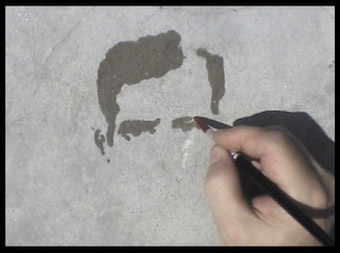
Óscar Muñoz, still from Proyecto para un memorial (Project for a Memorial) 2003-05
courtesy of the artist and Sicardi Gallery
Óscar Muñoz, still from Proyecto para un memorial (Project for a Memorial) 2003-05
HIRAKI SAWA’S SIX GOOD REASONS TO STAY AT HOME, WHICH THE NATIONAL GALLERY OF VICTORIA EXHIBITED CLOSE TO EIGHTEEN MONTHS AGO, REMAINS THE SINGLE MOST IMPRESSIVE EXHIBITION OF VIDEO WORKS I HAVE SEEN IN MELBOURNE. LIKE THE LATE JEREMY BLAKE’S DIGITAL PAINTINGS, SAWA’S DREAM-LIKE EXPLORATIONS OF THE DOMESTIC SPHERE ARE PRECISELY THE SORT OF VIDEO ART THAT IS WORTHY OF THE TITLE. LIKE AN EXCELLENT PAINTING OR PRINT, THESE VIDEOS DEMAND TO BE PROJECTED ONTO A WALL, ADMIRED FOR THE BEAUTY OF THEIR FORM AND THE INTELLIGENCE OF THEIR REALISATION. MUCH VIDEO ART, ADMIRED EITHER FOR SHOCK VALUE OR FOR OUTRIGHT UNWATCHABILITY, DEMANDS TO BE TURNED AWAY FROM.
The NGV’s current exhibition, Resonant Visions: Contemporary Video from Latin America, is less successful than some of the gallery’s previous events. As an overview with only three works, it is obviously incomplete, perhaps serving as the most threadbare of introductions.
Óscar Muñoz’s Proyecto para un memorial (Project for a Memorial), 2003-05, is the strongest of the three pieces, primarily for the manner in which it manages to operate across multiple levels of meaning. Controlled by an unseen hand, a paintbrush dipped in water dashes off a portrait on a canvas of cold, grey concrete. The face is dark and serious, its features detailed enough to be legible without our seeing into its eyes. The portrait finished, the brush moves on to another of the installation’s five screens, where it promptly begins work on another face. But as soon as it does so, the first image begins to evaporate. By the time the paintbrush has started work on its third or fifth portraits, the original face has faded to the point where only two small splashes of water remain, where the eyes used to be. It’s a bit like watching Henri-Georges Clouzot’s Le Mystère Picasso (1956) in reverse. An ostensible lament for the disappeared persons of Latin America, the work might also be seen as a profound meditation on the ephemerality— perhaps even the essential hopelessness—of art.
By contrast, Sebastian Diaz Morales’ Lucharemos hasta anular la ley (We shall fight until the law is cancelled), 2004, has only its political meaning to bet on: everything else comes second to the expression of the political sentiment. However, Diaz Morales aestheticises his source footage of political violence in Buenos Aires to such an extent that both his political and aesthetic points are unnecessarily blunted. On the one hand, the various filters and slow-motion effects applied to the video’s documentary source footage render the concrete struggles it depicts suddenly abstract and unreal. On the other hand, the knowledge that this violence is real renders the aesthetic effects merely and intrusively decorative, detracting from any affective charge they may have carried in and of themselves.
While Diaz Morale’s work highlights the problems with video art as a medium for political expression, the manner in which the three works have been forced to share the exhibition space with one another highlights the inherent problems with the art gallery as a site of exhibition.
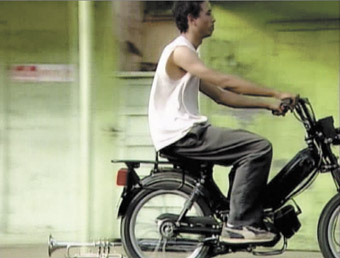
Jennifer Allora and Guillermo Calzadilla, still from Returning As Sound (2004)
courtesy of the artists and Galerie Chantal Crousel, Paris
Jennifer Allora and Guillermo Calzadilla, still from Returning As Sound (2004)
This is particularly true of the weakest of the three works, Jennifer Allora and Guillermo Calzadilla’s Returning a sound, 2004. A perfect example of how contemporary art has a tendency to rely too heavily on the discourse of the artist for its meaning, the work is a six-minute video showing a young man riding through luscious countryside on a motorcycle fixed with a trumpet for a muffler. It makes the bike sound a little like an agitated wasp.
Reading the room notes a little later, the work’s political import becomes fully apparent: the young man is in fact a symbol of civil disobedience; the luscious countryside is that of Vieques, an island off Puerto Rico used by the US Navy as a weapons-testing range from 1941 to 2003; and the trumpet is a symbol of US military might, re-appropriated by the people of the island (and, one assumes, their motorbikes). This is all very well and good, except that, on its own, the work expresses none of this and in fact comes across as little more than a novelty. Shot and cut in conventional chronological order, the video’s only formal interest is in the varying pitch of the buzzing trumpet-exhaust, though the aural possibilities of this device are not explored in any systematic manner. What’s more, the works with which Returning As Sound shares gallery space are almost completely silent, and the motorcycle’s six-minute solo permeates one’s experience of these pieces in a manner not entirely at one with their intended effects.
Indeed, one leaves the exhibition with a niggling suspicion that a gallery space was not the right place for it. A cinema might have been more appropriate. The point of difference between video art and experimental film is left looking all forlorn.
Resonant Visions: Contemporary Video from Latin America, UBS Contemporary Art Galleries, NGV International, Melbourne,
Feb 16-Aug 17
RealTime issue #85 June-July 2008 pg. 24
© Matthew Clayfield; for permission to reproduce apply to realtime@realtimearts.net
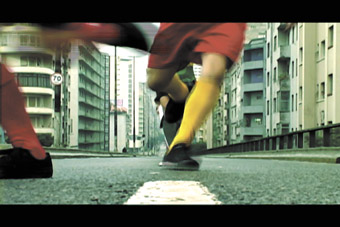
Varzea
CHOPSTICKS WITH EMBEDDED CAMERAS? OIL PRICES AS DATA SOURCE FOR ABSTRACT VISUAL GENERATION? DISPOSABLE SURVEILLANCE CAMERAS? TIMELAPSE SCREENSHOTS UPLOADED FROM YOUR RECENTLY STOLEN COMPUTER? ANIMATED TALKSHOWS SET INSIDE COMPUTER GAMES? YOUTUBE? NICHE DVD LABEL CREATION WITH A WEBSITE AND $100 BURNER? LIVE MOBILE-PHONE-VIDEO-TO-WEB-TO-MOBILE-PHONE? THE POSSIBILITIES FOR CREATING, DISTRIBUTING AND VIEWING VIDEO CONTINUE TO EXPAND, NECESSARILY MAKING IT MORE COMPLICATED TO DEFINE VIDEO ART, OR DISTINGUISH WHAT PARTS OF IT OVERLAP OR INTERSECT WITH CINEMA, TV, VJING, VIDEO BLOGS AND THE CONTINUOUS SPRAWL OF CONTEMPORARY ART-MAKING THAT CAN INCLUDE THE MOVING IMAGE. THAT BOUNDARY BLUR BETWEEN CINEMA AND VIDEO ART IS THE FOCUS OF A D/LUX/MEDIA/ARTS’ PROGRAM OF SCREENINGS, EXHIBITIONS AND FORUMS IN JUNE. ALL OF THIS IS A LONG-WINDED WAY OF SAYING, A PAIR OF PREVIEW DISCS ARRIVED IN THE MAIL TITLED VIDEOBRASIL.
In October last year Sao Paulo, a city with more breathing humans than all of Australia, hosted the 16th annual Videobrasil Video Art Festival [RT82, p26]. Its theme? Exploring the convergences of “video, cinema and the visual arts.” Downtown Sao Paulo obviously made an impression on d/Lux, as they’ve decided to import two sets of those screenings along with the director of Videobrasil, Solange Farkas. The Videobrasil website still gives off ghostly echoes of what seems like a vibrant festival (in which many Australian artists have featured over the years), a great range of forums, plenty of exhibitions, provocative international guests (eg Peter Greenaway, Kenneth Anger, Dutch curator Tom van Vliet talking about 360º projection panoramas etc) and a vast collection of video art screenings, including the following prizewinners from the Videobrasil 2008 Jury Selection:
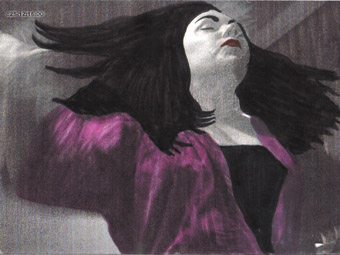
Revolving Door
Revolving Door, David and Alexandra Beesley [Australia]
Nice to see a pair of Melbourne animators collect a prize on the international stage, and quite deservingly too, for their painstakingly animated (14,000 frames of rotoscoping anyone?) and well nuanced documentary about prostitution in St Kilda. Amazingly, they started working on the documentary in 1989, albeit in a more conventional video documentary style, so the recent spate of awards must be gratifying. The animation technique employed perhaps facilitates easier empathy with the various characters, and the well structured script ensures the social impacts of prostitution are provocatively presented. More at the companion website: www.beeworld.net.au/rdoor.
Rawane’s Song, Mounira Al Solh [Lebanon/The Netherlands]
“I got jealous of those artists who were able to do an artwork related to identity matters and I was particularly pissed off by the ones who came from a war background and knew how to talk about it”, Mounira reveals via on-screen text before juxtaposing her own handicam footage of her bright red shoes walking around her studio. This is interpolated with more text of her personal history and art projects, and her attempts to reconcile the differences between personal and national identity. Cute video, from the three chords and a guitar school, getting its wings from the more insightful text commentary.
Juksa, Mauricia Dias & Walter Reidweg [Brazil/Switzerland]
Because of the screening context, or because video art might have an emphasis on ideas and provocations or on exploration of form, we accept or even expect lower production values than we might within cinema. On the other hand, while Dias and Reidweg’s premise had merit, revisiting characters in a remote Norwegian village who had been interviewed on video 30 years before, a combination of bad editing, badly overexposed footage, badly fitting motion graphics and a pretentious scene of an opera singer framing the film on the beach, killed for me material that deserved better.
Varzea, Estudio Bijari & Ricardo Lazzetta [Brazil]
With South American vigour, a sports commentator as narrator asks us, “Victory against who? Will nostalgia be able to remind us of our life’s finitude?” and continues a blistering pace, while aerial shots display incredible urban density, then ground shots reveal characters in a range of colourful soccer jerseys running through the concrete spaghetti highways below. Abruptly the commentary stops and, against melancholic violin, each of the runners slides about on a muddy, grassless soccer field (Varzea=’muck’), in smooth slow motion cinematic style.
half-time, change sides
Brazil has won the soccer World Cup more times than any other country, but how would they fare in a World Cup of video-art-meets-cinema compilations based on this selection? In trying to gauge the merits of Videobrasil, you necessarily run up against comparisons with large traditional film festival compilations (which offer higher production values), or digital media festivals such as onedotzero, Resfest (both offering much higher technical innovation). Inevitably, you are judged against abundant web video channels and, inevitably, short films recently popularised online and as provocative as anything on this compilation (eg from neighbouring Argentina’s blublu.org). It’s partly that context question though. Some of these works would seem better in an installation, where higher cinematic expectations mightn’t be placed on them. Hey Brazil, you can’t win them all. But eat your oranges up and see what you can do in the second half—the Videobrasil 2008/2009 Residency Program which offers support to selected artists who have competed in the festival competition screenings.
Canto Doce Pepequeno Labirinto, Caetano Dias [Brazil]
No idea why this is international festival prizewinning video art. It seems worthwhile enough, building a large edible sugar sculpture in a public place, a railway station, but is a very basic video documentation of a small public art project.
Canto de Aves Pampeanas 1, Nicolás Testoni [Argentina]
File under ‘better off as an installation’, a series of fixed camera long shots of landscapes; industry as always encroaching on the traditional terrain; not particularly enthralling shots.
Untitled (Zimbabean Queen of Rave), Dan Halter [Zimbabwe/South Africa]
A cheesy diva rave anthem (everybody’s freeeeee, feels good…) serves as a backdrop to show white crowds dancing at raves juxtaposed with black crowds on the streets demonstrating. Anything that can illuminate disparity seems useful, but there’s not much going on here.
Abismo Virtual, Eustáquio Neves [Brazil]
Grainy mobile phone video in which a scattering of illustrations and text explore the strange, disembodied communications we have available today, connected and disconnected.
Weekend, Federico Lamas [Argentina]
Innovative on a number of levels, this video uses a series of voice bubble post-it notes to provide English subtitles for some domestic scenes played out in vertical strips, each sliding the previous scene further to the left of the screen. There it continues to play out, eventually providing around four or five overlapping slices of time simultaneously, complete with previous post-it note dialogue intact. The sense of playfulness continues over time, adding variations to its novel multi-layered looping universe.
Videobrasil 2008-09 tour, d/Lux/Media/Arts; for program and dates go to www.dlux.org.au/artcinema.
RealTime issue #85 June-July 2008 pg. 25
© Jean Poole; for permission to reproduce apply to realtime@realtimearts.net
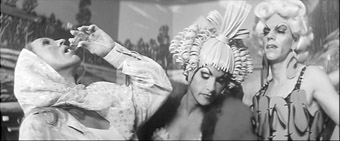
The Adventures of Priscilla Queen of the Desert
Stills courtesy Latent Image/Specific Films
The Adventures of Priscilla Queen of the Desert
I WATCHED THE ADVENTURES OF PRISCILLA QUEEN OF THE DESERT ONLY RECENTLY, SURPRISED TO FIND THAT FOR ALL ITS POPULAR SUCCESS, IT’S A CURIOUSLY TENSE, BICKERING, OFTEN GRIM FABLE OF IRRESOLUTE AUSTRALIAN MANHOOD—WHETHER STRAIGHT, TRANSVESTITE OR TRANSSEXUAL. IT ALSO TREATS ITS WOMEN VERY BADLY. IN AN EARLY EDITION OF REALTIME (RT 4, P4), IN A THREE-WAY DIALOGUE, JACQUIE LO, MERLINDA BOBIS AND HELEN GILBERT TARGETED THE FILM’S APPALLING ACCOUNT OF A VERBALLY AGGRESSIVE FILIPINO WOMAN, ISOLATED IN THE OUTBACK, ENTERTAINING THE PUB LOCALS BY SHOOTING PING PONG BALLS OUT OF HER VAGINA AND UPSTAGING PRISCILLA’S TRANSVESTITE SHOWGIRL TRIO. PHILIP BROPHY ADDRESSES THIS MOMENT AND MANY MORE IN A WICKEDLY ENGAGING NON-LINEAR ANALYSIS OF THE FILM THAT PULSES WITH ODD JUXTAPOSITIONS AND UNEXPECTED ASSOCIATIONS CONNECTING UP DISPARATE ELEMENTS INTO A ‘MAP’ OF THE FILM AND THE CULTURE IT CONJURES AND FROM WHICH IT HAS GROWN.
Roland Barthes wrote somewhere that denotation is the last of the connotations—we come at meaning not directly but through a host of associations. Philip Brophy is a whizz at the art of the semiotic reading of a cultural object, attentive to every aspect of its surface (its “tonality; the weight and porosity of its audiovisual texture”), its edges and layers (its “semiotic verticality and iconic stratification”) and, above all, a network of associations branching out into the greater cultural tanglewood. His is a poetic and highly rhetorical approach, relying often on the power of suggestiveness and he’s a dab hand at sly allusion and irony. Not every assertion convinces, especially when Brophy’s at his most polemic in this brisk 82 page read; dismissiveness comes too easily and some will read it as a clever dick assault on a sacred cultural object, and Australian film with it.
Writing about Priscilla provides Brophy with the opportunity to challenge the “dumb semiotics” of Australian culture and film in particular where the “pre-labelled and self-proclaimed…enforce cultural associations, rather than nurture discovery or allow repulsion.” Familiar tropes and icons are clung to in the name of uniqueness. But they are not meaningful for Brophy: “to me, Priscilla, is as alien as the landscape that greeted the first convicts, prospectors and settlers.” His map of the film, he declares, will be “less an analysis of the film’s dramatic script and its visual narrative, and more an assessment of the signs circulating within the movie.” And he knows he’ll be seen as getting it wrong: “This reading…is irrefutably un-Australian”, but not, he emphasises, Aussie-bashing, though some readers might regard that as spin: “[My] reading celebrates the great nothingness of white Australia and all the heady delusions and spindly neuroses which atmospherically circulate around its engorged mass.”
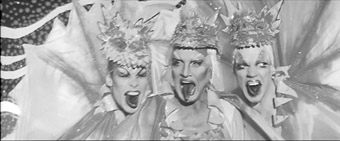
The Adventures of Priscilla Queen of the Desert
Stills courtesy Latent Image/Specific Films
The Adventures of Priscilla Queen of the Desert
In a culture in which so little film analysis is characterful, let alone brave enough to locate film in the big cultural picture, Brophy is very much a felt presence in his little book. He announces up front that “in the spirit of Genet’s self-degrading recoding of the obvious my reading ‘drags’ Priscilla’s appropriation of drag…” He imagines a Genet “time-warped and sent to a penal colony in Australia then jettisoned to a far future on the eve of Priscilla’s lauding at the 1994 Cannes Film Festival…he may have written a book like this one…” For Brophy, ever the outlaw, imprisoned in Australian culture but always breaking out, this is no occasion for cringing humility. The writing is rich in image and metaphor, often pushing into excess to make its mark, but replete with all kinds of drollery in the tradition of the queer outsider—from Oscar Wilde to Quentin Crisp and on to Sandra Bernhard. The smart arse quips—like Roland Barthes as jokester—situates the writer in the history of queer wit rather than with Genet, but the point is taken. As well as unravelling the tangle of visual and aural associations in the film, we need to step right back from the screen to see what’s really going on.
Like his role models Brophy is constantly quotable—“the reminder of the penis is the eternal lump in the throat of the drag body”; Isadora Duncan’s scarf “brand[s] her body as a machine for movement.” There are similes and metaphors that do the job (I’ve cited some of the best and wildest below), and some that don’t: “In a prolixed manner, I am reading Priscilla here as a layer of skin covering the cartilage of the Snowy Mountain Hydro-electric Scheme’s historical formation and logistical machination.” There are moments of wonderful excess like this on the joys of sinking the piss: “Harvested like a primary crop, processed like a pandemic yeast infection, distilled into a simulated urinary liquid, prone to foaming into frothy ejaculate, the sexual aura of beer can only be avoided when one is too drunk to fuck…Its gluttonous intake gears the body into a living pissoir…one might as well piss beer while drinking urine.” There are sentences containing barely submerged song titles and passages where the semiotician lingo fogs meaning. Mostly, the book is a wonderfully grumpy entertainment that makes you think more than twice about the film and the culture of which it is a part.
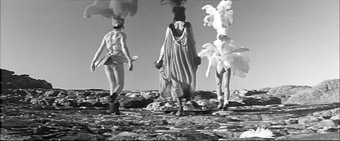
The Adventures of Priscilla Queen of the Desert
Stills courtesy Latent Image/Specific Films
The Adventures of Priscilla Queen of the Desert
Brophy doesn’t read Priscilla for us linearly; he identifies key signs and then joins the dots to cultural associations that might not have occurred to us, mapping signs into a comprehensible guide to the film’s dynamics. The map’s mostly legible and rich in sidetracks and diversions that mostly take you back to the main road. Occasionally you feel you’ve run into a dead end or fallen off the map, trying to hang onto the fit of, say, the pheromonal meaning of women’s scarves. Brophy otherwise puts the scarf to good use, getting Isadora Duncan and her strangulation into the act in his cumulative account of the film’s persistent silencing of women. Its relationship to larger sign posts points to the significance of breath and the trace of the voice. It all happens very fast, and a re-reading helps make better sense.
Above all Brophy is attentive to the sound of film (in his own films and performance, in his Cinesonic column for RealTime in the 1990s, his international conferences with the same title, and his British Film Institute book, 100 Modern Soundtracks). It’s not surprising that breath, voice, accent, popular song, opera and the didjeridu figure potently in his response to Priscilla, looping into a disturbing totality. He starts out with Shirl, a woman, alone amongst a bunch of tough but reticent blokes in an outback pub, who verbally attacks the transvestite trio:
Shirl’s open mouth is the black hole of the white void at the red centre of Australia. Her oral gape is the glassy eye of the film’s sociological hurricane: a raging whorl of misogynist energy that spins around this charade of a butch dyke…Shirl is like all nagging wives: a bitch to be shut up. And to be shut up by a British trans-sexual [Terence Stamp as Bernadette]—now that’s Australian comedy.
Brophy’s writing here, as elsewhere, is itself “a raging whorl”, sucking a host of associations into its vortex and swirling towards its destructive, knockout punch line. Then the storm starts up again slowly building to a series of coups de grâce, via discussion of the inflatable doll atop the bus, the opera soprano and the film’s breathing (the central characters “develop less through a series of trials and tribulations and more through an arrhythmic concatenation of inflated and deflated moments”). He writes, “all [the women] are defined by the means by which air fills their being. The doll is blown up, the drag queen is puffed out, and the female corpse is pumped within.” The film’s use of the opera aria allows Brophy to drive home the governing “necrotic” (his compounding of necrophilic and erotic) dimension of Priscilla while giving him room to comment on opera as drag. He sees opera “as a form of drag in the first place—a woman performing a man’s creation…Controlled by the Promethean impulse of the composer she bears his breath.” The result, Brophy thinks, is “the anodyne resonance of pure tone”, at a remove from real emotion and deadly: “For when Verdi’s aria is smelted from the hovering inflatable sex doll, death is in the air.”
It’s a short trip from opera to musical, since in Priscilla there are ‘live’ songs as well as mime. Again Brophy joins the dots between breath, voice, drag and death: “Ultimately, all Musicals are drag revues” because they use lip-synching, just as in drag mime “which creates the ghostly aura of a human presence.” Shortly, in the same terms, he addresses the drag queen’s narcissistic appropriation of the torch singer. The argument is dark and arresting but just when you suspect you’ve been lead into some semiotic back block, Brophy guides you back to the film’s central trio—and their voices.
By now, Brophy has detected that for all the film’s inflation (its uplifting horizons and aerial views) there is a prevalent depressive and necrotic deflation. On the matter of voice, he observes of the trio that “they flip between displays of tartiness and blokiness, the former with physiological ineptitude and the latter with theatrical inexactitude.” He connects the limited binary being of these men with John Mellion’s VB beer television advertisements, tourist industry images of Australia (and of much Australian film) and a persistent national ailment: “contrary to its gay portraiture, Priscilla captures the sexual confusion that foams around the churning waters of gender divisions which so desperately chart Australia’s ongoing frontier roughness and the brute ways in which male and female are cleaved from the other.” Never mind the clunky metaphor mix, Brophy’s point is clear—while the film might throw up a mass of complex associations, it’s still represents a “dumb semiotics”, un-nuanced, un-gay and deeply prejudiced.
Priscilla, like many an Australian film for Brophy, has ignored alternative voices, appropriated and transformed them into standardised Australian signs, sucking the breath out of difference. But gay culture itself is also problematic: “Post-70s, gay culture’s officiated alignment with notions of ‘pride’ and ‘community’ effectively closed off the perversity of a pre-gay epoch. In the process it partially normalised the aberrant power born—no matter how problematically—from exploring identity potentiality beyond the barriers set by heterosexual identity.” This culture is now progressively de-queering a unique heritage: “Far from being oppressed, hamstrung or constricted, sexual identity in early to mid-20th century gay subculture was utilised as a proto-totemic signifier ripe for subversion, inversion and conversion.”
Up to now Brophy has written little if anything about Australian film composition and sound design. Now with apt perversity, he’s taken on a film he dislikes in itself and for what it represents about Australian film and culture and does it bizarrely great service, if nonetheless condemning it for the crude binarism of its dumb semiotics. He has discovered that “[t]he film is a labyrinthine text, honeycombed with signifying pathways fragmented by multiple modes of performance and characterisation…” He is taken with Priscilla’s music: “I find that the innate novelty, studio trickery, sonic complexion and lurid narratives of nearly all the 70s songs dragged in and throughout Priscilla create a lasting aural depth within the film’s audiovisual assemblage…as if the cinematic veneer of its construction cannot contain the energy of the songs and their original performance.” In the end Brophy wonders, “maybe the phenomenon of Priscilla has little to do with cinema.” Its appeal resides everywhere else in the cultural map of which it’s part but not in the film itself.
For Brophy, The Adventures of Priscilla Queen of the Desert turns out to be a treasure trove of songs and other cultural signage—the good, the bad and mostly the ugly. The bottled turd of Agnetha (of ABBA fame) epitomises gay and straight male misogyny, the treatment of the Filipino, Cynthia, is “one big gang bang”, the attitude to Aboriginal people is assimilationist and the musical finale with the trio dressed as Australian native fauna is a performance which “remains nothing but inhuman, as they shift representation of Woman to a series of animalistic, reptilian and monsterised figures.”
But the film has worth, it seems, if only as a mirror image of our culture—one which has to be read with the Brophy map in hand: “Priscilla’s straight eye on a queer world grants us the most potent symbolic condensation of this uniquely Australian self-distorted portraiture…this dark jewel of popular culture is a mystical stone which especially grants male Australia the power to see itself for what it really is.”
Brophy’s book is a challenging read, in the best sense, and good fun, witty and instructively gross by turns. My major reservation is that the only other Australian feature film mentioned (also disparagingly) is Muriel’s Wedding and there’s a passing reference to several outsider films: Wake in Fright, The Coca Cola Kid and Where The Green Ants Dream. Brophy’s blanket reading of all Australian feature film as locked into the nationalist syndrome is wearyingly absolutist for a writer who otherwise reads film and the world complexly, but don’t let this deter you from a scintillatingly good read.
Jane Mills, the series editor of Australian Film Classics, made one of her best choices in assigning The Adventures of Priscilla Queen of the Desert to Philip Brophy. As with most of the series to date she has wisely avoided predictable choices, reaching beyond the industry itself, the academy and reviewers. I’m looking forward to the latest instalment, Henry Reynolds on Fred Schepisi’s The Chant of Jimmie Blacksmith.
Philip Brophy, The Adventures of Priscilla Queen of the Desert, Australian Screen Classics, series editor Jane Mills, Currency Press, Australian Film Commission, Sydney, 2008
RealTime issue #85 June-July 2008 pg. 26
© Keith Gallasch; for permission to reproduce apply to realtime@realtimearts.net
NOT ONLY DOES THE SUBJECT MATTER OF ROLF DE HEER’S FILMS VARY WIDELY, THEIR SOUNDTRACKS ARE ALSO ALWAYS DIFFERENT AND UNEXPECTED, AND ARE AT TIMES RAISED TO A LEVEL OF DOMINANCE AMONGST THE NUMEROUS INTERACTIONS INFORMING THE NARRATIVE. MUSIC SCHOLAR CAT HOPE COMMENTS: “EACH OF DE HEER’S FILMS MERITS A DETAILED TREATISE ON THE WAY THEY FEATURE INNOVATIVE SOUND IDEAS IN THE SCRIPTING AND PRODUCTION STAGES, RESULTING IN SOME OF THE MOST CHALLENGING AND EXCITING CINEMA MADE IN AUSTRALIA TODAY” (WWW.SENSESOFCINEMA.COM). THIS AUTEUR’S ATTENTION TO THE AURAL IS PERHAPS EXEMPLIFIED BY HIS LONG TERM COLLABORATION WITH COMPOSER GRAHAM TARDIF, WHOM I INTERVIEWED IN MAY OF THIS YEAR. TARDIF HAS CREATED THE MUSIC FOR 10 OF DE HEER’S 12 FEATURE FILMS, THE EXCEPTIONS BEING A CONCESSION TO THE JAZZ ARTISTRY OF THE LEGENDARY MILES DAVIS AND MICHEL LEGRAND IN DINGO (1991) AND THE INDIGENOUS AUSTRALIAN PERFORMERS OF THEIR OWN MUSIC IN TEN CANOES (2006).
Since meeting de Heer when the budding writer/director/producer was still at the Australian Film, Television and Radio School, and composing the music for his diploma short, The Audition, Tardif’s subsequent career highs include The Tracker (2002) which he says “was built around the idea of these paintings [by Peter Coad] and these ten or eleven songs going through the film. To a large extent, the music informs [de Heer’s] thinking.” Certainly, de Heer is a director attuned to sound designer Randy Thom’s demand that directors should be “Designing a movie for sound” (www.filmsound.org), not simply leaving it to the end in the hope it may be somehow improved by the hasty addition of some great music.
Tardif explains how early he is usually involved by de Heer in the process: “We’d have a lot of discussions and we’d sit down and talk about what it should be like and we’d plot the film out together and then I’d come up with the music based on that discussion […] but I’d actually start serious thinking when there’s a finished script.” I asked Tardif how he communicates melodic ideas to someone without musical training: “We speak in terms of the feeling of the scene or the underlying emotion that he’s trying to convey rather than discussing diminished sevenths or anything like that. We can talk musical styles, I mean he’s not musically illiterate to the extent that we can’t talk about whether it would be a western style or a percussive, or, you know, he’ll understand that, or whether it’s classical or orchestral or rock.” Thus, Tardif and de Heer decided early in pre-production for The Tracker that they wanted the feel of a live band fronted by an Indigenous male singer. The result was Archie Roach later performing the songs—which de Heer had penned and Tardif had composed—live at a screening of the film in the Melbourne Concert Hall. Awards were received for best score from the Film Critics Circle and the IF Awards. The songs serve as an extra character, expressing the sorrow of a subjugated people, and Tardif’s music positively charges the text of the screen’s image.
But Tardif’s scores are not guilty of simply retelling the story or redundantly repeating what the dialogue or visuals have already made clear. He illustrates his occasional intention to juxtapose conflicting emotions by referring to a scene in The Old Man Who Read Love Stories (2000), a film characterised by a lush, epic score performed by the Adelaide Symphony Orchestra and a 40-voice choir: “Where they were rowing back across the river after the leopard had been killed, now that was something where I think I used music against what was going on in the action to give a lot more depth to the scene, rather than just replicate what’s going on in the action, to juxtapose the visuals which were quite fast paced, but the music was quite slow and glorious in a way. Rather than give a sense of the pace of the boats and the rowing it was more a sense of what the homecoming actually meant: it was an achievement and a victory but at the same time, because the death of the leopard was not something the old man had wanted to happen, it was a tragedy as well.”
Alexandra’s Project (2003) had an entirely different kind of score. Within a minimalist, synthesised soundscape, the non-diegetic music evokes a sense of tense foreboding that maps the deterioration of suburban family life. Tardif identifies this as one of his favourite works because “unlike other films in which I had multiple tones and dynamics and instruments to work with, I wanted to push the tension with the minimum tonal range that would actually work with the minimum palette possible, so it was probably my most experimental film.” With such a spare, unobtrusive, electronic score, ambient sounds like the turn of a key in a deadlock take on an almost menacing aspect and the hyper-reality of these sounds, amidst the relative silence, informs the audience that Steve, the beleaguered husband, is very isolated and disconnected from any outside help. The sound scenarios in Alexandra’s Project transcend the traditional role of the soundtrack of merely supporting the onscreen image. The auditory elements of the film’s metallic timbre highlight not just Steve’s mental terror but also further the depiction of the suburban brick veneer house as family prison. The integration of all the aural ingredients communicates these ideas effectively, and rather than following the eye, they lead it.
In 2007, de Heer returned to Tardif to compose for his slapstick silent comedy, Dr. Plonk, which Tardif identifies as another film score he is proud of “because it was 90 minutes of wall-to-wall music.” Performed by Melbourne band The Stiletto Sisters, the combination of violin, piano accordion, double bass and piano is beautifully lively, and one senses this black and white homage to Buster Keaton and Charlie Chaplin would not have worked as well with de Heer’s original idea of accompaniment by a single Wurlitzer organ, regardless of any period authenticity it may have lent. But Tardif acknowledges the expense involved in composing and recording original music for films rather than pre-recorded songs, “Whenever you go into a studio you have to be really prepared because of the cost of time—$50,000 a day for the Adelaide Symphony Orchestra. If you’re not ‘there’ when you go into the studio you’re just spending studio time rewriting and that’s really counterproductive. With The Stiletto Sisters I worked with them for a week after the score had been written…we got the score right and then went into the studio for three days to do the recording.”
De Heer’s reliance on original music is in stark contrast to the Australian film industry’s tendencies, as identified by Rebecca Coyle: “In the period from the so-called renaissance of Australian film that occurred in the 1970s, there have been two identifiable ‘eras’ in film music. In the first period, orchestral arrangements were frequently used [… as opposed to] the subsequent era, when Australian film followed an international tendency to include popular music in soundtracks” (“Introduction: Tuning up”, Screen Scores, AFTRS, Sydney, 1997). But de Heer’s bucking of the trend is not surprising, for as Tardif puts it: “With his combination of the sound and the music, he is an aural auteur.”
RealTime issue #85 June-July 2008 pg. 27
© bruno starrs; for permission to reproduce apply to realtime@realtimearts.net
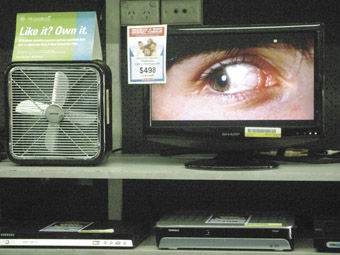
Big Square Eye, Brisbane
IN A MAJOR MEDIA ARTS VENTURE, THE 2008 BRISBANE FESTIVAL HAS COMMISSIONED BIG SQUARE EYE WHICH WILL DEVELOP AND THEN TRANSMIT THE WORK OF 15 YOUNG SCREEN ARTISTS ACROSS QUEENSLAND, MAKING THE MOST OF THE BROADCAST POTENTIAL OF NEW MEDIA TECHNOLGIES.
The young artists from urban and regional Queensland have been selected from 140 to collaborate with five mentoring media artists (Kate Geck, Andrew Gibbs, Ross Manning, Archie Moore and Alan Nguyen) on works for Big Square Eye.
The venture has been initiated by concept designer Vivian Hogg. Big Square Eye has included workshops, technical support and industry networking opportunities with an eye to not only each artist creating a work but generating careers.
Big Square Eye will appear as a multi-screen work at the QUT Creative Industries Precinct, in 16 RetraVision stores around the state and will be streamed online.
Big Square Eye, Brisbane multi-screen showings at The Block, Creative Industries Precinct, Queensland University of Technology, Kelvin Grove campus, July 19-Aug 3; www.brisbanefestival.com.au
RealTime issue #85 June-July 2008 pg. 27
© RealTime ; for permission to reproduce apply to realtime@realtimearts.net
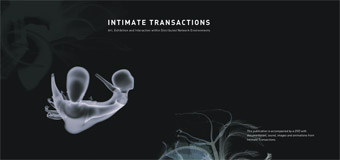
Intimate Transactions book cover by Stuart Lawson
YOU MAY HAVE READ ABOUT THE INTERACTIVE MULTIMEDIA PROJECT INTIMATE TRANSACTIONS IN THE PAGES OF REAL TIME [RT59, P20; RT67, P26]. SOME OF YOU MAY ALSO HAVE HAD THE OPPORTUNITY TO EXPERIENCE IT, RUBBING SHOULDERS AND EXCHANGING MUSCLE TONE WITH SOMEONE SIMULTANEOUSLY LOCATED IN A TOTALLY DIFFERENT GEOGRAPHICAL SPACE. NOW A NEW BOOK AND ACCOMPANYING DVD PROVIDES THE OPPORTUNITY TO RE-IMAGINE THE WORK.
Intimate Transactions is a collaborative project led by new media artist Keith Armstrong in collaboration with choreographer Lisa O’Neill and sound artist Guy Webster. Initially developed out of the Australian Creative Industries Network at Queensland University of Technology (QUT), this project has mutated and spread beyond its homeground, picking up researchers and partners across Australia. Pia Ednie-Brown and Inger Mewburn from the Spatial information Architecture Laboratory at RMIT brought their research interests in haptic technology to the project, while the collaboration with ACMI (Australian Centre for the Moving Image) in Melbourne enabled the group to test out the ability of the distributed technology to work at vast distances.
Intimate Transactions: Art, Exhibition and Interaction with Distributed Network Environment is a handsomely presented and richly illustrated volume which on first glance looks like a typical exhibition catalogue or even coffee table book. However, check the contents pages and a different picture emerges. With its research questions, essays by the key collaborators, interviews, its talk of prototypes and pilot studies and analytical texts from a diverse range of interlocutors, Intimate Transactions takes on the form of a hybrid text, somewhere between research, philosophy and documentation.
Edited by QUT academic, Jillian Hamilton, the publication positions the project not merely as an ‘art’ experience, but as a research project that has broad ranging implications for how we conceive and design our world in the 21st century. In particular the project questions our experience of the world through a reconfiguration of understandings of space and touch. It examines how this translates into what has come to be known as “experience design.” For example, Hamilton writes about how the rapid expansion of global networks has led to a compression of space that reignites conversations about ‘flat space’; Keith Armstrong articulates the ecosophical understanding that emerges in and through engagement with the work; while Ednie-Brown and Mewburn emphasise the project’s capacity to introduce a sense of embodiment through haptic feedback devices.
In her introduction to Intimate Transactions, Hamilton asks whether it is possible to create a sense of embodied communication or an intimate transaction between people who are separated by vast distances but joined by interfaces and distributed networks. I must confess that my own induction into the world of Intimate Transactions was anything but intimate. I was one of the pilot audience who ‘tested’ the first long-distance dual-site installation of the work between The Block in Brisbane and ACMI in Melbourne in 2005. Rather than establishing an intimate connection with another body, I recall that I felt very much like a subject in a scientific experiment and my rather clumsy engagement with the technology made me more aware of my inadequacies in the face of something unfamiliar. I became so lost in my own bodily struggles to negotiate a visual scenario that operated according to a logic (gaming logic) I was unfamiliar with, that I was only ever minimally aware of the ‘touch’ of my fellow traveller.
Johannes Birringer’s recollections of Intimate Transactions in his essay, “Transactivity”, paints a more nuanced response to the experience of the body shelf and interface design. He recognises that while the “erotics of transactivity may lie entirely in the realm of fantasy”, the work’s challenging synaesthetic qualities call into question conventional analytical ways of interpreting which privilege the linguistic over the corporeal. He suggests that the work calls for phenomenological investigations into the sensing body so that we can more fully understand the complex transactive media environments that increasingly form our world experience. For Birringer, as for many of the other writers, the critical element in Intimate Transactions is its capacity to raise questions to do with the ways we think about and intervene in the world through our (design) practices.
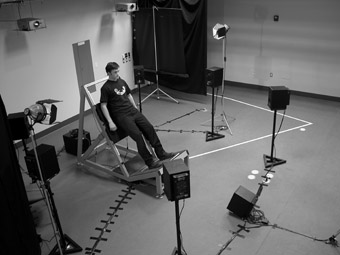
Intimate Transactions
photo Keith Armstrong
Intimate Transactions
The essays and interviews in the book play out this complex interaction between thought and action as it has occurred in the realisation of Intimate Transactions. In addition to addressing the pragmatics of the project—how for example it drew together the unique skills of individual artists and designers (new media artist, choreographer, furniture designer and artist, sound artist, programmer and architect designers) to create an interdisplinary collaboration—the book provides insights from other participants who have in some way been ‘touched’ by the project—technical staff and curators who worked with the creators to exhibit the work as well as those who experienced it in development. While there was a danger that a homogenous viewpoint might emerge, Hamilton has been careful to create a multi-faceted and richly layered conversation that draws out the diversity and inconsistency that has arisen through Intimate Transactions.
Intimate Transactions has been awarded a Visions of Australia Touring grant (2008-09) and will represent Australia in Beijing during the 2008 Olympics as part of China International New Media Arts 2008 at the National Art Museum of China; www.mediartchina.org;
www.maap.org.au;
transmute collective: www.embodiedmedia.com
Jillian Hamilton ed, Intimate Transactions: Art, Exhibition and Interaction with Distributed Network Environment, ACID—Australasian CRC for Interaction Design, 2007
RealTime issue #85 June-July 2008 pg. 28
© Barbara Bolt; for permission to reproduce apply to realtime@realtimearts.net
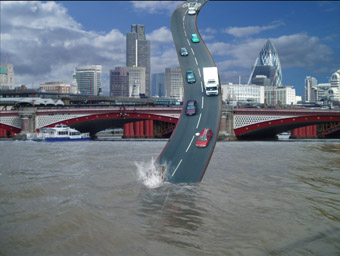
onedotzero, Graphic Cities
SOME FASCINATING QUESTIONS ABOUT ‘THE CITY’ AND ‘TECHNOLOGY’ WERE RAISED BY THE SOUND POLAROIDS RE-IMAGINING THE CITY FESTIVAL AT THE POWERHOUSE IN MARCH—THOUGH MAYBE NOT EXACTLY THE ONES EXPECTED AT THE OUTSET.
Sound Polaroids explored ‘performance, design, sound and vision’ in six sessions including screenings, live audiovisuals and a panel discussion. Screenings included a compilation of moving image work curated by the British hybrid media organisation onedotzero, which depicted a series of metropolitan landscapes, and AirplayUK, a collection of hot music videos produced in Britain. The live performance, titled Surface, was presented by a London-based creative unit, D-FUSE, who worked with artists in other cities to produce this ongoing, collaborative audiovisual work. In Brisbane they presented a compilation of their impressions of cities, including Melbourne, Kuala Lumpur, Seoul and Bangkok. After shooting high definition digital video and recording location sound, the group processes these impressions of the city’s sounds, textures, forms and rhythms in a live multi-screen audiovisual presentation.
It’s the conception of the work that raises some of the most interesting—and problematic—questions about this event. There is something a little eyebrow-raising in the idea of intrepid British explorers, armed with the latest high-end gadgets, venturing into the cities of the global South to capture and record their impressions—for the entertainment of those citizens later in the week. Of course, the fact that they work with local artists offsets this concern considerably, but nonetheless, I couldn’t help being struck by the sense of some kind of neo-imperialism going on, girded with the latest in panoptical sound and imaging technologies and delivered to expectant subjects in the ‘emerging’ world. This is maybe not fair to D-FUSE, who in Brisbane were probably exhausted after a hectic touring schedule, and whose genuine interest in positive social change—evident in other works—is undoubted.
I loved their earlier exploration, Small Global (not part of the Brisbane Re-Imagining the City), a multichannel video/motion graphics installation which collocates various texts and images of the planet to highlight normally overlooked relationships of exploitation. D-FUSE’s commentary, in this work on the bloodstained Congolese mining origins of coltan, the metal used in mobile phone chips, yielded highly intelligent, considered and imaginative insights. This nuanced commentary on ‘technology’ and ‘place’ was missing from the Brisbane performance presented by the group. As the title Surface warned, what audiences experienced was a surface-deep investigation of the more evident highlights and byways of bustling, growing cities in our region.
The use of pre-prepared files means that the performance in this case is of the customary laptop spectacle of the sound art world: earnest young men with blue-lit faces absorbed in the serious business of real-time file manipulation. In this kind of essentially VJing work there seems to be little of the urgency, emotion, hesitancy, rawness or self-revelation so critical to performance. Even artists working in the most technologised forms (like Robin Fox with his lasers) still manage to infuse their works, through the human-machine interface, with something of their persona. Though many of the individual video segments in Surface are doubtless extremely beautiful and their soundscapes inoffensively evocative, the sense of the person behind those images, or the people in the images, is somehow evacuated by the superabundant technological perfection. A colleague who witnessed the Melbourne performance thought the aesthetics were eerily like those of contemporary credit card advertisements, and an architect friend at the Brisbane performance thought there was something “big budget and really televisually familiar…like a segment from an ad for a new luxury car or Finnish mobile phone”, which for her, defused the performance’s radical or innovative possibilities, turning “the whole thing [into] a kind of superficial, high-tech love letter to traffic, highways, turnpikes, roundabouts and speed.”
In contrast to D-FUSE’s “aesthetics of overresourcing” (to cite animation theorist Esther Leslie), Amos Poe’s Empire II (2007), a video screened as part of Sound Polaroids, was a strictly low-end, consumer-level affair. At three hours long and ‘about’ the Empire State Building, there are no prizes for guessing which key film of avant-garde history it’s in conversation with. However, although it shares Warhol’s extreme durational approach (many think of the 1964 Empire as ‘an expanded cinema film’) and profilmic subject, Empire II is a much more constructed film, closer to the great city symphonies like Francis Thompson’s NY, NY (1957) and, particularly, the fractured cubist re-imaginings of Manhatta (Paul Strand & Charles Sheeler, 1921). Poe’s densely-layered, vibrantly coloured edit departs from Warhol’s static, black and white, silent minimalism with a dazzling, if chaotic, sound mix in which one can hear—and practically feel—all the jumbling voices, musics and poetics of contemporary New York City. The essence is the same: the use of a long duration (even if it is a year resolved into three hours, the screening time is still beyond the norm for most viewers) to query the psychogeographic relations of the impressive monument to its very human surrounds. The result is a surprisingly affectionate paean to this iconic building through the accretion of various layers and tiny details. In a work that gave you ample opportunity to appreciate nuances in time within a space, it was hard not to fall in love with the way it depicted the subtleties of shifting seasons, from the differing hues of afternoon sunlight glinting off the building’s windows to the various seasonal blooms gracing windowsills.
The central question, ‘how should we think about a city?’, occupied the discussion session held on the Saturday after Poe’s film, and it is clear from the lively response that the topic is one Brisbane audiences hold dear. Architecture’s highly informed and aesthetically attuned community turned out in force, with several well-known architects making intelligent contributions to a debate in which, in Brisbane at least, their voices have clearly not been adequately heard. Fired up with what many felt was the lionisation of progress at all costs, without examination of the consequences of the development boom, the debate became thrillingly heated. UQ architecture associate professor Peter Skinner helped bring the conversation about art and technocracy into the particular and the local by leading a fiery discussion on the ill-fated North Bank development. In March it consisted of a proposal for enormous concrete platforms jutting out over the Brisbane river (that proposal was scrapped in April after an extensive critical mauling). The critics’ slogan,“It’s a river, stupid”, was extended to “It’s a city, stupid”, when thinking about how careful attention needs to be paid to the integrity of the space, its masses and volumes, histories, spirits, feelings and aesthetics. In other words, what is specifically local within the global that makes each city a one-of-a-kind ‘thing-place’? For an event that was centrally concerned with the project of re-imagining the city, this session in particular brought home the most important aspect of looking at the city—that it is an organism in and of itself, mutually authored every day by its inhabitants, to whose voices and visions we need to look if we really are interested in the genius loci.
Sound Polaroids Festival, presented by Brisbane Powerhouse, Room 40 and The British Council; Brisbane Powerhouse, New Farm, March 28-29
RealTime issue #85 June-July 2008 pg. 29
© Danni Zuvela; for permission to reproduce apply to realtime@realtimearts.net
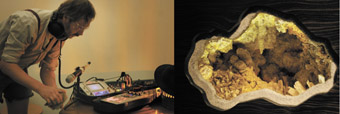
Chris Henschke & Donna Kendrigan, Rocks
courtesy the artists
Chris Henschke & Donna Kendrigan, Rocks
Themes of sound, space, art and science coalesced in discrete instances at two Melbourne art spaces. A performance by Chris Henschke to coincide with the closing of his and Donna Kendrigan’s collaborative exhibition, Rocks, continued earlier explorations of hybrid media, universal creative connectivity and the juncture between arts and sciences. Similar notions were explored in a sound sculptural installation by artist collective Plump, successfully drawing together art and physics in a manner that was cohesive and satisfying for both the artistically and scientifically inclined.
Amongst an assortment of geological sculptural forms at The Narrows, Henschke (who recently undertook a residency at the Australian Synchrotron particle accelerator) developed a dense soundscape with natural objects and live processing. Armed with a microphone, sound processing hardware, safety goggles and a few handfuls of dusty rocks, Henschke began his performance with sparse scrapings and the knocking of stones. Coupled with artificial reverberation effects, the sonic spatialisation that ensued served to transport the listeners’ imaginations out of their immediate acoustic environment; the psychoacoustic associations developed by Henschke’s soundscape creating a disjunction between actual and perceived space. With eyes shut it became difficult to imagine the artist as he was, huddled over rocks and electronics in a small white cube gallery space, rather than standing amongst the vast space of a natural cave formation, recording sounds as an acoustic ecologist.
The work satisfied with a lush palette of frequencies that one would expect in the sizable expanses of nature, from low rumbling reverberated drones to finer close-sounding clatters and ruffles. Subsequently, the piece was sonically dense, an aural pleasure. Henschke paid heed to compositional logic: the improvisation involved a series of cescendos rising to ominous overbearing peaks, then was in turn stripped back to focus on delicate textural sounds. Henschke’s medium was occasionally problematic—rock-on-microphone thuds disrupting the listeners’ experience of the sonically illustrated space. Towards the climax of the performance, microphone feedback hums were incorporated musically, yielding an appreciation of the work’s somewhat synthetic nature.
The organic and electronic, acoustic and synthesised crossed paths in a multi-dimensional and complex installation by Plump (Marc Rogerson, Philip Samartzis and Dave Brown, with projections by Marcia Jane) at the VCA Margaret Lawrence Gallery. In Cluster the causality of chaos theory seemed to be demonstrated on a human scale. Amidst what could be likened to a sonic ether of drones and a wholly immersive emission of sounds produced by Samartzis and Brown, Marc Rogerson’s cluster of suspended organic lightweight sculptural forms was gently fanned, swaying to and fro creating subtle knocks, rattles and creaks. These forms were internally lit, their lamps flickering as the sculptures made contact with one another. Indeed, with so much electricity about, I couldn’t help but sense a physical relation between the glowing cluster, the visible vein-like wires that manifested across the ceiling and the omnipresent clouds of electronically produced sound. As the audience members moved about the space, their correlation to the work was one among numerous physical factors affecting both the flow of air, the interaction between the objects and, subsequently, the sound that was emitted along with their own subjective perceptual experience. As the synthetic and recorded sounds dispersed, the change in air pressure further affected the behaviour of the sculptural cluster.
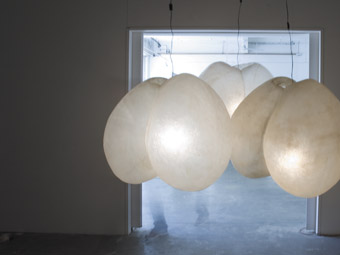
Plump, Cluster
photo Michael Blamey
Plump, Cluster
Fascinating for its multilayered demonstration of a ubiquitous scientific concept, the viewer/listener at Cluster can appreciate macro and micro-structural cause and effect. The work successfully avoided verging into the superficially pseudoscientific, as many attempts at a merger between art and science do. What’s more, Samartzis and Brown’s dense soundscape of drones, sine waves, electrical buzzes and crackles, as well as recorded sounds, rewarded the patient listener with a subtle and well composed musical experience. Marcia Jane’s projections added another slightly synaesthetic element and, like Rogerson’s sculptural cluster, played with the pertinence of light and optics to Plump’s installation, though perhaps lacking the subtlety of the sculptor’s contribution. After experiencing Cluster I contemplate a spiraling column of wind-caught leaves outside the gallery as part of a far greater chain of physical relations.
Chris Henschke/Rock Ensemble, performance, April 24 as part of Rocks, New Works by Chris Henschke and Donna Kendrigan, The Narrows, April 3-26; Cluster by Plump, artists Marc Rogerson, Philip Samartzis, Dave Brown, projections Marcia Jane; VCA Margaret Lawrence Gallery, April 26-May 3
RealTime issue #85 June-July 2008 pg. 30
© Jared Davis; for permission to reproduce apply to realtime@realtimearts.net
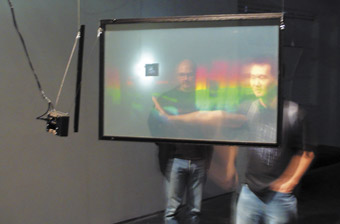
Martina Mrongovius, The Crossing
courtesy the artist
Martina Mrongovius, The Crossing
IMAGES CAN STIMULATE BODILY AWARENESS AND EVOKE, AT LEAST MOMENTARILY, SOME OF THE COMPLEXITY OF ACTUAL EXPERIENCE. THE GROUP EXHIBITION BEYOND THE WINDOW STROVE TO MAKE THIS PHYSICAL CONNECTION MORE EXPLICIT. CURATOR MARTINA MRONGOVIUS WRITES OF ENGAGING “THE VIEWER’S EMBODIED PALETTE OF SENSE TO EXPRESS SOMETHING BEYOND THE IMAGE.” CENTRED ON PHOTOMEDIA, THIS AMBITIOUS SHOW HAD THE POTENTIAL TO CREATE A SUBTLE AND EXPANDED UNDERSTANDING OF PICTORIAL IMMERSION.
The core of the exhibition comprises a suite of holographic images by Mrongovius. With their bursts of neon greens and oranges the holograms look like defunct technology for gimmicky toys rather than invoking sophisticated industrial uses. Yet, the sense of the mysterious technical complexity of etching an image with dimensional fidelity on a durable surface is nonetheless present.
The Crossing (2007), a suspended hologram diptych of numerous overlayed architectural details, was accompanied by a responsive soundscape by Philippe Pasquier. Against the difficult-to-pin-down holographic imagery, Pasquier’s shards of urban sounds seem too dense, consistent and coherent, failing to connect with the necessarily subtle movements of eyes, head and body with which the curious viewer has to navigate The Crossing’s chimerical visuals. Mrongovius’ holography makes intrinsic demands on the viewer to sway about to gain access to the imagery. If the sound component of The Crossing had likewise articulated the limits of perceptual mediation it may have connected with the tantalising dexterity of the holography.
Mrongovius inserts three dimensionality into the picture plane, yet the illusory nature is technologically restricted allowing for only partial, momentary articulation. This strained interaction highlights gaps between normal perception and what the pictorial holograph, and by association the mechanical expansion of vision in all photomedia, can provoke. Importantly, with these works we don’t so much move ‘beyond the window’ as bob about in front of it.
This was evident in the wonderfully awkward activity required to view Mrongovius’ We’re all looking series (2007). To find the images, viewers rolled back and forth with legs akimbo, for balance, on excessively low, cheap office chairs. The sliding illuminated photographic sequences of a group performing choreographed movements, iterating the artist’s focus on the perception of bodily motion.
In one hologram the movements involved the group simultaneously bobbing down, then standing and taking a photo, as if capturing the viewer. In this witty reversal the audience, instead of being positioned as transported witnesses, became the spectacle themselves, focused on by synchronised camera-wielders.
These holographic works took up the central gallery, with adjoining galleries each housing another work. Overly defined by the structural flow of the space, this seemed a self-conscious installation strategy. Mrongovius’ work dominated and surrounding works acted as weaker satellites. This lack of fluidity in exhibition layout was exacerbated by the use of elaborate custom made lightboxes to label each work. This appeared a stultifying attempt to re-emphasise curatorial coherence.
Another three-dimensional work (Erin Veronica Ender, Rachel Hanrahan and Max Hem) comprised two vintage stereo viewers. Peering through binocular lenses and then twisting a handle caused three dimensional photographs to flip forward, the images including Ender and Hanrahan wearing faux pilot costumes with glitter leggings. The stereo viewers as artefacts were wonderful, yet the artists’ intervention failed to reinvigorate them or expand the curatorial premise—the work seemed pointlessly flippant.
A similar over reliance on technical proficiency was evident in Yandell Walton and Clare Hassett’s Emergency (2008). A large photograph of a grief stricken woman sitting in a hospital was overlayed with a projection of an ethereal male figure slowly moving about her. This opposition failed to draw inspiration from the strong artistic tradition of exploring the nexus between photography and the moving image—the relationship remained uninterrogated.
The works in Beyond the Window were like dominoes, each highlighting the problematic strategies used in the next, the exhibition toppling into a survey of coy assaults against the still image. The experiential conditions to immersively ‘stretch the notion of the image’ were not realised. While the ingrained sensorial tension between the experience of the actual and the pictorial and their overlap was successfully articulated by Mrongovius’ The Crossing (if not in the sound collaboration), as a program about perception, Beyond the Window became paradoxically a catalogue of clunky, thwarted escapes.
Beyond the Window, curator Martina Mrongovius; Bus Gallery, Melbourne, March 18-April 5
RealTime issue #85 June-July 2008 pg. 30-31
© Amy Marjoram; for permission to reproduce apply to realtime@realtimearts.net
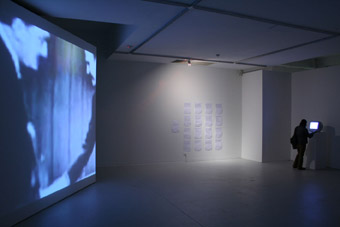
Mark Amerika, Mobile Phone Video Art Classics
courtesy of the artist
Mark Amerika, Mobile Phone Video Art Classics
TAKE AN AIMLESS RUN LOLA RUN THROUGH ONLINE SPACE TO THE SOUNDTRACK OF A POP SONG; INVITE SALVADORE DALI, MARILYN MANSON AND MADONNA ALONG FOR THE RIDE. TAKE SCI-FI AND LO-FI, TAKE CULTURAL THEORY AND TAKE WAY TOO MUCH OF IT ALL (MORE THAN YOU CAN TAKE IN). REMIX IT, MASH IT UP, THROW IT AT HOLLYWOOD (ENJOY THE PROCESS—GET DIRTY) AND YOU MIGHT HAVE A NICELY MESSY ANALOGY FOR MARK AMERIKA’S MOBILE PHONE VIDEO ART CLASSICS AT THE EXPERIMENTAL ART FOUNDATION (EAF) IN ADELAIDE.
Using the tiny frame of the mobile phone camera, US media artist and writer Amerika [RT80, p36] provides glimpses that contain only the loosest memory of subjects. The viewer is given small samples that suggest the presence of something greater; Amerika is not quite looking (but sideways sampling) the tirading torrents of online culture. Using pace and rhythm to convey to the viewer the feeling of diving into an information rich world, the experience of his work is of a chaotic journey across mash-up media popland. Wide eyed in a digital candy store, Amerika snatches the bits he wants with a refreshing (if disrespectful) disregard for intellectual property.
Utilising everyday consumer programs like PowerPoint and iMovie, Amerika gives his works an ‘anyone can do it’ flavour and highlights that his is a one man show, made from an unashamedly personal, subjective position. Much like a Duchamp of the digital age, Amerika has a knack for grabbing strangely right and slightly ludicrous stuff, ripe for re-contextualisation. Mobile Phone Video Art Classics is just one of the three video works included in the show. Presented as a large scale looped projection, it comprises a series of shorts that regurgitate media constructed personas. Recorded from existing media sources and filmed on a very lo-res mobile phone camera, characters including Madonna, Manson and Dali star as washed out, pixelated ghosts. These characters are re-introduced to the screens and copied to the point of abstraction. Amerika creates an awareness of the artificiality of celebrity on the blurring screen surface—a skin that he skims with relish.
The last chapter in Mobile Phone Video Art Classics is a quiet recording in a museum café. We can only make out the backs of heads as viewers settle into their coffee at that halfway stop point between the art and the street. Nothing much happens. The pixels sway with blurry uncertainty and the screen occasionally refreshes. This work comes from the border at the end of art viewing and is documentary in nature. Similarly, Amerika’s work itself seems restless in the gallery; it’s a loosely captured grab from a deluge of data that resists the permanence implied by art institutions.
Also in the space, Amerika writes (makes) his Postproduction Mantra; printed excerpts of his blog (Professor VJ) plaster the wall while a PowerPoint inhabits one corner and a computer, awaiting quiet exploration. Amerika throws a lot of language at his work; he theorises the work of postproduction artists with manifesto-like fervour. Stamping out his ground, he traces trends among artists who hybridise art forms, remix culture and use media with openness to changing the nature and sites of audience engagement. In Amerika’s hands postproduction artists are wizards of remixology: hackers of traditional media discourse.
“The virtual is the most powerful narcotic to have ever struck the scintillating nerve scales of the protoplasmic replicants…”
This is one statement from the tirade flowing below the large scale projection Society of the Spectacle (digital remix). Amerika’s language reveals a dream slippage between subjects that range from personal to pop to cultural theory. You can be pleasurably lost in the flickering mash-up of video and animation running above the text, however being ‘spoken at’ by the subtitles can prove overwhelming. With such relentless shifting of meaning and context it is not hard to see why Amerika cites the coining of the term “the information superhighway” by Nam June Paik as inspiration for the work.
My immediate response was enjoyment of the lush abandon of the work. Amerika throws things together with admirable lightness, making art that is cheeky, a little bit brave, even sacrilegious. However, as the torrent of information washes past me and subsides I am left with only the memory of the storm; loosely held subjects fading quickly in the weak sunlight outside.
Mark Amerika, Mobile Phone Video Art Classics; Experimental Art Foundation, Adelaide, April 18-May 17
RealTime issue #85 June-July 2008 pg.
© Sasha Grbich; for permission to reproduce apply to realtime@realtimearts.net
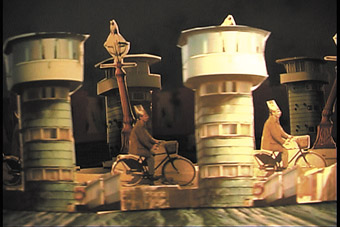
Copenhagen Cycles
IN LESS THAN A YEAR, MOVES, THE MANCHESTER-BASED DANCE ON SCREEN FESTIVAL, HAS UNDERGONE SIGNIFICANT FORMAT EXPANSION, INVOLVING PARTNER VENUES WITHIN THE REGION, A TOURING PROGRAM BROADCAST ON PUBLIC SCREENS THROUGHOUT THE NORTH OF ENGLAND, AND DEVELOPMENT OF A STRAND OF WORK MORE USUALLY ASSOCIATED WITH THE FIELD OF NEW MEDIA.
Now in its second year as an independent entity, Moves has nurtured a strong participatory element. Over and above the traditional baseline of screenings, a week-long filmmaking lab and networking and discussion forums provided the opportunity for artists from sound, animation, digital arts, short film and screendance to come together, exploring areas of commonality in their creative processes.
A three-day conference focused on this year’s festival theme—the interaction between sound and image. A series of eight, wide ranging, stand alone forums connected back to examples of individual practice, from Elinor Pearson’s examination of the gestural content of Maya Deren’s output, as situated within a “space beneath sound”, to Birgitta Hosea’s experimentation with synaesthetically oriented digital media. Billy Cowie’s deconstruction in Motion Control, co-created with Liz Aggiss in 2002, foregrounded the complex layering of aural input within the piece, while Donald Glowinski’s outlining of the EyesWeb application, analysing the affective content of movement patterning, elicited comparisons with the work of pre-cinematic moving image pioneers Eadweard Muybridge and Jules-Etienne Marey, their creations traceable as antecedents common to aspects of screendance, digital art and new media practice.
In addition, work proliferated in a number of non-traditional screening spaces throughout the city, with Manchester’s central rail station host to a series of luminously colourfilled lightboxes, and Claudia Kappenberg’s Moebius installation (2008) combining arrestingly abstracted stills with archive and newly-generated footage, projected in triptych form within a glass-fronted public building, viewable to passing foot traffic from street level.
In the first of a series of eight individually themed screening programs, work selected from the archives of Canada’s Bravo!FACT foundation included Larry Weinstein’s conceptually dissonant marriage of formal aria to domestic suburban banality in The Argument (2005). This contrasted with Marlene Millar and Philip Szporer’s rigourously claustrophobic framing in The Greater The Weight (2008), which captured the fiercely embodied performative intensity of a lone female, flamenco-gowned within the confines of a boxing ring. Ola Simonsson’s Music for One Apartment and Six Drummers (2002), from a selection of work screened in association with the Clermont-Ferrand International Short Film Festival, also conjured an ingenious rhythmic symphony from a series of incongruously domestic settings, offset by the epic sweep of visually sumptuous, butoh-inspired imagery in Alain Escaile’s Le Conte Du Monde Flottant (2003).
In the Subtle Architectures program, animation techniques used in the motion-based manipulation of footage presented a dizzyingly zoetropic challenge to the eye in both Bert Gottschalk’s Bildfenster (2007) and Eric Dyer’s Copenhagen Cycles (2006). Within the former, architectural detail, juxtaposed with materially-based referents, appeared as a constantly shifting matrix of vertical patterning. Here, filmstrip-like skyscraper windows framed viewing access to a series of creatively engaged human hands, while Copenhagen Cycles’ layering of cut-out imagery was reminiscent of a turn-of-the-century toy theatre, as oblivious oarsmen rowed through a kaleidoscopically colour-filled sea of flowers.
Imogen Sidworthy’s 7AM (2006), screened as part of the Visions D’Ailleurs programme, utilised ambient sound to suggest the presence of unseen movement merged with natural surroundings. Here, the careful arrangement of a close framed knee or torso, masked by the trunk of a tree, gradually offers access to fragmented increments of visual and aural material, building towards a slow panoramic sweep of early morning park-based Tai Chi practice. Mariel McEwan mixed animation, live action and faux-naif voice over in Niu Niu’s Story (2007) to slyly subvert traditional narrative tropes, charting through simple, front-on framing a Chinese dancer’s progression from freely skipping child to the infinitely refracted uniformity of the chorus line.
Elsewhere, an evening of work by British-based artist Alex Rueben drew together a number of short pieces, including the gently curving elegance of an animated line, swaying to the rhythm of the title track in Que Pasa (2001), interspersed with episodes from his music-driven road movie Routes (2007). Here, Rueben’s traverse through a constantly evolving landscape of indigenous culture within southern US states threaded together encounters with ferociously dynamic crumping cheerleaders and the whirling ceilidh-like melange of a social ‘contra-dance.’
Differing perspectives on the issue of narrativity were presented as part of the Discovery program where Damien Manivel’s Viril (2007) drew the viewer into an intriguingly paced world of masculine archetypes, allowing narrative threads to emerge from a seemingly unconnected range of otherwise unexplained episodes. A variety of male protagonists, whose mute concentration is punctuated by a bare minimum of ambient sounds, trade encounters in bedrooms and locker rooms, with female representation rendered as a dishwashing, back-facing presence, blankly impervious to the underwear-clad, pole dance of a male partner. Lutz Gregor’s Maps of Emotion (2008) explored territory reminiscent of Mike Figgis’ experimentation with simultaneity and subjectivity in his feature film Time Code (2000). Here, Gregor sets in motion a narrative premise by means of a divided screen. Played out against the nocturnal backdrop of an urban apartment and city streets, outer sections of the screen space are used to track the real-time journey of separation and reunion experienced by a male and female figure, each visible within a single square of personal space. This shared interior region of memory and emotionality, signalled by a range of devices including monochrome footage, night vision photographic stills and luminously graphic motion tracking, occupies the screen’s central section. The interrelation of visual imagery provides a choreographic scaffolding for the work with sporadic movement ‘echoes’ travelling between frames, while precise placement of overlapping footage heralds the couple’s final reconnection, as a photograph, handed across the darkness of the central region, completing the emotional journey.
Maya Deren wrote that the cinematic medium “consists of the eye for magic”, and this indefinable property was explored in a range of work presented in the festival’s final program. The movement patterning of birds in flight, flocking and diminishing in relation to guitar cadences, formed the basis of Marcel Prins’ The Gathering (2006), while Susanna Wallin’s highly original Night Practice (2006, an IMZ winner in the 2007 competition) made reference to aspects of documentary and narrative form, with a near-abstraction of movement content achieved by means of a deftly handled mix of shots. Music, sound and movement are balanced with the formal beauty of clock workings, as a group of teenage boys in an otherwise deserted athletic track inhabit a borderline zone of enigmatically harnessed energy, fluctuating between the exercising of specialist skill and out of hours larking around. A lone runner metronomically keeps pace around the periphery as a central group tumble onto crash mats. Meanwhile, a subtle interplay of gazes, exploring the implicitly heightened emotional territory of watching and being watched, is woven as a choreographic thread throughout the work.
Stan Brakhage has written of art-making as an exteriorisation of internal physiological rhythms, arising from the artist “hearing himself sing and feeling his heart beat.” The thematic highlighting of sonic input added to the relational mix of choreographically relevant raw materials comprising Moves’ signature programming style, with the festival this year consolidating its identity as an imaginative and inclusive platform set within the greater landscape of cross-genre work.
Moves08 Festival of Movement on Screen; Royal Northern College of Music, Manchester, April 22-26
RealTime issue #85 June-July 2008 pg. 32
© Chirstinn Whyte; for permission to reproduce apply to realtime@realtimearts.net
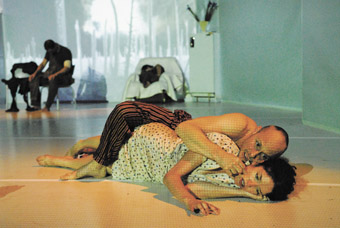
Rowan Marchingo, Elizabeth Ryan, Back From Front
photo Heidrun Löhr
Rowan Marchingo, Elizabeth Ryan, Back From Front
A SANDBAGGED TRENCH SEPARATES THE AUDIENCE FROM THE PERFORMING SPACE, BUT WHAT WE SEE THERE IS NOT FIRST A FIELD OF WAR BUT STARK WHITE WALLS THAT ARE SOON RECONFIGURED BY PROJECTIONS INTO ARMY BARRACKS, HOSPITALS AND THE HOMES OF AILING SOLDIERS—OR THEIR GHOSTS—AND THEIR LOVED ONES. DIRECTOR-CHOREOGRAPHER DEAN WALSH’S BACK FROM FRONT IS A DARK, RESTLESS DREAM WORLD WHERE NO ONE STORY IS TOLD BUT THE AGONIES OF MANY ARE IMPRESSIONISTICALLY SUGGESTED THROUGH FIVE PERFORMERS.
The recurrent figures are two male soldiers, one possibly a sergeant (“You will be a weapon”, he roars at his charge), a nurse and a housewife, all appearing to belong to earlier generations of Australians, presumably from World Wars I and II through to Korea and Vietnam. And there’s an apparently modern female soldier. As the performance commences she plays innocently with a black balloon against an ominous hum, sonar pings and, suddenly, the roar of a rocket tearing through airspace. Fear-inducing images soon grow in scale. Later a red laser dot ranges across the stage until it finds its target; he’s hit, he falls, projected blood pours out filling floors and walls. A giant red cross, again projected, slides up the floor onto the back wall transmuting from the caring symbol of the Red Cross agency into the threatening profile of a martial eagle.
Less dramatic but more ominously surreal are four refrigerators built into the walls. At once images of domesticity (constantly approached by the sleepless soldiers for milk) and bizarre entry and exit points to other worlds, the refrigerators suggest war-induced neurosis turning to psychosis, enveloping not only the soldiers but also their carers. It’s never clear precisely whose nightmare visions these are, but they will become ours.
Amidst these material and virtual transformations, certain actions are played out—a training routine that turns horribly compulsive, attempts to cradle and comfort, Rowan Marchingo and Matt Young turning on each other in an ugly robotic fight and a tense inconclusive battle scene.A wife sets the table with candle and wine; the soldier husband joins her but is consumed by a shaking which soon infects her. In the most sustained and palpably choreographed scene in Back from Front, Marchingo and Elizabeth Ryan come together in a frail, awkward shuffling dance ending in collapse. Pathos turns to fear, his body heavy over hers, locking her down while the nearby refrigerator is suddenly ‘alight’ with fire. Alone, the woman is possessed by a strange, swirling luminous blue light. Slowly removing her clothes down to her underwear, she appears to be in a reverie alternating between a sense of profound absence—of a body that she once felt as part of herself—and erotic presence, of feeling herself where once he was.
There’s a lot more to Back from Front—the hysterical release of the carers in bad jokes about wounding and death, a flood of letters announcing soldier deaths pouring out of a refrigerator, the female soldier fantasising a normal life in a blue dress and, finally, projections of unidentified photographs old and recent of those who died in or suffered the aftermath of war. The soldiers push three of the refrigerators forward and stand to attention on them in salutes to the victims of war. There’s no little irony in this gesture, a salute from the very military that kills and maims. It reminded me of the double bind that emerged in the wake of the treatment of veterans of the Vietnam War—we might disapprove of the war against Iraq but we must support our soldiers.
Dean Walsh has created a large scale, complex work, which on its first outing is occasionally affecting if often opaque and, in terms of multimedia, over-determined. There are powerful visual moments but they are sometimes either too illustrative or symbolically obvious and, in their endless variety, lack thematic cohesion. A sparer palette that allows a greater correspondence between performer and image and which lets us see the performers more clearly would benefit the work enormously. Similarly, the compilation of musical works, both popular and classical, veered from apt to melodramatic and again lacked cohesion, obscuring the work of the production’s composer. As well, an imbalance in performing and choreographic demands favoured Ryan, Marchingo and Young, leaving roles played by Lizzie Thompson and Marnie Palomares, although ever present, lacking impact. If Walsh can work from the directorial, dramaturgical and multimedia strengths of Back From Front, evident in his most sustained, physically and choreographically inventive scenes, he’ll create a more consistently powerful and moving work.
Back From Front, concept, direction, choreography Dean Walsh, performers Rowan Marchingo, Marnie Palomares, Elizabeth Ryan, Lizzie Thompson, Matt Young, medi artists Rolando Ramos, lighting & software design Simon Wise, dramaturg Nikki Heywood, set design John Levy, costume design Claire Britton, composer, sound designer Rosalind Page; Performance Space, CarriageWorks, Sydney, May 1-10
RealTime issue #85 June-July 2008 pg. 33
© Keith Gallasch; for permission to reproduce apply to realtime@realtimearts.net
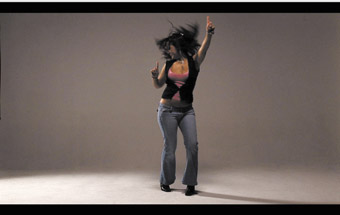
Meaghan McHenry, Dance Like Your Old Man
IN GIDEON OBAZANEK AND EDWINA THROSBY’S DOCUMENTARY DANCE FILM, DANCE LIKE YOUR OLD MAN, WE HEAR THE VOICES OF SIX WOMEN PRERECORDED IN INTERVIEW STYLE, BUT WITHOUT THE QUESTIONS, PLAYED OVER FOOTAGE OF THEM DANCING LIKE THEIR FATHERS. THE STORIES TOLD AND THE ‘OLD MAN DANCES’ ARE CAREFULLY POSITIONED IN A 10 MINUTE STUDY THAT ASKS WHAT WE UNDERSTAND OF OUR FATHERS AND OUR RELATIONSHIP WITH THEM. IT’S A QUESTION APPROACHED THROUGH MEMORY, BOTH SPOKEN AND EMBODIED. THE FILM PRESENTS AN INTERESTING CHASM BETWEEN THESE TWO MODES: A BODILY IMPERSONATION OF A FATHER’S DANCING AND A SPOKEN REVERIE OF THE RELATIONSHIP WITH HIM. EACH INTERVIEW HAS BEEN SHAPED WITH ATTENTION TO THE DIFFERENCES WHILE FILM EDITING IS RICHLY UTILISED TO SOLDER THE DISPARITY INTO A SINGLE TELLING.
The arrangement of the interviews develops and deepens this modal incongruency from first to last through editing style and pacing. The first dancer, Meaghan McHenry, presents an example of contiguity between the light and seemingly coquettish description of her father with the energy of the dance. The editing is quick, the range of shots bouncing playfully between close-ups of face, chest and midriff. A close-up of the young woman’s finger pointing (a favourite move of her Dad’s) punctuates the rapid vacillation between close, mid and long shots. From here the shape of the film begins to bifurcate between the tone of the telling which grows somewhat darker, and constancy in the joy of the dancing.
With the fourth dancer, Bec Reid, we are taken from the sweet reminiscence of daddy’s little girl, juxtaposed with the playful absurdity of a father who struts about “like a rooster with a fire cracker up his bum”, into slow motion treatment of a daughter’s disappointment and sadness at her hero’s love affair. The change is observed firstly on the dancer’s face followed by a close-up of her upper chest, and then in the softened texture of the reduced film speed. This is in stark contrast to the comic stiffness of the father’s jig. Now the slowing of the shooting underlines the gravity of the dancer’s words.
The final dancer, Ros Warby, walks into frame. She is composed, seeming to take a moment to reflect before moving. Positioned mid-frame and against the telling of a sad, affectionate story, Warby breaks into a fitful dance: upper arms closed tight on the torso, bent at the elbows, lower arms and hands moving vigorously, asymmetrical to the contained verticality of a body that seems to resist propulsion. The whole head engages appositely with the motion of the arms, shaking violently from the neck. The dance suggests a body constrained, inside, a ‘wild fella’ ready to erupt. We learn of addiction, demise and recovery, the memory however no longer bearing disappointment.
The film’s documentary inquiry deepens in this last episode with the reverent stillness of the camera and the absence of editing. It also reinforces a sense of the differences between embodied and spoken modes of memory expressed throughout the film. The finale completes a coherent and carefully constructed picture of six women’s stories, moving from many edits to none, from innocent fathers to the fallible and the forgiveness required. By using dance, Obazanek and Throsby avoid the pitfalls of storytelling that simply invites psychological analysis, asking us to recall in both word and body who our fathers are, or were.
–
Dance Like Your Old Man, directors, Gideon Obarzanek, Edwina Throsby, performers Meaghan McHenry, Sara Black, Alexandra Dillon, Bec Reid, Penelope Bartlau, Ros Warby, cinematographer Cordelia Beresford, editor Simon Njoo, online editor Oliver Clifton, sound editor, producer Chunky Move in association with Chequerboard Productions. 10 mins, 2007
Dance Like Your Old Man has won the following awards: 2008 Flickerfest International Short Film Festival, Best Documentary; 2008 ReelDance Awards, Best Documentary; 2007 Melbourne International Film Festival Nova Cinemas Award for Creative Excellence in an Australian Short Film, and Best Documentary—Short Film.
RealTime issue #85 June-July 2008 pg. 33
© Jodie McNeilly; for permission to reproduce apply to realtime@realtimearts.net
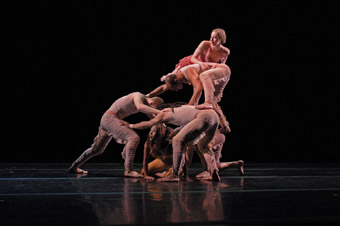
Pilobolus, Aquatica
PILOBOLUS DANCE THEATRE HAVE NEVER BEFORE PERFORMED IN AUSTRALIA, ALTHOUGH YOU MAY RECALL THEIR INTRIGUING SHADOW-PASTICHE OF MOVIE ICONOGRAPHY FOR LAST YEAR’S ACADEMY AWARDS. FOR THEIR AUSTRALIAN DEBUT, PILOBOLUS PRESENTED FIVE WORKS FROM THEIR REPERTOIRE AT ADELAIDE’S HER MAJESTY’S THEATRE, AS PART OF THE ADELAIDE FESTIVAL CENTRE’S PIVOT(AL) PROGRAM OF CONTEMPORARY DANCE.
Pilobolus traces its origins to Dartmouth College in Hanover, New Hampshire, where artistic directors Robby Barnett, Michael Tracy and Jonathan Wolken were students in the early 1970s. The company’s choreography—which, in this showing, included works from each decade since then—bares the traces of a counter-cultural kinaesthetic of collaboration, cooperation and closeness.
The look is quite distinctive. Whereas ballet’s velocity and poise emphasise the dancer’s lift and jazz’s presentational pizazz displays the dancer’s front, Pilobolus’s ensemble kinaesthetic rests upon contact, weight and curve. Cooperative weight-bearing and weight-sharing bind the dancers into evolving, shape-shifting, organic forms. With torsos in close contact, spines enrolled and limbs entwined, the seven dancers slide and morph across each other through each dance.
The effect is smooth as skin-tight lycra, meticulously styled yet evocative of natural forms and life processes. The most recent work, the collaboratively choreographed Aquatica (2005), depicts an underwater world of ebb and flow as delightful in its play of colour, form and movement as a well-stocked tropical aquarium.
The oldest work in the program, Wolken’s Pseudopodia (1973), is a solo study in embodied locomotion, performed with dignity by Jun Kuribayashi. A pseudopod is a temporary foot-like projection which certain amoeboid organisms use to move around. The company itself is named after a certain kind of fungus which Wolken studied as a student.
Tracy’s Symbiosis (2001) uses the biological concept of organisms living together in a mutually dependent, life sustaining relation as a metaphor for heterosexual coupling. Danced with intense physical interest by Jenny Mendez and Manelich Minniefee, the work pivots around conventional gender distinctions—small and large, slight and muscular—but with a consistency that is smooth, sliding and sweet.
Gnomen (1997) is a more unstable work. Ostensibly it’s a lyrical study in homosocial relations, its four male dancers—Andrew Herro, Jun Kuribayashi, Manaelich Minnieffee and Edwin Olvera—wearing nothing but tight black lycra shorts. There is intimacy and care amidst bravura, lifts and balances, but these near-naked male bodies read perhaps too readily as universal signifiers for relations of race.
The fifth work, Day Two (1980), directed by Moses Pendleton, features a striking soundtrack by Brian Eno and Talking Heads. The four male dancers are joined by Jenny Mendez and Annika Sheaff who perform topless and ride upon sticks in this ensemble exploration of the primitive sentiment of group dynamics.
The Pilobolus dancers cruise the soft borders of eroticism. Since the mid 1970s, nudity has been a controversial aspect of their work. But today the sensuality of their work is more akin to the romantic eroticism of greeting cards or the nude photography in fashion magazines.
The free-wheeling, free-flowing movement of the 1970s is perhaps best remembered in the unpredictable practice of contact improvisation. In the Pilobolus of 2008, the ooze and flow of bodies are given corporate form and what might once have been excessive is now channelled and contained. The company’s commercial arm, much in demand after the appearance on the Academy Awards, has since made television advertisements for the likes of Mobil, Ford, Toyota, Hyundai and Volkswagen.
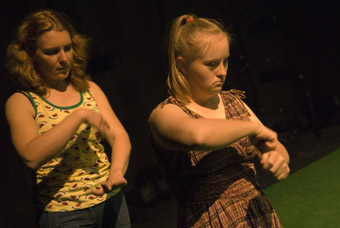
Zoë Barry, Anastasia Retallack, Safe From Harm
photo David Wilson
Zoë Barry, Anastasia Retallack, Safe From Harm
Safe From Harm, from Adelaide-based youth dance company Restless Dance, is also an experiment in form and the containment of excess. With this work, artistic director Ingrid Voorendt launches the company’s new professional ensemble. James Bull, Lorcan Hopper and Anastasia Retallack from the youth ensemble make their professional debut as performers alongside Stephen Noonan, Zoë Barry and Mario Spate. Previously Voorendt’s work with the company entailed harnessing the energies of youthful casts of twelve or more.
This work sits well within the generous breadth of the X Space Theatre at TAFE SA’s Adelaide Centre for the Arts. Gaelle Mellis’ design is spacious: the work is played upon a green expanse of artificial turf. Sounds of crows and planes fly overhead. Golf balls are scattered here and there between a few red flags. It feels as if we’ve woken up in some suburban park.
A wounded man (Noonan), an arm encased in plaster and a brace around his neck, lies sprawled at the bottom of a ramp. He stirs, climbs the ramp, looks around then falls. He does this several times in different ways. On the other side, there is movement inside a bright red tent. A woman (Retallack) crawls out and walks around, doing something intricate with her hands. Another woman (Barry) emerges, trundling an amplifier, saw and bow. Three other men soon follow and a set of games begin.
They run to pick up balls, from tent to flag and back. They play chasings, tag and Blind Man’s Bluf, Noonan plays with a radio-controlled car. Barry plays the saw. Hopper plays leapfrog with soft plasticity. Spate plays at being Marina Abramovic stabbing between his fingers with a knife. There are quiet games with pillows lit sweetly from within. There are also sentimental games with mirror balls, big group hugs and violent games with stabs and screams, gangs and bullying. The work passes through each game with an even rhythmic flow.
According to Voorendt, the work set out to pitch the “dignity of risk” against the “duty of care.” The polarities of ‘safe’ and ‘harm’ are clearly charted, even if their actualities are not explored for real. While duty of care is an age-old concept of the common law, the idea of dignity of risk, like Pilobolus, dates from the early 1970s. The phrase was coined by advocate Robert Perske to describe the right of people with or without disabilities to learn by taking risks and making mistakes. Reflecting on Pilobolus and Restless Dance, the phrase recalls for me the dignity of risking the excesses of collaborative encounters.
Adelaide Festival Centre’s Pivot(al), Pilobolus; Her Majesty’s Theatre, May 6-10; Restless Dance Co Professional Ensemble, Safe From Harm, director Ingrid Voorendt, performers James Bull, Lorcan Hopper, Anastasia Retallack, Stephen Noonan, Zoë Barry, Mario Spate, designer Gaelle Mellis, sound Zoë Barry, Catherine Oates, lighting Govin Ruben; X Space Theatre, Adelaide, April 18-24
RealTime issue #85 June-July 2008 pg.
© Jonathan Bollen; for permission to reproduce apply to realtime@realtimearts.net
RED DAWN. ENTER THE QUINKAN, AN ANCESTRAL SPIRIT. SLEEPERS WAKE WITH UNDULATING GESTURES. FEATURES OF THE LAND ARE FORMING, RIVERS FLOW, LIFE IS BEING CREATED. BIRDS SEEM TO FLUTTER INTO EXISTENCE. SNAKES SINUOUSLY WEAVE. THERE ARE PLUCKING AND GARNERING ACTIONS AS IF THERE IS A FRUITFUL ABUNDANCE. SIGNS ARE POTENT YOGA MUDRAS. SIMPLE ROBELIKE SKIRTS ODDLY EVOKE ANCIENT CRETE BUT THE COLOURS ARE UP COUNTRY, FAR NORTH QUEENSLAND RED, GREENS, OCHRES, DUSKY ROSE. THIS INDIGENOUS CONTEMPORARY DANCE WORK BY MARILYN MILLER IS BASED ON 12 DISTINCTIVE GESTURES PECULIAR TO THE COMMUNITY INHABITING MILLER’S OWN COUNTRY IN THE CAIRNS REGION. LATER THESE GESTURES METAMORPHOSE TO EXPRESS CLASSICAL THEMES OF CONFLICT, LOSS, LOVE AND RESTITUTIVE HARMONY.
Miller simultaneously explores the connections between the physical and spiritual worlds and the struggle between women and men in the creation of a matriarchal order. Her choreographic imagination is fertile and schematically inventive, even raunchy. She is particularly good at distilling dramatic moments which illuminate desire, sorrow and community celebration. The strongest image is of the tribal matriarch ‘gathering in’, healing in her hoop-like gesture the hole in the world. Romano Crivici’s supportive electronic score sensitively incorporates Indigenous elements to fulfill Miller’s requirement of a classically conceived musical composition.
Special guest, Northern Territory dancer Gary Lang endows the Quinkan spirit with a captivatingly vibrant and dangerous masculine edge. Lang is matched by the matriarch, Fiona Doyle, whose austere good looks are strikingly pharaonic in context. Doyle’s self-possessed, immensely grounded female authority anchors this piece. The rest of the ensemble is likewise compelling to look at, with the ability to be individually present in contradistinction to the neutral stance of much modern dance. There is some hesitancy from less experienced cast members in this still developing work. The performers’ energy carries the audience with it. In this respect, as the publicity for Quinkan states, “dance and life are one and the same.” This is a reorientation of the usual audience expectations. The work is, after all, a celebration as much as an art event. The crux of the narrative involves a conflict couched in gender terms between ancestral spirits who seem as pesky as the Greek gods and human beings subject to mortal frailties. The double perspective enables Miller to comment definitively on female strengths while at the same time relishing in her evenhanded presentation of undiluted male energy.
Miller has a wide-ranging background in dance, theatre and film. This proclivity for work in different media accompanies a largeness of vision and her own take on the Indigenous presence in the arts which, as exemplified in Quinkan, I find enticing and exhilarating. Elsewhere she has commented on the diversity of over 200 Indigenous languages and dance styles and makes the point that she sees Indigenous dance “as potentially providing an Australian dance vocabulary.” Quinkan marvelously points in this direction and makes sense of her remarks before the show about why she had wanted a classical dance score. It is as if there was created in this blend—an interpenetration of contemporary dance, classical music and Indigenous content conveyed through specific gestural language—an alternative, Utopian history. Europeans are here welcomed to the land and initiated into a properly timeless respect for the unique nature of the continent and the subtleties of its Indigenous culture. Miller’s artistic intervention is a generous gift to the colonisers, an opportunity to be taken up, a beautifully democratic quid pro quo countering the oftentimes paternalistic overtones of other sorts of interventions at large. To the extent that she has so exuberantly realised her vision, a vision without boundaries, Miller seems, in a broad political context, to be fulfilling Gramsci’s prescription for combining pessimism of the intellect with optimism of the will. In a word, her work is heartening.
The rehearsal room venue for Quinkan was somewhat spacially inhibiting for the scope of the work, so I look forward to seeing a fully realised production at the Festival of The Dreaming at Woodford in June.
Quinkan, choreographer Marilyn Miller, performers Gary Lang, Fiona Doyle, Darren Edwards, Jeanette Fabila, Tamara Forester, Rita Pryce, Hannah Scanlon, Ian Colless, composer Romano Crvici, rehearsal director Gary Lang; Judith Wright Centre for the Performing Arts, May 22
RealTime issue #85 June-July 2008 pg. 35
© Doug Leonard; for permission to reproduce apply to realtime@realtimearts.net
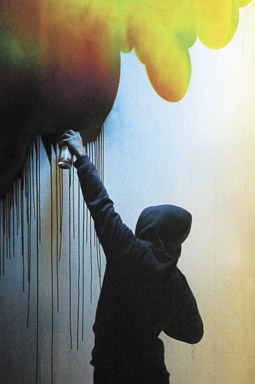
Blazeblue Oneline
photo Byron Perry
Blazeblue Oneline
IN ANTONY HAMILTON’S DEBUT FULL-LENGTH WORK, EVEN THE TITLE, BLAZEBLUE ONELINE, HAS A CHEEKILY OBSCURE BUT RHYTHMICALLY EXACT QUALITY. THE TONE IS VIGOROUS AND BRASH, MASCULINE BUT CHILDLIKE AND WHEN MYSTERIOUSNESS CREEPS IN, IT ISN’T LONG BEFORE THINGS POP BACK INTO MULTICOLOURED JOY.
Hamilton is best known as a key performer in works by Chunky Move and Lucy Guerin Inc. His concept for this piece began with a desire to meld dance with visual art. It was, for him, a natural extension of two art forms that he has pursued side by side for years. Like the action painters of the 1940s and 50s, Hamilton is fascinated by the gestural implications of visual art. But in contrast to the likes of De Kooning, he is also interested in working in the opposite direction, starting with a picture and moving towards an action.
The focal point of the visuals in Blazeblue Oneline is graffiti. But rather than being a show about graffiti, Hamilton uses its aesthetic mainly as a cohesive agent for a panoply of set pieces. As with Shaun Parker’s debut, This Show is About People, there is a sense of directorial excitability in the sheer eclecticism of Hamilton’s work. Offered the gamut of time and space he has responded by creating a piece that flies with exuberance in any number of directions yet retains a tautness that keeps it from becoming indulgent or insubstantial.
The show starts with a remarkable sound and light overture that teams Luke Smiles’ rumbling drum’n’bass with Bluebottle’s perfectly timed splinters of light—revealing the architecture of the Meat Markets with a menacing sense of anticipation. It is an opening with all the thumping import of a call to arms and plants us firmly in an urban culture of jagged beats and solid walls.
Onto the stage steps a lone man. Secreted under a hoodie and facing away from us, he stands still, peering at the white wall in front of him. It is the artist facing a blank canvas, his nature eventually revealed to us only in the blue tags he swiftly marks on the set. Before we can settle in to the sombre oddness of it all, Hamilton’s whimsy emerges with an irreverent pas de deux for two up-turned cardboard boxes. Their movements, expertly steered by concealed dancers, have all the bounce and geometry of graffiti while also seeming to reference everything from Busby Berkeley to a game of Tetris.
Hamilton, it would appear, isn’t going to take things too seriously and the audience giggles with delight when he and Smiles appear in rave-ready fluorescent leisure suits. They stand together, stillness interspersed with flurries of movement that match the off-centre choppiness of the grimy beats playing around them. The boisterous self-effacing mischievousness continues with an inspired segment of one-upmanship involving sheets of aluminium foil. Hamilton even throws in over-sized comic-book cut-outs, a laser sequence and a cardboard-clad Stuart Shugg as a Transformer figurine. It’s a melange that befits a boy’s bedroom: revelling in games and competition, in technology and self-expression.
Through all this playfulness, Blazeblue Oneline maintains the conceptual thread of integrating dance with visual art. Through the course of the show the set moves from a shiny white box to a surface carved up with looping curls and dripping angles. With sprays and markers, the dancers leave behind them a representation of action on the wall. At one point, Smiles and Hamilton sketch an intricately mirrored motif on the floor before teaming up to finish the job like a human inkjet printer.
Working in tandem with these visual manifestations of action, the show also extracts the lines and rhythms of its dance from what we see. Whether it is simply the preparatory shaking of an aerosol can writ large in the body, or the repeated outlining of a gesture, Hamilton’s choreography bears the hallmarks of graffiti. There is also a subtle recurrence of two-dimensional objects, such as cardboard, being given three-dimensional life and movement by the dancers. It is as though the flatness of visual art’s canvas is itself being reconstructed and reconfigured into the dynamic physical nature of dance.
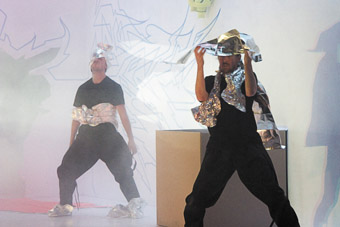
Blazeblue Oneline
photo Byron Perry
Blazeblue Oneline
Blazeblue Oneline offers up an appetising sense of what Hamilton will bring to his future works. It is clear that his personal capacity for expression sits comfortably with the creative forces he has gathered around him. The integration of music, lights and dance is almost seamless, with the distinct character of Hamilton’s vision always remaining clear. It is energetic, witty and charismatic. It is the work of a young choreographer who is clearly happy to play and the audience are more than happy to play along.
Blazeblue Oneline, concept, choreography, design Antony Hamilton, performers Antony Hamilton, Byron Perry, Luke Smiles, costumes Paula Levis, lighting, set realisation Bluebottle, sound design Byron Scullin, additional composition & editing Luke Smiles; Arts House, Meat Market, Melbourne, April 30-May 4
RealTime issue #85 June-July 2008 pg. 35
© Carl Nilsson-Polias; for permission to reproduce apply to realtime@realtimearts.net
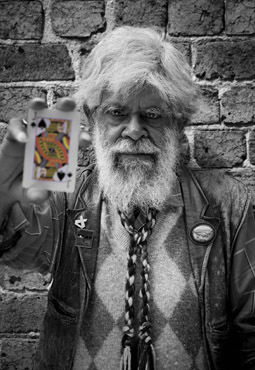
Jack Charles
photo Kerry Pryor
Jack Charles
WHEN THE AUSTRALIAN PERFORMING GROUP WAS SEARCHING FOR AN AUTHENTIC AUSTRALIAN VOICE, NIGHTSHIFT PRESUMED THAT VOICE HAD ALREADY BEEN FOUND AND, INSTEAD, WENT IN SEARCH OF ‘AUTHENTICITY’ ITSELF. THIRTY-FIVE YEARS LATER AND SITTING IN LA MAMA, THE SAME THEATRE WITHIN WHICH THAT SEARCH FOR AUTHENTICITY BEGAN, PHIL MOTHERWELL, SHIRALEE HOOD AND JACK CHARLES ARE STILL CHASING THE TRUTH. ON THE EVE OF THEIR TRIBUTE SHOW [P37] TO DIRECTOR LINDZEE SMITH WHO DIED LAST YEAR [RT78, P35], NIGHTSHIFT WOULDN’T HAVE IT ANY OTHER WAY.
You cannot prophesy the future without reflecting on the achievements of the past. The two are interchangeable, as are life and art. So when I put it to the group that a prominent Melbourne director explained his experience with Nightshift in the late 70s as: “The moral thrill of theatre, akin to electrocution”, Hood draws a sharp breath, but it is Motherwell who is vaulted upright. “We wanted to create a theatre that had the immediacy of a rock concert. Lindzee was right into Brecht: direct statements close to the bone, and pretense was an ugly word. It was a theatre of ideas, but it was visceral.”
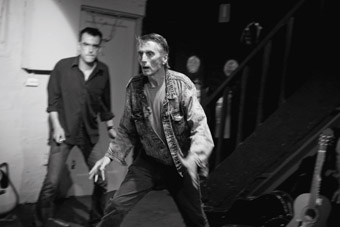
Gary Carter & Phil Motherwell
photos Kerry Pryor
Gary Carter & Phil Motherwell
As a theatre practice concerned with authentic expressions of the immediate, it makes sense that Nightshift’s current production grapples with post-apology Australia and the Stolen Generations. Hood and Charles are Indigenous Australians, and Motherwell’s play Steal Away Home is explicitly based on Charles’ life. And even though there is some ambivalence as to whether this current production is a continuum of the Nightshift oeuvre or a new theatrical collaboration, Hood, who first worked with Lindzee Smith in Perth during the 90s, takes up the charge. “Rudd’s apology is an opportunity for white Australia to have a go at understanding our story…All of the time my mother spent searching for her family she could have been consolidating her economic base. This was time wasted, and there has to be compensation…” Nightshift’s personnel may have changed since the late 60s, but its tradition of resistance continues in the form of direct political action.
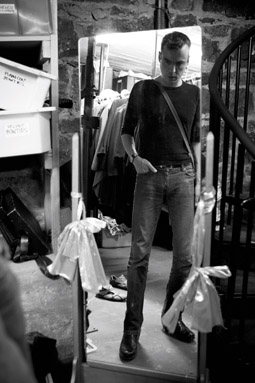
Garry Carter
photo Kerry Pryor
Garry Carter
Resistance always involves an element of danger, and tying ribbons around tree trunks was never part of Nightshift’s modus operandi. Motherwell embraces Jack Charles, describing him as a “Living legend…The Ben Hall of Australian theatre”. The outlaw metaphor is apt, as Charles’ polite manner belies a charm that is as disconcerting as it is seductive. “They only ever got me when they wanted a blackfella”, he says, referring to the colour-blind casting that continues in Australia to this day. And opportunities for Charles were further limited due to an extended holiday at Her Majesty’s Pleasure, but he was not alone in prison. Motherwell’s addiction to heroin was once also out of control. In desperation, he robbed three banks with a hand concealed in his pocket, received five years jail with a three year minimum term, but was out in 16 months. He recalls Lindzee Smith visiting him in that “Disneyland of despair” just prior to the publication of Motherwell’s little known classic, Dreamers of the Absolute [a play based on the transcript of the trial of anarchists in pre-revolutionary Russia; it was performed by Nightshift in Melbourne in 1978 , Troupe in Adelaide in 1979, and Smith directed it for the Adelaide School of TAFE in 2002. Ed]. “Lindzee waltzed into the Governor’s office with a secretary on his arm and declared: ‘I’ve got some business to discuss with Mr. Motherwell.’” After Smith’s visit to Pentridge, A Division would never be the same again.
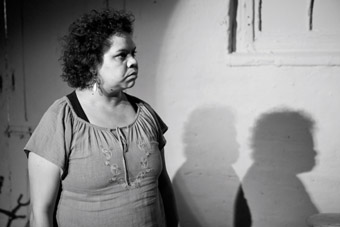
Shiralee Hood
photo Kerry Pryor
Shiralee Hood
In discussion with the Nightshift ensemble, the talk always oscillates between the stage, the page and that book of life that is a memoir of the street, be it inner suburban Melbourne or the grimy avenues of New York. So I put it to Motherwell that Dreamers of the Absolute is not just a study of the revolutionary impulse but also a manifesto for the theatre terrorist. “Dreamers” he says, “grew out of the anti-war movement. It wasn’t about a metaphorical terrorism, more a terrorism by the State; an established order that had to be undermined…I mean, we’ve only got the Pentagon’s word on terrorism, and we’ve learnt not to trust that, haven’t we?” So true, but why in Lindzee Smith’s written introduction to the play did he quote and thereby personalise the line, “The terror’s a cross it’s so hard to bear”? And why did Motherwell cast himself in the role of the revolutionary, Alexis? A wry smile appears in one corner of Motherwell’s mouth. We both know the answer to that question, but we’re not about to hear it today. Instead, still searching for an authentic expression of the immediate, Motherwell cracks us all up. “I used to write stuff just to give myself a part…Don’t laugh, it’s true.”
Nightshift reading
For a brief documentary account of Nightshift and its place in the functioning and the politics of the APG, if not for an evocation of the group’s powerful works, see Gabrielle Wolf, The Australian Performing Group, the Pram Factory and New Wave Theatre, Currency Press, Sydney, 2008. For vivid personal accounts of the Nightshift experience from Richard Murphet and Lindzee Smith (in an interview with Sue Ingleton), see the memoirs section of www.pramfactory.com. See also the Smith obituaries from James Shuv’us and Jai McHenry Derra at http://lindzeesmith.blogspot.com and Richard Murphet [RT 78, p35]. Phil Motherwell’s Dreamers of the Absolute was published by Yackandandah Playscripts in 1985. Eds.
RealTime issue #85 June-July 2008 pg. 36
© Tony Reck; for permission to reproduce apply to realtime@realtimearts.net
![Lindzee & Steve [Wilkinson] under the Brooklyn Bridge](https://www.realtime.org.au/wp-content/uploads/art/19/1971_reck_underbrooklynbridge81.jpg)
Lindzee & Steve [Wilkinson] under the Brooklyn Bridge
image Tim Burns
Lindzee & Steve [Wilkinson] under the Brooklyn Bridge
LINDZEE SMITH DIED LAST YEAR, BUT I SWEAR TO YOU I CAN SEE HIS FACE IN A PROJECTED IMAGE OF LABYRINTHINE IRON BARS SPLAYED ACROSS LA MAMA’S REAR WALL. THE SPIRIT OF THE FORMER OCEAN GROVE IRON MAN PERVADES THIS PRODUCTION: IF NOT IN ITS COMPLEX ENTANGLEMENT OF JAIL CELL DOORS, THEN IN ITS IDIOSYNCRATIC PRODUCTION STYLE. AN URGENT NEED TO EXPRESS THE INNER LIVES OF THOSE RESIDING OUTSIDE THE LAW DRIVES THIS TRIBUTE—SMITH, A MAN WHO WRENCHED ART FROM LIFE’S GURGLING AND GROANING, AND REFUSED TO LET GO.
This celebration of Nightshift, the 1970s offshoot of the Australian Performing Group (APG), consists of three plays and two films by lifelong Smith collaborators Phil Motherwell and Tim Burns. The plays comprise the earlier part of the show, but it’s best to begin any assessment with the final film of the night, Burns’ Thus Went Phillipa. This brutal exploration makes explicit Smith’s obsession with the link between art and life: the same obsession that inflects Motherwell’s writing with its poetic nuance. A gaunt Smith is shown smacked out in an Alphabet City squat. Watching him wield a blood filled syringe as he probes for a recalcitrant vein, Thus Went Phillipa comes across as a response to the collapse of Leftist politics, and a gradual awareness among its disciples that they were mistaken in their assumption that an unjust society could be transformed by direct action alone. Transformation must come from within and, even though the belief that heroin-induced dreams could precipitate this transformation was also misguided, Burns’ film displays a concern to explore an interior world: one exemplified by a dream-state junkie, Phillipa.
In contrast, Political Transmission is conceived as a Brechtian vision of the Left’s role in world affairs, particularly the fascist overthrow and 1973 assassination of Allende in Chile. Following an early diagnosis of lupus, the blood disease that eventually killed him, Smith is laid up in a New York hospital, his immune system ravaged by rampaging anti-bodies. Smith’s political diatribe heard voice-off is a didactic call to arms in response to a rise in fascism: an unhealthy political ideology attempting to overthrow a healthy social system. The film ends with a revitalised Smith catching a plane to Melbourne in preparation for some direct action of his own: a performance of Motherwell’s radical play Dreamers of the Absolute.
Motherwell himself then appears on stage, introducing three monologues rejigged for ensemble performance. Actor Isaac Drandich is a conduit for our electrified attention in his performance of The Fitzroy Yank. Ambiguous in its representation of a raconteur imprisoned by the mania of outrageous dreams, Drandich’s articulation of the Yank suggests an actor of twice his experience. But it’s when the ensemble comes together in The Native Rose and Steal Away Home, that Burns’ films, Motherwell’s plays, and Smith’s omnipotent spectral presence unite in an unlikely collision of the biographical and the highly imaginative.
In The Native Rose, Shiralee Hood delivers each line directly to the audience. The setting is a park on Anzac Parade in Sydney. The dope shootin’ and destroyed Rose finds communion on the street in the shape of damaged soldiers returning from World War II and a string of like-minded conspirators who thieve and drown their disfigured lives under the disapproving eye of a statue of Captain Cook. Equally at home in Motherwell’s inner suburban milieu, or Burns’ New York, it’s the lives of the disenfranchised transforming despair into hope that underscore Nightshift’s confronting directorial style.
And so it is in Steal Away Home that actor Jack Charles discovers his past is also present in the future. Charles’ truant childhood becomes an acute expression of the poetry drawn from drab Housing Commission homes, and a life that knows no other angle than that of living on the edge. So when Billy Tisdall dons a judge’s wig and indignantly declares to Charles, “You’ve robbed County Court Judges…”, the mischievous giggle from Jack’s tiny frame presents not just as a healthy disrespect for the dubious institution of the law, but as a response to Aboriginal dispossession. By having his past stolen from him, Charles has instinctively chosen to Steal Away Home.
Later, when riding my bicycle through Lindzee Smith’s old stomping ground, I sense his spirit in the streets. Although largely unrecognised, and despised by the mainstream, his eyes smile bright in the dark urban night. The lyricism of the tribute at La Mama has roused him from the earth, exposing the poetic heart of Nightshift.
Nightshift, writer, director Phil Motherwell, filmmaker Tim Burns, performers Lindzee Smith (on film), Isaac Drandich, Gary Carter, Shiralee Hood, Jack Charles, Billy Tisdall, projection Ian De Gruchy, music Joe Dolce, lighting Gabriel Townsend; La Mama, Melbourne, March 12-23
RealTime issue #85 June-July 2008 pg. 37
© Tony Reck; for permission to reproduce apply to realtime@realtimearts.net























































![PeursDuNoir [Fear(s) of the Dark] - Burns 06, Charles Burns](https://www.realtime.org.au/wp-content/uploads/art/20/2054_sellars_fefars.jpg)





















![Phoxai Pholsavatdy (South Australian School of Art student), Untitled, constructed print [2006]](https://www.realtime.org.au/wp-content/uploads/art/20/2075_anderson_phoxai.jpg)
![Helen Mok (Sydney College of the Arts student), A place to belong (blue sky), [2008]](https://www.realtime.org.au/wp-content/uploads/art/20/2076_andersen_sca.jpg)





































![En La Ciudad de Sylvia [In the City of Sylvia]](https://www.realtime.org.au/wp-content/uploads/art/19/1942_city_of_sylvia.jpg)































![Lindzee & Steve [Wilkinson] under the Brooklyn Bridge](https://www.realtime.org.au/wp-content/uploads/art/19/1971_reck_underbrooklynbridge81.jpg)

